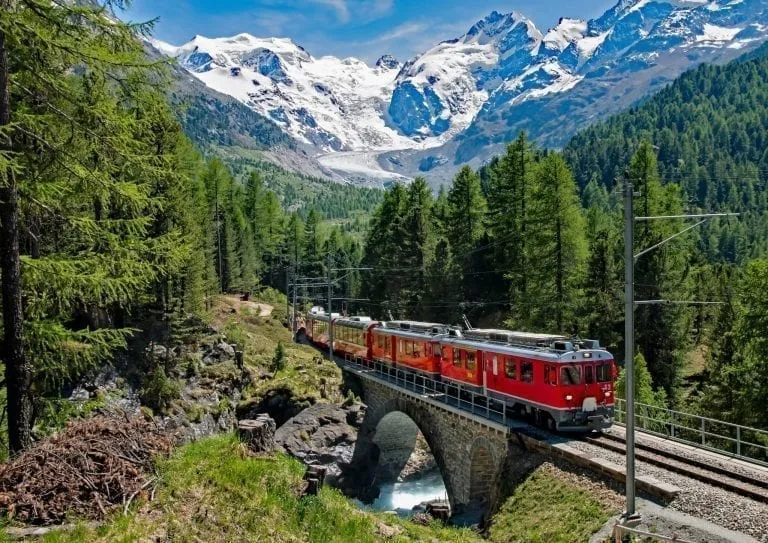

How to Travel Europe By Train: The Ultimate Guide (+ Tips!)
Beautiful views, comfortable train cars, the bustle of busy platforms, and the thrill of a new adventure: there are a lot of good reasons to travel Europe by train!
But, for those of us who grew up in a place where traveling by train isn’t common, the prospect of train travel in Europe can be as intimidating as it is exciting.
Thanks to traveling Europe extensively for years (including with our dog!) and spending more than a year living in Portugal, we’ve had a chance to appreciate countless train rides through and across Europe.
From the mind-boggling efficiency of Swiss trains to overnight train rides through Eastern Europe (Sofia to Istanbul was a particularly memorable ride) to simple jaunts across Italy, we’ve experienced just about every form of train travel in Europe.
And along the way, we amassed a huge number of European train travel tips !
This train travel guide is a culmination of everything we wish we would have known before we started traveling Europe by train , plus why we think it’s worth a try.
Table of Contents
Who is This Guide to Train Travel in Europe For?
Is train travel in europe right for you, different kinds of train travel in europe, different kinds of european train tickets, how to buy train tickets in europe, how to receive your tickets to travel europe by train, how to travel europe by train: step-by-step trip guide, useful tips for train travel in europe.
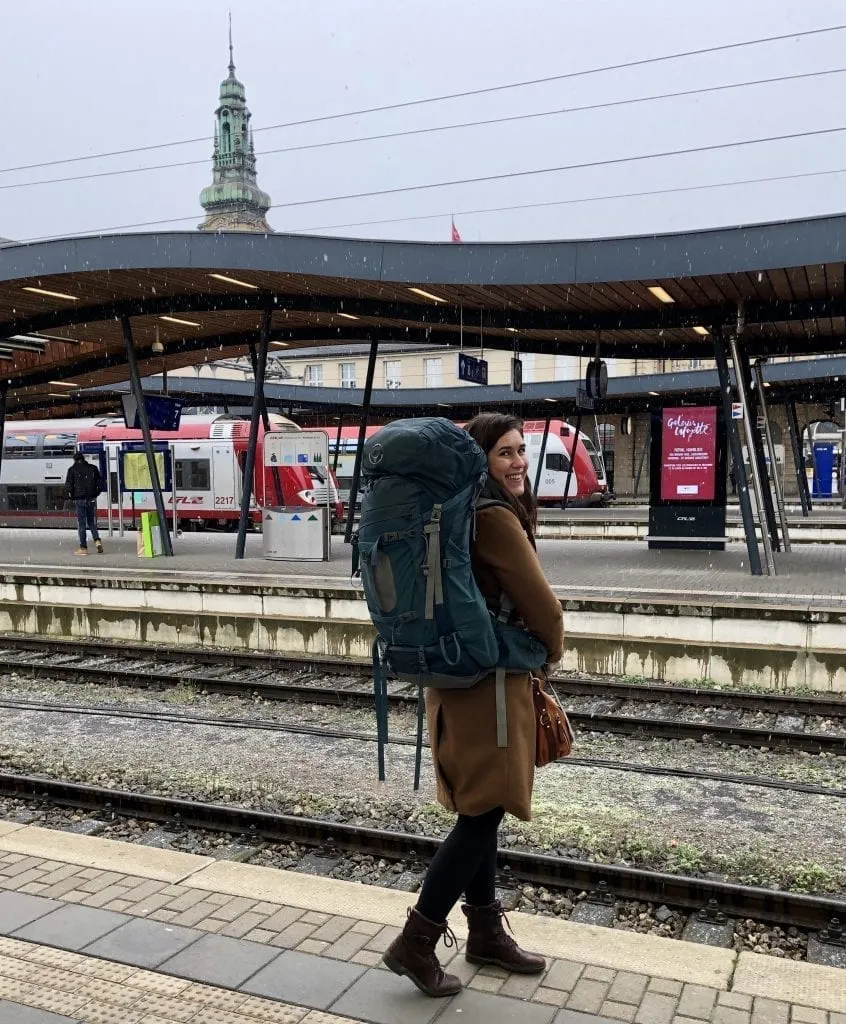
Some links in this post may be affiliate links. If you make a purchase through one of these links, we may earn a small commission at no extra cost to you. Please see our disclosure policy for more detail.
If you’re planning an epic, multi-destination trip and are hoping to travel by train through Europe but aren’t already comfortable with train travel on the continent, then this guide to traveling by train across Europe is for you!
We grew up in suburbs in the USA, and until we started traveling internationally in adulthood (4+ years of full-time travel , more than a year living in Lisbon, many trips across Europe, and counting!), we had virtually never taken a train.
W hile that’s certainly not the case for many people around the world, it is for thousands of our readers who grew up in similar environments to us!
If you’re excited to travel Europe by train but are learning the whole process from scratch like we once did, you’re exactly who we wrote this guide for.
While train travel in Europe isn’t exactly the same everywhere–with over 50 countries and therefore over 50 train systems, there are plenty of quirks based on location–this guide to train travel in Europe will give a solid overview that will help you start your travels with confidence.

Planes, trains, buses, rental cars, river cruises–with plenty of transportation options for getting around Europe, how do you know if train travel is for you?
In this section, we’ll break down the pros and cons of traveling Europe by train to help you decide if it’s the right transportation option for you.
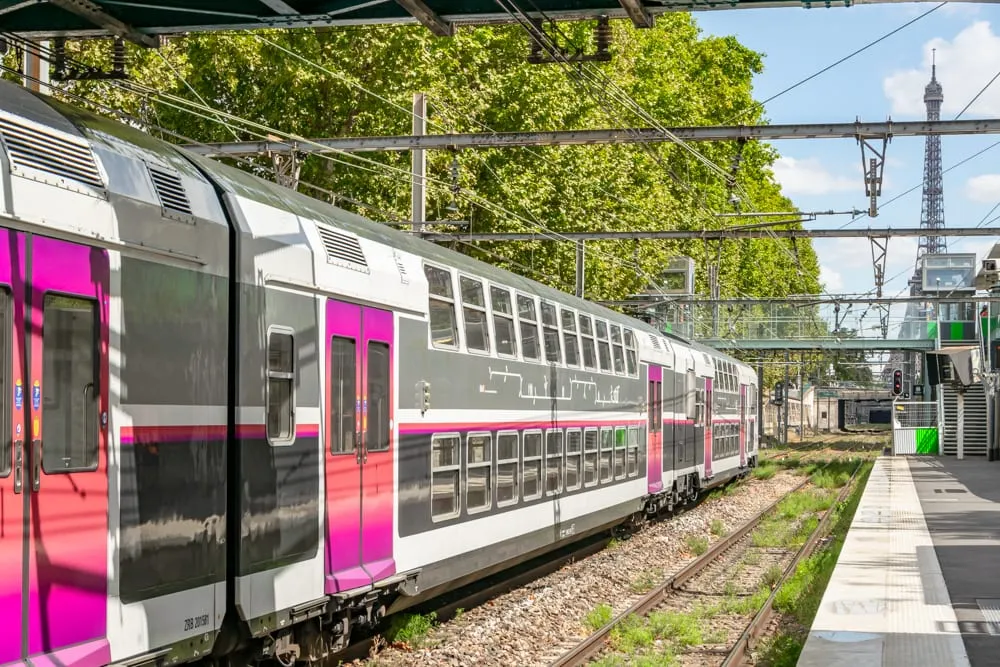
Pros of Traveling Europe By Train
Taking a train across europe is a bucket-list-worthy experience..
For most of us who hail from other places, this is the number one reason to book that first train in Europe, right?
Traveling by train through Europe tops plenty of bucket lists around the world, and for good reason: it’s an incredibly fun way to explore the continent.
On some routes, the train ride is a travel destination in its own right–and even when it’s not, it’s a cultural experience to remember.
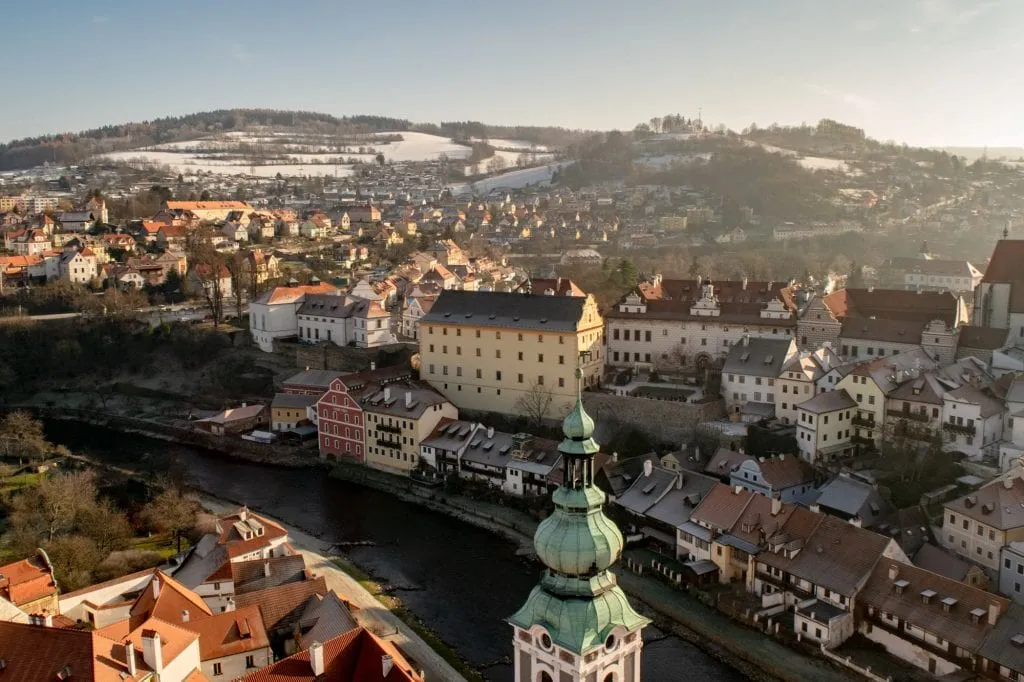
… and can allow for spontaneity.
For some routes, especially those with fixed ticket prices (more on that in another section of this Europe train guide), traveling by train allows you to be spontaneous, coming and going from destinations with much less foresight than is required when taking planes.
Depending on where you are, it can be very scenic.
If you have daydreamed about staring out train windows in Europe as you watch mountains, streams, seas, villages, castles, and vineyards go by, let me tell you… that’s pretty much exactly what it’s like a lot of the time!
Obviously not everywhere on the continent is scenic, but if you travel Europe by train, you’re likely to experience some truly incredible views along the way.
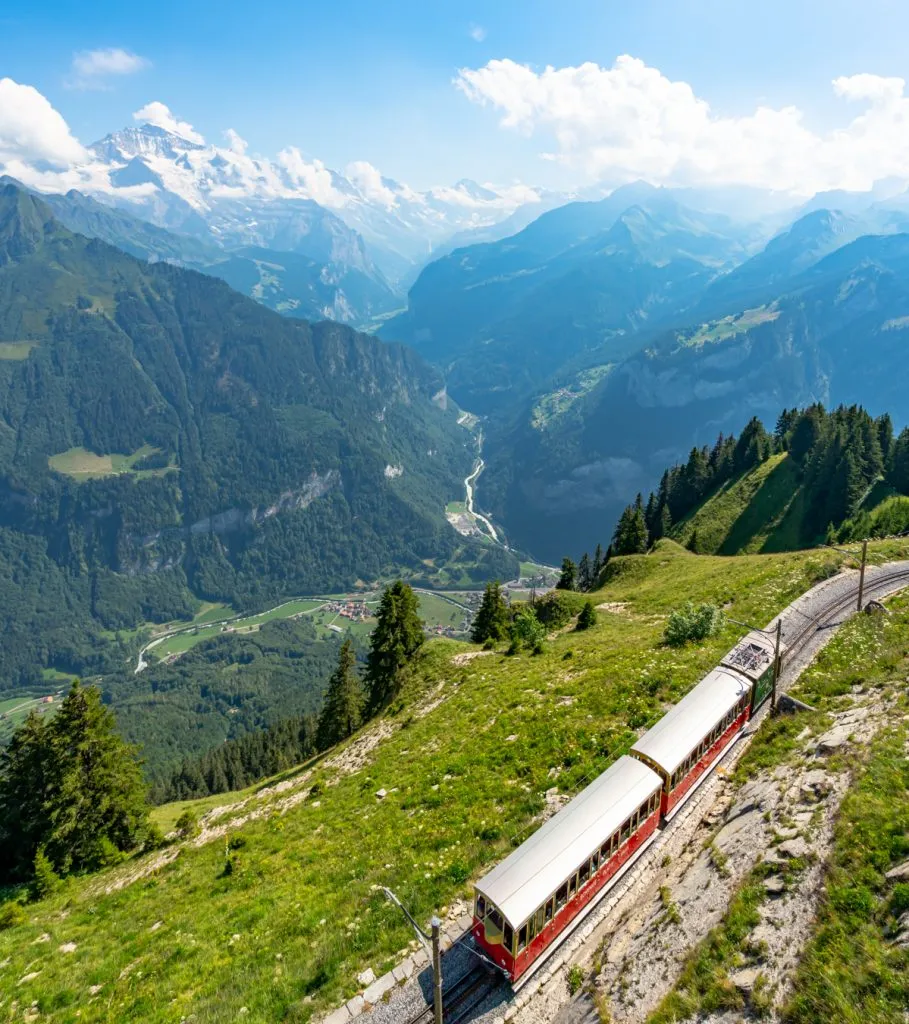
Most train stations are in the center of the city.
In our opinion, this is one of the biggest benefits to train travel in Europe!
W hile most airports (especially airports servicing budget flights) are located far outside the city centers, train stations are generally located right in the heart of the action.
Step outside the train station in Cologne, for example, and you’ll be looking at the cathedral.
In Florence , you’ll arrive less than a 10-minute walk from the Duomo .
In some places, like in Milan, Antwerp, Porto , and Paris’ Gare de Lyon, the opulent central train station is practically a tourist destination in its own right, so you’ll be exploring the minute you arrive, rather than spending hours getting into the city center from the airport.

No luggage limitations!
No one is going to weigh your luggage or make sure it is only a certain size on a train, so you can bring whatever you like (sports equipment and generally pets included).
Train travel in Europe is generally far more comfortable than flying.
At the end of the day, traveling Europe by train is immensely more comfortable than flying.
There’s less hassle, more comfortable seats, more ease of moving around, often better views, and more control over your environment.
If all else (price, time, etc.) were equal, we’d personally choose to take a train across Europe over a plane any day of the week.
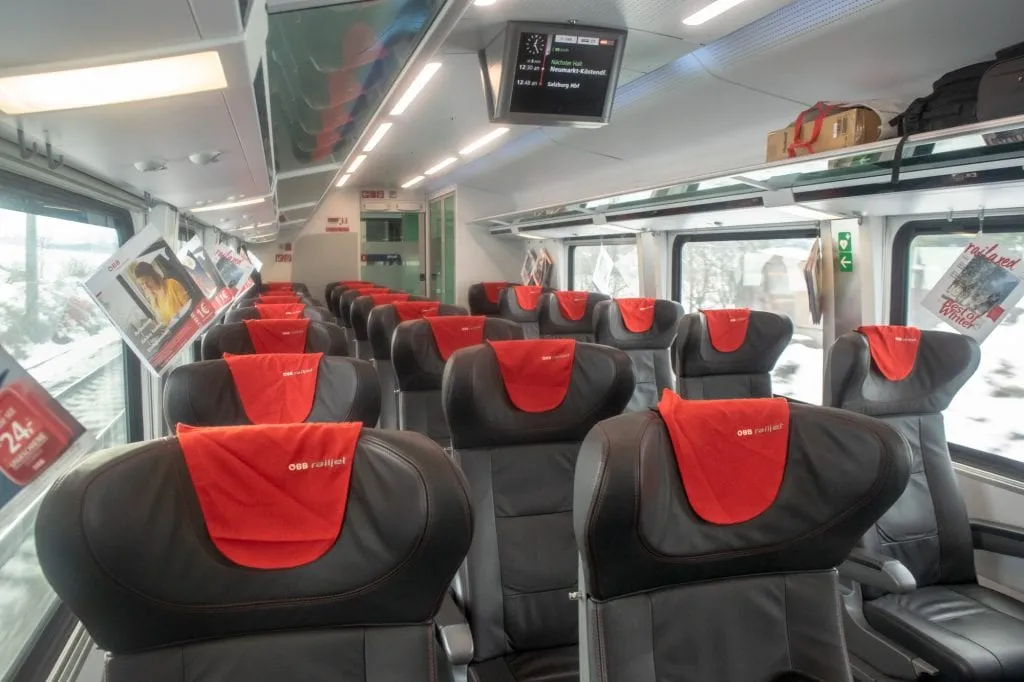
Cons of Traveling by Train Through Europe
It can get pricey..
When you first set out to travel Europe by train, you may assume that it is more affordable than flying–but thanks to a combination of several factors, including incredibly inexpensive budget flight carriers in Europe, that’s actually not the case.
Typically, it’s cheaper to hop on a budget flight between two major European cities than take a train.
The severity of the difference, though, can vary dramatically, and there are lots of tips you can apply to your train travel in Europe to mitigate the cost, which we’ll cover in this blog post.
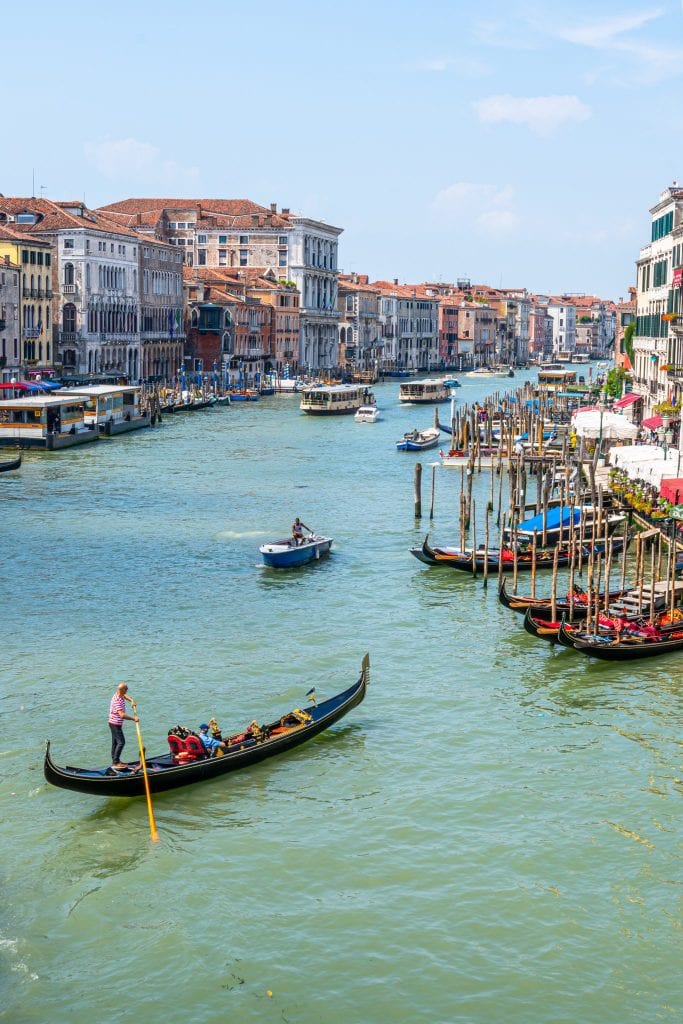
If you’re traveling long distances, train routes can take a prohibitively long time.
For example, when traveling from Paris to Venice , a route we’ve traveled by train, the train can easily take upwards of 10 hours, while the flight time is under 2 hours.
Now, that doesn’t account for getting to and from the airport, checking luggage, or going through security, all of which increase the amount of time a flight actually takes, but it’s still a large difference.
Train travel in Europe isn’t available everywhere.
As you move further into eastern Europe and the Balkans, train travel becomes much less prevalent (even popular Dubrovnik isn’t connected to the rest of Europe by rail).
A nd, when it does exist, can take longer and be less comfortable than planes or even buses depending on the destination.
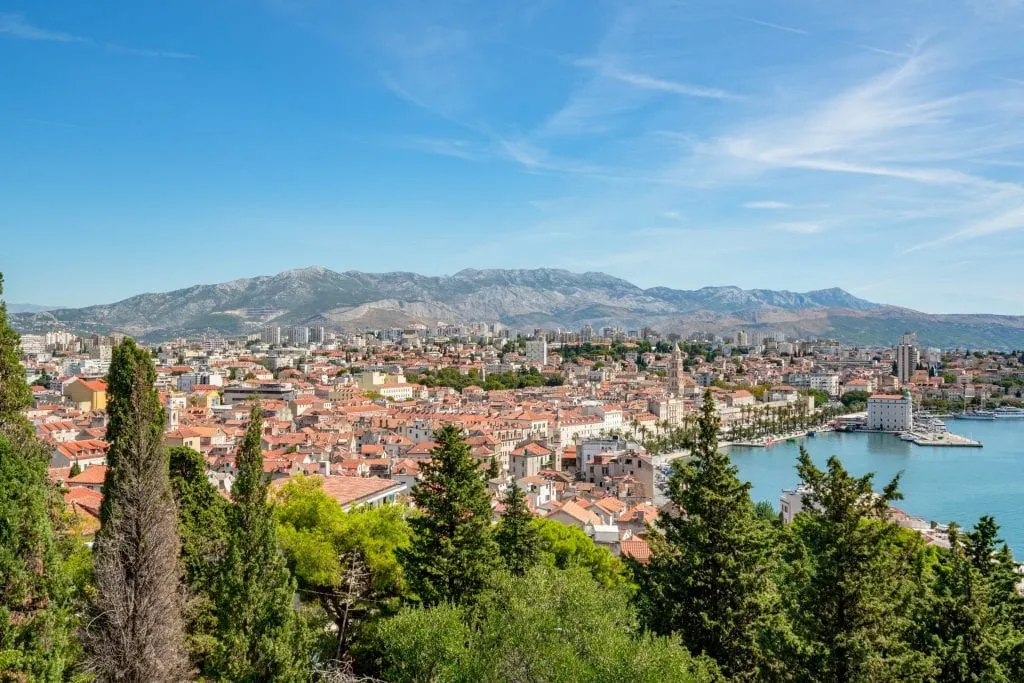
Rail strikes can derail plans to travel Europe by train.
Generally, these are planned in advance, so you’ll know what you’re getting into before arriving, but they can be a bit of a hassle.
W e’ve had trips to both Italy and France impacted by rail strikes in the past.
If you have mobility issues, train travel can be difficult.
Lifting and storing luggage, navigating small staircases and bathrooms, and making your way through crowded train stations can be difficult if you struggle with mobility, so keep that in mind when deciding whether to travel Europe by train.
This is especially true with a short connection–we once had to literally sprint through the station to make a connecting train on time in Germany!
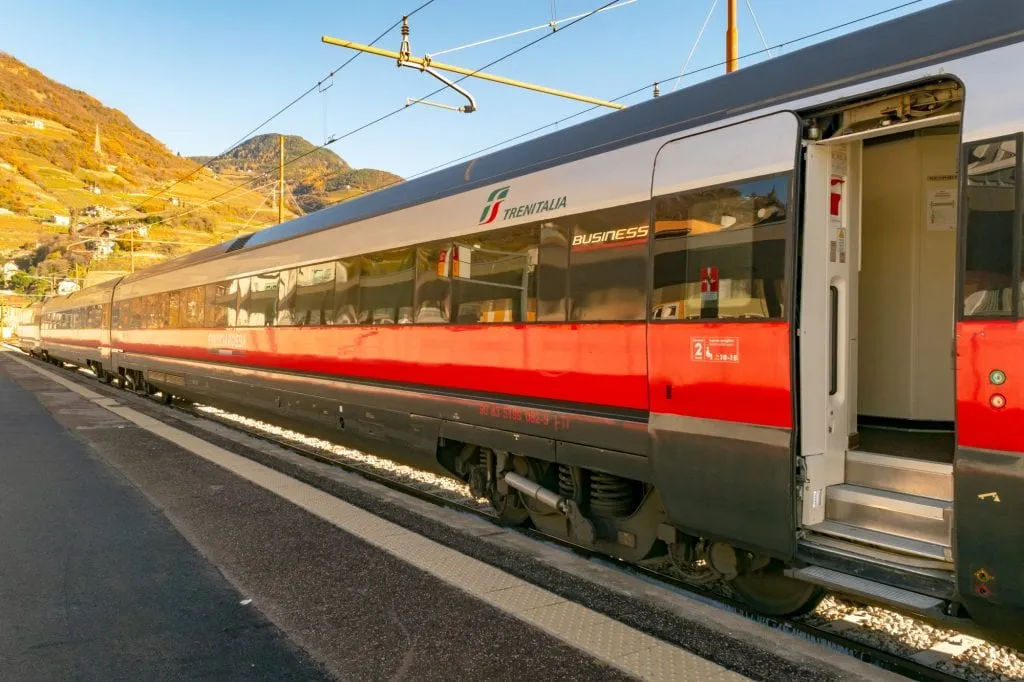
Traveling Europe by train can be a bit intimidating.
This isn’t a con, exactly, but there’s no doubt that the confusion surrounding train travel in Europe can prevent new visitors to the continent from trying it out, especially if they’re concerned about language barriers or navigating multiple countries.
If that’s your only hesitation, though, we urge you to set those concerns aside.
T raveling Europe by train is an incredibly rewarding experience, and well worth stepping a bit outside of your comfort zone for !

When discussing train travel in Europe, it’s important to remember that not all trains are created equal, or exist for the same purpose.
Here are a few general train categories to keep in mind as you plan your trip.
Metro/Intra-City Transport
Metros, aka subways (though some do run above ground) are public transportation used by a certain city.
While they are technically trains, metros are their own category entirely and this Europe train guide doesn’t cover them any further.
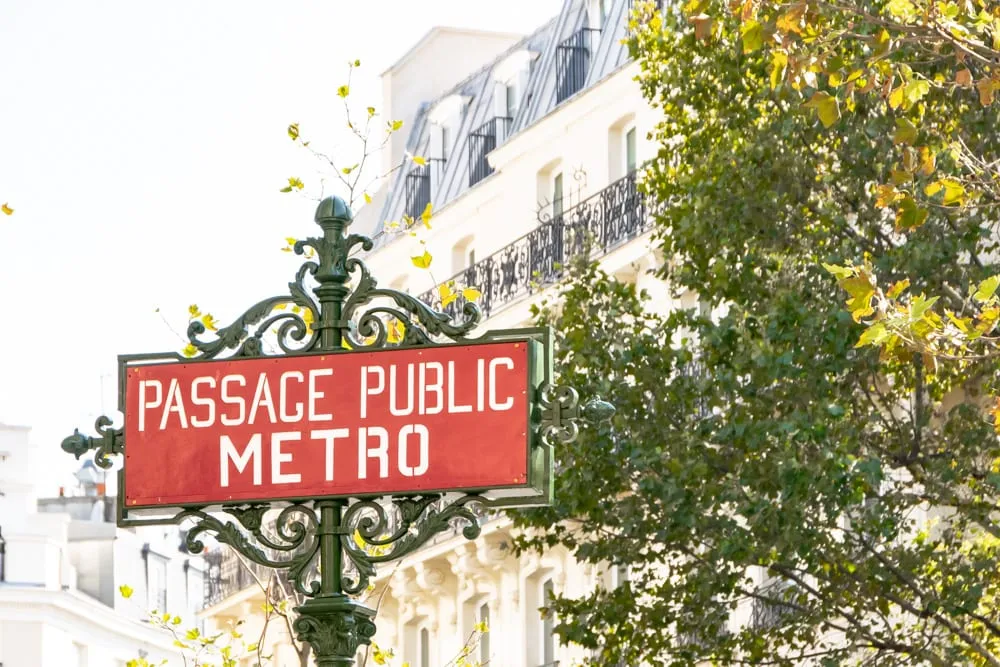
Commuter Rails/Regional Trains
Commuter rails and regional trains aren’t exactly synonymous, but for the purposes of this guide, they’re similar.
T hese are slower-moving trains used to connect surrounding villages to a major city (for example, Versailles to Paris) or trains that go within a certain country or region (for example, from Siena to Florence in Tuscany).
Most of the tips in this guide to train travel in Europe apply to these trains, but they sometimes have fewer amenities (like snacks/drinks available for purchase, for example) than high-speed or long-distance trains.
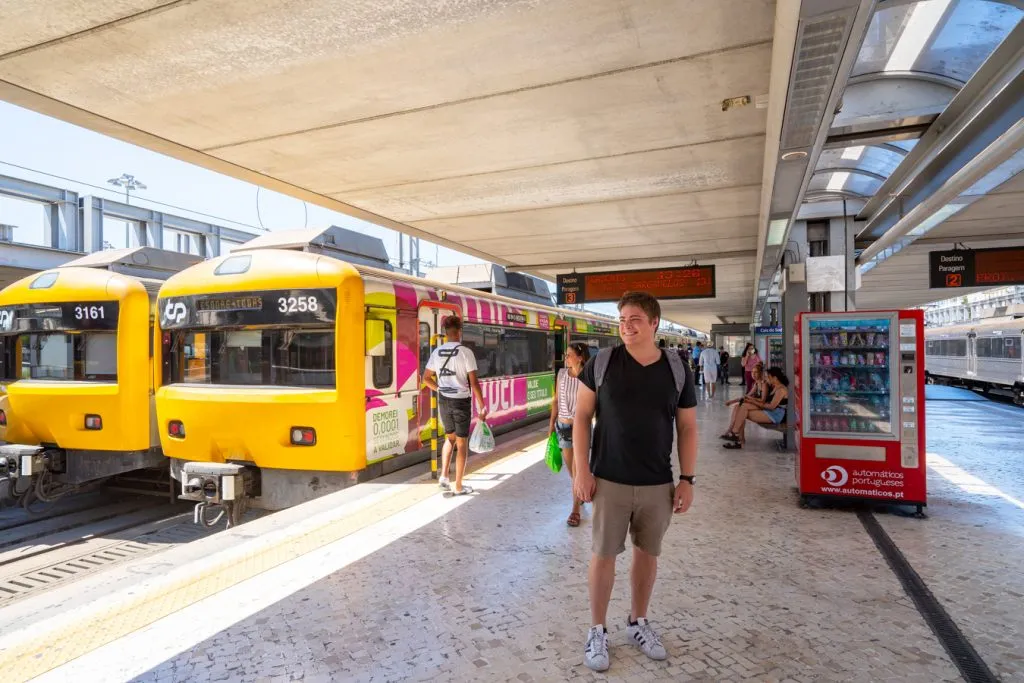
High-Speed Trains/Long-Distance Trains
These are trains that cover long distances within a country (for example, from Florence to Venice ) or cross borders (for example, from Paris to Amsterdam).
Since each country runs its own train system (often with a national carrier option and private carrier(s) mixed in), booking a ticket between countries may mean changing train companies at a city near the border.
For example, when we traveled from Paris to Venice by train, we took a French SNCF train from Paris to Turin, Italy, and then boarded an Italian Italo-branded train to travel from Turin to Venice–all booked on the same ticket.
These high-speed and long-distance journeys are the primary focus of this guide on how to travel Europe by train.

Tourist Trains
These are trains that, while technically public transportation, are typically used as tourist attractions for sightseeing purposes, and are priced accordingly.
Examples include the Glacier Express or Schniyge Platte in Switzerland, or the Jacobite Steam Train (aka Harry Potter train) in Scotland.

Sleeper Trains
Technically, sleeper trains aren’t their own category–they’re just long-distance trains with sleeper carriages in them–but they’re worth calling out separately in this guide to train travel in Europe because they’re particularly interesting for travelers.
Not only are sleeper trains a great way to save on hotel costs for a night of your trip, but they can also be quite the travel adventure in their own right!

Before you start looking into buying train tickets, there are a couple of terms to be familiar with:
First vs. Second Class Tickets
When traveling via train in Europe, you’ll generally have a choice between first and second-class tickets.
Buying a first-class ticket generally comes with slightly larger seats, sometimes the ability to reserve your exact seats when you can’t in second class (both of those facts vary based on the company you travel with), and possibly a small snack like a water bottle and a pack of cookies.
In our earlier travel years, we never used to consider these perks worth the money–but I’ll admit, as we started traveling with more luggage and most importantly, our dog Ranger, we started splurging on first-class more frequently.
The extra space can definitely come in handy if you have more than a suitcase with you!
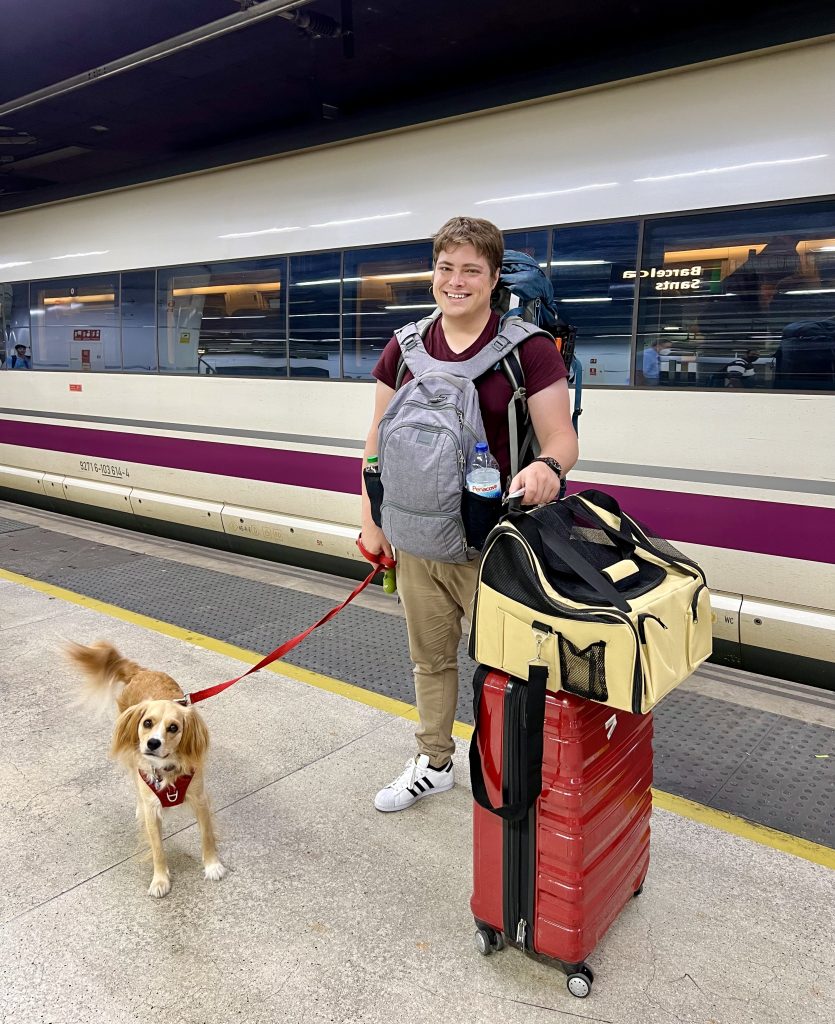
Variable vs. Fixed Price Tickets
Variable-price tickets, as the name implies, tend to increase in price the closer your date of travel gets.
T hese tickets are generally used for high-speed trains and long-distance journeys and will be the most common form of ticket you see when traveling between countries by train in Europe.
Fixed-price tickets are more typical for regional (aka “slow”) trains and can be booked at any time–so you can just show up at the station and buy them from a kiosk without issue.
For example: if you travel from Florence to Bologna on a high-speed train, it will take around 30 minutes and that ticket has a variable price.
If you travel on the regional train that takes around an hour, the price is fixed and you can book it at any time.

When you travel Europe by train, one of the first things you’ll need to get the hang of is exactly how and where to buy European train tickets–and you have plenty of options!
Here are different ways to obtain train tickets in Europe.
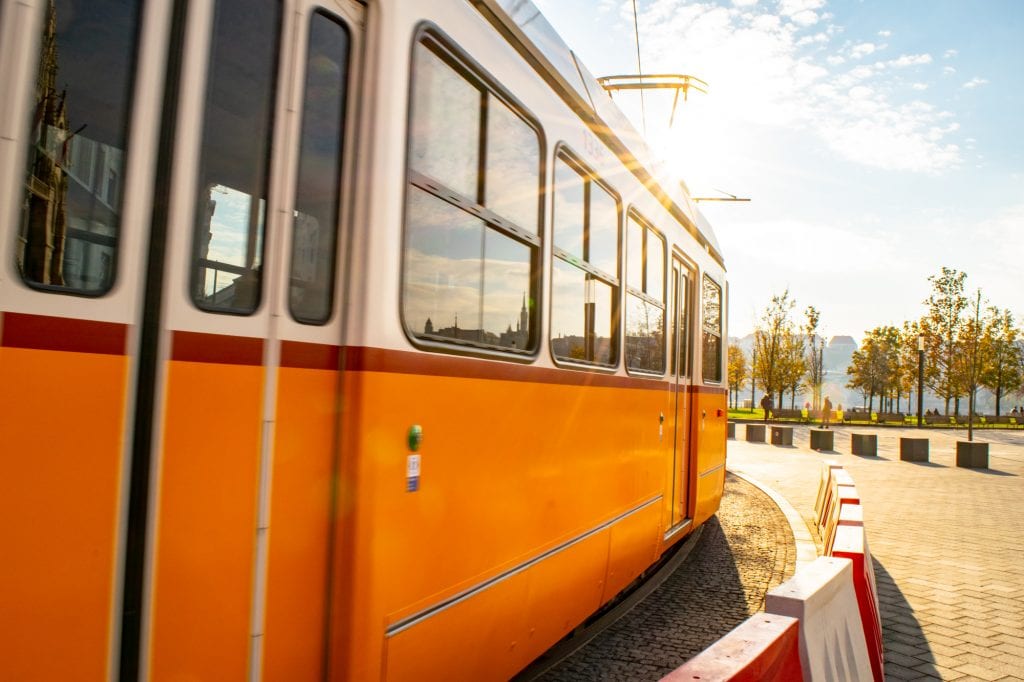
Online (Via a Third-Party Site)
Third-party booking sites are incredibly useful when preparing to travel Europe by train, especially when you’re planning to travel between countries.
We use and recommend Omio , which will allow you to easily compare prices between different routes, show you the most efficient path, and allow you to book trains across Europe with no concerns about language barriers, iffy online translations of national websites, or issues with payment (some company websites struggle to process foreign credit cards).
Omio is a ticket aggregate, and searches multiple companies and routes at once, which makes it very handy for checking train timetables and possible routes as well as for booking tickets!
Search train routes and tickets prices in Europe today!
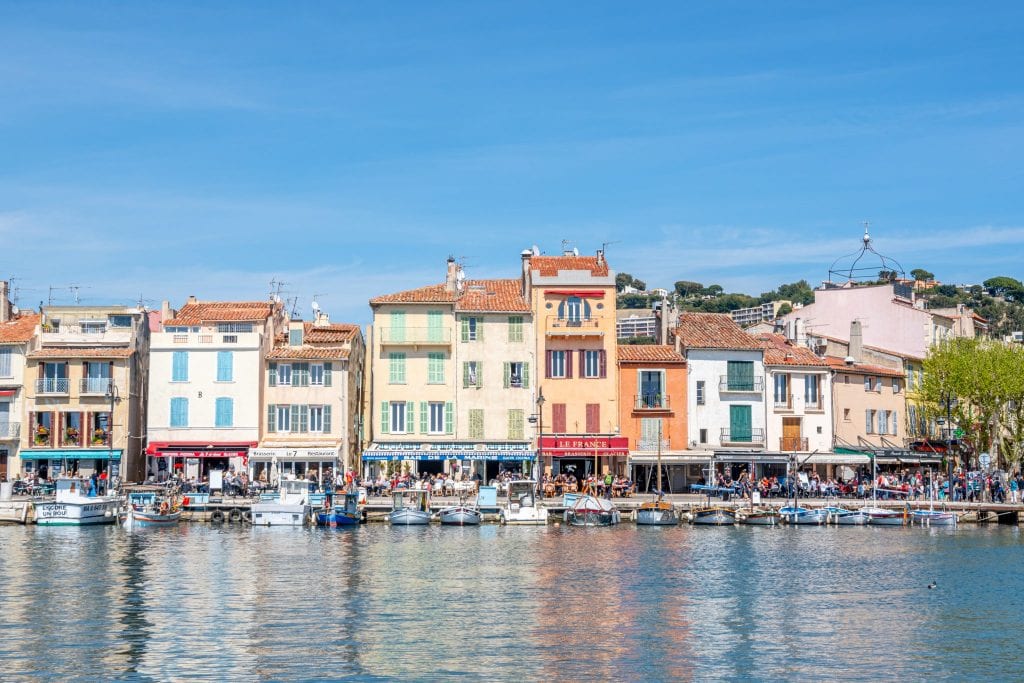
Online (Via the Company Directly)
Alternatively, if you’re looking for the best possible deal, you can book tickets online through direct websites for most countries in Europe.
For example, here are the national train company websites for Italy , France , and Germany .
We tend to book directly whenever we’re traveling domestically in a place we’re very familiar with, like Italy.

At the Train Station
If you’re traveling a short distance on a regional or commuter rail (like to take a day trip, for example), you can also buy tickets directly at the train station.
If you’re buying train tickets in person, we recommend using the kiosks available whenever possible.
Not only do they tend to have language options that make things much easier, but they also tend to take a fraction of the time of waiting in line to be helped by a person directly.

With a Train Pass
The final option for booking tickets to travel Europe by train is to do it in one fell swoop with a Eurail pass (for non-European residents) or Interrail pass (essentially the same thing, but for European residents).
Essentially, a Eurail pass will allow you to buy a certain number of train rides (or an unlimited number) in advance, allowing you to be more spontaneous in your travels.
However, there are limitations–for example, some routes still require advance reservations and charge additional fees.
G enerally speaking, the average user will end up spending more on train travel in Europe with a pass than without one.
There are cases where a train pass makes sense, though, so if you’re planning lots of European train travel, especially in Western and parts of Central Europe , be sure to run the numbers to see if a European train pass is right for you!
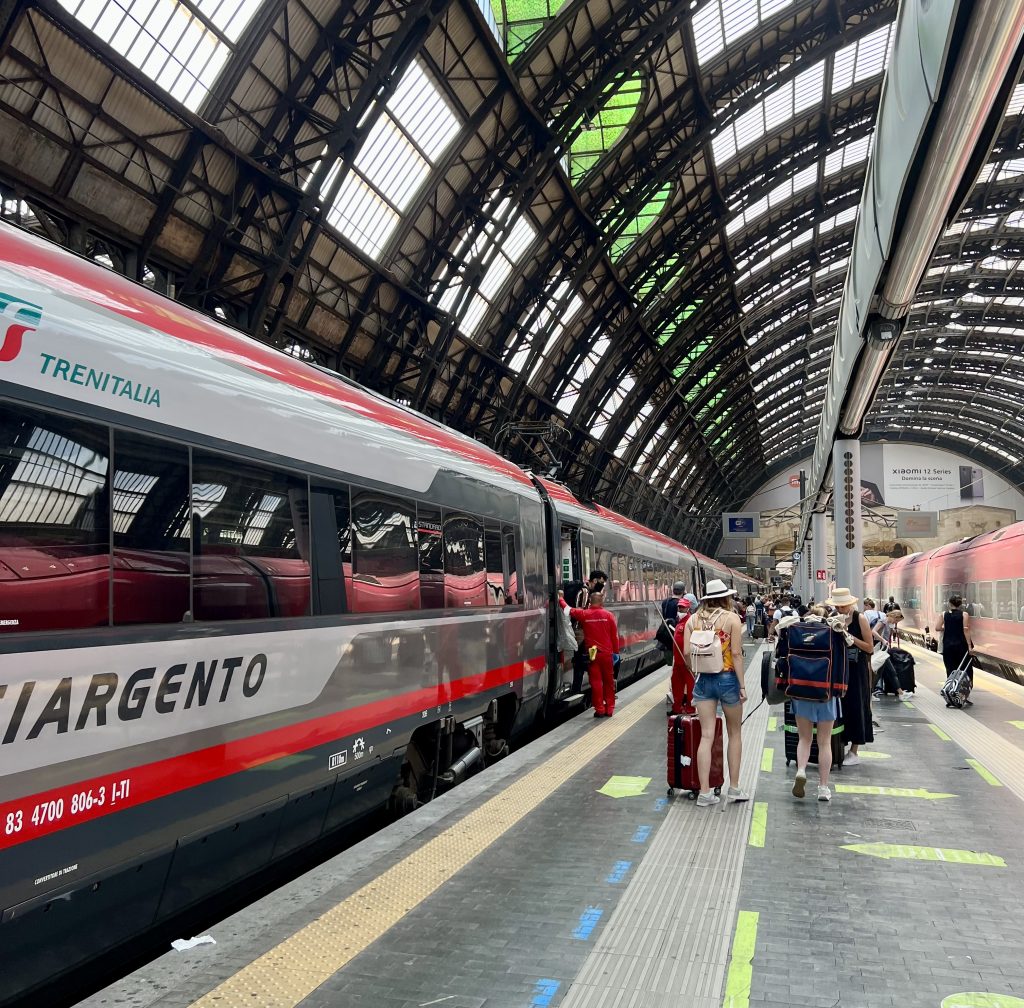
Once you buy your tickets, the next step is to actually receive them!
Here are the three main options.
Most European train tickets these days can be received online and downloaded to your phone.
When available, this is by far the easiest and quickest way to receive your tickets.
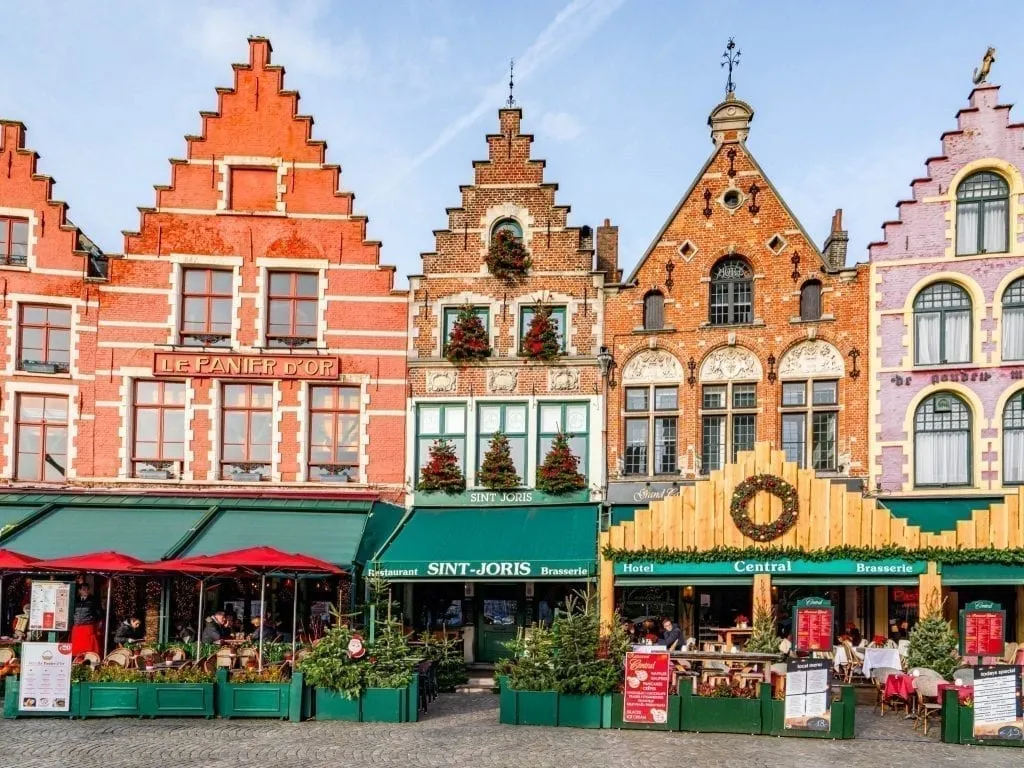
At the Station
You can also choose to receive your (paper) tickets at the station you’re departing from, either by purchasing them there as mentioned above, or by picking up tickets you bought online.
In most cases, there’s no real reason to pick up paper tickets you bought online as opposed to simply downloading them, but most countries do still have the option.
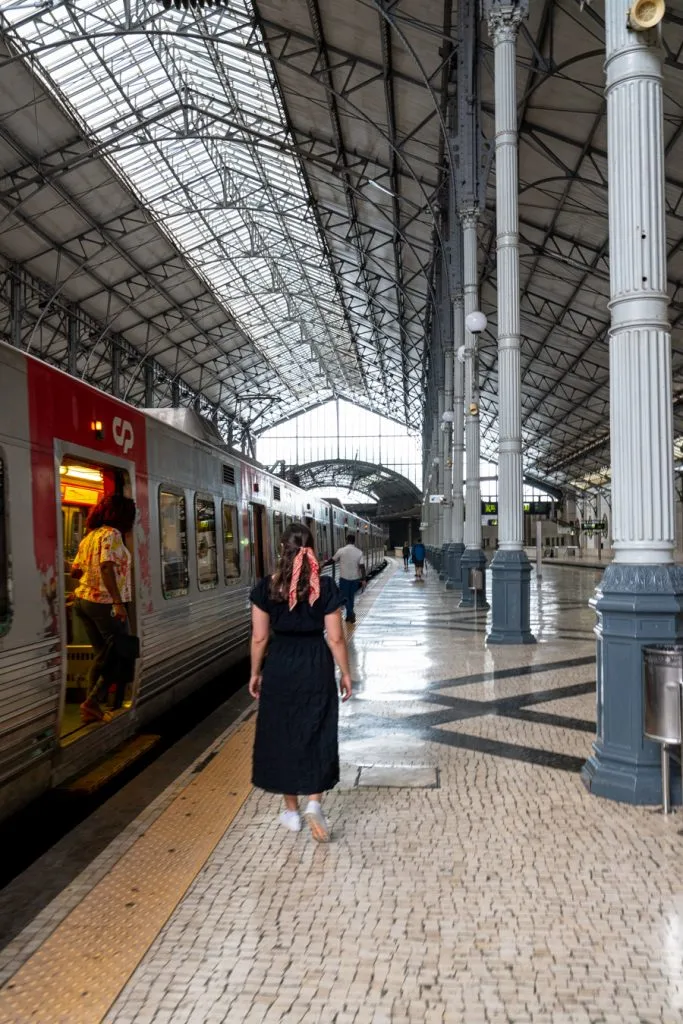
If you book tickets to travel Europe by train well in advance of your trip, many countries do also have a home delivery option where they can be mailed to you before you travel.
We took advantage of this for our very first multi-country trip to Europe and had our train tickets for our overnight route from Krakow to Budapest mailed to our then-home in San Antonio.
Honestly, it was complete overkill, even as the novice travelers we were then, and we don’t necessarily recommend doing this–but some places do have the option available.
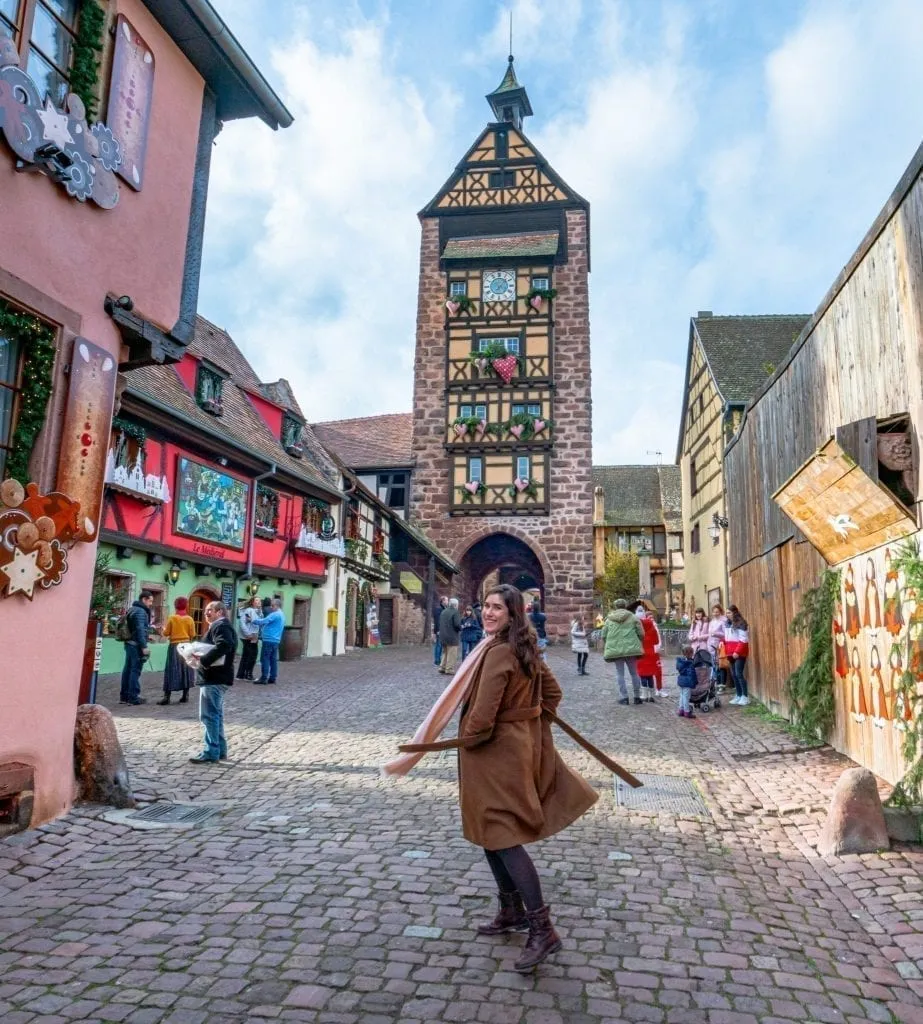
If you’re confused, concerned, or just slightly intimidated by train travel in Europe but are ready to book your first journey, this section is for you!
Follow these instructions step-by-step, and you’ll travel Europe by train with ease.
Book your ticket.
Generally, for long or inter-country journeys, booking online is the easiest option as we outlined above.
We use and recommend Omio for booking train tickets in Europe.
Shop train tickets across Europe today!

Make sure your ticket is in hand.
This can mean downloaded onto your phone or printed onto a piece of paper in your hand.
E ither option works in most places, but whichever you choose, make sure you have your ticket handy when you board.
Head to the (correct) train station.
Most major European cities are home to more than one train station, so be sure to double and triple-check that you’re going to the right one before you set off.
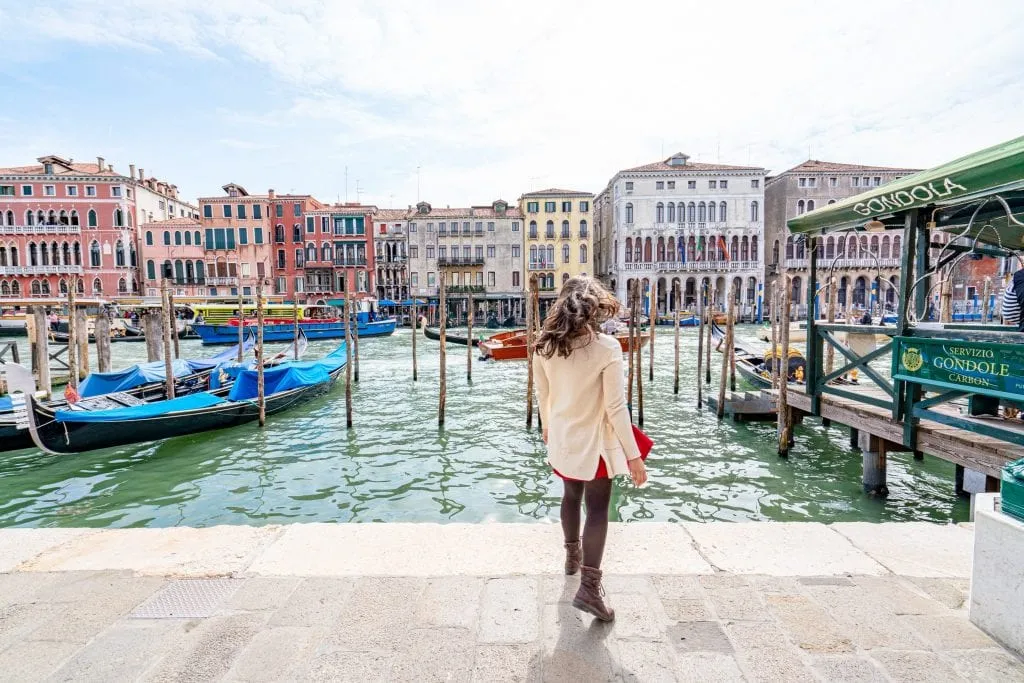
Find your platform.
Much like in an airport, your first step to finding your train platform will be to check the (often large, sometimes confusing) boards bearing destinations and times.
It’s best to search for your train based on a combination of the train number, company, and departing time– not the destination.
If your train is continuing past your stop, for example, searching by destination can get very confusing, very quickly.
European trains (and Europe in general) also use the 24-hour clock (so 3:00 PM will be displayed as 15:00, etc), so keep that in mind when looking for your train on the departures board.
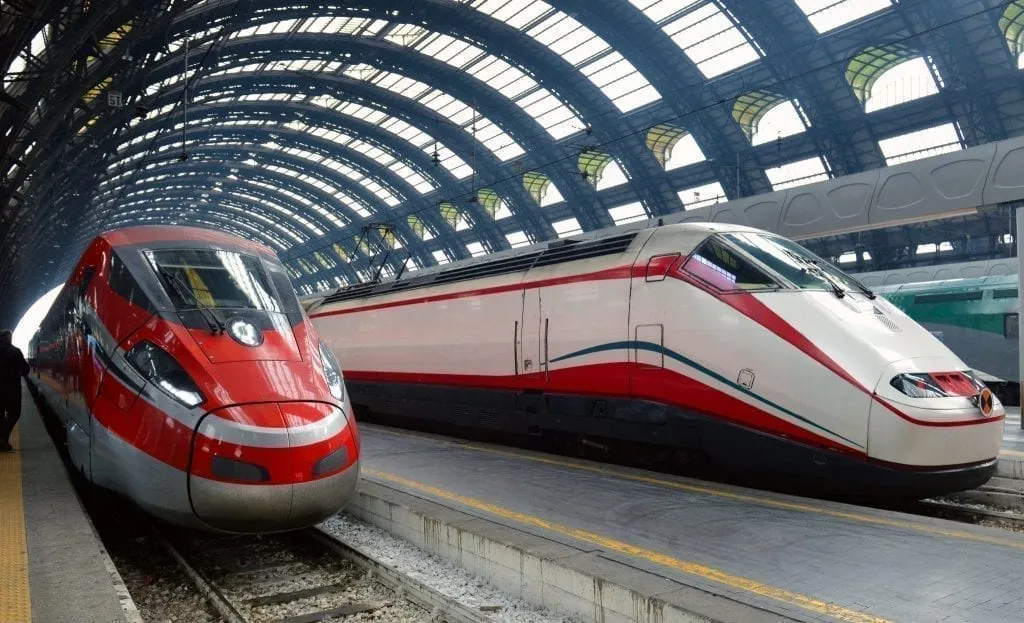
Validate your ticket.
If you have a paper ticket, you’ll need to validate it before you board.
T he kiosks to validate your ticket are generally placed just before you reach the platform, but can sometimes be easy to miss if you’re not looking for them.
(As far as we’re concerned, this hassle is another point in favor of online/downloaded tickets.)
If applicable, find your train car and seat number.
If your train has reserved seats, you’ll need to find the exact train car number and seat number to sit in.
T his is most common on long-distance, high-speed trains.
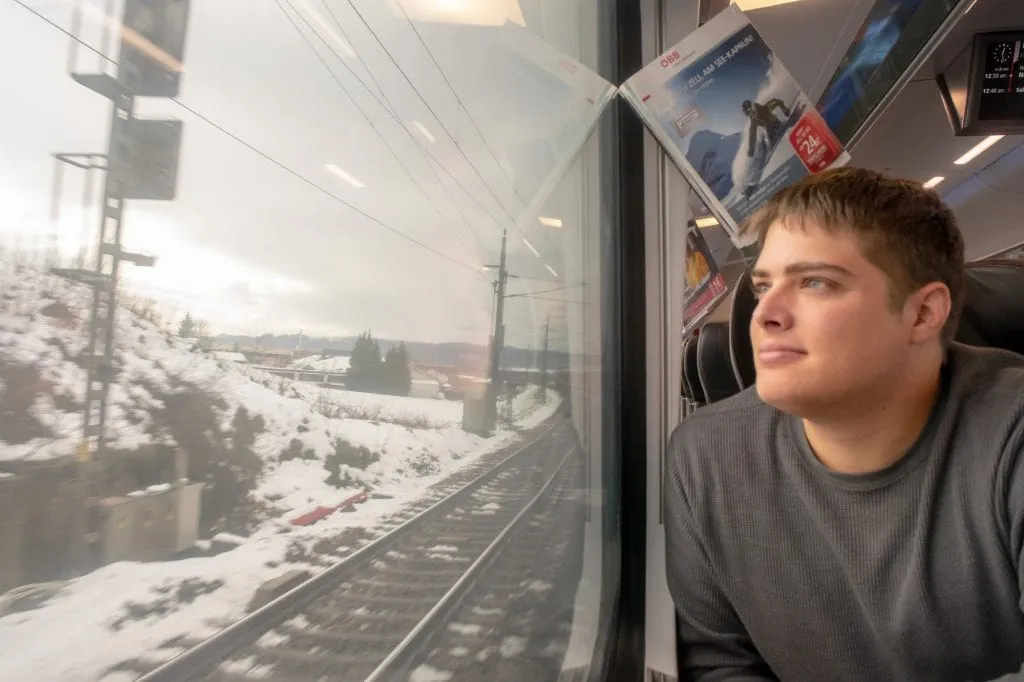
… Or just look for the appropriate class.
If your train has open seating, the only seating concerns will be whether you sit in the 1st or 2nd class.
The “1” or “2” denoting whether it’s a first or second-class train car is generally marked obviously on the side of the train, near or on the door itself, so it’s fairly easy to make sure you’re in the correct place.
Stow your luggage.
In some trains, this will mean storing your luggage in the racks provided at the ends of each train car, in others, it will mean in the racks above the seats, and in still others, there are even places to store bags between the seats.
Keep an eye on what others are doing, but keep in mind that as long as your luggage isn’t in anyone else’s way, there’s generally some flexibility to the process.

Settle in and enjoy the views.
Once you’ve found your seat and stored your luggage, it’s finally time for the best part of train travel in Europe: kicking back and enjoying watching the world go by.
No matter how many times we ride trains through Europe, we never stop getting a little thrill during this part of the process!
Keep your ticket handy for when the conductor comes by.
At some point, as you travel Europe by train–and it could be 5 minutes into your ride, 5 hours into your ride, or both–a conductor will come by to check your ticket.
Be sure to have your ticket in a convenient place so that you’re ready when this happens!

Listen carefully as you get close to your destination.
As you begin to get close to your destination, it’s time to pay very close attention to the announcements.
Many European cities have train stations that sound very similar to each other, especially to those not familiar with them (for example Roma Tiburtina and Roma Termini), and you’ll want to be certain to exit the train at the correct stop.
O therwise, you might accidentally find yourself deep in the suburbs instead of in the center of the city!
In many places, especially along routes popular with tourists, arrival announcements for each station will be repeated in English, but that’s not a guarantee.

Exit the train quickly and smoothly.
When you reach your stop, be ready to exit immediately–that means luggage in hand and waiting at the end of the train car to exit.
You’ll generally see people start to queue up a few minutes before arrival.
The train stops long enough for everyone to exit comfortably, so you don’t need to push past other people or even hurry if you’re prepared.
However, if you wait until the train stops before even getting your luggage together, well–if your station isn’t the final stop, you might find the train moves on before you have time to get off.

If you have your heart set on traveling Europe by train, plan ahead.
As you plan your Europe itinerary , you’ll likely find that some destinations are better suited for traveling Europe by train than others, and it definitely pays to know which destinations require a train, plane, or bus before arriving in Europe.
Train travel in Europe is generally best suited for certain Western and Central European countries–the further you move into the Balkans and Eastern Europe, the more limited (and, shall we say, adventurous) it becomes.
And, despite being situated essentially as far to the west of Europe as you can get, Spain and Portugal are surprisingly isolated from the perspective of train travel (this is due to having a different size of railroad gauge than other countries in Western Europe).
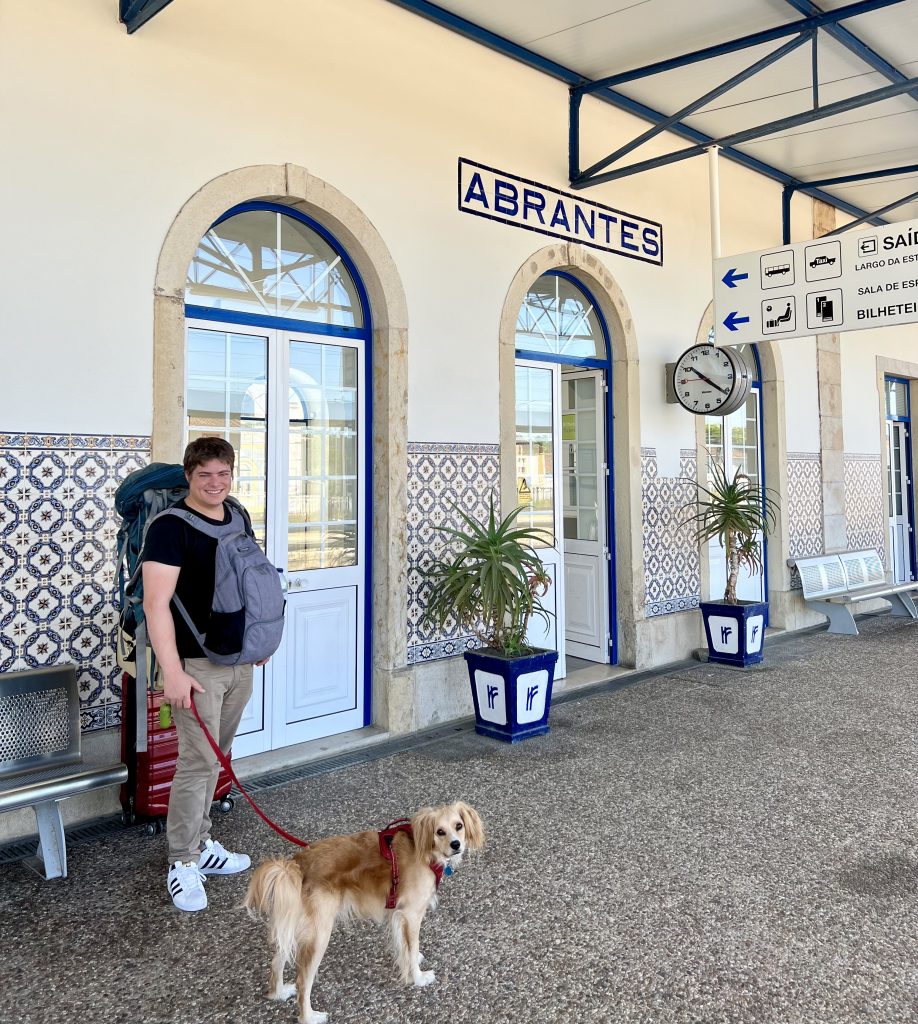
Distance also plays a key role.
Traveling from Paris to Venice by train is a long but completely doable day, but Paris to Zagreb , not so much–that route is better suited to a plane.
Add in the fact that you’ll want to book your variable-price tickets in advance, and the bottom line is that you should definitely bank on planning at least the most important routes in advance.

Definitely book complex routes for train travel in Europe in advance.
If you’re traveling from Rome to Florence or Madrid to Barcelona, especially if you don’t mind taking a regional/slow train, you can book your train tickets once you already arrive in Europe.
For more complex or longer routes, though, you’ll make things much easier on yourself if you book before you start your trip abroad.
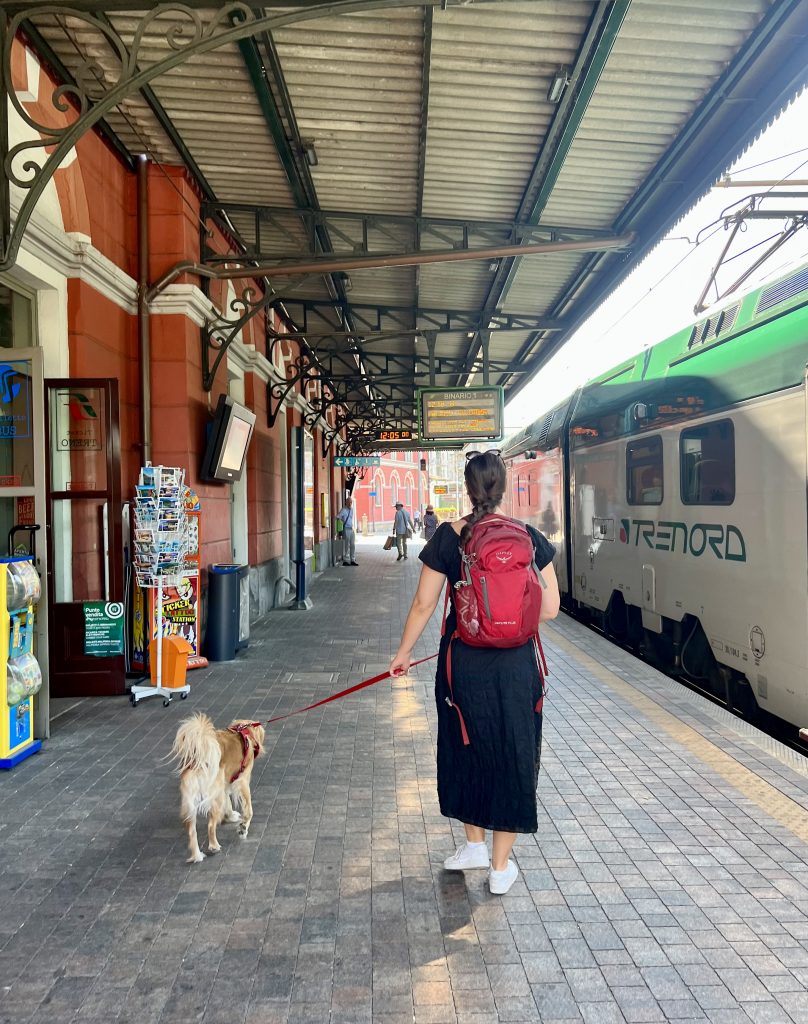
Bring snacks and drinks along for the ride.
While most long-distance routes will sell simple food on board like sandwiches, drinks, and pre-packaged snacks, the selection is generally about on par with airplane food, in other words, expensive and unexceptional.
Commuter and regional trains are much less likely to sell food on board.
On long-distance trains, there’s typically a dining car you can visit to make purchases, and on some routes (especially in first class), a restaurant cart will come around offering a few items, similar to a flight attendant.
Better not to worry about it, though: we recommend packing plenty of snacks (or even a full meal) and drinks to bring along, which is completely typical on trains in most places in Europe.

If you have a long train ride ahead, consider packing cards or a game.
Not only will this help entertain you throughout the journey, but it’s also a great way to meet other travelers!
Don’t count on having internet access onboard.
Even if you have a European SIM card and are traveling within the Schengen Zone (where SIM cards are supposed to work across borders), maintaining an internet connection on a European train ride is iffy.
B etween tunnels, remote countryside, border crossings, etc., it’s best not to count on having access.
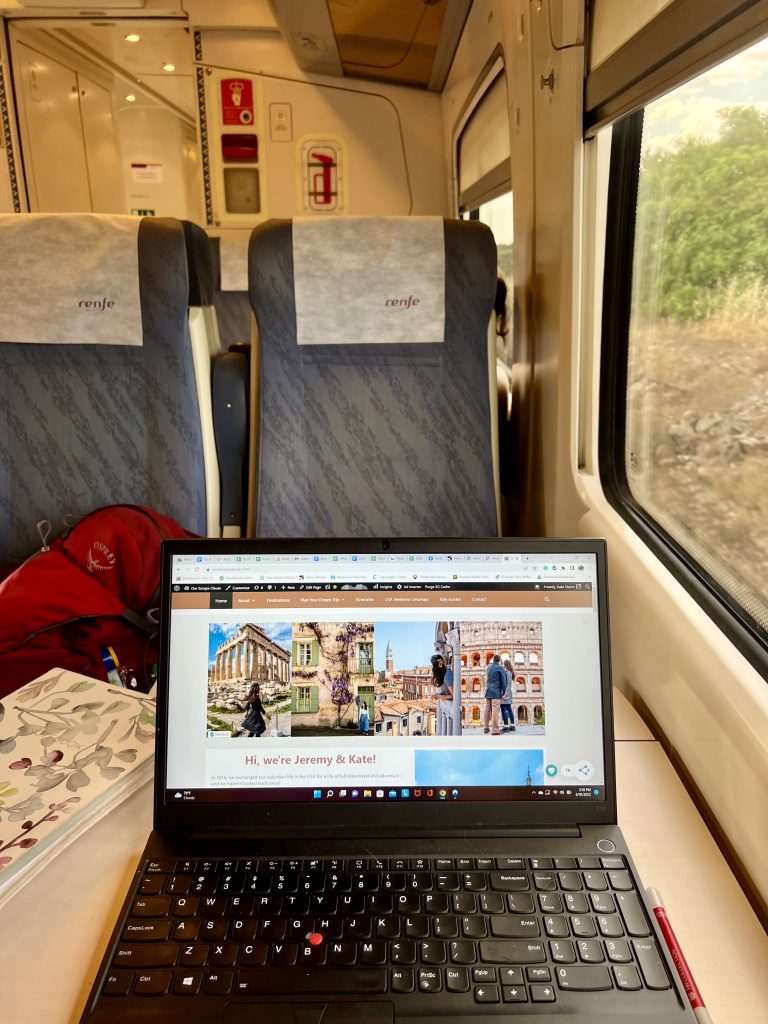
If the train advertises wifi, don’t count on that either–some of them require a local tax ID number or phone number to access.
We’ve found that our best bet for internet access during train travel in Europe is whenever the train briefly stops at a station.
If you have a SIM card that works for that destination, you can usually expect at least a few minutes of connectivity there.
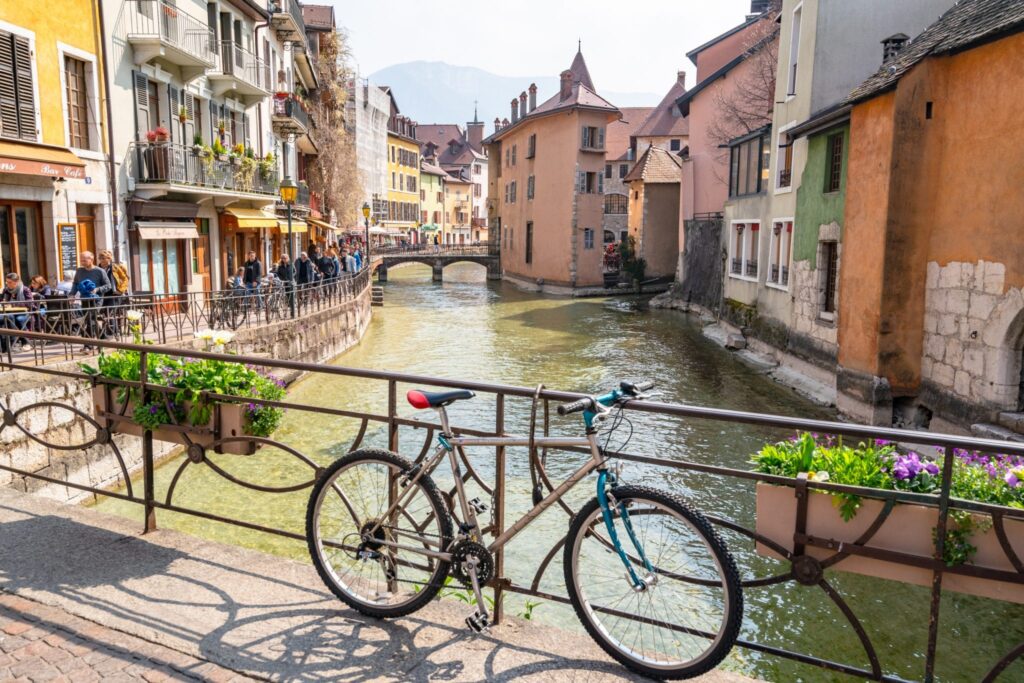
Make sure you go to the correct train station.
We mentioned this above, but it bears repeating: be very certain that you go to the correct train station when traveling by train through Europe… and that goes for when you get on and when you get off!
… And show up early.
Some train stations in major cities are enormous, and can almost resemble airports, with 30+ platforms, various levels, and in some cases a mall inside them (like Roma Termini, for example).
If you’re not familiar with the station in question, be sure to leave yourself plenty of time to find your way to the correct platform once you arrive!
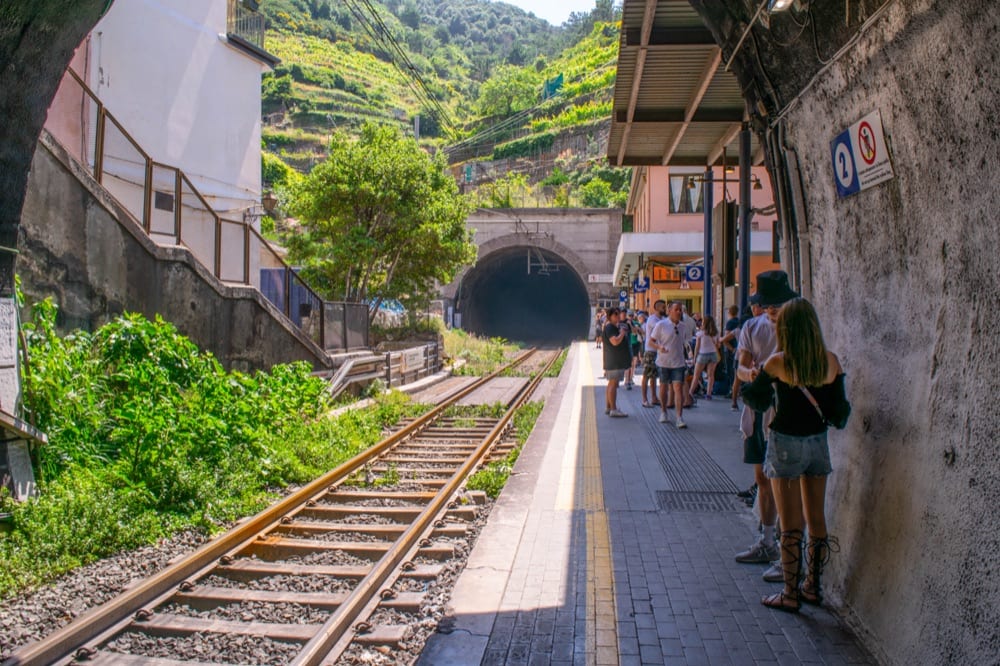
If you have an opportunity to take an overnight train, do!
Not only is it a great way to save on the cost of a hotel for the night , but spending the night in a sleeper car can be quite a travel adventure!
(Though in the interest of full disclosure, I have never once gotten what I would call a good night’s sleep on a train. No regrets, though, and we’ll do it again!).
Toilets are plentiful, but their quality is questionable.
In other words, bring some toilet paper (I usually keep a small packet of tissues handy for that purpose) and hand sanitizer.
Also, wet floors aren’t exactly unheard of, so you might want to stick with close-toed shoes.
Most high-speed trains in Europe have a toilet available in every train car, so you typically won’t need to go far to find one.
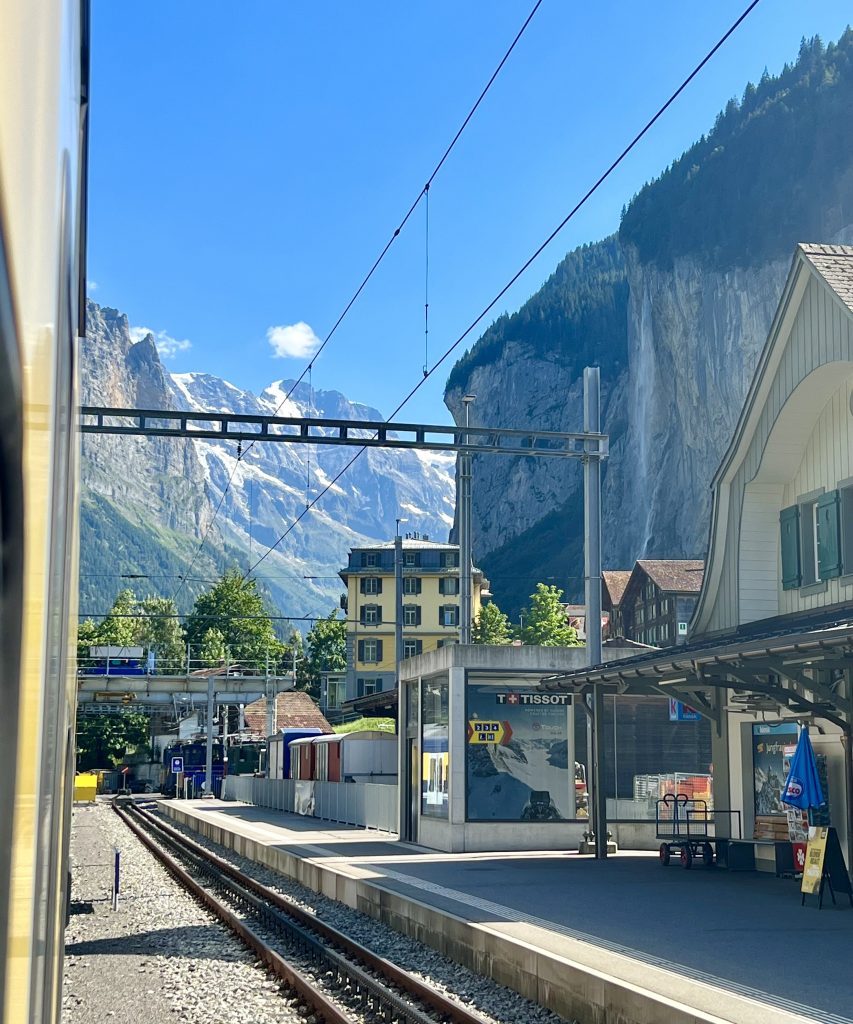
If you’re a student and/or under 26, you might qualify for discounts.
Keep that in mind when booking your train tickets for Europe, and if you do book a discounted fare, be sure to keep your ID handy (it’ll likely come in handy in many other places during your trip, too).
Keep in mind that some under-26 discounts are only available to EU residents, so be sure to verify that before counting on them if you aren’t European.
You can generally bring dogs (and cats) with you on trains in Europe!
This is a bit beyond the scope of this blog post, but given that we have several photos of Ranger in here, I’m sure at least a few readers are curious!
The vast majority of trains in Europe allow well-behaved companion animals on board, with varying requirements and costs (generally either free or the price of a child) based on the animal’s size, whether it’s confined in a carrier, etc.
It’s best to check the expectations for each route in advance, but with a little planning and flexibility, your furry friends are generally welcome.
Ranger is quite the traveler and has visited 8 countries and counting with us, many of them by train!
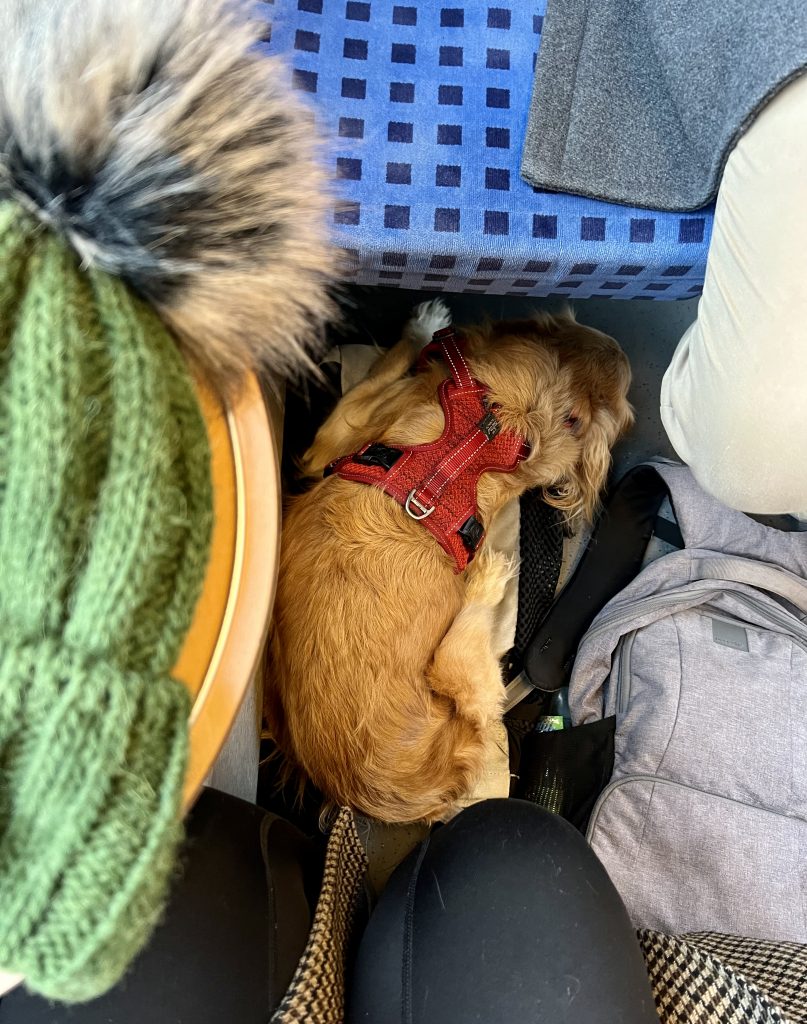
Keep an eye on social norms.
Cultural expectations around eating, talking loudly, and storing your luggage can and will vary depending on where your train travel in Europe takes you.
B e sure to keep an eye on what everyone else is doing to ensure you’re not inadvertently committing a faux pas !
For example, if you take a train, say, in Italy and then later in Austria as you travel Europe by train, you’ll likely notice a huge difference in the noise level on the train!
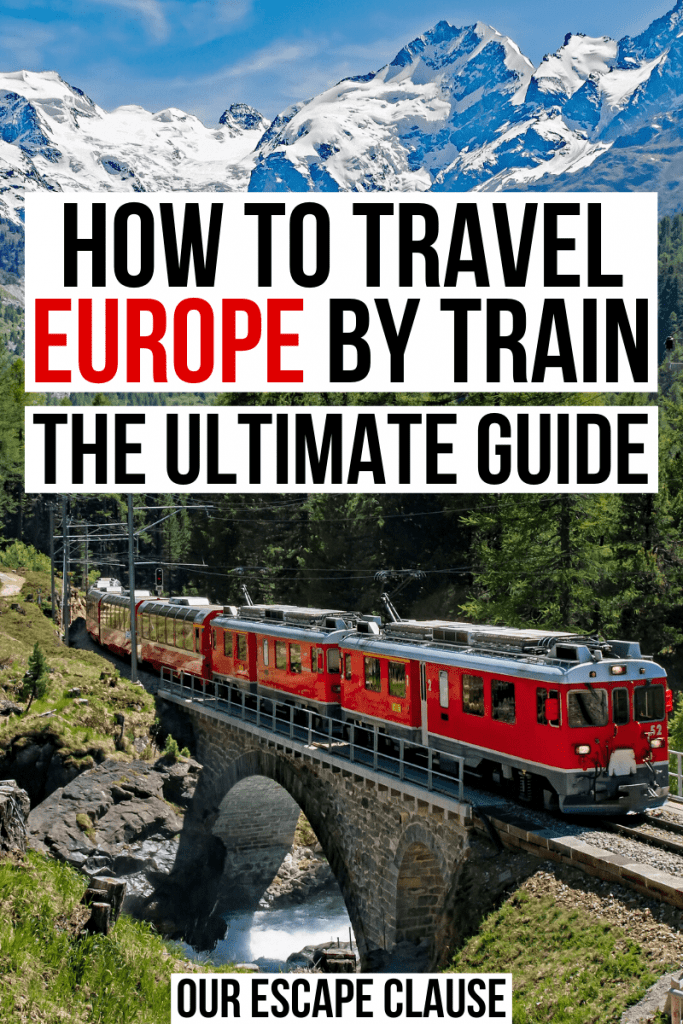
About Kate Storm

In May 2016, I left my suburban life in the USA and became a full-time traveler. Since then, I have visited 50+ countries on 5 continents and lived in Portugal, developing a special love of traveling in Europe (especially Italy) along the way. Today, along with my husband Jeremy and dog Ranger, I’m working toward my eventual goal of splitting my life between Europe and the USA.
64 thoughts on “How to Travel Europe By Train: The Ultimate Guide (+ Tips!)”
We are senior citizens planning a trip to Italy and surrounding areas in September 2022. Looking at some train travel, multiple cities for sight seeing. We like the smaller, picturesque, historical cities. What advice can you offer?
I definitely recommend searching “Italy” on our search bar (top right of the site on desktop, part of the menu on mobile). Italy is one of our favorites and we have (literally) about 100 posts about it!
For small, picturesque, historic cities, Siena, Venice (it is pretty small!), and Verona come to mind. Florence, too–surprisingly small in some ways!
For even smaller hilltop villages like Montepulciano, etc, in Tuscany, be aware that many of the train stations aren’t in the town center, so you’ll likely want to catch a taxi in many of them to avoid hauling luggage up a hill.
Two years ago we had a small villa in a very small town in Italy. We trained to a new place everyday. It was funned and easy. We took the local bus into the next target town, bought our tickets at the station and took off for the day. We went to Florence, Pizza, and several smaller towns. We are mature seniors and had no trouble getting around. Only a couple of people spoke english in a small town, but, we managed easily.
Your comments encourage me to locate a home base in Italy and take a train or bus to the surrounding suburbs etc. I’m no spring chicken nor my husband but we get around easily. Thank you
Thanks for the helpful information. Appreciate it!
My boyfriend and I just booked our first train tickets in Europe thanks to you!!! I’m so happy we found your blog. We’re going to France and Spain this summer!
Ahhh that is wonderful to hear! Have a fantastic time!
My wife and I, both 70 are taking a cruise from Budapest to Passau and plan on taking trains to Birmingham England from Passau. I’ m planning about 5 stops. First Venice then Tirano, St. Moritz, Sion, Strasbourg and finally Birmingham. I plan on a Eurrail pass. do you have any advice, help or suggestion. Thanks
Hi Wayne! If you’re planning on an Eurail pass, my best advice is to research your routes, dates, and times in advance–many popular routes will still require advance reservations even with a pass.
Kate, my wife and I are planning our first cruise in Europe, and are thinking about taking the train from Barcelona to Rome (cruise departure). Your blog was a great overview. My question has to do with ability to get off and on a subsequent train, for day visits on the way. Is switching covered or individually arranged ahead of time, and is it a good or bad idea for novice mostly monolingual travelers to Europe? Advice? Thanks,(Chuck)
If you book a ticket from Barcelona to Rome, your ticket will be good for that specific train/departure only, so you can’t get off and back on at various stops. If you want to stop places along the way, you’ll need to book individual tickets between each destination you plan to visit.
If you have your heart set on that, look into an Eurail pass–it does what you describe, however, it can get confusing (some routes still require advance reservations) and will usually be more expensive than booking tickets individually.
Traveling by train is absolutely doable as a novice traveler, but be sure to be careful when you’re booking your tickets (to ensure they’re the right dates/times/train stations you expect), and pay close attention to the stops to ensure you don’t miss yours.
Another option, if you’re traveling during the summer and want to get from Barcelona to Rome quickly without flying, would be to take a ferry to Rome and then train to a few places around Italy from there.
Hope you guys have a great trip!
My family is looking to travel from Lille to Amsterdam. My question is: when we depart out train that originated in Lille and transfer to a new train in Brussels, will we need to go through some form of customs before we board the train for Amsterdam? I just want to get an idea of how much time to leave for connecting trains.
Hi Matt! No customs required–all of those countries are part of the EU Schengen Zone, so moving between them via train is generally as seamless as road-tripping between US states.
And, is 33 minutes to connect from one train to another a lot of time? We have never done this type of thing before so I’m not sure if that is cutting it too close
33 minutes should be okay! Definitely move with purpose to find your next platform once you arrive, but you shouldn’t be in a huge hurry as long as everything is on time.
Kate- I am considering coming to Europe early for my Christmas river cruise heading out of Brussels. I was thinking of taking the train from the Brussels airport to Koln to see their markets and explore, and then doing a day train up to Dusseldorf to see their Christmas markets. It looks like about a 2 hour train ride on Thalys to Koln and then only about 30 minutes from Koln on to Dusseldorf. I will then take the train back to Brussels for my riverboat cruise. Does this sound feasible?
As long as the timetables work in your favor, I don’t see why not! Germany and Belgium are both great countries for exploring by train.
Hello Kate, We are looking to visit Italy for the first time in December/2022, I was looking in the train tours, visiting 4 cities (Rome, Florence,Venice & Naples). Your thoughts on train tours? Thank
Hi Sharon! I’m not sure what you mean by tour–if you mean a guided trip, they can of course be very fun with the right group, but I wouldn’t say you need one for this route.
All of those cities are very simple to visit independently by train, and we have taken trains to and from all of them many times (I’m actually typing this on a train to Venice).
Hi Kate, my husband and I are planning to fly in to Italy and travel by train to the following places: 1) Milan 2) Switzerland 3) Vienna 4) Prague 5) Paris
May I know if these places can be connected by train. If yes which train will you recommend, please. We are actually thinking about 15-20 days to cover these areas. As it’s our first Europe trip, do you think it’s sufficient and is there any place along the way that you would encourage to go. Thank you.
Yes, those are all excellent destinations to visit by train, so you’re good to go there. As far as specific trains, you’ll need to pull up the individual routes to check (we recommend Omio for this, especially with cross-border trains).
That’s definitely too many places for 15 days, though, and still pushing it at 20. I’d recommend trimming the itinerary a bit if you can (or adding on extra days, of course!).
Hi there This was so helpful. My husband and I are going to Amsterdamin September and then 3 nights in Bruges. All us booked but I’m overwhelmed but the trains websites. Omio is the easiest but I’m still leary. Is it legit and a decent safe way to book trains? We are only going to Belgium. Then two days to the countryside in The Netherlands which we will just grab a regional train. Everyone is telling us to book the train to Bruges. Any helpful advice would be great. We would go to Antwerp and take an IC train to Bruges an hour later,as my husband does have hip and knee problems. Thanks in advance.
I understand, it’s a lot to take on the first few times!
We use Omio regularly, as do many people we know, it’s perfectly legitimate.
The Antwerp train station will be a beautiful place to rest for an hour. It’s absolutely stunning, especially the front foyer, and often pops up on lists of the best things to see in the city!
Hi Kate, My husband and I will be traveling from Prague to cities in Austria and Germany by train next month. We have used trains a few times in Europe before, but it was pre Covid. It looks like most Covid restrictions have been dropped, but I wondered if you have to show Covid vaccination cards on the trains?
Thank You, Jaymie
I’m always hesitant to answer questions like this because I feel like I’ll be summoning disaster with how quickly things can change, LOL.
But at the moment, no, you won’t need your vaccination proof in either place as far as I know.
Life is pretty 2019 these days when it comes to the logistics of traveling around Europe as a visitor, though a handful of places still require masks on public transport (I think Vienna is one of them, but again–things change!).
This is so helpful, but I’m striking out with trains from Naples to Rome? It says that there aren’t any? Why would they list it as an option if they don’t travel to there? Also, is there a way to preview how long the train rides are to decide if we want to travel to certain cities? Cannot find any train tables. I find the Omio and Eurail sites to be difficult to navigate and I can’t get enough information to plan! :( Does it make sense to buy a eurail pass first and then research times and etas? Any help is appreciated!
Trains from Naples to Rome definitely exist! It’s possible you’re looking too far in advance to book the tickets–on Omio right now, it looks like I can purchase Naples to Rome tickets up to about 6 months out.
When you search for a specific route on Omio, Trenitalia, etc, it’ll show you how long the train is and how many changes there are, if any, much like searching for a flight.
We don’t recommend using the Google tool for this, as it tends to default to how to get somewhere if you leave at that second, which can be confusing and normally involves a more complicated route than you need.
Personally, we don’t generally find Eurail passes to be worth it in terms of cost-savings for most travelers, but in terms of research, you’ll be working with the same information either way. :-)
Hope that helps! It can be a bit confusing at first, but if you try practicing by looking at dates sooner than when you actually plan to travel, I think you’ll find the information you’re looking for.
Thank you for taking the time to write all that useful information. It is so much appreciated by many of us! :)
Like many of your readers, we are (two young adults) planning to visit Europe for the first time this upcoming May. We are currently looking at: Landing in the morning in Prague, spend 1 or 2 nights, then Vienna, one night, leave following morning for Bratislava (this one is a maybe, it’s so close!) OR Vienna to Venice. Spend 1-2 nights, then Zurich, and finally Munich, before we make it back to Prague to catch our returning flight. We are looking at 9 days from the morning we land. 🥴 We figured it would be more efficient to travel in a circle, as some destinations -like Paris- will be out this time around. :(
Thoughts on that? I will look into Omni regarding trains, but our plan is to travel only by train, if possible.
I know that’s a lot of questions, but THANK YOU so much for your help! 😊
Thanks so much, Al! So glad to be helpful. :-)
You definitely have the right idea with traveling in a circle, though I definitely recommend trimming some destinations!
With 9 days, I’d suggest no more than 3 base cities (and that’s pushing it), and you can add a day trip or two from there if you like.
I know it’s SO tempting to add more places (I have this problem constantly myself lol) but you’ll have much more fun with a bit of time to explore each place!
I’m not sure what your priorities are or what your budget is, but based on the cities you listed, I’d cut Zurich (Switzerland is amazing, but you don’t have time) and Bratislava. Ideally, I’d suggest cutting one more city as well.
If it were my trip, personally, I’d do a Prague – Venice – Munich triangle, and potentially day trip to Neuschwanstein Castle or somewhere else in the Bavarian Alps with one of the days in Munich. That’s just personal preference, though!
You can definitely do all the destinations you listed by train, no issue there at all. :-)
That recommendation sounds amazing. The two big ones are Prague (#1!) and Venice, but really hoping to do Munich as well.
I will look into the Bavarian Alps, as I am not familiar with them :)
Thanks again. Really enjoy reading through your content! 😊
If you love mountains and/or castles, you’ll definitely love them!
Enjoy some Czech beer for us :-)
Hi, we are doing Europe by train in June. Is there a way to determine: a. which direction the train(s) are going, so we can face forward? b. Which side is considered the right side (vs left side) for best views when recommended? Thanks for your perspective.
Unfortunately, there’s no clear-cut way to determine which way trains are facing, especially because they often turn around during the route, depending on how they pull into/out of various stations. On long journeys, it’s not uncommon to find yourself facing forward part of the time and backward part of the time.
If you’re starting from the beginning of the line, you can sometimes tell which way you’ll be facing at the beginning based on the route, but not always.
The same goes for the views–for very specific routes, you can sometimes get personalized recommendations from others who have traveled the route (especially for particularly scenic ones), but there’s no simple solution to figuring it out beyond just recommendations.
It’d certainly be easier if that were the case!
Hi Kate, Really enjoying your posts, photos, and appreciate the helpful advice. I am planning a trip in Sept/Oct to visit Scotland for a week before traveling in southern Germany and Austria. What would you recommend about getting from Scotland/London to Koln, Munich or Frankfurt? Is there a good train route to take? Or is this a case where flights make more (economic or time) sense? Thanks for any pointers!
That’s definitely a route that is better served by flight, both from an economic and time perspective! :-)
Is there something I am missing about Omio, the booking site that you recommend?
My wife and I are moving to Lyon in April and plan to go to Amsterdam in May. I went on the Omio site just to get a sense of what was available from Lyon (Gare Part Dieu) to Amsterdam (Centraal) on a random date (I picked May 9) and the site told me it could not find any trains between these places. But on the Rail Europe site, it showed a slew of trains available throughout the day.
I am confused.
I am too, I’m not sure why it’s not coming up! I just did the search myself and played around with dates, destinations, etc. Paris – Amsterdam, for example, seems to be pulling up just fine.
Could be as simple as a bug, but I just shot Omio an email asking for clarification.
Hi Kate I am Josh from KL Malaysia looking forward for europe trip in september 2023. I would like to start trip from berlin to budapest for 15 to 17 days.how to go about it by using eurorail?
Eurail has a website with a planning tool that can help you sketch out your journey.
Generally, you’ll buy either a set number of travel days within a given time period (like 7 days to be used in a month) or an unlimited pass.
Many routes do still require advance reservations (with additional fees), so be sure to check each route individually so you don’t miss anything!
Hi! I would love to travel as comfortably with my dog as you have, seeing from the pictures. I have a couple of questions: 1) what’s the name brand of that pet carrier. Looks perfect for mine. 2) Could you post tips on hoe to travel with your pet successfully.
Thank you for your content!
Yes, absolutely–with a catch (if you’re in the US). We bought the bag on Amazon Spain when living in Portugal and don’t know of an equivalent here. But this is the link: https://www.amazon.es/-/pt/gp/product/B00XR2D94W/ref=ppx_yo_dt_b_asin_title_o07_s00?ie=UTF8&fbclid=IwAR3p0Ihrxf6e1yL4nJv5pJBK0GXmOIVIqXL97ov77VRuxSIvm61M2-NbfQE&th=1
Here’s Ranger’s backpack that he gets carried in as well (size large): https://www.amazon.com/gp/product/B07C9XLXVH?ie=UTF8&th=1&linkCode=ll1&tag=ourescapeclau-20&linkId=813c9a64c05de1faef0162cbed102f22&language=en_US&ref_=as_li_ss_tl
He absolutely loves both–gets so excited when we get his bags out, and climbs right in when we get onboard!
Traveling by train in Europe with a dog is usually pretty simple, but you’ll always want to look up requirements for the specific country/train company (some require dogs not in a carrier to pay a half-fare or child’s ticket, etc).
If your dog is very small (like a yorkie or similar) they’re usually free, though again, be sure to check in advance.
I have it on my list to write a whole blog post on this topic eventually, but I hope that helps get you started! :-)
Just wanted to say thank for you for such amazing content. We are starting to plan a 5 week trip to Europe for Summer 2024 with our 4 kids and your site and recommendations are beyond helpful.
Thank you so much, Megan! That’s wonderful to hear. :-) Hope you guys have an incredible trip!
Hi, planning a trip to Europe with the family. Have been to Italy, Spain, Portugal, France and UK so we are looking for something different. Like Berlin, Prague and Vienna or Amsterdam, Berlin and Brussels. Love to get your thoughts on these routes and would you recommend taking the train between these cities? Or any other 3 cities you recommend we do over 10 days.
Sounds like a very fun trip! All of the cities you mentioned are definitely doable by train, but Berlin-Prague-Vienna is more cohesive than Amsterdam-Berlin-Brussels (I also personally would put a couple of dozen other cities in the region ahead of Brussels, though it definitely has things to offer!).
Since it seems like Berlin is a priority for you, I’d recommend using that as your anchor and spanning out from there.
A few other places that could make sense, if you want to add more options to your list, could be Krakow, Budapest, or Bratislava.
If you want to start in Berlin and include Amsterdam, you might look into Hamburg, Cologne, or Bruges.
You could also head south from Berlin, and do a Berlin-Munich-Switzerland (Zurich or Lucerne if you’re looking for cities) route.
Really, the possibilities are endless, so it just comes down to the cities that call to you the most!
We are seniors, experienced travellers but novice on trains. We have 3 weeks to visit Paris, Prague, Vienna, Bern, Marseilles, Barcelona, and Lisbon. What suggestions can you offer us Thanks
My first recommendation would be to trim a city or two–3 days per city is a very fast pace to keep up for 3 weeks!
Lisbon and Barcelona are of course the biggest geographic outliers. Lisbon is a non-starter as far as train travel to the rest of these cities is concerned–realistically, it’ll make more sense to fly to and from there.
Barcelona is a bit tricky, since Spanish and Portuguese trains are on a different rail gauge than the rest of the countries on your list. You can take a high-speed train from Barcelona to Paris, but getting from Barcelona to Marseilles via train is much more challenging than you’d think it would be based on a map.
The rest of the cities you mentioned are very well-connected by train, so you shouldn’t have any issues there. :-)
Really informative site you have here!
I’m from Asia and planning to visit Europe for the first time in Oct 2023. I’ll likely start the tour from London and have about 10 days, then will fly home from Heathrow Airport London. I’m really into trains and would love your advice on what some destinations would be possible. I’ve never been to Europe so anything is fine with me. :) Thank you
Honestly, the number of options is so overwhelming that you’re going to want to narrow it down–a lot!
Assuming you plan to hop over to mainland Europe (as opposed to heading north to Scotland, for example), Paris and Amsterdam are both great jumping-off points connected to London by train.
From either city, you can then reach dozens of cities within several countries in a day’s worth of train travel (or less).
Consider taking a look at places that interest you in France, Germany, Italy, Switzerland, The Netherlands, and Belgium–just to name a few!
If you want to peruse some sample itineraries, we have several in this post: https://www.ourescapeclause.com/2-week-europe-itinerary-trip/
Hope you have a fantastic trip!
Thanks for all the info contained within this blog. We are planning for summer 2024,a 2-week tour of Europe starting and finishing in the UK. How many stops would you recommend? Where would you suggest?, need to combine, beach, sightseeing and something in the Alpes? Ive got in mind Uk – South of France – Italy- Budapest-Krakow – Germany(or similar)-UK Now for the tricky bit, we are planning to do this with around 20 Explorer scouts! Any tips for travelling in groups? Can you also recommend a great website for hostels Thanks in advance
Sounds like quite the trip! 20 scouts–you guys have your work cut out for you, but I’m sure they’ll love it. :-) Can’t offer much personal insight in that direction myself, but I commend you guys for taking it on.
With only 2 weeks, I’d recommend 3 stops, with an additional day trip or two to add on more destinations. Sticking with the UK – South of France – Italy might work best in your case. Germany and Switzerland would also work as potential substitutes as they’re geographically close (depending on where you go).
We go into a lot more detail on putting together a 2-week itinerary in this guide: https://www.ourescapeclause.com/2-week-europe-itinerary-trip/
As far as booking lodging goes, we tend to book all of ours through Booking dot com these days. For hostels in particular, Hostelworld is also popular, though we have rarely used it ourselves. Depending on how old your scouts are you might want to double-check any age requirements for dorm stays.
We are a couple in our 60’s who have travelled by train in Italy and Japan .We are travelling to Greece for 2 weeks then flying to Hamburg.From here we are going to travel straight to Berlin(3 nights),Amsterdam(3 nights),Paris (5 nights),Interlarken,Switzerland (3 nights) then to Munich(4 nights). I have just started researching the best way to purchase rail tickets either a Eurail pass or point to point on Omio.Considering our itinerary what do you recommend?I have read that a Eurail pass is easier than point to point bookings but may be more costly.
Thanks for your blog,very informative.
Hi Francine,
In our experience, Eurail passes tend to be a bit more expensive for most travelers. Part of the reason for this is that many popular routes still require advance reservations that require you to commit to a date and often pay an additional reservation fee.
We have used an Eurail pass in the past, but these days, we always choose to book point-to-point journeys.
However, the only way to know for sure about your route in particular is to plan your trip out via Eurail (be sure to double-check what routes require reservations) and as a point-to-point trip and compare prices. Every trip is different, and since the prices for high-speed trains change depending on when you book them, there’s no way to know for certain.
If you’ve been comfortable traveling by train in other countries in the past, I wouldn’t say the ease of using an Eurail pass is worth the probable extra cost, especially with how simple it is to book train tickets online these days. It does depend on the traveler, though!
Thanks for the information Travelling to krakow then Prague Budapest and Croatia. Have 2 month. Would like to travel by train How far in advance do you need to book train tickets as I want to do it leisurely and not book to far in advance. Also what other country’s/cities do you recommend Thank you so much Betty
For most routes in that area, booking as you go (a few days to a week or so in advance) is just fine, as long as you’re a bit flexible. Exceptions can include night trains and traveling over holidays, so keep that in mind!
Keep in mind that train travel in Croatia is much less expansive than you might think–Dubrovnik doesn’t even have a train station! You can use some train routes, like Zagreb to Split, but plan on adding in buses and/or rental cars (plus ferries, of course) depending on where you want to go in Croatia.
With 2 months to travel from Krakow to Croatia, you might also consider stops in Austria (Vienna is right along your route), Slovakia (Bratislava is very easy to reach) and Slovenia. Depending on how direct you want to travel, Bosnia and Herzegovina could fit in as well.
That barely scratches the surface of the possibilities, but hopefully it gives you some ideas!
Hi! My wife and I love to travel (Between the two of us we have done Italy, Fiji, Australia and many others). We are planning on the F1 races in Spielberg, Austria next June. Thinking about the train from Vienna to Barcelona after and wondering if the ride (about a day) is worth the time? The flight is about 5 hours. We had fun on the train in Italy (Rome to Venice) We will likely leave Vienna the Mon or Tues after and have another 10 days. What do you think about Barcelona and Madrid? Do both? Or one over the other? Thanks in advance!
The distance between Vienna and Barcelona is far enough that unless the idea of a night train and a few train changes sounds like a fun adventure, I’d recommend flying! Basically as a travel experience it can work, but as a basic form of transportation, they’re a bit too far apart for the logistics to make sense.
As far as Barcelona and Madrid, both are wonderful, but they’re very different. Barcelona wins on whimsical architecture and access to the sea. Madrid wins on stately art museums and for having a more laid-back vibe. We enjoy both cities, but Madrid is our personal favorite of the two (though we are in the minority with that opinion!).
If you have time to spend a few days in each, they’re definitely both worth experiencing.
Hi! Thanks for the reply….sounds like flying is the way to go….we will have 4 days each in Madrid/Barcelona so should be able to get the flavors of both. Love your blog!
Thanks, Greg! Enjoy Austria and Spain! :-)
Hi Kate! I just found your blog while planning my first Europe trip… I’m so excited I have actual tears! I promised myself traveling around/to Europe would be something I accomplish by the time I turn 25. This train travel blog has given me so much needed information as when I originally started planning this trip a few years ago my original plan was by train. I will be combing through your blog site to read as much as I can and support you how I can.
My plan is to start in southern Portugal, through southern Spain, southern France, into Italy. I need to do more research to see if this much in a 2 week time span is even feasible. And, it looks like I may be better off taking a bus in Western Europe. This has been my one hurdle in actually going. If I’m going to go, I’m going to visit multiple countries… but the navigation between countries is the most fearful part for me. I will be using your blog to help me plan and prepare.
All this to say… I’m so glad I found your blog!! Thank you for all of your wonderful information.
Your comment brings a huge smile to my face! I remember planning our first trip so clearly at about the same age (I was 23 on our first-ever trip to Europe and 24 on our first multi-country European backpacking trip) and I can definitely say it was nothing short of life changing. :-)
All of the places you mentioned are among our favorites in the world! And reading between the lines, it sounds like you may have a preference for coastal areas, which all of those areas have in spades.
One small snag is that you have chosen some of the hardest places to travel between countries by train in western Europe, namely Portugal and Spain. Getting between major cities by train is no issue within each country, but the two aren’t very well-connected by train to each other, and the only train route to France from Spain leaves from Barcelona. There’s a long history as to why, but basically the train rail gauges in the Iberian peninsula are different than elsewhere.
However, don’t worry! There are plenty of solutions. :-) Buses are definitely a great option, especially for getting between places like the Algarve and Seville, etc. There are local buses, but also check out Flixbus, which is very popular with travelers and easy to use (we’ve used it many times ourselves). Also, flying is a surprisingly affordable option–Ryanair, Easyjet, etc. have tons of routes in these areas and are frequently way cheaper than traveling by train. Blablacar–basically Uber for traveling long distances–is also an option, though not one we have lots of personal experience with.
Finally, don’t forget about ferries! They can be surprisingly affordable, especially in Spain and southern Italy. We took a ferry from Barcelona to Rome and found it very memorable with amazing views: https://www.ourescapeclause.com/barcelona-to-rome-ferry/
As I always like to tell people, getting on that first plane and starting your trip is the hardest part. After that, everything falls into place. :-)
Hi Kate, Your blog has been super informative and helpful! We are planning a family trip to Europe this May with our 3 teenagers. Our goal is to do Rome (4 nights), Venice (2 nights), Salzburg (3 nights) and Munich (4-5 nights) in 15 days. Planning to fly into Rome and fly out of Munich or Frankfurt (Dallas is home), and travel by train from city to city. Are we taking on too much? Do you recommend using the fast train from Rome to Venice? Really want to take the train thru the Alps from Venice to Salzburg, but is it going to be much more expensive than flying? I’m assuming I need to book that leg of the train trip asap. Again, great job on the blog! It has made me very excited for our trip!
That’s great to hear, thank you!
That sounds like a good pace for a trip–if anything, 5 nights seems slightly long in Munich, though very doable with a day trip or two built in (and there are plenty of amazing ones in Bavaria!).
Taking the fast train from Rome to Venice would absolutely be our preference–it’s the fastest way to travel between the two cities by far.
Same for Venice to Salzburg (it’s a lovely train ride!). but yes, it can be more expensive than flying depending on when you book and how good of a flight deal you get. It’s much more comfortable regardless, though (not traveling to and from the airports is a big benefit in its own right). Depending on what train company you travel with, expect tickets to be available for purchase anywhere from 3-6 months in advance. I’d start watching earlier, though, just looking at more recent dates, to get a feel for what prices to expect.
Thank you for taking the time to put all of these great information together. Really appreciate it. So our plan for next year is as follow (12 days):
Spain: 1 day Madrid 1day Sevilla 1 day Barcelona
from Barcelona, take fast train to Italy 1 day Rome 1 day Naples 1 day Milan
from Milan take fast train to Switzerland:
What places (areas) would you recommend visiting in Switzerland? We would like countryside, small towns. I heard Switzerland is one of the most expensive countries to visit, so anything where we can enjoy nice scenery but not the most expensive areas. Also, is it feasible getting around in trains between these cities/countries? Thank you in advance!
Leave a Comment Cancel reply
Travel Europe on a Budget
The Savvy Backpacker
City Guides .\33 a132798-3f3b-4585-954d-7e70cf863447{fill:#231f20}
Complete guide to train travel in europe | how to travel europe by train.
Our step-by-step guide to traveling Europe by train.
Transportation
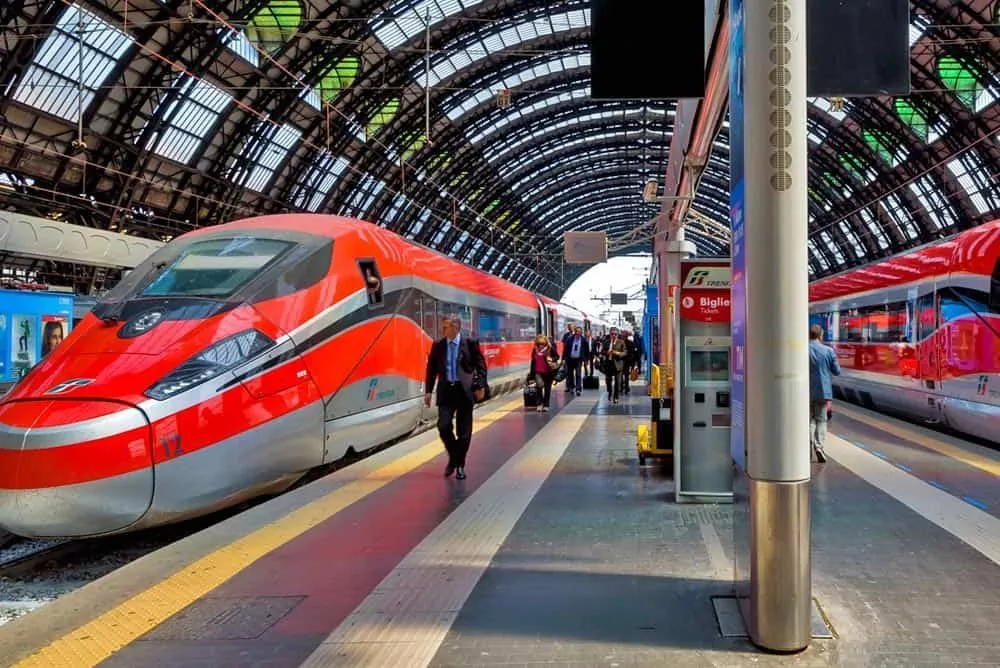
Traveling by train is the quintessential way to tour Europe. It’s romantic. It’s inspiring. It’s super-efficient. It’s comfortable. Some might say it’s almost magical. And to those who don’t live in a country where train travel is prominent, it’s a little mysterious.
In this Complete Guide To Train Travel In Europe, I’ll cover everything you need to know about traveling Europe by rail—including how to get the best price on train tickets, rail pass tips, understanding train schedules, tips for riding trains, how to navigate train stations, and advice for dealing with other issues you might encounter. By the end of this guide, you’re going to be a European train expert!
Quick Tip: Most train tickets are now electronic so you’ll want fast and reliable mobile data on your phone when traveling via train. Check out my guide on how to use your phone in Europe and our guide to the best SIM Cards and Data Plans for Europe .
The Pros and Cons of Europe Train Travel
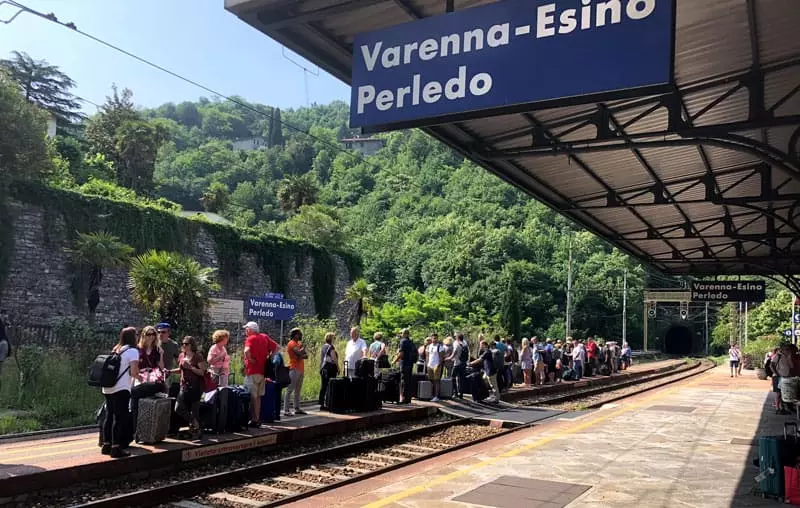
Let’s start with a quick overview of the positives and negatives of train travel in Europe.
Advantages Of Train Travel In Europe
Here are all the things I love about riding the train in Europe:
- In contrast, traveling from the airport to the city can take anywhere from 20-60 minutes and costs between $10-$80.
- There are no lengthy check-in procedures or security screening for most train travel. You simply show up a few minutes before the train leaves, buy a ticket if you don’t have one, and hop on the train.
- There are no luggage weight limits or extra fees for multiple pieces of luggage—just make sure that you’re able to lift your bag onto the train.
- Most European trains now accept electronic tickets—you simply show your ticket on your phone. That means no waiting in ticket lines and it makes planning your train travel even easier.
- You can pretty much bring whatever you want on a train—including alcohol. So stop by the local grocery store and pick up some cheap food for the journey.
- Europe’s rail network is extremely vast so it is possible to travel to even small towns by train. Most destinations offer multiple trains a day. The most popular routes usually have multiple trains an hour so getting to where you want to go is rarely difficult.
- If you’re traveling a long distance, consider taking an overnight train. These trains have special sleeper cars with bunks (usually six-bunk rooms or two-bunk rooms). A bunk in a sleeper car will cost about $45-$90 extra (about the same as a night in a hostel) but you won’t lose out on a whole day of travel. Overnight trains also have normal seats if you don’t want to fork over the extra cash for a bunk but it’s kind of uncomfortable.
- Train travel allows you to be spontaneous so you can show up at any train station, buy a ticket, and be on your way.
- Europe has a lot of beautiful countryside so traveling by train is a great way to see some fantastic views.
- Some trains also offer designated quiet cars if you truly want quiet.
- Train seats are larger and more comfortable than plane seats (especially when compared to many discount airlines). You’re also free to move about the train whenever you feel like it. Many trains also have seats that face each other and have a table between the seats—so it’s great for groups.
- European trains run on schedule well over 90% of the time but flights are only on schedule around 65%.
- Historically, train stations were the central hub for commerce and transportation so European cities showed off their status by building grandiose train stations. While it isn’t a huge deal, it is one of those nice little perks.
- Many countries offer sizable discounts for people under 26 years old so don’t forget to look into those discounts.
- The train is the most environmentally friendly form of travel. In fact, even France banned short-haul flights to encourage more train travel within France.
- We’ve always found riding the train to be fun. It’s oddly magical and relaxing.
Disadvantages of Train Travel in Europe
Train travel isn’t perfect so here are a few things to watch out for:
- That said, you can get some really good deals if you’re able to book high-speed trains in advance but you’ll pay a premium if you book last minute.
- There are often discounts for travelers under 26 years old.
- Note: Don’t forget to add in travel time to/from the airport and time to get checked in and through security—which will add around three hours to your journey.
- The train schedules can be a little confusing—especially for beginners. Luckily, there are plenty of apps that help make the process much easier but we still get tripped up every now and then.
- Many cities have more than one train station (Paris has six!). It’s not uncommon to arrive at one station and leave from another.
- It is also possible to change stations during a single journey. For example, when traveling from London to Lyon via the Eurostar, the Eurostar stops at the Paris North station, but then you have to travel to the Paris East station to catch the train from Paris to Lyon because there are no direct trains from London to Lyon. This transfer would require a cheap Métro (subway) ride.
- Striking is a national pastime in Europe. It happens a few times a year (or more if the people aren’t happy) but they announce the strikes well in advance so it shouldn’t be a surprise (just a hassle). You’ll just have to deal with them if they happen.
Pre-Trip Train Journey Planning
There are a number of great websites that will help you plan your train journey.
The first is Rome2Rio — simply plug in your destinations and it will give you all the train routes (as well as plane, bus, and car routes with cost estimates and travel times) for your journey. Rome2Rio is good for comparing different modes of transportation but I find better train ticket prices and more complete train listings on Omio and Trainline .
The German Railways Website ( Bahn.de ) shows the schedule of every train in Europe (yes, every train). We find that it’s helpful for piecing together complex train journeys. But it’s also good for seeing which trains require reservations and other important information. Unfortunately, you can only book German train tickets on the site so hop over to Omio and Trainline to book your tickets.
I’ve also written a few country-specific train guides to help you learn the quirks of each country’s rail network.
- Belgium Train Guide
- England Train Guide
- France Train Guide
- Germany Train Guide
- Italy Train Guide
- Netherlands Train Guide
- Portugal Train Guide
- Spain Train Guide
- Switzerland Train Guide
How to Buy European Train Tickets
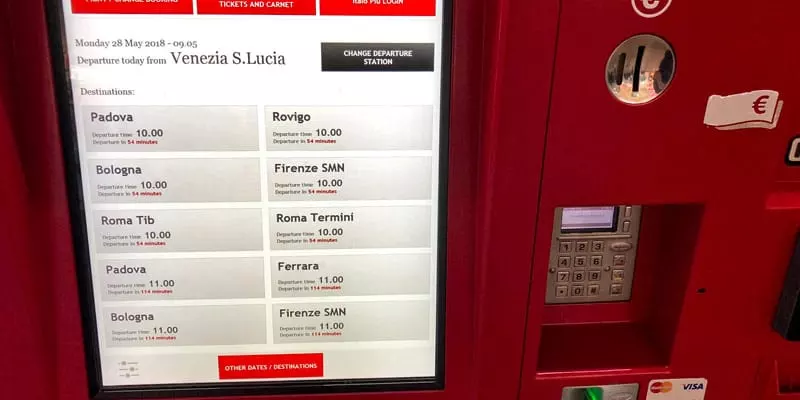
Buying European train tickets can be a little complicated—especially when you’re looking for the best deals.
That’s because each country runs its own National rail service (many countries also have separate private rail networks as well) and each does things slightly differently.
Luckily, there are plenty of online tools to make the whole process easier and we’ll walk you through the process.
NOTE: I’ve written an in-depth guide on how to buy train tickets in Europe if you want a more detailed look at finding the cheapest train fare.
How To Understand Train Ticket Pricing
Before we get started, I need to explain the two main ways train tickets are priced— fixed price and variable price .
Variable-Price Train Fares
Variable Train Fares are always changing based on demand, the day of the week, the time of year, and the distance to the departure date. Essentially all high-speed trains operate on this pricing model.
- In general, the prices will continue to creep up as the departure date approaches—you’ll pay a fortune if you buy last minute.
- Of course, you lose flexibility when buying tickets in advance because the cheapest tickets are normally non-refundable/unchangeable
Fixed-Price Train Fares
With Fixed Train Fares , the price is solely determined by the distance traveled. This is most common on regional and slower trains. With this type of ticket, it doesn’t matter when you buy tickets because the price never changes.
Where To Buy European Train Tickets
There are two main ways to buy European train tickets—directly from each country’s National Rail Service (via their website or at the train station) or through a third-party train booking search engine like Omio and Trainline —I find these booking services to be much more user-friendly.
Third-Party Train Ticket Booking Sites
There are quite a few advantages to buying your train tickets with third-party booking sites:
- The advantage of booking with a third-party booking site is that it lets you book more complex multi-country/international train routes. Many National Rail Services have trouble booking international routes (i.e. going from France to Italy)—so they can’t always find the best deals or show all available routes.
- Many of Europe’s National Rail websites still have issues processing foreign credit cards so it’s common for credit cards to be declined when booking. These third-party sites won’t have these issues.
- We’ve found that it’s common for Europe’s National Rail websites to be plagued with weird technical problems and overall poor user interfaces. Many times you’ll get kicked from the English version of the page to the local language in the middle of the booking process. These third-party booking websites take care of these issues.
- Third-party booking services have much better smartphone apps than the clunky national rail service apps.
Our Favorite Train Booking Websites
- Omio : Omio is a great train booking engine that lets you book tickets from just about every country’s rail service and they make the booking process very user-friendly.
- Trainline : Trainline is a new European train booking service (very similar to Omio ) that sells train tickets from Austrian, French, German, Spanish, Italian, and German Railways railways (and a few others).
National Booking Sites
Despite their technical issues, sometimes the cheapest tickets can only be found by booking directly with each country’s national rail service. This is because sometimes they offer limited-time deals that third-party booking sites don’t have access to. So it doesn’t hurt to at least take a look.
Links to Some National Railway Websites:
Austrian Railways ¹ – Belgian Railways ¹ – Danish Railways – Finnish Railways – French Railways – German Railways – Irish Railways – Italian Railways – Spanish Railways – Netherlands Railways ¹ – Norwegian Railways – Polish Railways – Swedish Railways – Swiss Railways ¹ – United Kingdom Railways
¹ Domestic tickets (i.e. trips that are wholly within the country) are always the same price — regardless of when they’re purchased and they never require a reservation. Therefore, it is easiest to buy tickets at the station. However, these countries often have a separate international high-speed train system (e.g., Belgium has slower regional trains and high-speed Thalys trains that link major Belgian cities to other international cities — these tickets should be purchased early for cheaper fares).
Quick Note About Eastern Europe Trains
Some Eastern European countries still don’t have online ticket booking so it’s only possible to purchase tickets at the station or through a local travel agent. Ask your hostel or hotel and they’ll tell you where to locate an agent.
Receiving Your Online Tickets
There are multiple ways to collect your tickets after you purchase them:
- Electronic Tickets: Many times you can have an electronic ticket sent to your phone (either via email or the booking app). Simply show the conductor on the train when he checks tickets and he’ll scan the QR code on the screen. This isn’t available in all countries but most countries have switched to eTickets.
- Print-At-Home Tickets: Anywhere that offers electronic tickets will usually let you print tickets at home. You can often simply save the PDF to your phone/tablet and the conductor can scan it from there.
- Note: You’re often required to use the SAME credit card use to purchase the tickets to collect the tickets at the station.
Buying Tickets At The Station
You can buy train tickets at any train station—either from the ticket window or from automated ticket machines. We recommend trying the automated ticket machines since the lines at the ticket window are long, slow, and understaffed.
When To Buy Train Tickets To Get The Best Price
Fares are fixed for most regional and local trains so there is no reason to buy them early.
For high-speed trains , it’s best to buy tickets early to get the cheapest tickets. In most cases, train tickets can be purchased 60-90 days before the departure date but buying a few weeks early is usually fine.
Train Ticket Price Examples (Comparing Last Minute vs Buying Early)
- Purchased Two Days Before Departure: €69.00
- Purchased Three Weeks Before Departure: €55
- Purchased Two Days Before Departure: €135
- Purchased Three Weeks Before Departure: €97
- Purchased Six Weeks Before Departure: €54
- Purchased Two Days Before Departure: €234
- Purchased Three Weeks Before Departure: 124
- Purchased Six Weeks Before Departure: €55
As you can see, booking just a few weeks early can save quite a bit of money.
Quick Point About Buying Train Tickets Early : As stated above, buying tickets in advance is the best way to save money but this also limits your ability to be flexible/spontaneous. This is especially true since many of the truly cheap train tickets are non-refundable. For optimum flexibility, it might be best to buy a rail pass. Here’s my Guide To Using Rail Passes in Europe and my Eurail Pass Review .
Other Train Ticket Discounts
Most rail services offer various discounts—some are based on rider age but other discounts are based on region, the day of the week, or other schemes.
- The most common discount is a youth discount — which is usually for people under 27 years old.
- Most countries offer a number of potential discounts. For example, Germany has a Schönes-Wochenende-Ticket (Happy Weekend Ticket) where groups of 2-5 people can ride as much as they want on regional trains from Saturday to Sunday for €44. Check each country’s rail service website to see if there are discounts available.
Eurail Passes
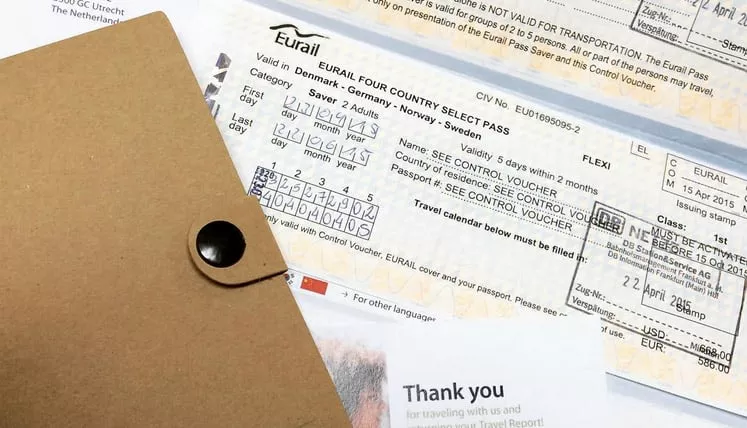
Many travelers choose to use rail passes instead of buying individual tickets. That’s because Eurail passes can save you a bit of money (depending on how you use them) but most importantly they give you excellent flexibility by allowing you to travel without needing to plan.
Note: We’ve written a lot about Eurail Passes. Check out our Guide To Using Rail Passes in Europe and our Eurail Pass Review for more in-depth information.
Quick Rundown On Rail Passes
A rail pass (aka Eurail Pass) is a single ticket/pass that allows you to ride any train in Europe—simply hop on, show the conductor your pass, and you’re good to go. Actually, it’s not quite that easy these days as there are a few stipulations, but the general idea is that you can ride any train without booking individual tickets.
Types Of Rail Passes
- Continuous: Unlimited travel to any Eurail participant country for between 15 days and 3 months.
- Flexi: 10 or 15 individual travel days (doesn’t have to be consecutive days) to any Eurail participant country within a two-month period.
- For example, one pass could be 10 days of train travel between France, Switzerland, and Italy. You have a two-month window to use of your 8 travel days. Each day you travel by train counts as one travel day but you can take unlimited train rides within each day.
- Eight travel days in a single country which must be used within a month.
Advantages of Rail Passes
- Flexibility: The number one benefit of rail passes is the flexibility they offer. You simply have to walk onto the train and go. That’s why this is a great option for people who don’t want to plan and who would rather wander across Europe.
- Long-Distance Trains: It’s also a good deal if you plan on taking a lot of long-distance trips because those tickets tend to be expensive so a rail pass is a good way to save some money. On the other hand, if you’re taking a bunch of short train rides then you’ll probably be better off buying single tickets.
- Low Stress: Piecing together a bunch of train journeys and then pre-purchasing individual tickets is stressful and takes a lot of time and planning. For a lot of people, paying a little extra for a rail pass is worth the hours saved having to preplan your entire trip.
Disadvantages of Rail Passes
- More Expensive: It’s usually cheaper if you purchase your train tickets online a few weeks in advance. That said, most of these cheap pre-purchased tickets are non-refundable so you’ll lose most of your flexibility. However, if you’re purchasing your train tickets a few days before departure then it’s much cheaper to use a rail pass.
- Reservations: A few countries require rail pass holders to pay extra for a seat reservation on high-speed trains. The fee can range from anywhere from €5-€35 and they have to be made in advance — they can sometimes be made online or directly at the train station. Here’s a detailed guide to rail pass reservation requirements from eurail.com. You can also enter your journey into Bahn.de and it will tell you if that specific journey requires a reservation.
Navigating The Train Station
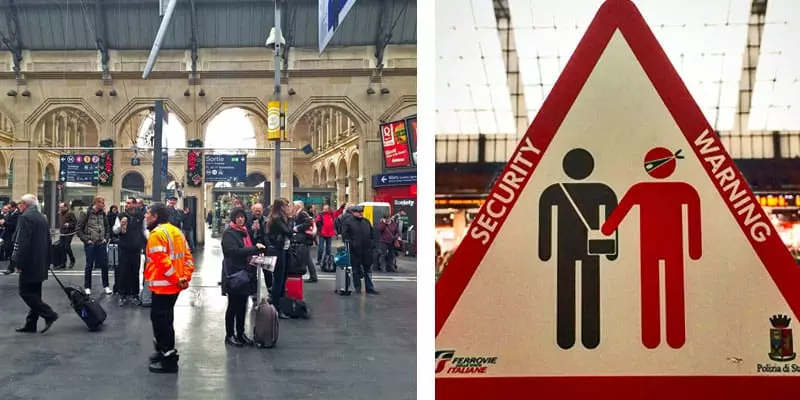
Ok, now we know how to buy train tickets and rail passes… so let’s learn about what to expect when you get to the train station.
The train station is the central transportation hub of most European cities so things can be a little chaotic and confusing—especially if you’re not used to traveling by train.
In this section, I’ll give you some tips to help you find your train.
First, make sure you have the correct train station because many cities have multiple stations. For example, Paris has six stations. Even some small towns have two different stations.
Once you arrive at the station, you’ll see signage in English so you shouldn’t have much trouble finding your way. Some stations are huge so you may have to walk quite a bit and navigate stairs and escalators.
Depending on the size of the station, you’ll also find fast food, cafes, shopping, lounges, and restrooms (although you sometimes have to pay to use them). Also, most train stations have luggage lockers that you can rent if you need them.
Pickpockets and Scams at the Train Stations
Train stations can get very busy, hectic, and full of confused tourists so they’re a common target for pickpockets and other scammers. Pay attention to your stuff and be wary of “helpful” strangers willing to help you with the ticket machines. Check out our Guide To Avoiding Pickpockets and Tourist Scams in Europe .
Train Ticket Machines

If you need to buy your train tickets or print your pre-purchased tickets you’ll want to first head to the automated ticket machines. Everything is in English and the machines are easy to use.
Alternatively, you can still go to the ticket window or customer service desk but the lines are usually long.
Reading The Train Station’s Departure Board
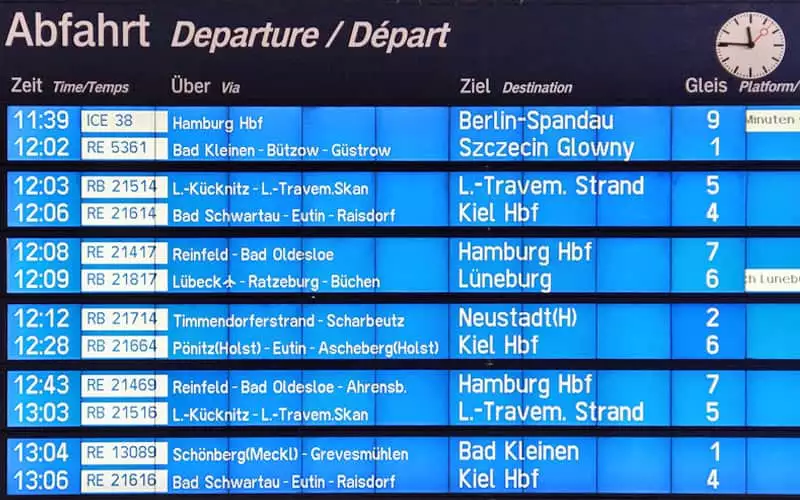
Once you arrive at the station you’ll want to look for the departure board. There are usually multiple boards throughout the station and one giant main board. This board tells you where to find your train, when it leaves, and where it’s going.
The three most important things to note are the train number , departure time , and the platform .
Your train ticket will show the scheduled departure time and the train number but it usually won’t show which platform the train leaves from.
So head to the departure board and find your train number to see at which platform your train is located. It’s very common for the departure board to not display the platform until 10-15 minutes before departure so pay attention to the board.
Find Your Train’s Platform
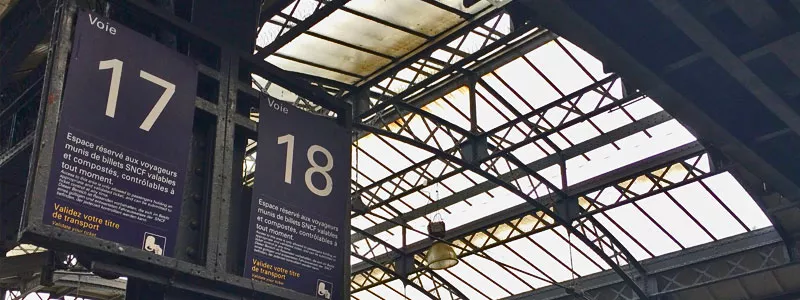
Once know what platform your train is departing from you’ll want to find that platform at the station. Sometimes the platforms are a bit hard to find so you might have to seek them out.
Don’t worry if there isn’t a train there at the moment because trains often pull in, load up, and leave.
There are usually a few staff members milling about on each platform so don’t be afraid to ask train station staff as most can speak English.
Validate Your Ticket
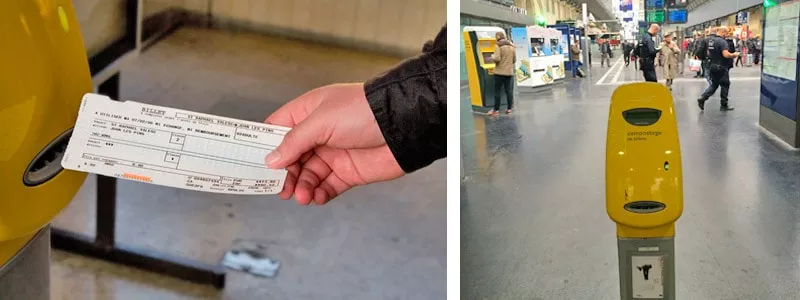
Many physical train tickets need to be validated (stamped with time/date) before entering the train so look for small validation boxes near the entrance of the platforms. Simply place your ticket inside the machine and it will stamp it.
You can receive a large fine if the ticket checker sees that your ticket isn’t validated (they’ll assume you were trying to ride for free). If you forgot, quickly seek out the conductor, explain that you forgot to validate and everything should be fine. Or you can just play the “I’m a dumb tourist and these scary trains confuse me” card and hope they let it slide.
Note: Electronic tickets don’t need to be validated because they’re usually only good for the specific time stated on your ticket. Some paper tickets also don’t need to be validated but we usually try doing it anyway to be safe.
Finding Your Train Car
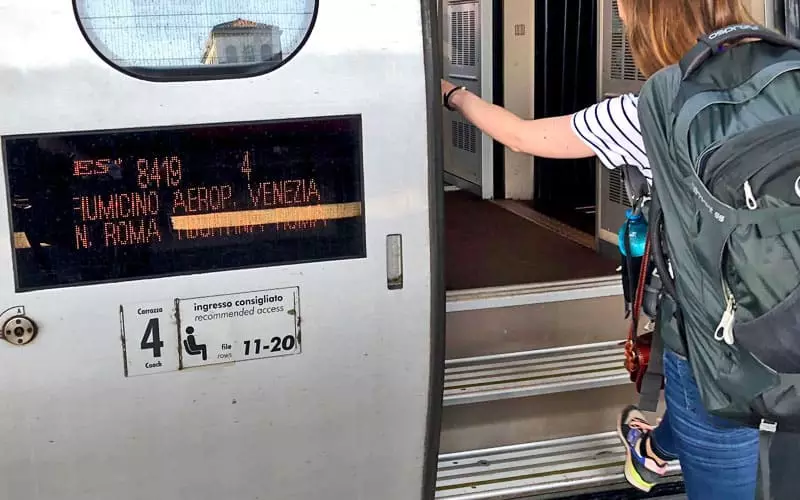
On some trains (usually high-speed trains) you have assigned seats so look at your ticket to see which train car your seat is in. The car number will be displayed on the side of each train car.
You can board the train in any car but it’s much easier if you enter your car (walking through multiple train cars is a pain).
Most regional and slower trains don’t have assigned seats so you can simply board anywhere you like.
That said, you’ll want to get on fairly quickly because trains are usually only at the station for a few minutes before they leave.
On The Train

You’ve made it on the train. Congratulations! In this section, we’ll talk about settling in and a few things you might experience on your ride.
Find Your Seat & Store Luggage
Find your assigned seat (if you have one) or take any free seat if it’s open seating. The seat numbers are displayed above the seats.
Take the opportunity to store your luggage. Smaller luggage like backpacks and some suitcases can be stored above your seat on luggage racks. There are usually larger spaces for bigger luggage at the end of each train car.
Wait For The Conductor To Check Your Tickets
A ticket checker will come by and check your ticket after the journey starts—typically within 10-20 minutes after departure.
While not extremely common in Western Europe, border patrol might board the train to check passports. They might ask you some questions but we usually only encountered this in Eastern Europe.
Enjoy The Ride
One of the great things about train travel is the comfort of the ride. Feel free to walk about, check out the bar car, enjoy a picnic (alcohol is allowed), or sleep. Some trains offer free wifi but we’ve never had much luck getting it to actually work.
Departing The Train
One of the most confusing parts of the ride is knowing exactly when to leave the train. That’s because train stations are sometimes named very similarly.
For example, many trains coming into Brussels first stop at the Brussels Nord station (which is located on the outskirts of town) before stopping at the main Brussels Centrale station (which is located in the center of town).
More Europe Travel Tips From The Savvy Backpacker

I have a lot more tips and tricks for traveling through Europe on a budget. Here are a few helpful articles I think you’ll enjoy.
- Get moving with our picks for the Best Travel Backpacks .
- Get packing with our Europe Packing List .
- Get traveling with our Europe City Travel Guides .
- Get planning with our step-by-step Guide To Traveling Europe On A Budget .
- Get a High-Speed eSIM Data Plan for Europe and learn more about how to use your phone in Europe .
- Recent Posts
- How To Buy Train Tickets in France | Guide To Buying French Train Tickets - July 26, 2024
- France Train Guide — How To Travel France By Train - July 25, 2024
- Best Prepaid USA eSIM Data Plans For Travelers | eSIM Buyer’s Guide - July 3, 2024

No Funny Business
The Savvy Backpacker is reader-supported. That means when you buy products/services through links on the site, I may earn an affiliate commission—it doesn’t cost you anything extra and it helps support the site.
Thanks For Reading! — James
Questions? Learn more about our Strict Advertising Policy and How To Support Us .
Related Reads
How to buy train tickets in france | guide to buying french train tickets.
What you need to know about booking train tickets in France and tips for getting the cheapest prices.
France Train Guide — How To Travel France By Train
How to travel France by train—tips for buying French train tickets and advice for navigating France by rail.
How To Purchase Train Tickets for Europe | Strategies For Buying European Train Tickets
Tips on the easiest and cheapest ways to buy train tickets in Europe.
Italy Train Guide — How To Travel Italy By Train
How to travel Italy by train — tips for buying Italian train tickets and advice for navigating Italy by rail.
City Guides
Choosing travel insurance, travel packing lists, budget travel newsletter.
The best budget travel tips sent straight to your inbox.
Join My Journey
Europe travel tips, advertising & privacy policies.
TheSavvyBackpacker.com is a participant in the Amazon Services LLC Associates Program, an affiliate advertising program designed to provide a means for sites to earn advertising fees by advertising and linking to amazon.com.
© 2010 - 2024 The Savvy Backpacker
Website Design by FHOKE
Wander-Lush
Europe by Train: 20 Itinerary Ideas for 10 Days of Travel
There’s no better way to slow travel through Europe than by train. Here are 20 itinerary ideas for 10 days in Europe by rail – with options for every travel style, budget and season.

Europe is experiencing something of a railway renaissance, with old tracks being revived and new rail routes opening up.
Whether you’re looking for a fast-paced, multi-country itinerary or you prefer to explore one country in depth, travelling by train is an easy and affordable way to get around.
Some of these train journeys are among the most beautiful on Earth; others are a convenient way to get from A to B. Whatever you’re looking for, here are 20 of the best Europe 10-day itinerary ideas to get on board with.
Please note: This post contains affiliate links, meaning I may earn a commission if you make a purchase by clicking a link (at no extra cost to you). Learn more.
10-day itineraries for travelling Europe by train
Each of these Europe train itineraries is perfectly suited to 10 days of travel but can easily be shortened or extended depending on how much time you have.
Depending on your travel plans and just how far you plan to ride the rails, it might be economical to pick up a Eurail Global Pass.
Similar to a Amtrak Rail Pass in the US or the JR Pass in Japan, it can be used for multiple trips across the continent (it covers 33 countries in total). There are no fixed dates, and you have complete flexibility to design your own route.
Learn more about the Eurail Pass and purchase your pass online here through the official website .
Central Europe by Train: Hungary to Slovenia
- Route: Budapest – Bratislava – Vienna – Ljubljana
- Editor’s pick

This route traverses four of Central Europe’s great capitals: Budapest, Bratislava, Vienna and Ljubljana.
Made for travellers who don’t mind moving at a fast pace and want to make the most of their 10 days in Europe, this itinerary hits all the urban highlights of Hungary , Slovakia, Austria and Slovenia with plenty of opportunities for day trips to castles, wineries and hiking areas in between.
Start in Hungary’s enthralling capital and spend a few days experiencing the best of Budapest . Don’t miss a morning wander around the covered market, a soak in the Gellert or Széchenyi Thermal Bath, and sunset at Fisherman’s Bastion.
After the impressive scale of Budapest, Slovakia’s capital (3.5 hours away by train) seems diminutive in comparison – but don’t be fooled, Bratislava has a lot to offer visitors. With one full day in the city you can catch all the highlights, starting with a morning walking tour of the historic Old Town core and culminating with a view from the castle grounds.
For something different, cross the famous UFO Bridge to wander around Petrzalka , a colourful neighbourhood on the opposite side of the river. Then indulge in a day trip on the Danube or through the countryside to visit Slovakia’s amazing castles, wineries and old towns .
Continue to Austria, following the mighty Danube river. For this leg you can choose between a morning train (1.5 hrs) or if the weather is good, the ferry (1.5 hours). Vienna needs no introduction – there are countless things to keep you occupied in this classic European capital for 2-3 days, ranging from historic cafes to museums and churches.
When you’ve had your fill, board the train for a final time for the scenic journey to Ljubljana. This train ride takes the better part of a full day and leads you through some of southern Austria’s and northern Slovenia’s most beautiful countryside. Stopovers in Graz or Maribor (Slovenia’s second-largest city) can easily be arranged if time permits.
Fall in love with petite and pretty Ljubljana by wandering the river’s edge through the Old Town, browsing the produce market and taking the funicular up to the castle. Bled is within easy reach (under 1.5 hours by train or bus) and you won’t regret adding on a half-day trip to visit the region’s most iconic lake .
Northern Italy: Milan to Trieste
- Route: Milan – Verona – Padua – Venice – Trieste
- Designed by: Sophie from Just Heading Out

Italy has more than enough on offer to fill 10 days of travel or more . This route takes you to some of the most popular cities in the north of Italy plus a few underrated places.
Start in Milan, the elegant fashion capital. Spend two nights here to eat, drink, shop and see the highlights: The Duomo, the Galleria Vittorio Emanuele II, and the Castello Sforzesco. The next day, take either the regional train (2 hrs) or the fast train (1.25 hrs) to Verona.
Verona’s biggest claim to fame is as the setting of Shakespeare’s Romeo and Juliet , so you must visit Juliet’s balcony and Romeo’s house. But there’s much more to Verona! Climb up to the Castel San Pedro for a great view of the city, visit Castelvecchio, and see an opera performance at the historic Arena.
After two nights in Verona, board an early train to Padua (1 hr). Padua is noticeably less touristy than Verona or Milan. As one of the oldest cities in Italy , it features a beautiful historic city centre. Visit the Cathedral, the Botanical Gardens, and the Prato della Valle.
After dinner, it is time to take a train to Venice (30 mins). When you arrive, check into your hotel and rest up for three days of sightseeing . Aside from the highlights – such as Ponte Rialto, Doge’s Palace and Piazza San Marco – be sure to leave some time to explore the streets and get lost down the alleyways. A day trip to Murano and Burano is certainly worth the effort.
From Venice, it is a 2-hour train ride to Trieste. This underrated city lies close to Italy’s borders with Austria and Slovenia, and both influences can be clearly felt in the food, culture and architecture.
Trieste is the perfect place to slow down and relax for a day at the beach. Finish your trip around Northern Italy by visiting the Castello di San Giusto and Miramare Castle.
Southern Spain’s Andalusia: Madrid to Granada
- Route: Madrid – Toledo – Cordoba – Seville – Granada

While a road trip in Spain might be the best way to explore the country from top to bottom, you can still see a lot when travelling on the country’s railway network. This itinerary focuses on the southern part of the country: the culturally distinct and utterly mesmerising Andalusia region.
Spain’s capital is a natural place to begin. If it’s your first visit, pause for a day or two to visit the most important landmarks in Madrid before boarding a train to Toledo. Half an hour later, you’ll find yourself walking the streets of one of Spain’s most magical and history steeped cities . For all the best things to do in the imperial city, see this guide to Toledo .
For the remainder of your Spain train itinerary, divide your time between Cordoba (4 hours from Toledo by train), Seville (40 minutes from Cordoba) and Granada (1.5 hours from Seville). Each of these three Andalusian cities has its particular charms and fair share of awe-inspiring landmarks, most notably the Mezquita in Cordoba, the Alcazar in Seville and the one and only Alhambra in Granada.
If you have more time, finish with a couple of days on the coast or head west to Lisbon to continue travelling around Portugal by train.
Poland & Germany: Krakow to Berlin
- Route: Krakow – Wroclaw – Dresden – Berlin
- Designed by: Kami from Kami and The Rest of The World

This train journey takes you through some of the most beautiful and interesting cities of Poland and Germany and allows you to see some lesser-known yet amazing corners of Central Europe.
Featuring historical sites, beautiful nature and hip spots, the itinerary is good for anyone who’s interested in culture and history but also wants to venture beyond the expected.
Start your journey in Krakow, the former capital of Poland and one of the most beautiful cities in Europe. You need at least two days to see all the main sights, starting with the Old Town and the Wawel Castle, the riverside and the Jewish quarter, Kazimierz. Krakow is a perfect base for side trips, the most popular being the UNESCO-listed salt mine in Wieliczka and Auschwitz-Birkenau concentration camp. Both are easily reached by train.
From Krakow, continue by direct train to Wroclaw (3 hrs), one of the main cultural capitals of Poland. Set aside a full day to see the city, taking your time to fall in love with the colourful Market Square and to find as many quirky dwarfs as possible. In the evening be sure to find the magical ‘neon yard’.
From Wroclaw, you can easily explore part of the Lower Silesia region – probably the most interesting part of Poland. Easy train trips include beautiful Swidnica , with its spectacular 17th-century Church of Peace (a UNESCO World Heritage Site), the stunning Ksiaz Castle (the third largest castle in Poland), numerous spa towns, and the Sudety mountains.
From Wroclaw, continue by train toward Dresden but stop on the way in Goerlitz, the city divided by the Polish-German border. It’s one of the prettiest and best-preserved German cities and you’ll surely recognise it from numerous movies, including The Grand Budapest Hotel and Inglourious Basterds . The train trip from Wroclaw to Dresden takes a little over 3 hours and Goerlitz is more or less halfway.
Even though the city was badly destroyed during WWII, Dresden has some of the most impressive Baroque architecture you can find in Europe. You need two days to see it properly, but the main highlights of the city are conveniently located in the centre.
Finish your trip in the cool and vibrant capital of Germany, Berlin (2 hrs by train from Dresden), where you can enjoy a variety of attractions – from historical monuments and mementos of 20th-century world events – and alternative sites such as Kreuzberg.
The Swiss Alps: Geneva to Tirano via the Glacier Express
- Route: Geneva – Bern – Interlaken – Zermatt – St Moritz – Tirano
- Designed by: Allan from It’s Sometimes Sunny in Bangor

This 10-day itinerary is breathtaking all year round – but at the same time it’s winter-inspired as it follows some of the highest peaks in Europe and takes you to some of the most popular destinations for winter sports in the Swiss Alps.
Many of the stops are hard to reach, so the most convenient start is Geneva near the France/Switzerland border.
A day or two is enough time to explore Geneva, the largest city in Switzerland, before forwarding to the charming administrative capital of Bern (2 hrs). You can cover the main attractions of this small but beautiful city in a day – the connecting bridges are a must see – before the next stretch to Interlaken (1 hr), a resort town known as the ‘adventure capital of Switzerland’.
Interlaken is an ideal base to explore the many surrounding mountain peaks including the famous Jungfrau. The 3-Day Jungfrau Travel Pass offers great value for money when exploring this area’s mountains by train and cable car.
This Swiss rail itinerary then takes you high into the alps to visit some of the most beautiful winter resort towns in the world. The first is Zermatt (2.5 hrs), set beneath the majestic Matterhorn (AKA the Toblerone mountain). Cable cars from Zermatt whisk you up towards the peak.
A day is long enough to explore the town before joining the Glacier Express , one of the most scenic train rides in the world. After 7 hours riding the rails through mountainous terrain you’ll finally reach St Moritz where you can connect to yet another breathtaking train, the Bernina Express, to cross into Italy. The trip ends at Tirano (4 hrs). Spend a day in this resort town before continuing on to Milan or Turin for onward travel.
The Balkans by Train: Zagreb to Bar
- Route: Zagreb – Belgrade – Bar

Bus is by far the preferred way to travel around the Balkans region – but there is one rail route that should be on every traveller’s radar. The train from Belgrade (Serbia) to Bar ( Montenegro ) is easily one of the most scenic and yet underrated in all of Europe.
With 10 days up your sleeve, you can tackle this full-day journey (the day train is highly recommended) plus add a few days in Croatia’s capital, Zagreb , at the beginning of your trip.
Zagreb is often overlooked in favour of Venetian cities along the Dalmatian Coast – yet Croatia’s capital is easily one of its most beautiful destinations , albeit in a slightly unconventional way. Zagreb is loaded with history, street art and beautiful churches, including the iconic St. Mark’s, with its colourful tiled roof.
After a day in Zagreb, board a train for Serbia’s capital, Belgrade (6 hrs). The former administrative centre of Yugoslavia is a must-visit for those interested in modern history and Brutalist architecture. Spend a morning at Avala Tower , climbing up to the viewing deck for a panorama, cycle around the concrete jungle that is New Belgrade, and wander the old neighbourhood of Zemun. House of Flowers, the final resting place of Josip Broz Tito, is a fascinating visit – but if you only have time for one museum in Belgrade, make it the Tesla Museum.
Completed in 1976 and officially opened by President Tito himself, the Belgrade to Bar train passes over no fewer than 435 bridges on its way to the Adriatic Coast. It’s all about the journey: The part of Montenegro the train traverses is absolutely stunning , especially when the train passes over marshy Lake Skadar.
When you arrive in Bar, make a detour to Stari Bar to explore the ruined old town and the aqueduct before finding a spot to relax on the beach. Pleasant swimming beaches can be found down the coast in Ulcinj – itself a good jumping off point for travelling into Kosovo or Albania .
The Netherlands’ Randstad: Rotterdam to Amsterdam
- Route: Rotterdam – Den Haag – Amsterdam
- Designed by: Erin from Pina Travels

This European train route brings you to three beautiful Dutch cities within a region of the Netherlands known as ‘The Randstad’, the most heavily populated and developed part of the country.
On this route, you’ll get to experience the best of Dutch culture , architecture, history and food. Travel times between cities are short and direct, which makes this an easy train itinerary with maximum time to explore each destination.
The route begins with three days in Rotterdam. During WWII, Rotterdam was completely flattened by bombing. The city has since been rebuilt, and is now a modern metropolis that’s packed with history, art, good food and amazing architecture. While in Rotterdam, check out the city’s famous ‘cube houses’ to walk among the blocks and visit the Show Cube Museum . You’ll also want to check out the Erasmus Bridge, the Van Nelle Factory (a UNESCO World Heritage Site), and Market Hall, where you can enjoy Dutch art and food all under one roof.
From Rotterdam, take a quick 25-minute train ride to your next destination, Den Haag (The Hague). Plan to spend three days in this city, which is known for being the seat of the Dutch government since 1588. Den Haag is home to the Gothic-style Binnenhof complex and the 16th-century Noordeinde Palace, which is one of the Dutch Royal Family’s official palaces. You’ll also find plenty of museums, churches, and restaurants that are worth visiting.
Next, take a 45-minute train ride from Den Haag to the capital of the Netherlands, Amsterdam to witness the artistic heritage, elaborate canal system and iconic narrow houses for yourself. You’ll want to spend four days visiting popular attractions plus experiencing alternative things to do in Amsterdam .
Visit the Rijksmuseum to see the work of the Dutch masters and visit the Anne Frank Museum to learn the story of the Jewish wartime diarist. When you’re hungry, be sure to drop by Upstairs Pannenkoekenhuis to try some classic Dutch pancakes!
Portugal by Train: Lisbon to Santiago de Compostela
- Route: Lisbon – Coimbra – Porto – Santiago de Compostela
- Designed by: Or from My Path in the World

Covering three of the biggest cities in Portugal along with the endpoint of the famous Camino de Santiago pilgrimage, this route is perfect for history and culture lovers, as well as for anyone looking to immerse themselves in Portugal’s laid-back yet lively atmosphere , taste great food and wine, and meet friendly locals.
Lisbon is a contagiously vibrant city and it’s worth dedicating four days to experience the best of it, including its landmarks, museums, enchanting neighbourhoods and culinary and nightlife scenes. Some of the must-sees are Sao Jorge Castle, the National Tile Museum, Belem Tower, and the Santa Luzia Lookout Point – but the bucket list goes on and on.
A 2-hour train ride will take you to Coimbra, a postcard-perfect city on the Mondego River. Coimbra is known for its 13th-century UNESCO-Listed university, one of the oldest in Europe . While touring it, it’s possible to visit the Baroque Joanine Library, the Botanical Garden, gorgeous courtyards, and much more.
Other things to do here include visiting Sé Velha (Coimbra’s cathedral), admiring the Manga Cloister, and watching a Fado de Coimbra concert. This music genre originated in Lisbon but Coimbra has developed its own typical style.
After two days, continue to Porto (1.5 hrs), another must-visit place in Portugal . Spend another two days in this city, a fantastic base to explore the Douro Valley if you feel like hiring a car. Visit Livraria Lello (an astounding bookstore), wander through the Crystal Palace Gardens, visit the Bolsa Palace, and cross the bridge over to Gaia to tour some top port wine cellars.
Lastly, Spain’s train company, Renfe, can take you from Porto to Vigo (2.5 hrs) and from Vigo to Santiago de Compostela (50-90 mins), where you can spend your last day and a half. As the endpoint of the pilgrimage route Camino de Santiago, its highlight is, of course, the impressive UNESCO-Listed cathedral, built in the 11th-13th centuries.
Mainland Greece: Athens to Thessaloniki
- Route: Athens – Meteora – Thessaloniki
- Designed by: Chrysoula from Greece Travel Ideas

This 10-day train journey in Mainland Greece covers the country’s two major cities and the natural wonder of Meteora.
The train ride from Athens to the port city of Thessaloniki via Meteora is dramatic, as it passes through narrow valleys and steep mountainous countryside. The greatest treat is the chance to discover Meteora, with its amazing rock formations and six monasteries perched on high rocky crags.
Athens is rich in archaeological treasures that are easy to visit on foot. Other things to see include the Archaeological Museum, the various markets, and the Changing of the Guard ceremony in Syntagma Square. Four days or longer is required to enjoy all of these attractions.
The train from Athens to Meteora (Kalambaka station) leaves Larissis Athens station in the early morning and takes 4.5 hours. The journey passes through beautiful mountainous countryside with narrow valleys. It’s quite a long walk to the first of the monasteries and they are spread out across a wide area, so it’s best to take a taxi or pre-book a guided Meteora tour.
Most visitors to Meteora stay for two days in nearby Kastraki or the larger town of Kalambaka. All 6 of the monasteries are open to the public and accessible via stone-cut steps, but it’s advisable to limit yourself to 3-4 per day.
The train journey from Kalambaka to Thessaloniki takes 3.5 hours. Thessaloniki is an attractive port city with a rich history and reputation for good food, so it’s ideal to spend at least 2-3 days here. Thessaloniki has several notable Byzantine, Roman, Ottoman, and Sephardic Jewish monuments. In contrast, there are lovely beaches within easy reach, good shopping and a vibrant nightlife.
Czechia & Germany: Prague to Munich
- Route: Prague – Nuremberg – Munich
- Designed by: Riana from Teaspoon of Adventure

This 10-day train journey is all about beautiful buildings, rich history and – if you’re a fan – drinking lots of delicious beer!
Each of these cities has something special to offer and no shortage of things to keep you entertained. They’re also all quite close to one another, so you won’t waste too much time getting from one spot to the next.
The trip starts in Prague , one of the most beautiful capital cities in Europe, where you’ll spend three nights. On day one, walk through some of Prague’s most beautiful neighbourhoods before checking out Vysehrad castle in the afternoon. End your first day trying Czech food classics such as pork, dumplings and of course, beer!
Start the second day with a walking tour through the Old Town and Wenceslas Square, take photos on the Charles Bridge, then enjoy a river cruise in the evening. On your third and final day in Prague, see the John Lennon Wall, visit the famous Prague Castle, and end with a beautiful view from Letna Beer Garden.
From Prague, head out on a 6-hour train journey to Nuremberg, where you’ll spend three nights. Your first day in Nuremberg should be dedicated to exploring the Old Town. Don’t miss Weissgerbergasse, a street filled with historic timber houses.
Take a guided tour of the Nuremberg Memorial to learn more about the Nuremberg Trials and visit the courtroom where the trials took place. For more history, visit the Nazi Rally Grounds and Documentation Centre on the afternoon of day two. For something lighter, admire the artwork at Albrecht Dürer’s House and visit the Imperial Castle of Nuremberg.
To finish, take a one-hour train ride from Nuremberg to Munich for your final 4 days. Get your beer fix at a local beer hall or garden, tour the beautiful Old Town, including Marienplatz and Frauenkirche, shop the food markets, and visit local museums.
On your last day in Munich, head out on a day trip. Visit Dachau, the oldest and largest concentration camp in Germany for an important tour through history, or head to Neuschwanstein Castle, the inspiration behind Sleeping Beauty .
Ukraine’s Big Three: Kiev to Lviv
- Route: Kiev – Odessa – Lviv
- Designed by: Amy from Moonshine and Minibuses

This itinerary hits the three most-visited cities in Ukraine , giving you an eclectic overview of Europe’s biggest country.
While you can take the day train in order to enjoy the views, Ukraine’s night trains are the recommended affordable way to cover a lot of ground quickly. If you’re nostalgic, the overnight trains are often a trip into the past!
Landing in Ukraine’s capital will launch you right into the middle of one of the most dynamic countries in Europe. From colourful medieval legends to stoic Soviet architecture , centuries of history are on display at every corner.
With four days in Kiev, join the pilgrims in the monastery caves of Lavra Pechersk and peek at mummified monks, explore the luxurious private residence of ousted President Yanukovych, and dine at restaurants headed by internationally renowned chefs.
Just when you’re getting into the groove of Ukraine, head to Odessa, the Pearl of the Black Sea, travelling either by intercity or overnight train. Odessa has a reputation for being a party town (that it gleefully lives up to), but in addition to the beach clubs and Gilded Age bars, make sure you take some time to learn about the history of the city. Established under Catherine the Great, it has a diverse and dramatic background.
After two or three days of living life to the fullest in Odessa, head towards Lviv. This city is nearly 800km from Odessa, so it’s best to take the overnight train. Considered a cultural hub, Lviv is a tapestry of idyllic European scenes, from its cobblestone streets to its skyline of church spires. Wander down alleys, pop into coffee shops, and peer into the myriad of churches.
End your trip to Ukraine at an underground bunker-style pub, a craft beer ‘theatre,’ or the regal opera house (or even the cocktail bar below it!).
Transiberian Express: Siberia to St. Petes
- Route: Irkutsk, Siberia – Moscow – St. Petersburg
- Designed by: Sinead from Map Made Memories

This itinerary offers something for everyone as it combines historic sites and the fantastic architecture of the big cities with small-town rural Russia, nature trails and scenic landscapes.
Spend a day exploring Irkutsk on foot following the city’s ‘green line’, a tourist trail painted on the pavement that covers points of interest around the city. Take a full day trip to Lake Baikal 70km away. Shop in the fisherman’s market at tiny Listvyanka, visit the wooden Church of St Nicholas, take a boat trip on the world’s deepest lake, or enjoy a scenic hike in the hills surrounding the lake.
The train from Irkutsk to Moscow takes around three-and-a-half full days following a popular stretch of the Trans-Siberian Railway route.
When you arrive in Moscow, spend 3-4 days visiting the imposing Kremlin, Lenin’s Tomb and the incredible Armoury. Tour opulent churches such as the iconic St Basil’s Cathedral and the Cathedral of Christ the Saviour.
For an amazing view of sprawling Moscow, head to the deck on the top of the Central Children’s Store, an enormous toy store in the centre. Spend a day riding the elaborately decorated Russian Metro system and make a stop at VDNKh to view the sculptures and to visit the Museum of Cosmonautics.
The journey from Moscow to St. Petersburg takes 4 hours on the fast train or 8 hours on a slower overnight train.
Enjoy a leisurely trip on St. Petersburg’s canals before exploring the elaborate Winter Palace (try to book tickets in advance as there are usually long queues). Make time to visit the ornate Church of the Spilled Blood, decorated from floor to ceiling in tiny, colourful mosaics depicting intricate biblical scenes.
The Best of Britain: London Loop
- Route: London – Bath – Cardiff – Liverpool – Edinburgh – York – London
- Designed by: Tracy from UK Travel Planning

This 10 day best of Britain by rail itinerary is the perfect way for first-time visitors to explore some of the most popular cities across Britain’s three nations. In addition to visiting the three capitals, the itinerary also includes a trio of England’s most beautiful and interesting smaller cities.
A round trip itinerary, the journey starts and ends in London. To start, explore the sights, landmarks and attractions of the UK capital . A guided tour may be the best option to make the most of your day.
Departing from London, head to the UNESCO World Heritage Listed city of Bath. Travel time by train between the cities is around 1.5 hours with direct services departing from London Paddington to Bath Spa. The main highlights of Bath include the Roman Baths, Bath Abbey and the Royal Crescent. Sally Lunn’s is a popular cafe for a cake and a cuppa. On your third day, continue exploring Bath or jump on the train to Salisbury and Stonehenge.
After spending two nights in Bath, travel to the Welsh capital Cardiff (1 hr). In Cardiff, visit the castle, stroll the centenary walk or join a Gavin & Stacey or Dr Who themed tour.
Travel from Cardiff to Liverpool (3.5 hrs) and spend an afternoon exploring the main sights of the city including Albert Dock. Another option here is to take a Beatles tour and visit the childhood homes of Paul McCartney and John Lennon.
The Scottish capital, Edinburgh, fills the itinerary for days 6-7. There are plenty of things to do and see over two days, including Edinburgh Castle, walking the Royal Mile, shopping on Princes Street, and enjoying the views from Arthur’s Seat.
Then, travel from Edinburgh along the Northumberland Coast and through the cities of Newcastle and Durham before arriving in York (2.5 hrs). Walk the city walls, visit York Minster, learn about the city’s history at the Jorvik Viking Centre, and shop on the Shambles. For the best afternoon tea, head to the iconic Bettys Tea Rooms before travelling back to London on day 10 (2 hrs) to complete your loop.
To put a festive spin on this UK road trip, consider timing your journey to spend Christmas in London .
Norway by Train: Bergen to Oslo via the Flam Line
- Route: Bergen – Voss – Myrdal – Flam Fjord – Gudvangen – Laerdal – Flam – Myrdal – Oslo
- Designed by: Tracy from Tracy’s Travels in Time

This rail itinerary from the coastal city of Bergen to Norway’s capital, Oslo, is perfect for those who want to experience the breathtaking beauty of this Scandinavian country. Train lovers will enjoy travelling on the Flam railway, which is recognised as one of the most scenic rail journeys in the world.
Spend the first couple of days exploring the city of Bergen. Not-to-be-missed highlights include the UNESCO World Heritage Site of old Hanseatic wharf and the buildings at Bryggen, Bergen’s fish market, and a ride on the funicular to Mount Floyen for spectacular views of the city.
On day three, hop on the train to the small resort town of Voss. The journey takes 1.5 hours with beautiful views along the way. If you’re visiting in summer, enjoy the hiking trails around Voss. In winter, make sure you book accommodation in advance as Voss transforms into a popular ski resort.
After spending the night in Voss, take the train to Myrdal (1 hr) where you alight and transfer to the Flamsbana Line. This is one of Norway’s most popular attractions, so book your tickets in advance.
As well as the Flamsbana, there are a few things to do and see in Flam including the museum – but the main attraction is the fjord on which Flam sits. Catch a boat and enjoy a spectacular scenic trip along two of Norway’s most famous fjords to the neighbouring village of Gudvangen.
The next few days offer the perfect opportunity to explore the local area. Stay in Gudvangen overnight before catching a bus to the nearby town of Laerdal via one of the longest road tunnels in the world.
Relax for a few days, enjoy a few hikes or cycle around. Explore the Gamle Laerdalsoyri village in Laerdal, whose wooden houses date back to the 18th and 19th centuries. The Borgund Stave Church near Laerdal is the best preserved stave church in Norway and can be reached by bus or bicycle.
On day eight, take the bus to Flam (50 mins) and jump onto the Flam railway back to Myrdal. Trains run from Myrdal to Oslo up to four times a day, but be sure to check connections.
The final two days of this itinerary are spent in Norway’s capital, Oslo. Explore the city’s museums (fans of artist Edvard Munch can experience his works at the new Munch Museum) and enjoy the architecture, cafes and foodie culture .
Northern Spain: Madrid to Barcelona via Basque Country
- Route: Madrid – Bilbao – San Sebastián – Zaragoza – Barcelona
- Designed by: Vicki from Vicki Viaja

While many visitors to Spain only travel back and forth between the most popular destinations, this Spain 10-day itinerary leads you to the north of the country – an area known for its great food and unique culture.
The itinerary starts in the capital of Spain, Madrid. In three days, you can get a good first impression of Spanish culture and visit essential sights such as the Plaza Mayor and the Almudena Cathedral.
The journey continues to the north of Spain. In Bilbao (4-5 hours from Madrid by train), you can experience the unique culture of the Basque Country. Bilbao is also the ideal destination for art lovers. Besides the world-famous Guggenheim Museum, the art museum Museo de Bellas Artes de Bilbao awaits you.
San Sebastián, also called Donostia, is another example of a great city in the Basque Country. After taking the train from Bilbao (2 hrs), get to know the northern beaches. The most famous in the area is the Playa de la Concha. Don’t miss the sunset .
Continue 3 hours by train to Zaragoza, a beautiful city in Spain that is unfortunately overlooked by most travellers. The city is built in the typical Spanish style and its restaurants allow you to try lots of delicious dishes from the region. Particularly impressive is the Pilar, the city’s basilica, which is located in the center. It’s the largest of its kind in Spain and is considered one of the most important churches in the country.
The last stop is in the Catalan capital Barcelona , 90 minutes by train from Zaragoza. Spend a few days relaxing on the beach, soaking up Catalan culture, and discovering some of the most impressive buildings of the Modernisme movement, including the Sagrada Família, La Pedrera and Casa Batlló.
East Meets West: Istanbul to Bucharest
- Route: Istanbul – Edirne – Plovdiv – Sofia – Bucharest

This train journey is unique because it crosses continents, taking you from Istanbul from East to West, Asia to Europe, and through to Bulgaria and Romania. Trains in this part of Europe might be a little slower and less comfortable than what you’re used to, but that’s all part of the fun.
Start your epic rail journey the best way possible by crossing the Bosphorus into Europe. Istanbul is a huge, heaving city. Whatever time of year you visit – winter or summer – and however you choose to explore it – by focusing on the highlights, by wandering the less-touristy neighbourhoods or by letting your stomach guide you between the best restaurants and markets – you really can’t go wrong. Just make sure to set aside time for the Hagia Sophia and Grand Bazaar.
Before leaving Turkey , make an overnight rest stop in the city of Erdine (4 hours from Istanbul by train) to see the stunning 16th-century Selimiye Mosque before crossing the border into Bulgaria. As you continue moving north, you’ll see how the historic Ottoman influence has permeated the Balkans region.
While Sofia, Bulgaria’s capital city, has its draws and is worthy of a day or so of your time, Plovdiv is where you should direct most of your attention. One of the oldest cities in Europe, Plovdiv counts an immaculate Roman Amphitheatre and exquisite Bulgarian Revival architecture among its many virtues. To get there, you’ll need to take a bus or local train from Sofia.
The Sofia to Bucharest leg over the Danube river is another highlight of this itinerary – just be warned that it takes a full day to reach Romania’s capital and in the winter months , you may need to change trains at the border.
Devote some of your time in Bucharest to learning about Romania’s tumultuous recent history and don’t leave without visiting the vibrant Piata Obor market . One of the best things to do in winter is hop between the many cafes and wine bars, an experience that will show you a different side to the city.
Transylvania by Train: Bucharest to Sibiu
- Route: Bucharest – Brasov – Sighisoara – Sibiu

A perfect extension on the previous itinerary (or a wonderful rail journey all on its own), Transylvania by train is a slow travel experience that will allow you to soak up the magnificent landscapes and wild nature this part of Romania is known for.
This trip is all about the fortified churches, Saxon cities and magnificent castles, with a side of hiking (or skiing) plus plenty of opportunities to immerse yourself in Transylvania’s unique culture along the way.
A road trip through this area of the Balkans will give you more flexibility, but the romance and nostalgia of the train can’t be beat. Connections are reasonable, times fast and fares extremely affordable, making this a great choice for budget-conscious travellers.
Departing from Bucharest, take an early morning train (1.5 hrs) to the small city of Sinai to visit the awe-inspiring Peles Castle. As you break through into mountainous territory and enter Transylvania proper, your first stop is Brasov, another hour north by rail. Brasov is the first of three charming cities on this itinerary and warrants at least two full days, with an afternoon set aside for visiting Bran Castle.
The fortified city of Sighisoara (4 hours by train) is smaller than Brasov but even more charming. Walk the old walls, admire the craft guild gates and climb up both the bell and church tower for a view.
Sibiu (3 hrs) is known for its distinctive vernacular architecture and grand main square – there are towers here that you can climb for an aerial view, too. Connections back to Bucharest are easy to find, or you can continue west to Timisoara then cross into Northern Serbia .
Classic Italy: Venice to Rome
- Route: Venice – Florence – Rome
- Designed by: Samantha from The Wandering Wanderluster

Train travel is arguably one of the most romantic ways to travel. So why not travel by train through three of Italy’s most romantic cities?
Venice, Florence and Rome are three of the most-visited cities in Europe and fortunately they are very well connected by Italy’s high speed rail network, which means you can easily visit them all in 10 days.
The beauty of this short Italy itinerary is that it can be done in either direction and thanks to the frequency of train departures, you can pretty much leave and travel onto your next destination anytime you want.
Start your trip in the serene ‘Floating city’ of Venice in the north, known for its charming canals, gondolas and beautiful architecture that lines the main artery through the city, the Grand Canal. There is a lot to see in Venice but for first timers, three days is plenty for the main highlights.
Jump on a 2-hour train and arrive in the heart of the Renaissance city of Florence for another three-day stay. Art lovers will trip over their tongues at the sheer volume of masterpieces to see in the city, while foodies will want to devour their body weight in Bistecca alla Fiorentina and drown themselves in Tuscan wine.
Finally, head to Italy’s magnificent capital city, Rome, where there are as many ancient ruins as there are churches – the main must-visit being St Peter’s Basilica inside Vatican City.
Three Great Capitals: Paris to London
- Route: Paris – Brussels – London
- Designed by: Dymphe from Dymabroad

This is the perfect itinerary by train for visiting three of the greatest European capitals.
Start in the French city of Paris where you can glimpse the Eiffel Tower, Louvre Museum and Sacré-Cœur in Montmartre. To explore the highlights of the city, three days is a good amount of time.
The train journey from Paris to Brussels takes about 1.5 hours. The capital of Belgium houses some of the institutions of the European Union. After two days, continue to London (2.5 hrs) for Big Ben, London Eye, Tower Bridge, and Oxford Street.
There are plenty of Instagrammable places in London to check out. Three days in the city is plenty of time to see the most iconic sights.
Christmas Market Route: Frankfurt to Metz
- Route: Frankfurt – Cologne – Aachen – Liege – Metz

This festive-themed train trip around Europe takes you between five of the region’s most atmospheric Christmas Markets in Germany, Belgium and France. Travel times are short, so you can easily accomplish this route while the markets are in full swing.
Frankfurt’s Christmas Market dates back to 1393 and is one of Germany’s largest and most spectacular festive events. While you wait for Römerberg square to transform into an open-air market, spend your days in Frankfurt roaming the riverside and the reconstructed Altstadt Old Town. For more things to do in Frankfurt, see this list .
If you’re looking for something special to buy from the market in Frankfurt, a locally made blue-and-white pitcher jug is a great choice. Save some room in your suitcase, though, because there’s lots more shopping to come.
Cologne (60 minutes from Frankfurt by train) and Aachen (30 minutes from Cologne by train) boast two more gorgeous German-style Christmas Markets.
When your time in Germany draws to a close, cross the border by train to visit Liege (20 mins) where you’ll find yet another classic market, this time with Belgian souvenirs and food . Finish with a scenic train trip through Luxembourg to the French city of Metz (4 hrs), where a special gastronomic market awaits.
More Europe travel inspiration
- Europe road trip itinerary inspiration : 13 ideas for winter
- Foodie experiences in Europe
- Best places to go in Europe in fall
- Train travel packing list
Awesome information. I am going to use this guide to enhance my travels abilities.
So happy I came across this post! What a great list! I really like the look of the Swiss rail trip.
Leave a Reply Cancel reply
Your email address will not be published. Required fields are marked *
- Subscribe to future posts

The Man in Seat 61
A beginner's guide to
Train travel in europe.
- Buy train tickets
- Buy ferry tickets
- Book a hotel
- Privacy & cookies
- Home
Train travel UK & Ireland...
Train travel in europe..., train travel in asia..., train travel in africa..., train travel in america..., train travel in australasia.

Breakfast in London, dinner in Barcelona
There's no need to fly within Europe. It's surprisingly easy, quick and comfortable to travel by train from London to almost anywhere: Spain, Italy, Switzerland, Greece, Finland, wherever. The difficult bit is finding out how to do it and where to buy tickets. That's where Seat 61 comes in.
This website explains the best routes, train times & fares from London to major destinations all over Europe, and between major European cities.
It explains the best way to buy tickets for your specific journeys, whether you live in the UK, mainland Europe, the USA, Australia, wherever.
Train times & tickets
If your journey starts in the UK , select your destination country in the upper drop-down box to see recommended routes, train times, fares & how to buy tickets.
If your journey starts in another European country , select the city where your journey starts in the lower drop-down box - if it isn't listed, select one nearest to it in the same country.
Return to this page for general information & advice about European train travel.
Planning your trip
How to buy tickets, luggage, bikes, dogs & cars, about specific trains & routes, station guides, how to check train times.
If you only remember one European train travel resource
Apart from seat 61 of course - make it int.bahn.de . This has an excellent online timetable for the whole of Europe, probably the most useful European train travel resource on the net. Ask it for Palermo to Helsinki or Lisbon to Moscow and you'll see what I mean. These tips may help:
Place names
It recognises English-language place names & prompts with station or city names.
If you don't know which station to select
The safest option is to select the plain city name, often in capitals, for example PARIS or BERLIN. The system will work out which is the relevant station for your journey.
If it only offers specific stations, try to select the main station in that city, which may be shown as main station or (in Italy) Centrale , in the Netherlands as Centraal , in Germany or Austria as Hauptbahnhof, Hbf or HB (= main station in German), Hlavni in Czech or Glowny (Gl.) in Polish.
In Brussels, Brussels South Station is the main station, also known as Brussels Midi or Brussel Zuid . In Barcelona, select Barcelona Sants . In Verona, select Verona Porta Nuova . In Turin, the main terminus station is Torino Porta Nuova , but the TGV trains to/from Paris use Torino Porta Susa , which many trains leaving from Porta Nuova heading for Venice or Rome also call at. In Venice, Venice Santa Lucia is on the Grand Canal in central Venice, Venice Mestre is on the mainland. In Lisbon, select Lisbon Santa Apolonia .
It only holds data for the main rail operators
Plus some smaller operators, not for all trains everywhere. Notably it does not cover:
- Some private open-access operators such as Italo in Italy.
- The Circumvesuviana Railway, Naples-Herculaneum-Pompeii-Sorrento.
- FEVE in Spain, who run narrow gauge local trains along the north coastal towns.
- Spanish suburban routes including Barcelona to Latour de Carol.
- It doesn't always hold complete or 100% accurate data for the Balkans or Greek domestic trains.
For British train times it's better to use www.nationalrail.co.uk as this will show any engineering work alterations.
Timetable changes in June & December
It usually holds data only until the next Europe-wide timetable change , which happens twice a year at midnight on the 2nd Saturday in June & December. So don't be surprised if it shows no trains running in late December if you ask it in August, that's beyond the December timetable change. Data for dates after the December timetable change usually starts to come online by mid-October and isn't 100% reliable until early December. Also note that data for French, Italian & Spanish trains will only be held for the next few months, not for the whole timetable period.
This system is very good, but some railways (typically the Spanish, Hungarians, Polish & Balkan railways) can be late in supplying data, and data can be unreliable in some parts of the Balkans, for example. If you get strange results you can try the railway operator's own website instead, for example www.renfe.com for Spain or www.hellenictrain.gr for Greece. There's a complete list of rail websites on the useful links page .
You can adjust transfer time
By default the system allows the minimum time to change trains, whether changing into a local train that runs every 30 minutes or into a sleeper train which you can't afford to miss. It won't suggest impossible connections, it always allows enough time to walk from one train to the other if the first train is on time, but it doesn't take into account the possibility of the first train running late.
It's a good idea to allow more time for transfers, so click in the From box to open the details panel, then change Transfer time from Normal to (say) at least 40 minutes .
On a through ticket you're legally entitled to later onward travel if a delay means a missed connection ( more info on that here ), but with separate train-specific tickets the risk is yours so I'd allow more than the minimum, see more about how long to allow for connections here .
You can specify a route or add stopovers
Click Stopovers to set one or two via stations if you want to find journeys via a particular route. By adding a duration in hours and minutes you can specify stopovers at these stations.
Fares & tickets
int.bahn.de will show train times for virtually any journey in Europe, but only shows prices and sells tickets for journeys to, from or within Germany, and some cross-Germany routes such as Belgium/Netherlands to Switzerland, Denmark, Sweden, Poland, Czechia.
If it says Determine price it means it cannot sell tickets directly using the German Railways ticketing system but will try to source tickets through its connection to other operators. However, in such cases you're usually better off going directly to that other operator, see the How to buy European train tickets page .
DB Navigator is a free online train timetable app for all of Europe, the app version of the German Railways all-Europe online timetable at bahn.de. It provided a journey planner, train details, and calling points, though it needs a WiFi or mobile data connection. To download, go to int.bahn.de/en/booking-information/db-navigator (please let me know if that link stops working).
Railplanner is a free offline train timetable app that you can download onto your phone to check train times & train calling points on the move without the need to be on WiFi or to use mobile data . It's blisteringly quick and covers almost all the train covered by the DB Navigator app. The whole European timetable sits on your phone, with updates automatically downloaded every month. It's created with Eurail and Interrail passholders in mind, but is useful for anyone. Download for iPhone or Android at www.eurail.com/en/plan-your-trip/rail-planner-app - please let me know if the link stops working!
Station arrivals & departures
Click here & enter a station to check scheduled train departures or arrivals at almost any station across Europe. This is an online equivalent of the printed departure posters displayed at stations. It shows real-time information for stations in Germany if you pick today's date, but for 'real time' information in other countries, see the real-time section below .
The European Rail Timetable
The world-famous European Rail Timetable is the train traveller's bible, with route maps and up-to-date timetables for trains, buses and ferries for all European countries, plus trains in Asian Turkey and Russia including the Trans-Siberian railway, ferries to North Africa & the Mediterranean islands.
Published since 1873, it had just celebrated 140 years of publication when Thomas Cook pulled the plug on their entire publishing department, and the August 2013 edition was the last to be published by Thomas Cook. The good news is that the dedicated ex-Thomas Cook team set up a private venture and a reborn European Rail Timetable continues to be published. Remarkably, the timetable has now survived its parent company, as Thomas Cook collapsed in 2019. What does it contain?
Buy online at www.europeanrailtimetable.eu for around £16.99 with shipping worldwide.
If you live in the UK you can also buy from www.amazon.co.uk , it's eligible for Amazon Prime next-day delivery.
Back to top
How to check fares & buy tickets
This section has turned into a bit of an essay . If you just want to know how to buy tickets, skip this section, go to the How to buy tickets page , select a specific journey and I'll tell you how to book it. If you're interested in how European train booking works (or doesn't), read on.
Reality check: No single website sells tickets for all trains in all countries
Although you can look up train times almost anywhere in Europe using int.bahn.de , there isn't a single website that can show fares & sell tickets for every European train in every country.
So you can't go to europeanrailways.com (there's no such site) and buy a Stockholm to Alicante ticket (there's no such ticket). It's perfectly possible to travel by train from Stockholm to Alicante, but we're talking 6 trains run by 5 different operators ticketed with at least 4 separate tickets. Ah, I see from the look on your face that realisation is beginning to dawn...
Each country has its own national operator with its own website
Each national train operator has its own website and its own ticketing system. Then there are various private operators, either genuinely independent such as Italo , Regiojet or Leo Express , or pseudo-independent such as TGV-Lyria created by the relevant national rail operator(s) to run specific international routes.
In fact, Europe has over 50 different rail operator websites selling train tickets for their own trains, even before considering third-party ticket resellers. You need to use the right website for the right journey. So which is the relevant operator for your journey?
If you go to the How to buy tickets page , select your starting city, and on the next page select your destination, you'll find my advice on how to book that specific route.
However, as a rule of thumb, if there's a named operator such as Eurostar or Regiojet you'd go to that operator's website, in this case Eurostar.com or Regiojet.com. If it's a normal international train jointly run by the relevant national rail operators, your starting assumption should be to use the national rail operator website for the country where your journey starts, then check the one where it ends.
The pseudo-independent operators can also be booked at the owning national operator sites
Eurostar is owned by French Railways (SNCF) and others, and Eurostar tickets can also be bought at SNCF's website www.sncf-connect.com . TGV-Lyria is owned by SNCF & SBB (Swiss Railways) and can also be booked at www.sncf-connect.com or www.sbb.ch. The national operator sites can of course book other trains in their respective countries too, in connection with Eurostar or TGV-Lyria. So London to Avignon by Eurostar & onwards French train can be booked as one transaction at French Railways www.sncf-connect.com , for example. It can be useful to know that!
International trains can usually be booked at the national operator website at either end
For international journeys, your starting assumption is to book them at the national rail operator website for the country where the journey starts. But if a train can be e-ticketed, you can also book using the destination country's national train operator website.
For example, Berlin-Prague trains are run jointly by German & Czech national railways, and can be booked at either German Railways int.bahn.de or Czech Railways www.cd.cz with print-your-own tickets.
Now it gets interesting, as this is one of the routes where each partner operator manages advance-purchase price levels independently. So the price at bahn.de might be €39 (with cheaper €19 & €29 tickets sold out), whilst €19 tickets remain available for the same train at cd.cz. It pays to check both!
In fact, even the fixed-price full-flex fare can differ between partner operators. As I write this, Austrian Railways (ÖBB) charge €64 for a full-flex on-the-day ticket from Vienna to Prague, but even if you were in the ÖBB ticket office at Vienna Hbf, it'd be cheaper to whip out your phone and buy exactly the same ticket for the same trains from Czech Railways for €42.
But a word of warning: Check ticket delivery carefully if buying from the operator at the destination end. For example, Austrian Railways oebb.at issues print-your-own tickets for Vienna-Venice trains so can be used for either direction. Trenitalia.com can also book these Vienna-Venice trains, but you must collect a hard-copy ticket from a Trenitalia ticket machine or ticket office in Italy - not much help if you're starting in Vienna!
There are exceptions to this rule, of course. The Paris-Milan Frecciarossas enter France on an open-access commercial basis, so can only be booked at Trenitalia.com, not SNCF-connect.com. Whilst the competing Paris-Milan TGVs enter Italy on an open-access commercial basis and can only be booked at SNCF-connect.com, not Trenitalia.com.
Some trains aren't bookable online at all
Another reality check: Slovenian, Croatian, Bulgarian & Turkish railways don't sell international tickets online, for example. Trains between Slovenia or Croatia & Germany can be booked online in either direction at German Railways int.bahn.de . Trains between Slovenia or Croatia & Austria can be booked online in either direction at Austrian Railways www.oebb.at . But the only way to buy tickets from Ljubljana to Zagreb or Zagreb to Belgrade or Sofia to Istanbul, is at the station.
Longer journeys often need to be broken down into stages
Many international journeys involve a change of train, often this means a change of operator. Operator websites may not be able to sell tickets for such journeys. Nice to Milan can't be booked at the French Railways website www.sncf-connect.com , because SNCF can't access prices or tickets for the Trenitalia train between Ventimiglia & Milan (Ventimiglia is the border station where you change trains). And the Trenitalia website can't book you from Nice to Milan either, because it can't access prices or tickets for the SNCF train between Nice & Ventimiglia. You need to book Nice-Ventimiglia at www.sncf-connect.com and Ventimiglia-Milan at Trenitalia.com . Two tickets, two bookings, on two different websites, such is the reality of Europe's rail network in the 21st century. But there are two specialist retailer sites that resolve this.
Introducing www.raileurope.com & www.thetrainline.com
Two ticket retailer websites deserve a special mention, www.raileurope.com & www.thetrainline.com . These connect to multiple operators, allowing tickets for trains across much of western Europe to be booked in one place.
They have their own journey planning logic, so (for example) they can work out a suitable journey from Nice to Milan using an SNCF train from Nice to Ventimiglia and a Trenitalia train from Ventimiglia to Milan, they then source the Nice-Ventimiglia ticket from SNCF and the Ventimiglia-Milan ticket from Trenitalia, and add them together to provide you with a Nice-Milan journey as one seamless transaction.
I often recommend www.raileurope.com or www.thetrainline.com as they allow you to book tickets together in one place for journeys that would otherwise require multiple bookings on different websites. They are designed for international users, so happily accept overseas payment cards (some national train operator sites struggle) and are written in plain English (some national rail operator sites slip back into local language or use poor English translations). The downside is that they charge a small booking fee, but it's often worth paying that.
Raileurope.com or www.thetrainline.com currently connect to the following national railways: Great Britain (National Rail), France (SNCF), Spain (Renfe), Italy (Trenitalia), Germany (Deutsche Bahn), Austria (ÖBB). They also both connect to private operator Italo . www.thetrainline.com also connects to Swiss Railways (SBB), the Benelux ticketing system (SNCB, NS & CFL) and private operators Regiojet & Westbahn .
Raileurope.com or www.thetrainline.com come as close as you'll get to a pan-European train booking site, but even they don't yet connect to the Portuguese, Czech, Slovakian, Slovenian, Croatian, Hungarian, Danish, Swedish, Norwegian, Finnish, Bulgarian, Turkish, Greek, Romanian, or Polish Railways ticketing systems. So for a €15 Lisbon-Porto ticket you still need to go to Portuguese Railways www.cp.pt and the only place you'll find a €21 Prague-Budapest ticket is Czech Railways www.cd.cz. You get the picture?
More about who Thetrainline are . More about who Raileurope are .
Incidentally, you might also come across Omio.com . Omio has similar connectivity, but at the time I write this it doesn't have any journey planning logic. So although it can sell you a Nice-Ventimiglia ticket using its connection to SNCF if you ask it for Nice to Ventimiglia, and it can sell a Ventimiglia-Milan ticket using its connection to Trenitalia if you ask it for Ventimiglia to Milan, if you ask it for Nice to Milan it will say there are no trains (and will suggest a flight) because it lacks the capability to plan the journey itself and combine multiple tickets. It also says there are no trains for journeys where it lacks the necessary connectivity. For example, Omio says there are no trains from Budapest to Zagreb and suggests a bus, but you can easily buy a train ticket from €19 from Hungarian Railways at www.mavcsoport.hu . So it's important to understand a site's limitations. Omio does have some extra connectivity, for example it connects to Swedish Railways sj.se so can be useful to book Swedish trains if sj.se rejects your credit card, and to Portuguese Railways cp.pt which no other site does.
So which website should you use to buy tickets?
Don't worry! On seat61.com I'll tell you the right website(s) to use for any given European journey (well, almost). Go to the How to buy European tickets page and select your starting city. On the next page, select your destination city. I'll then explain the different ways you can make that specific journey and which website(s) to use to buy tickets.
To check fares & buy tickets in one country
You can check fares & (usually) buy tickets for domestic journeys at each country's national rail website, see the links page for a complete list .
To check fares & buy tickets for international journeys
The national rail websites listed above sometimes sell international tickets to neighbouring countries as well, but often only in a limited way, for example tickets for direct trains. However, you'll find detailed advice on how to book specific international journeys on the How to buy European tickets page . Here are some general rules of thumb.
Rule-of-thumb 1, try www.raileurope.com & www.thetrainline.com .
These connect to the British, French, Spanish, Italian, German, Austrian, Benelux systems and can easily book journeys including multi-operator journeys to, from and within those countries.
Be aware of their limitations: You still need to use other sites for journeys not covered, for example they don't connect to the Portuguese, Norwegian, Finnish, Croatian, Bulgarian, Czech or Hungarian ticketing systems. They also charge a small booking fee, you can avoid paying any fee by buying direct from train operator websites, using the following rules of thumb.
Rule-of-thumb 2 , if you know that the train you want is run by a specific operator, go to that operator's website:
- www.eurostar.com for Eurostar trains between London & Paris, London & Brussels or anywhere in Belgium.
- www.tgv-lyria.com or www.sncf-connect.com for TGV-Lyria high-speed trains between Paris & Switzerland.
- www.regiojet.com for Regiojet trains between Vienna & Prague or Prague & Bratislava.
Rule-of-thumb 3 , otherwise, simply go to the national train website for the country where your journey starts. Although there are many exceptions to this rule, as you can see below:
- For journeys starting in London :
www.eurostar.com for Eurostar to Lille, Paris, Brussels or anywhere in Belgium.
www.nsinternational.nl or www.b-europe.com for journeys to Rotterdam, Amsterdam or anywhere in Belgium or the Netherlands.
www.raileurope.com or www.thetrainline.com for journeys to anywhere in France, Germany, Spain, Switzerland, Milan, Turin, Germany.
- For journeys starting in Paris & France :
The French Railways site www.sncf-connect.com sells many journeys from Paris & French cities to neighbouring countries.
For journeys from Paris to Germany, it's better to use German Railways int.bahn.de .
For journeys from Paris & France to Italy, Spain, Portugal, Austria it's better to use www.raileurope.com or www.thetrainline.com .
- For journeys starting in Brussels, Bruges or Belgium :
The Belgian Railways international site www.b-europe.com will handle journeys to neighbouring countries.
For journeys from Belgium to Germany, Austria, Switzerland, Denmark, Sweden, Czech Rep. it's better to use German Railways int.bahn.de .
For the Nightjet sleeper from Brussels to Vienna it's better to use Austrian Railways www.oebb.at or www.thetrainline.com .
- For journeys starting in Amsterdam & the Netherlands:
The Dutch Railways international site www.nsinternational.nl will handle journeys to neighbouring countries.
For journeys to Germany, Austria, Switzerland, Denmark, Czech Rep., Sweden it's better to use German Railways int.bahn.de .
For the Nightjet sleeper train from Amsterdam to Munich, Innsbruck & Vienna use Austrian Railways www.oebb.at or www.thetrainline.com .
- For journeys starting in Switzerland :
The Swiss Railways site www.sbb.ch can book journeys to neighbouring countries, for example Paris.
For journeys to Paris you can also use French Railways www.sncf-connect.com , it's worth checking prices there too.
For journeys to Italy, it's better to use Italian Railways www.trenitalia.com as SBB can't sell Trenitalia's cheap fares beyond Milan.
For journeys to Germany, Benelux & Denmark it's better to use German Railways int.bahn.de .
For journeys to Austria you'll often find cheaper prices at the Austrian Railways site www.oebb.at .
For the sleeper train from Zurich to Prague sleeper, book using Czech Railways www.cd.cz as Sbb.ch can't sell it.
For the sleeper trains from Zurich to Vienna, Budapest, Hamburg & Berlin use Austrian Railways www.oebb.at or www.thetrainline.com .
- For journeys starting in Italy :
The Italian Railways site www.trenitalia.com can book many international trains from Italy, but not the French-run trains Milan-Turin-Paris.
For journeys from Milan or Turin to Paris, use French Railways www.sncf-connect.com . Add connecting tickets from other cities at www.trenitalia.com .
It's better to use Austrian Railways www.oebb.at for Venice-Vienna day & sleeper trains, Rome-Florence-Vienna/Munich sleeper trains.
- For journeys starting in Germany :
German Railways int.bahn.de sells through tickets to most neighbouring countries.
For travel to Austria, it's often cheaper to use Austrian Railways www.oebb.at , so check this too.
For travel to Prague, it's often cheaper to use Czech Railways www.cd.cz , so check this too.
For Nightjet sleeper trains within Germany & to Switzerland & Austria, it's better to use Austrian Railways www.oebb.at .
- For journeys starting in Austria:
Austrian Railways www.oebb.at can book journeys to most neighbouring countries.
For travel to Germany, also check German Railways int.bahn.de as they can occasionally be cheaper for the same train.
For travel to Prague, check prices at Czech Railways www.cd.cz too as they can be cheaper than ÖBB for the same train.
- For journeys starting in Prague :
Czech Railways www.cd.cz can book journeys to most neighbouring countries.
For journeys between Prague & Brussels, Amsterdam, Copenhagen, Stockholm also try German Railways int.bahn.de .
- For journeys starting in Budapest :
Hungarian Railways www.mavcsoport.hu can book journeys to most neighbouring countries.
For journeys to Germany, you can also check prices at German Railways int.bahn.de , but the Hungarians are usually cheaper.
For journeys to Austria, you can also check prices at Austrian Railways www.oebb.at , but the Hungarians are usually cheaper.
The sleeper trains from Budapest to Zurich & Munich can also be booked at www.oebb.at .
- For journeys starting in Slovenia or Croatia
Zagreb or Ljubljana to Germany can be booked at German Railways int.bahn.de .
Zagreb or Ljubljana to Austria can be booked at Austrian Railways www.oebb.at .
Other international journeys (e.g. to Belgrade or Budapest) cannot be booked online, you have to go to the station.
- For journeys starting in Poland :
Polish Railways haven't yet enabled online booking for international trains, except for than Berlin-Warsaw.
You can book from Warsaw or Krakow to German cities at German Railways int.bahn.de and print out your ticket.
The sleeper train from Warsaw & Krakow to Vienna can be booked at Austrian Railways www.oebb.at as you can print your own ticket.
All other international tickets starting in Poland can be arranged through reliable ticketing agency www.polrail.com .
- For journeys starting in Copenhagen :
Danish Railways www.dsb.dk can't sell international tickets.
German Railways int.bahn.de can sell tickets from Copenhagen to Germany, Brussels, Amsterdam, Prague, Switzerland.
- For journeys starting in Stockholm & Sweden :
Omio.com (formerly GoEuro) or www.sj.se can sell tickets to Oslo or Copenhagen or within Sweden.
German Railways int.bahn.de can sell tickets from Stockholm, Gothenburg & Malmo to anywhere in Germany.
German Railways int.bahn.de can also sell tickets from Stockholm, Gothenburg & Malmo to Amsterdam, Brussels, Switzerland & Prague.
Rule-of-thumb 4 , break the journey down
I have lost count of the times I've advised travellers to split the booking and book each section of the journey, or if necessary, each individual train, at the relevant operator's website.
For example, int.bahn.de comes up with silly-money €246 prices if you ask it for Paris to Vienna, a journey which passes through Frankfurt, but it will happily sell you a Paris-Frankfurt ticket from €39 and a Frankfurt to Vienna ticket from €29 if you break the journey down.
Similarly, Prague to Venice can't be booked online anywhere, but the Czech Railways site www.cd.cz/eshop will happily sell you a Prague to Vienna ticket from €14 and Austrian Railways www.oebb.at will book the Vienna-Venice sleeper from €59 with couchette.
There are endless examples of this all over Europe, some creative thinking is often required!
Rule-of-thumb 5 , some trains cannot be booked online
Remember that some trains simply cannot be booked online so will need to be booked by phone or at the station. For example Zagreb to Belgrade, Belgrade to Montenegro, or Sofia to Istanbul.
I'll say it again, for advice on which website to use for which specific European train journey, see the How to buy European train tickets page .
It matters whom you call! Some agencies are better for some journeys than others because of the ticketing systems they use.
You'll find a list of agencies with advice on who to call on the How to buy train tickets by phone page .
Maps of the European rail network
Free online rail maps.
This free online rail map of Europe is a good basic overview of the extent of the European railway network.
It's intended for people using a Eurail or Interrail pass so leaves out many routes in non-Interrail/Eurail countries such as Russia & Ukraine, and leaves out many smaller lines even in countries covered by these passes.
For more detail, try the zoom-able online map of European (and indeed, world) railways at www.openrailwaymap.org .
You can also try the Swiss Railways all-Europe online map at maps.trafimage.ch . Zoom in for more detail.
For the best (and official) map of the British rail network , click here .
For an online map of the French rail network click here .
For an online interactive map of the German rail network click here .
For the best (and official) map of the Swiss rail network , click here .
But for a decent map of all European train routes, you really need to buy one of the printed rail maps listed below.
Rail Map Europe: Buy here
Travellers' railway map: buy here, rail atlas of europe by ian allan: buy here.
Ian Allan Publishing do an excellent hardback rail atlas of Europe for around £21, available through Amazon.co.uk . You can also buy it in the USA at Amazon.com .
Rail Atlas of Europe by M Ball: Buy here
There's another highly-detailed European Railway atlas covering the whole of Europe, europeanrailwayatlas.com , price £24.95 in 122-page paperback book form covering 23,000 locations with free PDF version for your computer, tablet or phone.
Real-time train running information
Are the trains running on time? Delays, incidents, strikes or disruptions?
London to Paris or Brussels by Eurostar
Changing trains in paris.
Train journeys from the UK into Europe often involve a change of train and station in Paris. Eurostar arrives at the Gare du Nord , which is an easy 7 minute 500m walk from the Gare de l'Est but a metro or taxi ride from the other Paris stations including the Gare de Lyon .
See the Changing trains & stations in Paris page for advice on metro, RER and taxi travel, and an easy route guide.
The Paris metro website is www.ratp.fr .
If you want to spend some time in Paris, by all means take an earlier Eurostar on the outward journey or a later one on your return. There are left luggage lockers at several Paris rail stations if you need to leave your luggage somewhere.
You can avoid the hassle of crossing Paris when travelling to many French destinations, by changing at Lille , see the London to France page .
Changing trains in Brussels
The ferry alternatives, london to paris by train & ferry.
London to Paris 'sleeper' option via Portsmouth-Caen: There's an overnight train-ferry-train option where you can leave London Waterloo around 18:30, sleep in a comfortable cabin with en suite shower & toilet 22:45-06:45 on Brittany Ferries' overnight sailing from Portsmouth to Caen, then take a train from Caen to Paris St Lazare arriving around 11:05. This is not a bad option if you need an alternative to Eurostar. Times, fares & info for travelling from London & Portsmouth to Paris by overnight train & ferry are shown here .
London to Amsterdam by train & ferry
Uk to spain by ferry, other useful ferry routes.
DFDS Seaways ( www.dfds.com ) sail overnight from Newcastle to IJmuiden near Amsterdam, see the Newcastle-Amsterdam page .
Should you go 1st or 2nd class?
2nd class is absolutely fine for most travellers. There's no need to pay for a 1st class ticket to travel in comfort these days, especially on the fast modern air-conditioned express trains. So if you're on a budget, don't bother with 1st class unless you are offered prices that make it silly not to upgrade.
For most of us, 2nd class is the norm unless the Company is paying. If you're visiting Europe from overseas, rest assured that there are very few peasants and chickens in 2nd class these days.
What more do you get in 1st class?
First class gets you wider seats, plusher seats, more leg and elbow room, and fewer passengers per coach. In most cases, assume that is all. Luggage room is the same, perhaps with fewer passengers per coach using it, but this is not a sensible reason for paying a 1st class fare as there's always room for luggage in any class.
On a few premier trains including Eurostar , Spanish AVE trains & Lyria , some 1st class fares include an at-seat service of food & drink, but these are the exceptions. Unless you're told otherwise, you should assume that a 1st class ticket simply gets you a nicer seat with more leg and elbow room, surrounded by more business travellers with laptops and fewer families with kids. On German ICEs and Austrian railjets , food & drink is not included but in 1st class a steward will take orders and serve you at your seat, in 2nd class you have to go to the bistro or restaurant car.
Tables for two & solo seats: First class cars generally have seats arranged 2+1 across the width of the car (two seats abreast, then the aisle, then one solo seat), hence the wider seats with more elbow room compared to 2+2 seating in 2nd class. So in a typical first class car you'll find face-to-face tables for two and solo seats as well as tables for four - if you're a couple, facing each other across an intimate table for two, both of you getting a seat that's both window and aisle, is a key advantage of going 1st class. As is booking a solo seat if you're travelling alone, a seat that's both aisle and window, where you aren't sitting next to anyone else.
Train seat numbering plans : Click here for train seating plans
1st class can be an affordable treat
Don't decide until you see the price! Most train operators have airline-style variable pricing, you might find 2nd class costs €40 and 1st class only €45 because of the way the price quotas have worked in each class. In which case you'd be crazy not to pay an extra €5 to upgrade!
On sleeper trains, class is irrelevant
On sleeper trains, whether you have a 1st or 2nd class ticket is almost irrelevant, as your comfort depends on the type of sleeping accommodation you pay for: Seat, couchette, or sleeper. A 2nd class couchette is more comfortable (and more secure) than a 1st class seat. A 2nd class sleeper is more comfortable than a 1st class couchette (where such things exist). In fact, on most routes only a 2nd class ticket is now needed for a 2-bed sleeper. On nightjet sleeper trains , for example, all accommodation is now classified as 2nd class, even deluxe sleepers with shower. The options for travelling on overnight trains are explained here .
Should you make a seat reservation ?
Local, suburban & regional trains in most countries don't have seat reservations. You just get on and sit where you like, like the London Underground or New York Subway.
Long-distance trains in France, Italy, Spain, Portugal, Sweden & Poland are usually all-reserved and every ticket comes with a seat reservation automatically included, free of charge. The same goes for international trains to, from or between these countries including Eurostar , TGV-Lyria , Paris-Barcelona TGVs , Paris-Milan TGVs , Paris-Milan Frecciarossas and Paris-Germany TGV/ICE trains . Such trains often don't have any displays showing which seats are reserved and which free because it's assumed that all passengers have a reserved seat.
Long-distance trains in Germany, Austria, Switzerland, Denmark & much of central Europe are usually reservation optional . You can travel without a reservation (the risk is you may have to stand at busy times) or you can pay a small fee to reserve a seat. If you don't have a reservation you can sit in any empty unreserved seat - an electronic display above each seat (or on older trains, a little printed slip in a slot) show which seats are reserved.
Making a short journey mid-week in February as a solo traveller I might not bother making a reservation, especially if I'm joining at the station where the train starts so will have my pick of the seats. But if you're making a long journey or travelling on a busy Friday or Sunday afternoon or travelling with your family or in a small group, I strongly recommend making a reservation to be sure of a seat. You are usually offered the option of adding a seat reservation when buying a ticket online, if you fail to add one you can sometimes make a separate seat reservation only booking later, the German, Austrian & Czech railway websites can do that, but not all websites.
Forward-facing seats
I know from experience that American visitors in particular (if you'll forgive me for saying so) are obsessed with facing forwards. Europeans less so, as we are used to trains with half the seats facing one way, half the other, and we know that it's no big deal as trains run smoothly on rails - think cruise liner restaurant, where half the diners are going backwards at 18 knots without noticing!
On most European trains you cannot specify which way your seat faces. The reservation system knows the carriage seat layout, but it cannot predict which way round the train will enter service that day. Indeed, on some routes the train reverses en route, for example on a journey from Rome to Venice, seats which are backward-facing from Rome to Florence will be forward-facing from Florence to Venice as the train changes direction at Florence SMN which is a terminus. Similarly, trains from Zurich to Innsbruck, Salzburg & Vienna change direction at Buchs, before the Austrian border.
There are a few cases where a forward-facing seat can be requested. Some operators including Eurostar keep their trains a particular way round, for example on Eurostar car 1 is always at the London end, car 16 at the Paris end. You can often select your seat from a seat map when you book such trains direct with the relevant operator, the direction of travel is often indicated on the plan so you can see which seats face which way. On a few TGV routes in France a clever dual numbering system allows the correct set of numbers to illuminate depending which way round the train is, which in turn allows the reservation system to offer a choice of forward-facing seat if you book at www.sncf-connect.com or www.thetrainline.com . In the UK, we have traditionally had a much simpler low-tech system. Two seats facing each other have the same number, say 15, the one facing is 15F and the one going backwards is 15B.
Remember that on trains where reservation is optional (domestic trains in Benelux countries, Germany, Austria, Switzerland, Denmark, and much of Eastern Europe) you can sit where you like, and if you find your reserved seats not to your liking just sit elsewhere. However, in France, Italy, Spain, Portugal, Sweden, all long-distance trains are all-reserved so you usually have to stick with your reserved seats.
My favourite arrangement in first class on most European trains is a face-to-face table for two. Both of you get a window seat, and both an aisle seat, and one seat is always facing forwards. My wife usually gets that! It also means you get the full length of a window to look out of, not half a window.
Which side of the train?
On some routes the best scenery is on a particular side of the train, for example the left hand side going south along the Rhine Valley from Cologne to Mainz, or the right hand side from Switzerland into Austria through the Arlberg Pass. I try and mention which side to sit on the relevant pages of this site, if it matters.
However, many reservation systems won't let you choose which side of the train to sit as the train or carriage could enter service either way round. Only in some cases is direction of travel shown. On trains where reservation is optional (domestic trains in Benelux countries, Germany, Austria, Switzerland, Denmark, much of central Europe) you can sit where you like so can move if your reserved seat is on the 'wrong' side.
First class lounges at stations
There are first class lounges at some major stations, usually with complimentary tea, coffee, soft drinks or even beer and wine, plus WiFi and charging points. Sometimes the lounge is for anyone with a first class ticket (which may or may not include first class Eurail or Interrail passes), in other cases the lounges are only for holders of the most expensive premium-fare first class tickets or who have that train operator's frequent traveller loyalty card. Here's a quick guide:
Eurostar business lounges at London St Pancras, Paris Nord & Brussels Midi
Eurostar has a business lounge opening off the departures hall after security at London St Pancras , Paris Nord & Brussels Midi with complimentary tea, coffee, soft drinks, wine & spirits, beer and snacks. The lounge has toilets, free WiFi and charging points. The London and Paris lounges also have a free cocktail bar, open afternoon until evening.
The business lounges are open to holders of Business Premier tickets or holders of Eurostar's top-tier Carte Blanche loyalty card. They are not open to holders of Standard Premier tickets or railpass holders.
Paris & France
Anyone with any 1st class ticket for TGV-Lyria trains from Paris to Switzerland can use the SNCF Salon Grand Voyageur at Paris Gare de Lyon in Hall 3 with free WiFi, hot drinks and water.
Apart from this, the Salon Grand Voyageur is only open to travellers with SNCF loyalty cards or the most expensive full-price 1st class Pro tickets. You can use it with any 1st class ticket if you have a Eurostar Carte Blanche loyalty card.
All the other major Paris termini and many big city stations across France have an SNCF Grand Voyageur lounge with free WiFi, hot drinks and water, but these are only for passengers with SNCF loyalty cards or the most expensive full-price 1st class Pro tickets. You can use them with any 1st class ticket if you have a Eurostar Carte Blanche loyalty card.
Brussels & Belgium
Eurostar (formerly Thalys) has its own lounge at Brussels Midi, only for Eurostar (formerly Thalys) passengers who have the most expensive Premium class tickets. Not open to holders of Comfort class (= regular 1st class) tickets or to railpass holders.
Apart from this there is no first class lounge at Brussels Midi , but I consider the bar at the Pullman Hotel to be the best VIP waiting room for the price of a beer.
Amsterdam & the Netherlands
There is an NS International Lounge at Amsterdam Centraal at the western end of platform 2 and there are similar lounges at Schiphol & Rotterdam Centraal . You can use these lounges with any type of 1st class international ticket including 1st class Eurail & Interrail passes.
Follow the signs for NS International Lounge, check www.nsinternational.nl for opening times. Tea, coffee, soft drinks and snacks available.
Switzerland
Unfortunately, SBB closed their first class lounges at Zurich & Geneva at the end of 2016, citing lack of use.
Trenitalia has Freccialounges at major city stations. These are only for holders of the most expensive Executive class tickets or who have Trenitalia's own frequent-traveller loyalty card.
Competitor Italo also has lounges at major city stations, branded Club Italo. These are only for holders of the most expensive Club class tickets or who have Italo's own frequent-traveller loyalty card.
There is a Renfe Sala Club lounge at Madrid Atocha , Madrid Chamartin , Barcelona Sants , Malaga Maria Zambrano, Seville Santa Justa, Cordoba, Valencia, Alicante, Girona, Zaragoza Delicias, Valladolid and several other stations.
The Sala Club is open to anyone who has paid the Premium fare, or who has a 1st class ticket for an international AVE (but not TGV ) to France. Typically open from 06:00 to 22:00 every day. You can use them from 2 hours before your train leaves until departure.
Tea, coffee, soft drinks, beer and snacks available. For details search www.renfe.com .
There are DB Lounges at major stations, but only for holders of the most expensive DB Flexpreis tickets. You cannot use the lounges if you have a 1st class Sparpreis or Super Sparpreis ticket or Eurail or Interrail pass.
They don't admit holders of tickets for regional trains or trains operated without DB involvement such as Eurostar (formerly Thalys) , Nightjet , European Sleeper or the Munich-Prague trains .
However, if you have a Eurostar Carte Blanche loyalty card you can use a DB Lounge with any ticket.
There are lounges at Berlin Hbf , Bremen, Dresden, Düsseldorf, Frankfurt am Main Hbf , Frankfurt Flughafen , Hamburg Hbf , Hanover, Cologne Hbf , Leipzig, Mannheim, Munich Hbf , Nuremberg, Stuttgart. Typically open 07:00-21:00 daily, follow signs for DB Lounge , search int.bahn.de for opening times.
There are ÖBB Lounges at Vienna Hauptbahnhof , Vienna Meidling , Linz, Salzburg , Innsbruck , Graz & Klagenfurt.
These Austrian lounges are really useful because you can use them for up to 90 minutes before or after your journey with almost any type of 1st class ticket or with a ticket for any type of sleeper for Nightjet or EuroNight trains and with a 1st class Eurail or Interrail pass.
There's one exception: You can use the lounge with a 1st class DB Sparpreis or Flexpreis fare, but not with a Super Sparpreis fare.
Typically open 06:00-21:00, for details see www.oebb.at & search for ÖBB Lounge . Tea, coffee, soft drinks, snacks & free WiFi available.
Budapest & Hungary
Budapest Keleti has an excellent business lounge on platform 9 , open 06:00-21:30 daily. This lounge is really useful as it can be used by anyone with a 1st class international ticket to, from or via Budapest, or a single or double sleeper ticket, or a 1st class Eurail or Interrail pass with a reservation for a train that day. Unfortunately, there's no lounge at Budapest Deli or Budapest Nyugati.
Prague & the Czech Republic
CD (Czech Railways) has a lounge at Prague Hlavni with newspaper and free WiFi, but it's also open to 2nd class passengers with tickets for the higher categories of train such as EuroCity and SuperCity so it's more upmarket waiting room than 1st class lounge. The excellent Fantova Kavárna upstairs in the historic station hall makes a better VIP waiting lounge for the price of a cup of coffee.
PKP Intercity used to have poorly-advertised lounges at Warsaw Centralna & Krakow Glowny , but strangely closed them in 2014 due to lack of users.
Copenhagen & Denmark
DSB Danish Railways have DSB1 lounges for first class passengers at Copenhagen , Aarhus and Odense. Open Monday-Friday only. Passengers with 1st class tickets for SJ trains to Stockholm or Intercity trains to Germany can also use it. For details search www.dsb.dk and use Google Translate.
Stockholm & Sweden
SJ have a first class lounge at both Stockholm Central & Gothenburg Central open to all first class ticket holders It's open Monday-Friday only morning until mid-evening, for details see www.sj.se .
Travelling overnight
Sleeper trains are a time-effective and romantic way to travel. Huge distances can be covered while you sleep, using less daytime time than flying and often saving a hotel bill, too.
Forget about first and second class on sleeper trains, these terms become misleading. The real classes on an overnight train are seat, couchette and sleeper. In fact, all accommodation on nightjet sleeper trains is now technically 2nd class, even a deluxe single-bed sleeper with shower. Although some operators still require a 1st class ticket for a single-bed sleeper.
Incidentally, trains don't have sterns or bows or port or starboard as they are not a ship. They also don't have cabins , the correct term has always been a sleeper or couchette compartment .
Click for sleeper & couchette car berth numbering plans , this answers the typical worry We have berths 21 & 25, are we in the same 2-berth compartment? Yes, you are!
...in a sleeping-car
A sleeping-car is the equivalent of a hotel : A cosy bedroom, with comfortable beds, washbasin, and room service. Sleepers come in 1, 2 & 3 berth varieties, depending on the route, whether you have a 1st or 2nd class ticket, and the price you want to pay. For the daytime parts of a journey, the beds fold away to reveal a sofa.
If you are travelling alone and don't want to pay for a 1st class single room, you can normally book just one berth in a 2 or 3-berth room and share with other passengers of the same gender (though this is currently not possible in Italian domestic sleepers).
In addition to the normal lock, sleeper compartments have a security lock which cannot be opened from outside even with a staff key, so you'll be both safe and snug. The most modern sleepers now have CCTV in the corridor, too.
On most sleeper train routes there are inclusive fares covering travel, sleeper & breakfast. If you have an Interrail or Eurail pass, you can look up the additional cost of a sleeper on the Interrail & Eurail reservations page .
For more detailed information about what to expect when travelling by sleeper, see the Travelling by Sleeping-car or Couchette page or the information about specific sleeper trains, including:
- Nightjet sleeper trains linking Germany, Austria, Italy, Switzerland.
- Prague to Krakow sleeper train .
...in a couchette
A couchette is rail's answer to a youth hostel or pensione: Economical and comfortable, it's an ordinary seating compartment for 4 or 6 people by day, with fold-out padded bunks for 4 or 6 people by night, each with sheet, rug & pillow which you arrange yourself. Male and female passengers normally share the same compartment (although there are 'ladies only' compartments on most routes), and apart from removing shoes & jackets, passengers do not normally undress.
A berth in a 6-berth couchette compartment costs around €20-€27 per berth per night, in addition to a 2nd class ticket or railpass. A berth in a less-crowded 4-berth couchette compartment costs around €30-€37 per berth per night, in addition to a 2nd class ticket or railpass.
In addition to the normal lock, couchette compartments have a security lock or chain which cannot be opened from outside, even with a staff key, so you'll be quite safe. 1st class couchettes (4 berths per compartment) are rare, they pretty much only exist in on the few remaining French domestic overnight trains .
There's more detailed information about what to expect when travelling by couchette on the Travelling by Couchette or Sleeping-car page . For more specific information, if your journey involves a nightjet, see the nightjet sleeper train page . If your journey involves a French domestic Intercité de Nuit overnight train, see the Intercités de Nuit page .
...in a seat
Although it's the cheapest option, travelling overnight in an ordinary seat is a false economy. It's not recommended however tight your budget, either for comfort or security, unless there's no other option. There's no lock on the compartment door, and no staff on duty. Think of it as the equivalent (almost!) of sleeping in a shop doorway. Always budget for at least the couchette supplement for a comfortable night's journey.
How early to be at the station?
There are some exceptions . Major Italian stations now have a simple manual ticket check between concourse and platform circulating area. In France some major stations have automatic ticket gates when boarding long-distance trains, scan the barcode on your ticket and they open, they're work until 2 minutes before departure. But it's still nothing like air travel.
Train composition posters
Is there passport control before boarding, how long to allow for connections , it takes just minutes to change trains, if your onward train is a local one, if your onward train is all-reserved, if your onward train is a sleeper, if connecting out of a sleeper.
Example You're catching the Cologne-Munich sleeper train, due to arrive in Munich at 07:10. There are onward connections to Salzburg at 07:25 and 09:30, both with cheap fares available which are only valid on whichever specific train you choose. Online systems and the European Rail Timetable suggest the 07:25. But is this a safe connection? No, it isn't. Even this excellent sleeper train can arrive 20, 40 or 60 minutes late, and it pays to be on the safe side. In this case I'd recommend booking the 09:30 and having a leisurely breakfast in Munich.
Through ticket or separate tickets?
Recommended connection times when changing stations in paris, travel tips, what happens if you miss a connection, if things go wrong ..., here's what you should know.
With a through ticket the international conditions of carriage (CIV) give you a cast-iron legal entitlement to travel on by later trains if a delay means a missed connection, so tight connections aren't necessarily a problem.
However, through tickets no longer exist for many journeys and you'll often be given separate tickets for each train. Unfortunately, CIV protection only applies to connections within each ticket, not between tickets.
The good news is that rail staff will usually help you out if there's a delay, as connections between separate tickets and different operators are often covered by the Agreement for Journey Continuation (AJC) or RailTeam/HOTNAT , which I explain below.
If you miss a connection
If you are on a delayed Eurostar and you realise you're going to miss your onward connection, Eurostar train managers carry a HOTNAT / CIV stamp and will endorse your ticket. They may walk through the train helping people with connections, or may announce that they are available in a particular car. Similarly, staff on other European trains can usually endorse or stamp your ticket if their train is delayed.
Tip: If crossing Paris by metro, buy a metro ticket in the Eurostar cafe-bar car to save vital minutes, you might still make your connection.
It's good to be aware of your rights under the international conditions of carriage or CIV and its limitations, and of AJC & HOTNAT .
An example... I was travelling from London to Bordeaux on a Eurostar running 40 minutes late. It looked like I would miss my connection in Paris, and naturally my onward ticket was train-specific & non-changeable! An announcement was made that the train manager was in the bar car to help passengers with connections. He stamped my ticket and told me to go to the ticket office at Paris Montparnasse to get myself rebooked on a later train. In the event, I bought a metro ticket from the Eurostar cafe-bar to save time at the metro station (important tip!), I walked to the front of the train as we approached Paris, I had allowed a little more than the recommended minimum 60 minutes to cross Paris in any case, and I made my connection!
If you miss a Eurostar due to a delayed train
If you miss a connection in brussels, your rights: civ conditions of carriage.
Unfortunately, this CIV missed connection protection only applies within a single contract for carriage, in other words, within one ticket.
If you have a through ticket from A to C changing at B, your connection at B is protected if there's a delay.
But if you have a ticket from A to B and a separate ticket from B to C, your connection at B is not protected by the CIV as this is two separate contracts for carriage and CIV does not apply between contracts. These days, many journeys have to be made using separate tickets.
For example, there are no through tickets between London and Germany, so if you book a journey from London to Berlin, even as one transaction on one website, you'll get a London-Brussels Eurostar ticket and a separate Brussels-Berlin DB (German Railways) ticket. This is two separate contracts for carriage and CIV does not protect you for a missed connection in Brussels, between the two tickets.
The CIV were written when through tickets were the norm for almost all European journeys, these days many through journeys have to be made using multiple tickets. Frankly, the CIV are no longer fit for purpose. I have spoken at the EU Parliament in Brussels on the subject!
Railteam & HOTNAT
Agreement on journey continuation ( ajc ).
The signatories to the AJC are:
SNCF (French Railways), DB (German Railways), ÖBB (Austrian Railways), Trenitalia (Italian Railways), Renfe (Spanish Railways), SBB (Swiss Federal Railways), BLS (Bern-Lötschberg-Simplon Railway), CD (Czech Railways), SNCB (Belgian Railways), NS (Dutch Railways), CFL (Luxembourg Railways), DSB (Danish Railways), SJ (Swedish Railways), SZ (Slovenian Railways), ZSSK (Slovakian Railways).
Eurostar signed up to the AJC in 2023, as did MAV (Hungarian Railways), PKP (Polish Railways), HZPP (Croatian Railways) & European Sleeper .
The AJC doesn't currently cover some open-access operators such as Italo, Westbahn, Regiojet, Leo Express.
To qualify for help under the AJC:
Both trains have to be run by signatories to the agreement.
You have to be making an international journey, not a domestic one.
You must have allowed reasonable period of time between trains, meaning at least the minimum applied by official journey planners.
You may need to get proof of the delay from the delayed operator, which they are obliged to give you.
Onward travel has to be on the same operator on the same route. It is either the station staff or the train manager for the onward train you gives you permission, you should ask at the interchange station.
Remember that the AJC is a commercial agreement between operators, it's not a passenger right you can claim. So politely remind staff about it if they don't seem to know about it.
A traveller's report
A traveller reports: "I got to my local station and there were no trains going anywhere! There had been an emergency that stopped all trains for half an hour or so in the early morning rush hour, just when I needed to get to London for the 8.30am Eurostar to Paris and TGV down to Toulon, with train-specific tickets all the way. So what do you do? I just went to the ticket office when I reached London - they had the emergency flagged up on their computer screens and just wrote me a docket/stamped and signed it and on I went. At St Pancras, I did the same - went to the Eurostar ticket office and they stamped the unused tickets, issued new ones and off I went. At Gare de Lyon, I went to the ticket office, showed them all the dockets, stamped, stapled and initialled tickets and again they just issued me a ticket for the next train."
Holidays & tours by train
Railbookers , railbookers.co.uk.
Railbookers can custom-make a holiday or short break by train to most European countries for you, with train travel & carefully-chosen hotels, for however long you like, leaving on any date you like. If you tell them what you want, they'll advise you on the best trains, routes & hotels and sort it all out for you. They look after their customers well and get a lot of repeat business, so I've no hesitation in recommending them.
Byway, byway.travel
Byway ( Byway.travel ) is a UK-based eco-holiday firm with a 5-star TrustPilot rating . If you're nervous about booking train travel yourself, they'll book European trips for you as a package including hotels, starting from any British station. Byway includes package protection, a 100% Covid refund guarantee, free disruption & re-planning and on-demand WhatsApp support while you're away.
To see pre-configured packages from the UK to various destinations, use the journey planner on their website .
Tip: First book a one-way outward journey to your destination city on your outward date. Then change the direction of the arrow and book an inward journey on your return date. The journey back to the UK can be from a different location if you like, for example if you plan to travel around a bit before your return to the UK.
General country guidebooks
People sometimes think a guidebook is an unnecessary expense, but it's a tiny fraction of what you're spending on your whole trip. You will see and understand so much more if you have a decent guidebook. For the independent traveller, I think the best ones out there are either the Lonely Planet or the Rough Guide. Both guidebooks are excellent, and you won't regret buying one!
Click the images to buy at Amazon.co.uk or buy in the USA at Amazon.com
H otels in europe, backpacker hostels.
www.hostelworld.com : If you're on a tight budget, don't forget about the backpacker hostels. Hostelworld offers online booking of dorm beds or ultra-cheap private rooms in backpacker hostels in most European cities at rock-bottom prices.
Car hire comparison: www.carrentals.co.uk
The award-winning website www.carrentals.co.uk compares many different car hire companies including Holiday Autos. That means not only a useful price comparison, but a wider choice of hire and drop off location.
Travel insurance & other tips
Always take out travel insurance.
You should take out travel insurance with at least £1m or preferably £5m medical cover from a reliable insurer. It should cover trip cancellation and loss of cash & belongings up to a reasonable limit. These days, check you're covered for covid-19-related issues, and use an insurer whose cover isn't invalidated by well-meant but excessive Foreign Office travel advice against non-essential travel. An annual policy is usually cheapest even for just 2 or 3 trips a year, I have an annual policy with Staysure.co.uk myself. Don't expect travel insurance to bail you out of every missed connection, see the advice on missed connections here . Here are some suggested insurers, I get a little commission if you buy through these links, feedback always welcome.
Get an eSIM with mobile data package
Don't rely on WiFi, download an eSIM with a European mobile data package and stay connected. Most newer mobile phones can download a virtual SIM including iPhone 11 & later, see device compatibility list . There's no need to buy a physical SIM card! Maya.net is a reliable eSIM data retailer with a 4.5 out of 5 Trustpilot rating and a range of packages including unlimited data .
Get a Curve card for foreign travel
Most banks give you a poor exchange rate then add a foreign transaction fee on top. A Curve MasterCard means no foreign transaction fees and gives you the mid-market exchange rate, at least up to a certain limit, £500 per month as I write this. The money you spend on your Curve card goes straight onto one of your existing debit or credit cards. And you can get a Curve card for free.
How it works: 1. Download the Curve app for iPhone or Android . 2. Enter your details & they'll send you a Curve MasterCard - they send to the UK and most European addresses. 3. Link your existing credit & debit cards to the app, you can link up to two cards with the free version of Curve, I link my normal debit card and my normal credit card. 4. Now use the Curve MasterCard to buy things online or in person or take cash from ATMs, exactly like a normal MasterCard. Curve does the currency conversion and puts the balance in your own currency onto whichever debit or credit card is currently selected in the Curve app. You can even change your mind about which card it goes onto, within 14 days of the transaction.
I have a Curve Blue card myself, it means I can buy a coffee on a foreign station on a card without being stung by fees and lousy exchange rates, just by tapping the Curve card on their card reader. The money goes through Curve to my normal debit card and is taken directly from my account (in fact I have the Curve card set up as payment card on Apple Pay on my iPhone, so can double-click my phone, let it do Face ID then tap the reader with the phone - even easier than getting a card out). I get a little commission if you sign up to Curve, but I recommend it here because I think it's great. See details, download the app and get a Curve card , they'll give you £5 cashback through that link.
Get a VPN for safe browsing. Why you need a VPN
When travelling you may use free public WiFi which is often insecure. A VPN encrypts your connection so it's always secure, even on unsecured WiFi. It also means you can select the geographic location of the IP address you browse with, to get around geoblocking which a surprising number of websites apply. See VPNs & why you need one explained . ExpressVPN is a best buy with a 4.7 out of 5 Trustpilot ranking which I use myself - I've signed up as an ExpressVPN affiliate, and if you go with expressvpn.com using this link you should see a special deal, 3 months free with an annual subscription. I also get some commission to help support this site.
Carry an Anker powerbank
Tickets, reservations, hotel bookings and Interrail or Eurail passes are often now held on your mobile phone. You daren't let it run out of power, and you can't always rely on the phone's internal battery or on being near a power outlet. I always carry an Anker powerbank which can recharge my phone several times over. Buy from Amazon.co.uk or buy from Amazon.com .
Touring cities? Use hill walking shoes!
One of the best things I've done is swap my normal shoes for hill-walking shoes, in my case from Scarpa. They're intended for hiking across the Pennines not wandering around Florence, but the support and cushioning for hiking works equally well when you're on your feet all day exploring foreign cities. My feet used to give out first and limit my day, now the rest of me gives up before they do!
Back to home page
Traveling by Train in Europe: Where, Why, and How
Train travel has been the transportation method of choice in Europe for many years for good reason: Europe is dense enough that train travel is efficient, taking you from city center to city center much quicker than you can when flying.
Buying Train Tickets and Rail Passes
The easiest place to buy your train tickets in Europe is at Rail Europe. They also sell rail passes, which are convenient if you plan on making lots of journeys.
Top International High-Speed Train Routes
Europe has an extensive high-speed rail network, connecting cities such as Paris, Barcelona , and London quickly and easily.
The main two international services are the Eurostar (connecting London with mainland Europe) and the Thalys, which connects Paris to Belgium, Holland and north-west Germany, with Brussels as the main hub.
Within the Schengen Zone , Europe's border-free zone, you can board a train in one country and end up in the other without even realizing it. Though Britain isn't in the Schengen Zone, border controls for Eurostar routes to and from London are conducted by both countries before you depart, which means you can just jump off the train and walk out the station at the end of your journey without standing in any lines.
Check out some of the best international routes in Europe:
- London to Paris 2h30m
- London to Brussels 2h
- Paris to Brussels 1h20m
- Paris to Barcelona 6h30
- Frankfurt to Paris 3h50m
- Hamburg to Copenhagen 3h55m
- Frankfurt to Zurich 4h
Of course, you're actually more likely to be taking trains within a single country. Read on for country-specific advice for train travel in Europe.
Spain has more kilometers of high-speed rail tracks than anywhere else in Europe (and is second worldwide, after China). All the routes go via Madrid, which means you'll probably need to change there to get from north to south, although there are some continuous routes that cross the entire country.
High-speed trains in Spain are known as the AVE.
- Madrid to Barcelona 2h30m
- Madrid to Seville 2h30
- Barcelona to Seville 5h15m
- Madrid to Malaga 2h20
Germany started the high-speed train movement in Europe, but the roll-out stagnated for some years, which means that key routes (such as Berlin to Munich) don't yet exist. (You can still take the train from Berlin to Munich, but it's not really any quicker than the bus.
High-speed trains in Germany are called ICE.
- Berlin to Hamburg 1h55m
- Frankfurt to Cologne 1h20m
- Frankfurt to Munich 3h10m
The high-speed rail network in Italy is essentially one long line that connects Naples to Turin, via Rome , Florence, Bologna, and Milan.
- Rome to Florence 1h20m
- Rome to Milan 2h55m
- Rome to Bologna 1h55m
- Rome to Naples 1h45m
- Rome to Turin 4h05m
- Milan to Bologna 1h
- Milan to Turin 45m
There are not many high-speed rail routes in France, though the network is expected to roll out further in the next few years, eventually connecting Paris to Bordeaux.
- Paris to Lyon 1h55
- Paris to Marseille 31h15
- Paris to Strasbourg 1h45
- Paris to Lille 1h
Train Travel vs. Flying
How do these travel times compare to flying? Let's consider a one-hour flight. We'll add a half hour to get to the airport via taxi or rail connection (remember to add the costs!) They'll want you to be there well in advance of take-off, let's say an hour minimum. You've already doubled the travel time, and you're not even close to your destination.
Then consider that it takes a half hour to get your bags and get to the front of the airport to survey the options to get you into town. Choosing a taxi, you might be lucky to get to the city center and your hotel in a half hour. Add another hour in total to your travel time.
So now we're at 3.5 hours for a "one-hour" flight.
Another thing to consider is that budget airlines often operate out of Europe's smaller airports. You'll have to consider this when you want to take a budget flight to connect your international flight to your final destination. For example, most international flights arrive at London's Heathrow airport, but budget airlines tend to fly out of London Stansted, London Gatwick or London Luton airports.
Some airports are notoriously far from the city they claim to serve. Ryanair calls Girona in Spain ' Barcelona-Girona ', even though it is 100km from Barcelona, while Frankfurt-Hahn Airport is 120km from Frankfurt itself!
Prices for budget airlines and high-speed rail connections are often similar, though flights are often cheaper when booked well in advance and more expensive at the last minute.
Train Travel vs. Driving
High-speed train travel is invariably quicker than driving. It will also usually be cheaper when traveling alone or in a pair. Remember that toll roads are very common in Europe, which will push up the price of your journey considerably. Only when you fill a car can you be more confident of savings.
Here are some other pros and cons of driving as compared to taking the train.
Train Pros: Why You Should Take the Train in Europe
- Trains allow you to move easily between cities and European capitals. Most train stations are located near the tourist centers and have hotels nearby.
- No parking worries.
- With an unrestricted Eurail Pass, you can get on and off when you wish, often without the hassle of dealing with ticketing agents. You can take the train on a rainy day just to see the scenery, without having to worry about the unscheduled expense.
- You can sleep on a night train , saving travel time and some of the cost of a hotel.
- You can pay full attention to the scenery at hand.
Car Pros: Why You Should Rent or Lease a Car on Your European Vacation
- It's easy to get to small, out-of-the-way towns and hidden romantic getaways.
- Go where you want, when you want. You don't have to go by the train timetable.
- Visit sights out in the countryside without having to sign up for an expensive tour.
- When you see something compelling in transit, you can leave your luggage in the car (albeit at some risk!) and explore your surroundings.
- Many people can travel at the same cost--if you choose a large enough car.
Train Cons: Why You Shouldn't Take the Train
- If you want to experience an event in the countryside, you'll most likely have to sign on to an expensive tour or figure out the local buses, which aren't on a tourist schedule.
- Usually, two people travel for double what one person can travel for. A large family traveling on a train is usually quite a bit more expensive than stuffing them into a rental car, especially in northern Europe, where train fares tend to be higher. This is changing as there are deals on train tickets that allow families to travel on a discount. On the other hand, keeping young children entertained may be easier on the train.
Car Cons: Why You Don't Want a Car
- In a major city, you'll have to deal with parking and related fees, if you can figure out how to get to your destination in the first place.
- You'll have to deal with the worries involved with driving in an unfamiliar place with unfamiliar rules.
- Many cities in Europe have restricted traffic zones in the city centers, like the Zona Traffico Limitato in Italy , made to confound tourists. Ticketing is automatic via cameras and can be quite expensive.
About Single Europe Train Tickets
Discount Train Tickets in Germany
Britrail Passes for Unlimited UK Train Travel and Cheap Touring Options
How to Travel Between Italy and Switzerland by Train
Eurostar High Speed Trains Through the Channel Tunnel
Guide to Bus and Train Travel in Spain
Everything You Need to Know About Taking the Train in France
France Railways Map and French Train Travel Information
When Should I Buy My Train Tickets for Italy?
How to Travel from Rome Airport to Train Stations by Train, Bus, and Taxi
How to Travel From Amsterdam to Venice by Train, Bus, Car, and Plane
Train Travel in Germany
Useful German Phrases for Train Travel
Burgundy by Train: A Rail Exploration of the Bourgogne
Choosing Madrid-Barcelona Air Shuttle Vs the AVE Train
How to Get From Madrid to Toledo by Train, Bus, and Car

- Route Builder
- Destinations
- Backpacking Group Tours
- Flashpacking Group Tours
- Premium Group Tours
- All Group Tours
- Sustainability
- Gift Vouchers
- Educational Trips
Travelling Europe by Train: What you Need to Know
Europe train travel: the overview.
If you haven’t read our Ultimate Guide to Travelling Europe , here’s the short version…
Travelling Europe by train is easy, comfortable, scenic and efficient. Compared to flights your journeys will be easier and more comfortable – plus there’s far less risk of being caught with extra charges for luggage or checking in! Most parts of Europe have excellent high-speed networks, and even on slower routes you’ll still get amazing views and more space to stretch your legs. Overland travel gives you a great chance to see the landscape change in front of your eyes – from mountains to coastal vistas and rolling countryside. Bring a picnic, or head to the buffet carriage to enjoy lunch with a view. If you fancy a touch of luxury, you can upgrade to first class to make the experience extra special.
Once you arrive, you’ll generally find yourself right in the heart of the city, making it easy to get to your accommodation quickly. No messing about with baggage reclaim or taxis required!
There are loads of different way to sort out your travels in Europe, and if you don’t want to deal with organising all the tickets, Eurail/Interrail passes, seat reservations, supplements and more, then let us do the work for you.
Interrail vs. Eurail
What is interrail/eurail.
Interrail and Eurail passes are two types of European rail pass, used for travelling Europe by train.
Both types of pass are very similar in usage – your nationality or residence decides which sort of pass you need.
Each pass allows you to travel within and between European countries by train. The passes are valid for a set number of travel days within a usage period.
Should I buy an Interrail or a Eurail pass?
You are eligible for an Interrail pass if you’re:
1. A European citizen (or if you have dual citizenship) and you hold a European passport.
2 . A non-European citizen who has lived in a European country for at least 6 months .
You need a Eurail pass if neither of these rules applies to you .
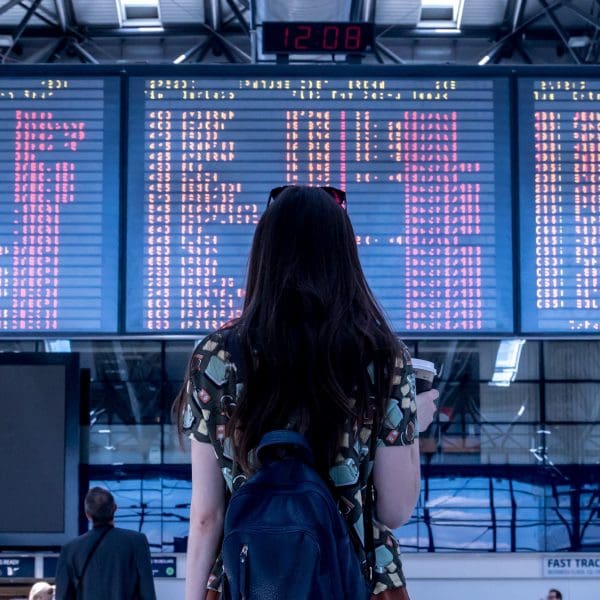
What kind of Interrail/Eurail passes are there?
Both Interrail and Eurail passes come in different types, and are available for people of all ages (so not just students!).
There is a reduction in price for under 28s and for over 60s – so make sure you let us know the correct age group, or your pass won’t be valid. Don’t think you can pay less by “looking young” – unfortunately, your passport number and date of birth will be printed on the ticket – so you probably won’t get away with it!
One country vs. global passes:
Interrail and Eurail passes come in a variety of different prices, and you can buy either a “Single Country” or a “Global” pass. For the global pass, you’ll also need to choose how long you want to use the pass for:
- You can buy a Single Country pass which is always valid for 1 month, but only within one country (or a selection of countries in the case of the Benelux pass).
- Or, you can buy a “Global” pass which is valid across the whole of Europe (or, at least most of it). You can choose how long you want to use them for: from 5 days up to 60 days! Each option has a different price.
As well as choosing how long you want the pass to be valid for, there is an option to select how many “travel days” you want. Don’t worry, we take all of this into account for every package, so you don’t have to work it out yourself!
What is an Interrail travel day?
An Interrail “Travel day” is a day when you will be using your pass to travel by train from one of your destinations to the next. There is no limit on the number of trains you can get within the 24 hour period from midnight.
Within the usage period (of up to 2 months) you will be asked how many “travel days” you want to have.
For interrail the options (from cheapest to most expensive) are:
- 5 travel days within a period of 1 month
- 7 travel days within a period of 1 month
- 10 travel days within a period of 2 months
- 15 travel days within a period of 2 months
- Travel every day within a period of 22 days
- Travel every day within a period of 1 or 2 months
For Eurail the number of days are slightly different, but the principle is the same. Already got your Interrail or Eurail pass and not sure how to use it? Check out our step by step guide on how to use your Interrail/Eurail pass .
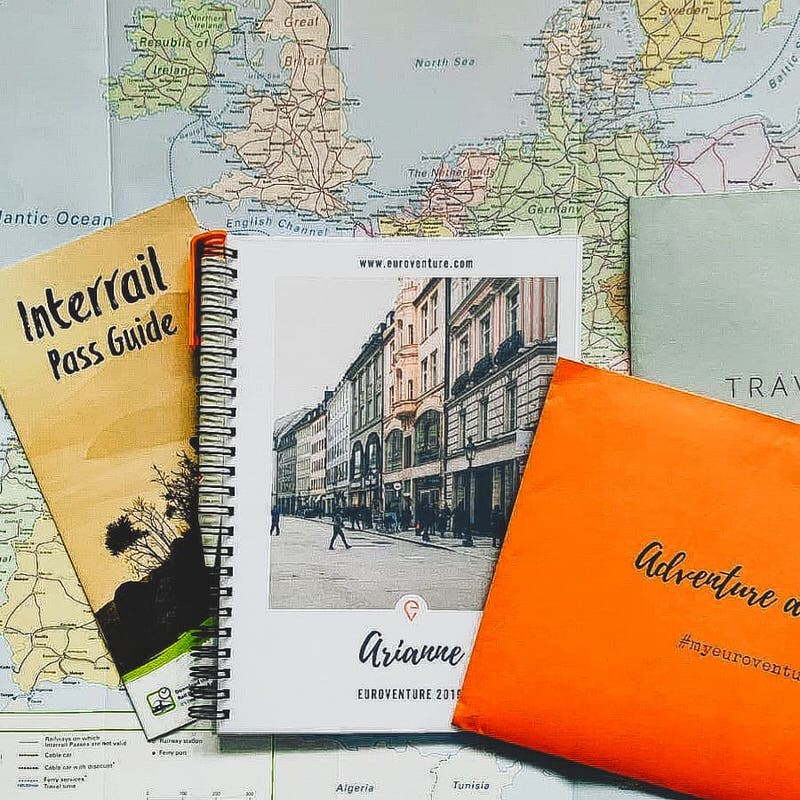
How do I know what kind of Interrail/Eurail pass I need?
For most people, the best way to work out what kind of pass you need is to first work out your route and then plan how long you’ll be travelling Europe by train. Next, work out how many travel days you will be taking. Then you need to work out which journeys will require additional seat reservations, and work out how much it will cost to buy those on top.
Unfortunately, the addition of Interrail reservations can make choosing your pass quite confusing. Sometimes the high cost of certain interrail reservations means that it makes more sense to choose a cheaper pass and buy a few extra tickets at full price, but then you’re into all sorts of comparisons and calculations…
So where do you start!?! Luckily when you book with us , we work out exactly which tickets, passes and reservations you’ll need and which combination works out the cheapest.
Let’s talk more about these pesky reservations…
Seat Reservations
What is an interrail/eurail seat reservation.
Interrail or Eurail seat reservations are extra bookings required on certain trains when travelling Europe using an Interrail or Eurail pass. They are not tickets, but are used together with your rail pass to allow you onto certain services.
As well as being compulsory to board certain services, they also guarantee you a seat on the train that you’ve selected. That can be a bonus in peak season when trains get really busy!
Once you’ve purchased a reservation, you’ll need to stick to the train time you’ve selected, as the reservation is only valid for that departure.
Do I have to buy an Interrail reservation?
If you’re using a rail pass and the route you’re taking has a “reservation required” symbol on it, unfortunately, you must buy one. If you do not present a reservation with your pass when your ticket is checked, you’ll be asked to either leave the train at the next stop or pay a fine of up to €200. Nobody wants that, so make sure you do your research before you go!
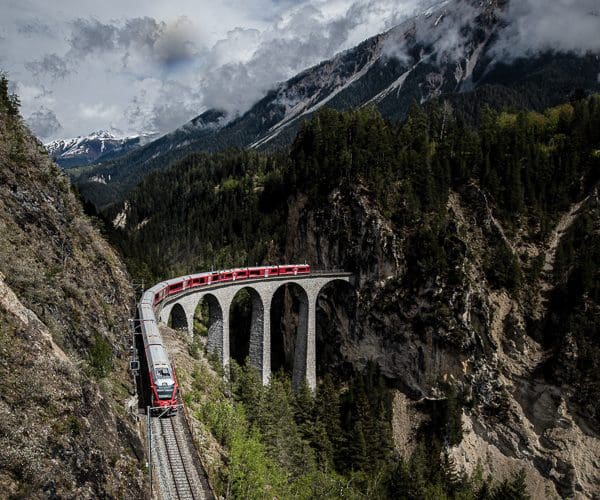
How do I know when I need one?
Good question, and unfortunately that can be tricky. The rules change regularly and the information is not always easy to find. As a general rule, you will need one on any high-speed train in Western Europe, and on any sleeper train.
On local and regional trains it’s usually not necessary to have a reservation. For our full guide on this, head to our Interrail reservations guide . When you book with us, we’ll buy you all the passes, tickets and reservations you need, tell you which ones to use and when, and let you know where you can travel without any. Easy!
If you want to check requirements, the best app for train travel in Europe is DB Navigator. This gives you pretty up to date information about all European services as far as possible.
How much does an Interrail/Eurail Reservation cost?
The cost varies depending on each country’s rail services but generally falls between 5 euros and 30 euros.
If you’re looking to save money and you aren’t short of time, it might be worth seeking out slower journeys so that you can avoid paying for reservations on certain routes – plus, you might get an awesome view!
When we book trips for our customers, we work out the most cost and time efficient way to do each journey. Using our comparison software, we find the best possible combination of full fare tickets, rail passes and reservations. This means we can work out the best possible cost. That means we reduce the cost for you guys, while booking the journeys that make the most sense for your trip. Create your dream route here with our interactive map planner .

Is First Class worth it?
First class versus second class train travel in europe:.
Usually, trains in Europe have two class options – 1st and 2nd. On high-speed trains in Spain and Italy you may also find more options to suit various budgets and comfort levels. First class train travel in Europe usually costs significantly more than second class – first class tickets could be 3 or 4 times the price when bought on the day. You can also choose a first-class rail pass and first class reservations if you go for an Interrail or Eurail pass. These cost around twice the price of their second class siblings, but you also pay more for seat reservations.
The differences between first and second class trains are most noticeable in Western Europe – France, Switzerland, Germany, Netherlands, Spain and Italy all have pretty luxurious first class options. For train travel through Eastern Europe, there’s less of a difference as services are slower and trains older as a general rule. Here it might well not make a lot of difference whether you upgrade or not.
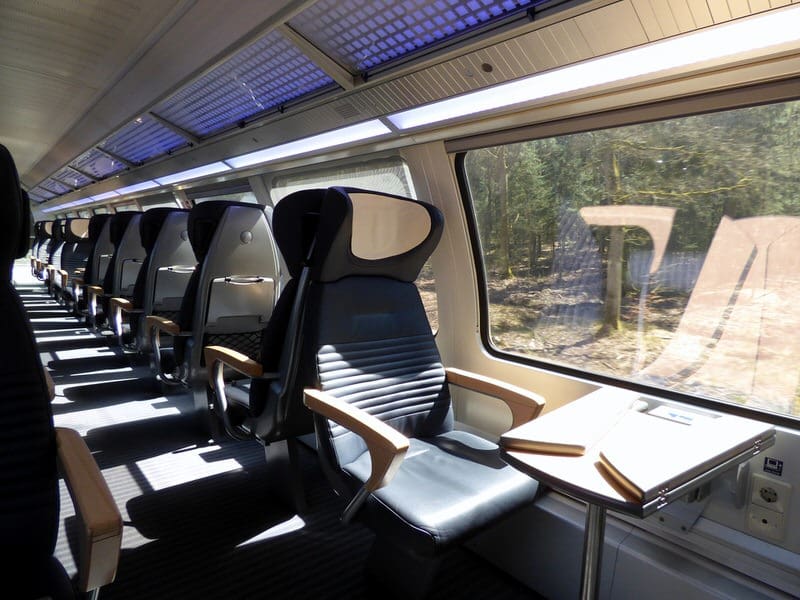
If you’re not sure whether this is something you might want to splurge on, check out the major differences in service level below:
- Second class trains provide basic but comfortable facilities, with drinks and snacks available to purchase. Some high-speed trains will offer free entertainment or wifi.
- You can always reserve a seat, whether you’re in first or second class.
- First class trains will provide more spacious seats with more leg room than second class.
- First class carriages will generally be quieter with fewer passengers.
- On major high-speed routes, first class may well offer additional perks, such as free drinks/snacks, free WIFI and complimentary newspapers.
- On regional routes, there are unlikely to be any additional benefits beyond more space. For these trains, it may not be worth paying the extra.
Overnight train travel
Overnight transport can be a great way to maximise your time when travelling Europe by train. All night trains will require an extra supplement to be paid, on top of your Interrail or Eurail pass.
As we’ve mentioned in our video guide, here are a range of different options for overnight travel. You can choose based on your preferred comfort level and budget between the following:
- Seat – the cheapest option, you’ll have a seat in a normal carriage, which reclines back a little bit.
- Couchette – you’ll share a cabin with other travellers. Couchettes are normally for 6 people and offer a small bed with sheet and blanket for you to use. A more comfortable option than a seat, but cheaper than a sleeper.
- Sleeper – depending on your group number, you’ll share your cabin with other travellers. Sleeper compartments are for up to 3 people, with a comfy bed, duvet, sink and space for hanging clothes. Often refreshments and breakfast are included.
- Private sleeper – the same as a sleeper, but you book out the whole cabin for yourself and/or your group. This is the most expensive option, offering the highest level of comfort.

How much does a night train supplement cost?
The costs vary a huge amount; a seat or couchette could start from as little as 10-30 euros. A private sleeper could set you back over 200 euros!
Some overnight trains – such as the night train from Venice to Paris – don’t offer Interrail reservations. Instead they just offer you a discount of around 25% off full price tickets with your pass. These might be best avoided if you’re looking to save money.
Advance Tickets
After all this talk of Interrail and Eurail passes, it’s easy to forget that these passes aren’t the only way to travel Europe by rail! In many cases rail passes provide great value, but not always. If your journey is short or will involve a lot of costly reservations, it might actually be cheaper to buy your tickets individually.
Advance tickets can be even cheaper than a pass – particularly if you check different booking sites for deals. The only down-side is that booking in advance means losing some flexibility. For the cheapest fares, you generally have to stick to the chosen service. If you miss it, you will be asked to buy a new ticket!
We’d advise booking as early as you can manage – at least 3 months is best in most cases . This will give you the greatest choice of times at the best prices. Different providers have different bookings horizons, so you’ll need to keep your eye on the ball to keep track of availability. You can use the handy DB Navigator app to reliably check which times are available across most providers.
It’s also worth noting that a large percentage of European train tickets are not available as E-tickets. Remember that you’ll need to factor in P&P processing time and costs – or use a local agent in your home country.
We will consider all these factors for you when you book with us, so you can rest assured that as the experts we will take all of this into account!

Remember...
Preparing to travel Europe by train is super exciting, but it can also be stressful. Unless you’ve got a lot of time to spend researching and comparing prices, getting the cheapest possible deal can be tricky! You’ll need to do your research. That means visiting different booking sites to check prices and book individual tickets.
If you’re smart, a combination of all the above ticket types can be the way to get maximum value from your trip. Remember to ensure you follow all the rules of travel too – to avoid any unnecessary costs. Obviously we think the best way to book train travel in Europe without the hassle is to do it through Euroventure… we might be a little biased, but we’re happy to help with any level of service – from buying your train tickets through us to embarking on one of our independent Europe trips or group tours ! You can always contact us for more information on what we do.
Make sure you think about the type of experience you want too. For some people, a rail pass may still be the best option, even if it’s not the cheapest. That’ll certainly be the case if you want a bit of flexibility in your Europe trip. Making last minute changes to your advance tickets will cost you a fortune, and the trip is supposed to be fun at the end of the day!
Euroventure are a Deutschebahn ticketing agency, as well as an ABTA accredited tour operator. If you’re already busy planning, we sell individual European rail tickets, Interrail & Eurail passes and reservations. Or, if you’d prefer a zero stress option, we offer self-guided European rail trips including transport & accommodation, as well as small group tours .

WhatsApp us
Travel Europe By Train: Routes From Major Cities Across The Continent

Europe is a continent of rails with some of the best opportunities for train travel in the world. Over the years I’ve been fortunate to ride routes in Ireland, the United Kingdom, France, Spain, Germany, Italy, Switzerland, and plenty more. Despite the ease and affordability (with planning) of train travel in Europe, I’m still surprised to meet people from overseas who treat the continent like they’re flying into Phoenix, renting a car as soon as they land. In reality, train travel is often much faster, shedding as much as a few hours off your travel time when compared to automobiles, especially when looking at long distance routes covered by high-speed rail.
Below is everything you need to know about traveling Europe by train including information about the various high-speed train lines and how long it takes to travel between some of the most popular routes on the continent. Obviously, there are some omissions, but we’d be here all day if I typed out every route, especially once we get into central Europe. But by the time you’re done with the first couple sections, you’ll know how to search and plan your own train trip through Europe.
TRAVEL EUROPE BY TRAIN
Rail europe.
Rail Europe ( www.raileurope.com )
Most every country in Europe has their own rail system, and ipso facto, their own rail website for booking tickets. It can be a bit confusing, not to mention overwhelming when you’re planning a train trip across international borders. Rail Europe makes things easier by allowing you to simply plug in your destinations, dates, and preferred departure windows right on their homepage. The listings on the results page will display everything you need to know, including duration of the journey, whether it’s a direct train or if there’s a connection, and what carrier you’ll be riding.
On the downside, Rail Europe isn’t very useful for small town travel in Europe. If you try to make what Rail Europe deems to be an odd connection, you’ll get an error noting that “it is possible the journey that you are searching is made up of more than 2 connections or includes other modes of transportation.” In that case, you will need to research with the national rail operators. But if you’re sticking with the major cities. Rail Europe will work just fine.
Note: Some carriers, like Germany’s Deutsche Bahn , will show train times for different rail operators and will sometimes even allow you to purchase tickets with them (yay for Switzerland’s SBB, nay for Belgium’s Thalys), but Rail Europe ensures you’re seeing every possibility.
Eurail Pass
Eurail ( www.eurail.com )
Booking with Eurail is an excellent option if you’re looking for an all-in-one train ticket for one trip overseas. To start, have a look at their various passes . (As of publication, they have a 37 percent off summer deal.) Global passes that allow you to visit up to 28 countries in Europe start at €247. The select pass, covering two, three, or four bordering countries, start from 106. A one country pass with unlimited travel in one of Eurail’s 28 countries runs from €49.
Austria Train Travel
ÖBB ( www.oebb.at )
You might wonder why Austrian trains are run by ÖBB with the funny dots over the “O.” Austria auf Deutsch is Österreich . So that means the ÖBB is the Österreich Bundesbahn (isn’t German fun?) and they are the primary carrier in Austria with night train services that extend throughout Central Europe. In fact, you can take an overnight train from as far as my home of Düsseldorf to Vienna .
While not high-speed, they run one of my favorite lines, RailJet, which travels through the Alps between Munich and Bologna with stops in between. (I rode it from Munich to Verona , which does the journey in about six hours.)
- Vienna to Innsbruck: 4h 14m
- Vienna to Salzburg: 2h 22m
- Vienna to Graz: 2h 28m
- Vienna to Linz: 1h 07m
- Innsbruck to Salzburg: 1h 46m
- Innsbruck to Linz: 2h 57m
Belgium Train Travel
Belgian Rail ( www.belgianrail.be )
Like the Netherlands, Belgium is another easy country for international rail travel with more than manageable connections from all its bordering countries — France, the Netherlands, Luxembourg , and Germany.
- Brussels to Antwerp: 29m
- Brussels to Ghent: 30m
- Brussels to Brugge: 54m
- Brussels to Paris: 1h 22m (Thalys)
- Brussels to Amsterdam: 1h 50m
- Brussels to Cologne: 1h 47m
- Brussels to Düsseldorf: 2h 12m (Thalys)
- Brussels to London: 2h 01m (Eurostar)
READ MORE: Riding The Ronde: Belgium’s Tour Of Flanders Cycling Sportive
France Train Travel
SNCF ( www.sncf.com ); Thalys ( www.thalys.com )
From Paris, you’re firmly on the continent and have no shortage of direct routes to major European destinations. Plus, France’s SNCF runs some of the fastest trains in the world, hitting speeds up to nearly 200 mph with their TGV line. In this case, whether you book with Rail Europe or not, you’ll definitely want to keep an eye on SNCF’s website because France is notorious for their rail strikes, which can throw more than a wrench into any itinerary. But assuming labor and the government are getting along, then train travel in France is one of the most enjoyable experiences you can have in Europe.
Below are some popular direct routes you can consider from Paris. All routes are run by SNCF unless otherwise noted.
- Paris to Lyon: 1h 57m
- Paris to Marseille: 3h 21m
- Paris to Barcelona: 6h 27m
- Paris to Brussels: 1h 22m (Thalys)
- Paris to Amsterdam: 3h 17m (Thalys)
- Paris to Cologne: 3h 20m (Thalys)
READ MORE: Planning a Trip to Paris? Let “The New Paris” Be Your Guide ; Things to do in Marseille ; Things to do in L’Isle-sur-la-Sorgue and Provence
Germany Train Travel
Deutsche Bahn ( bahn.de )
The Germanic world isn’t quite as fast as Spain or France, but what they lack in speed to make up for in connectivity. It seems like you can get damn near anywhere in Germany, Switzerland, and Austria. Some of the smallest towns on the map even have rail service. Few communities are left behind. In fact, it’s even in the German constitution that the rail system will be expanded in the best interest of the people. Of course, that opens itself up to political interpretation, but it seems like they’ve done a damn fine job.
Deutsche Bahn is the primary intercity rail provider with various regional entities filling out the rail system. ICE, Intercity Express, is the high-speed line, not to be confused with IC.
It can admittedly be a little tricky keeping track of when you need to buy a Deutsche Bahn ticket and when you need to get something local. But Deutsche Bahn will certainly cover you for travel between cities. If you are traveling to a small town, it’s best to use Deutsche Bahn’s website and punch in your destinations. If you can’t buy a ticket, it’ll say so. More often than not you’ll be fine.
For more on riding the train in Germany, click here. Otherwise, below are travel times from popular German cities.
- Berlin to Munich: 3h 58m
- Berlin to Hamburg: 1h 42m
- Berlin to Frankfurt: 4h 7m
- Berlin to Düsseldorf: 4h 15m
- Berlin to Prague: 4h 16m
- Berlin to Warsaw: 6h 22m
- Munich to Hamburg: 5h 33m
- Munich to Frankfurt: 3h 10m
- Munich to Düsseldorf: 4h 42m
- Munich to Zurich: 4h 14m
- Munich to Milan: 13h 28m (night train)
- Munich to Rome: 13h 40m (night train)
- Munich to Vienna: 4h 14m (RailJet)
- Hamburg to Düsseldorf: 3h 39m
- Hamburg to Frankfurt: 3h 36m
READ MORE: Places to Visit in Germany Off The Beaten Path ; German Travel Phrases ; Riding the Train in Germany
Italy Train Travel
Tren Italia ( www.trenitalia.com ); Italo ( www.italotreno.it )
Italy might have a Mediterranean reputation of taking it easy, but as many Italians will tell you, the country is incredibly divided between north and south. The north is a rail juggernaut with some of the fastest trains on the continent operated by the publicly-run Tren Italia and the private Italo. South of Naples to Bari, Palermo, and everything in between is where you’ll find slower train journeys running in a more dilapidated system.
Riding the rails in Italy is truly a treat, which you can get a preview of by reading Tim Parker’s travelogue Italian Ways . Not just because they have some of the fastest trains in the world, allowing you to quickly connect two vastly different cultural regions in a few hours, but also because tickets are absurdly affordable. Frankly, the rail system has become a financial drag on the country in large part thanks to cheap fares (sometimes as low as a few euros on the regional lines, like Verona to Mantova). But for a traveler, it’s a pretty sweet deal. For high-speed trains with Tren Italia, look for the Frecciarosa — red arrow. Italo only runs high-speed trains. Travel times are virtually identical between the two lines, so you’ll likely make your decision based on cost.
- Milan to Verona: 1h 13m
- Milan to Bologna: 1h 02m
- Milan to Florence: 1h 39m
- Milan to Rome: 2h 40m
- Milan to Venice: 2h 13m
- Milan to Naples: 4h 35
- Verona to Bologna: 50m
- Verona to Florence: 1h 27m (Italo only)
- Verona to Rome: 2h 56m
- Florence to Rome: 1h 25m
- Florence to Venice: 2h 05m
- Venice to Rome: 3h 21m
READ MORE: Places to Visit in Venice Off The Beaten Path ; All Roads Lead To Rome ; Italian Craft Beer in Rome ; Places to Visit in Verona Off The Beaten Path
Ireland Train Travel
Irish Rail ( www.irishrail.ie )
Ireland may be one of the smallest, least populated countries in Europe, but that doesn’t mean they’re without an efficient, enjoyable rail system. In fact, my first intercity train trip was on Irish Rail from Killarney to Dublin. While the buses were much cheaper, like anywhere else, trains were plenty affordable and much more enjoyable.
None of the lines are high-speed, but considering Ireland’s geographic size, it doesn’t necessarily make sense to invest in high-speed rail. You can get clear across the country in just a few hours on a direct route.
- Dublin to Belfast: 2h 10m
- Dublin to Galway: 2h 19m
- Dublin to Cork: 2h 35m
- Dublin to Killarney: 3h 10m
- Dublin to Limerick: 2h 13m
READ MORE: Things to Do in Dublin ; Things to do in Cork
London to Paris Train
Eurostar ( www.eurostar.com )
Eurostar covers journey across “The Chunnel,” making the direct undersea journey in a little over two hours. (Compare that to six-plus hours by far, if there’s no traffic.) The Chunnel itself is 50.45 kilometers long (31.5 miles) and is the world’s longest undersea tunnel. Engineers had been dreaming of such a tunnel since the early 1800s, but it wasn’t until 1993 that it was completed with Eurostar launching operations in November of 1994.
Netherlands Train Travel
Dutch Railways ( www.ns.nl )
The great thing about train travel in the Netherlands is that it’s such a small country, you don’t need to begin your journey in the country. Düsseldorf or Cologne to Amsterdam, for instance, is a very popular route to take even if just for a weekend. From there, most any other Dutch mid-size or large city will be connected by rail.
- Amsterdam to The Hague (Den Haag): 52m
- Amsterdam to Rotterdam: 37m (Thalys)
- Amsterdam to Utrecht: 26m
- Amsterdam to Maastricht: 2h 25m
- Amsterdam to Brussels: 1h 50m
- Amsterdam to Paris: 3h 18m (Thalys)
- Amsterdam to Cologne: 3h 51m (Deutsche Bahn)
READ MORE: Places to Visit in Amsterdam Off The Beaten Path
Portugal Train Travel
Comboiso de Portugal ( www.cp.pt )
Portugal doesn’t match France or Spain when it comes to high-speed rail, but you’re hardly slumming it here. Comboios de Portugal runs the country’s Alfa Pendular service extending from the northern border throughout the mainland at speeds of up to 220 km/h (140 mph). One of the most popular routes, from Lisbon to Porto, runs almost hourly and completes the journey in about 2 hours and 35 minutes. Lisbon to the other end in Faro takes about 3 hours.
Spain Train Travel
Renfe ( www.renfe.com )
Like France, Spain has some of the fastest high-speed trains in the world with their AVE line operated by Renfe. ( Ave = bird en español. ) During a test trip, the train was able to near around 400km/h (248.5 mph) and runs an operational speed of 350 km/h (217 mph). Needless to say, it’s travel on the AVE within Spain is an incredibly popular option, decimating average car drive times. As an example, the fastest scheduled train from Barcelona to Madrid in just 2.5 hours direct. By car? Six hours or more.
There’s also Alvia, which is still high-speed (topping around 250 km/h or 155 mph) but only AVE operates exclusively on high-speed rails. Basically, the way Alvia trains are designed is that they can switch to the older, classic Iberian gauge network to finish some journey — but that’s probably more nerdery than you cared to know, so let’s move on and have a look at some of the most popular routes and scheduled journey times in Spain.
- Barcelona to Madrid: 2h 30m
- Barcelona to Sevilla: 5h 25m
- Barcelona to Bilbao: 6h 39m (Alvia)
- Barcelona to Málaga: 5h 50m
- Madrid to Sevilla: 2h 32m
- Madrid to Bilbao: 5h 04m
- Madrid to Lisbon: 9h 37m
Note that the Madrid to Lisbon route is an overnight train service called Trenhotel run by Renfe. There were plans to connect the two with high-speed rail, but they were canceled in 2012.
If you want to continue your rail travels into North Africa, take the ferry from Tarifa to Tangier where you can travel from Marrakech to Fez (and plenty of other stops) on ONCF. Read all about Morocco train travel here .
READ MORE: Things to do in Ibiza ; Places to Visit in Tenerife Sur Off The Beaten Path
Switzerland Train Travel
SBB ( www.sbb.ch )
Swiss trains will also have a place in my heart. They were the first high-speed trains I ever rode and the first time I drank a beer on a train — a personal milestone. Switzerland is the country for rail travel. They have the world’s most dense network (based on statistics in 2015), crisscrossing the tiny country despite the fact that the Alps covers about 60 percent of the country. Swiss engineers have yet to meet a mountain or any other natural obstacle that they couldn’t figure out how to lay track on or through.
The primary operator in the country is Swiss Federal Railways, which you’ll see as SBB, CFF, and FFS to cover three of their four official languages. In all, they run over approximately 3,200 kilometers (2,000 miles) worth of rail. For travelers, this means most anywhere you’d want to travel, be it a city or ski town, is going to be connected by rail.
- Zurich to Geneva: 2h 42m
- Zurich to Lausanne: 2h 8m
- Zurich to Bern: 56m
- Zurich to Lucerne (Luzern): 45m
- Zurich to Lugano: 2h 8m
- Geneva to Lausanne: 36m
- Geneva to Bern: 1h 44m
- Geneva to Lucerne: 3h 1m
READ MORE: Things to do in Switzerland
United Kingdom Train Travel
National Rail ( www.nationalrail.co.uk )
Anecdotally, I’ve heard plenty of Brits complain about rail service in the United Kingdom. Whenever I hear their complaints, my mind often wanders to a scene from Hot Fuzz where the main character is shown transferring train after train before arriving at his new post in a small town. That’s just not possible in the States or most places in the world.
But yes, relative to western continental Europe, the UK doesn’t have quite as fast or as expansive trains. That said, you can still get to any major city you’d want to visit, from Edinburgh to London and everything in between.
- London to Edinburgh: 4h 17m
- London to Glasgow: 4h 30m
- Glasgow to Edinburgh: 52m
- London to Manchester: 2h 05m
- London to Liverpool: 2h 12m
- Manchester to Liverpool: 38m
- Manchester to Edinburgh: 3h 09m
- London to Brussels: 2h 01m (Eurostar)
READ MORE: Why You Need To See England’s Premier League In-Person
Coming Soon
I’ll be updating this space as I travel on the rails of more countries (and as time allows). If you have any questions, suggestions, or thoughts, leave a comment!
You Might Also Like

Looking for the Best Way to Travel Europe? Check Out These 8 Tips

Hermanns Highway: A Weekend Getaway to Bielefeld and Teutoburger Wald

South Tyrol, Italy – From Brixen to Bozen and the Dolomites in Between
© 2015 - Joe Baur. All Rights Reserved. Designed & Developed by SoloPine.com

How to Travel Europe by Train: Step by Step!
Last Updated: March 21, 2024
*FYI - this post may contain affiliate links, which means we earn a commission at no extra cost to you if you purchase from them. Also, as an Amazon Associate I earn from qualifying purchases. Check out our Privacy Policy and Disclosure. for more info.
If you’re like me and come from a place where passenger rail isn’t common, then attempting to travel Europe by train on your own can feel as daunting as it does whimsical.
How do I buy the right ticket? What routes can I take? How do I access Platform 9 3/4?
Well, allow me to step into the very made up role of fairy trainmother. I’ve been travelling around Europe by train for almost a decade, so I’ve done most of my learning the hard way…. Learnings which I will now share with you in this compact step by step guide.
Whether you’re anxious before your trip, or just curious to see what it’s like, this post will walk you through step by step how to take trains in Europe, from start to finish.
NOTE: Train travel of course differs from country to country, so this post will speak in very general terms, but let me know in the comments if you’d like any country-specific ones!

Save this guide on how to travel Europe by train for later!
You’ll be very glad you did.
Step One: Decide if Train Travel in Europe is Right for You
First off – while I’m as ardent a train nerd as they come, I have to admit that trains aren’t always the best option in every country or circumstance.
Depending on the length of your trip, your destination, and your priorities (whether they’re budget, comfort, or experience), it may be worth looking into other options. One app I love for this is Omio, which shows you planes, trains, and buses from Point A to Point B.
Generally speaking, I think train travel is great if you’re looking for convenience, comfort and scenery.
Budget-wise, buses and budget airlines like Ryanair , easyJet and Wizz Air are usually cheaper, but honestly, for me, nothing beats arriving into the city centre directly after a long scenic ride of wistfully watching the world go by.
In some cases, like with some of the more scenic train journeys in Europe , the journey itself is the experience.
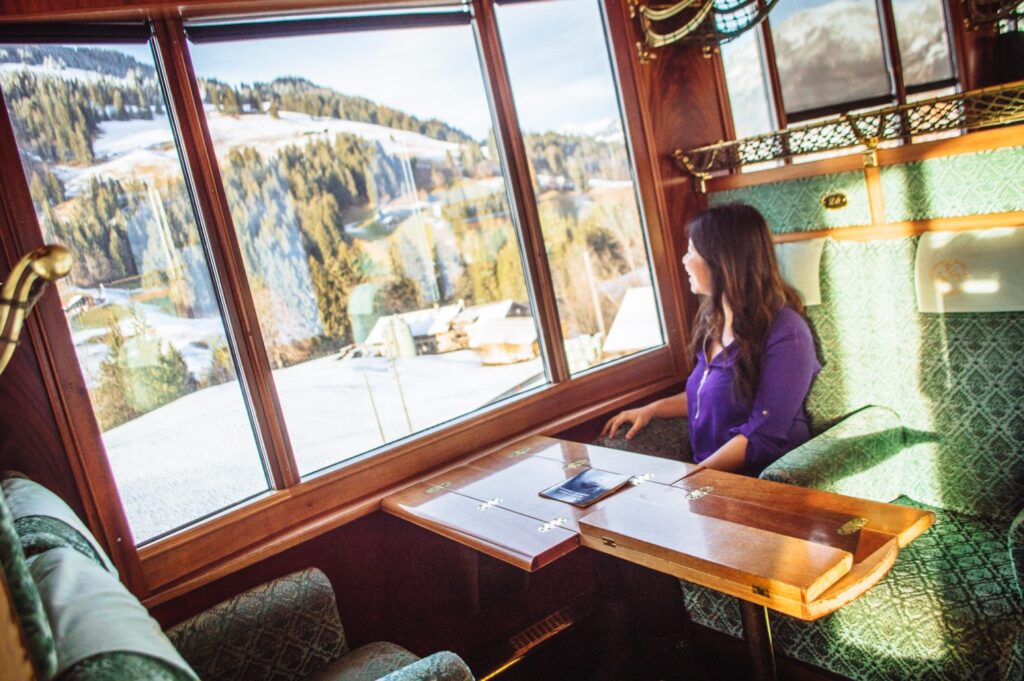
So, consider the pros/cons of train travel before moving on.
If/when you’ve decided you do indeed want to take the train, then we move onto…
Step Two: Buy Your Europe Train Tickets
Depending on the country, the pricing of trains in Europe is either…
- Fixed based on distance, like in the Netherlands and Belgium, which means the price will be the same whether you buy in advance or on the day of
- (Or, more commonly) dynamic based on the timing of your purchase and general demand like in Germany, Italy, and many other countries
Generally speaking, if budget is your #1 priority, the cheapest way to travel Europe by train is to pre-book your tickets in advance.
For those who want flexibility and ease however, a rail pass may be a better option, but whether or not that’s worth it depends on many factors which I cover in my full Eurail pass review so be sure to give that a read if you’re considering it.
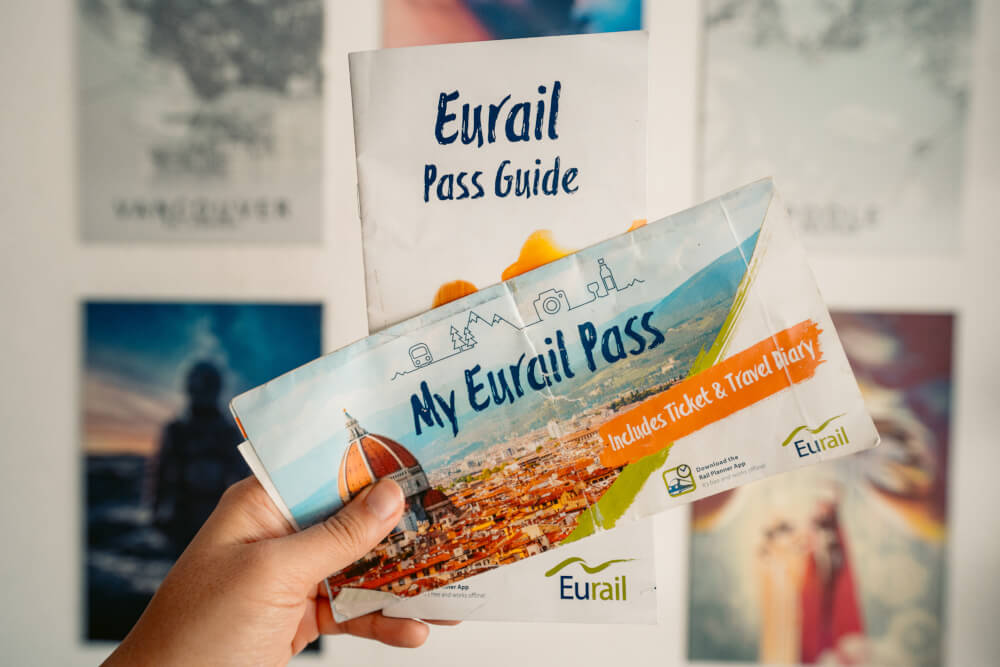
Now, when you go to buy tickets, you can either do so in person or online. I would highly advise booking online beforehand to minimize stress, and save money.
In person, you would typically buy your tickets from a digital kiosk, like one of these:
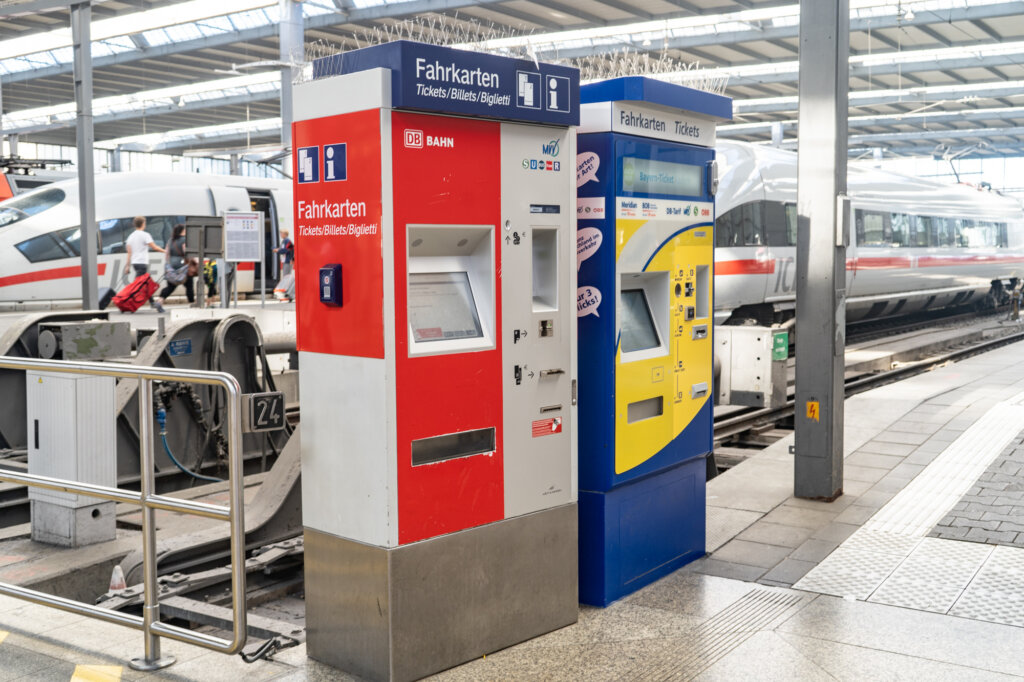
There is also sometimes the option to visit a customer service desk and purchase from there, although beware that certain countries may charge an additional charge when you buy via a customer service agent, compared to doing it yourself.
Online, you can either buy tickets directly through the train company or through a third party website.
The benefit of booking directly is usually it will be the cheapest, but I’ve found some rail company sites aren’t the easiest to use or most intuitive.
For me personally, more often than not, I actually book through third party sites like Omio or Trainline (mostly for the UK).
Yes you do pay a bit extra in service fees, but with third party sites, you get the benefit of simple user experience, a familiar interface across countries and often you can save your payment information as well which is handy if you plan to buy multiple tickets from multiple companies.
Third party sites/apps are also great for keeping all your tickets organized in one place.
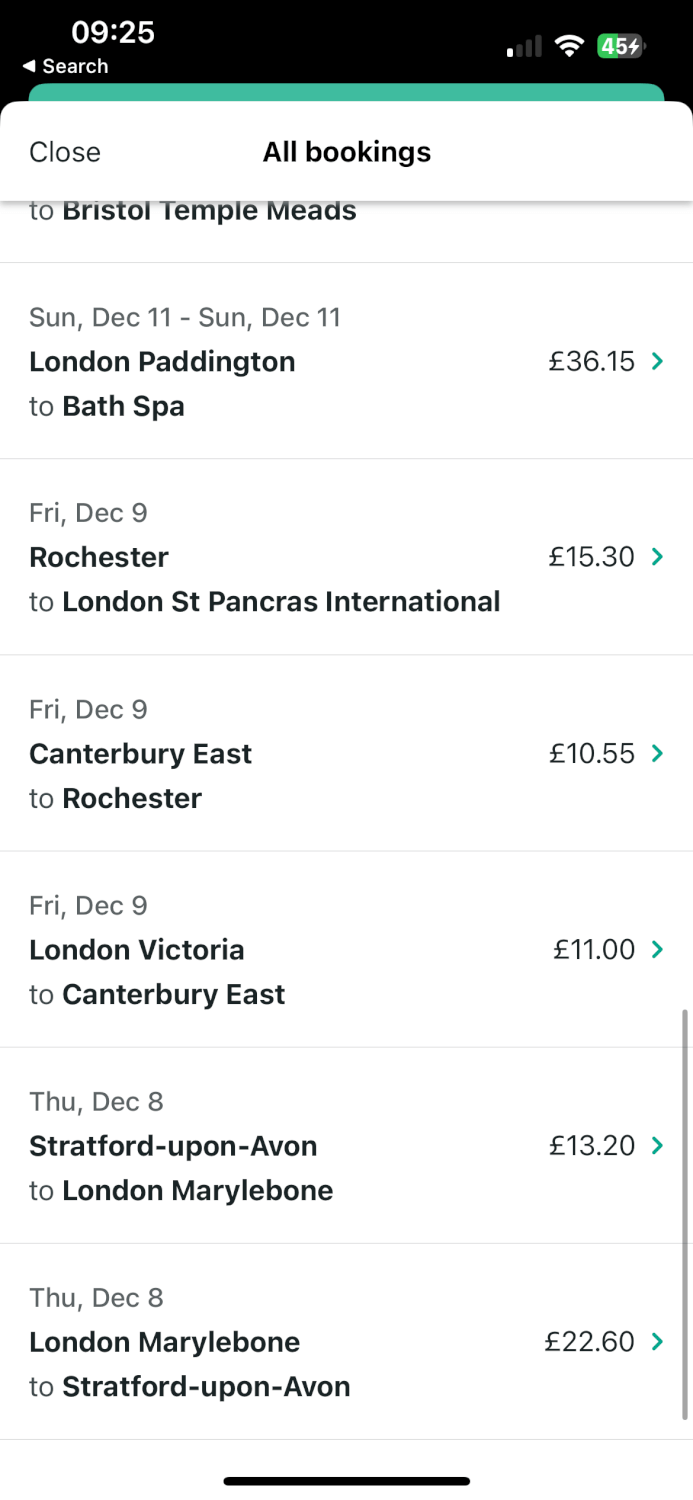
Whether you buy from the official website or from a third party though, there are several considerations to keep in mind when buying tickets.
Type of train: Most rail systems in Europe have a mix of high speed trains intended for Intercity use/longer journeys, as well as slower regional or suburban trains meant for shorter journeys.
Generally, the higher the speed, the higher the price, but do pay attention to the type of the train when booking so you can make an informed decision.

Peak or off-peak: In some countries like the UK and the Netherlands, pricing can also depend on the departure time of your train, with peak periods like before and after work costing more than off peak periods. I would recommend booking your journeys for off peak periods even if there’s no discount because it still has the benefit of being much quieter and less chaotic. The discount when there is one of course also helps.
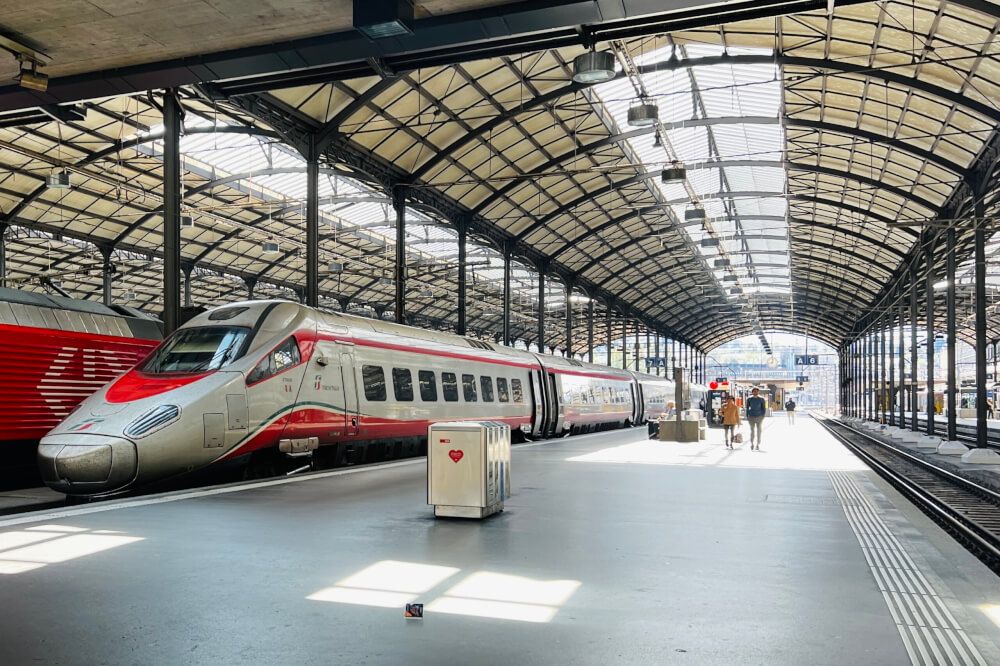
1st vs 2nd class : In most cases, there isn’t a dramatic difference between first and second class seats on European trains. The main perk of first class is it’s generally quieter and sometimes the seats are slightly comfier or more spacious. On longer journeys there may also be additional amenities like food service to your seat, but the difference isn’t as stark as say 1st class vs economy when flying.
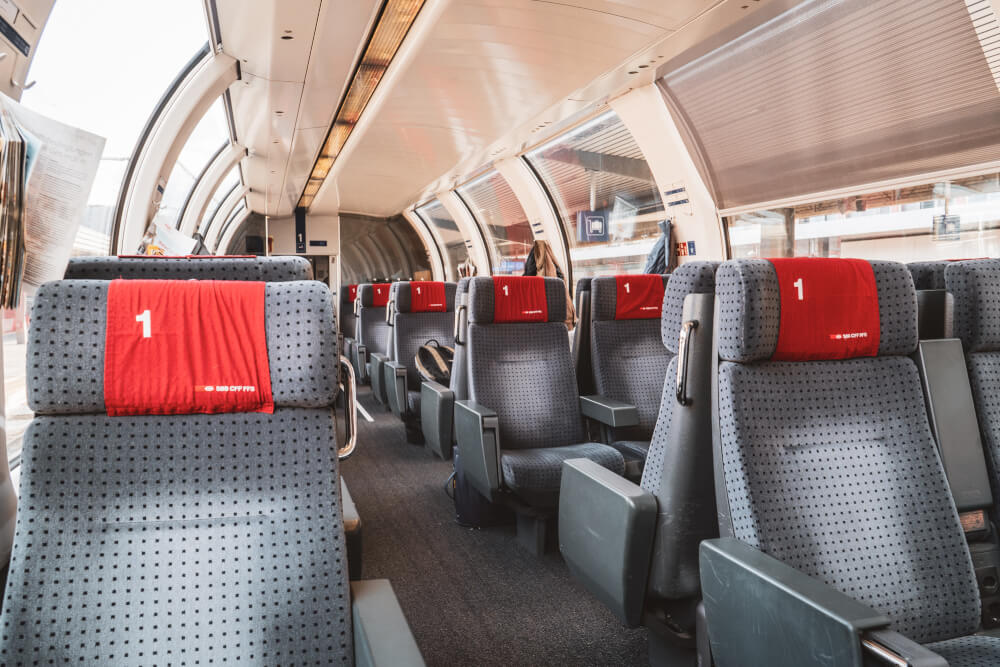
Reserved seats or not: depending on the country and train type, seat reservations may be…
- or not available at all, as is the case with many regional trains
If you are anxious about your trip, and especially if you are travelling during a peak season or time, then I’d highly advise booking a reserved seat.
Often this doesn’t cost more than 10 euros extra and the ease of mind it can bring is priceless. If you are travelling in a very off peak time though, you can usually get away with not pre booking a seat.
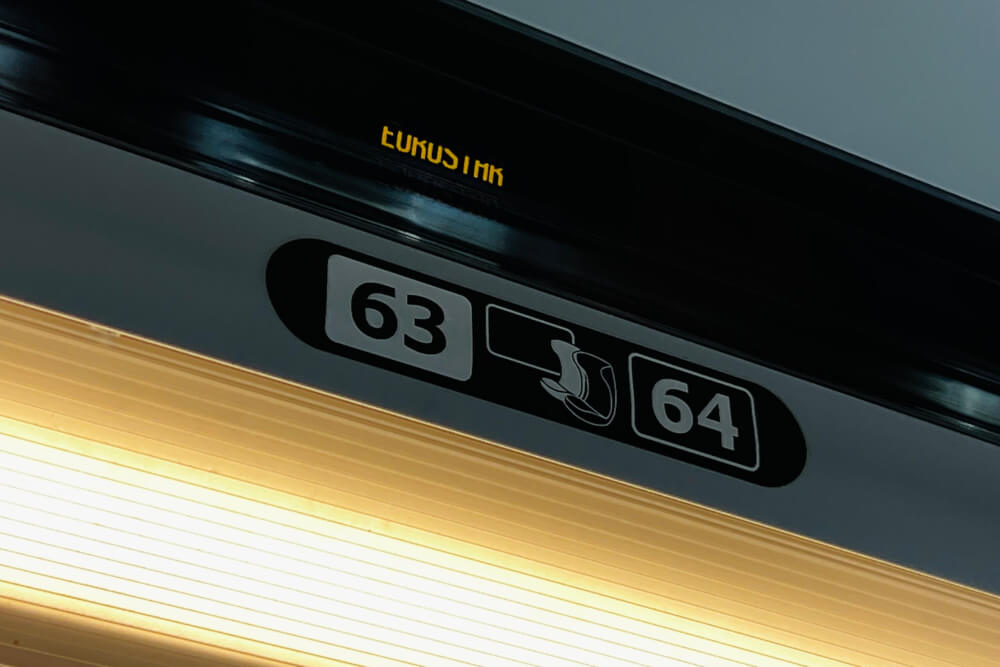
If reservations are available, then a further consideration are the different cabin types. Depending on the country, there may be different carriages with different formations (e.g. closed compartments vs. open plan seats).
In some countries, there may even be special carriages fit for different purposes, like…
- Silent/quiet carriages
- Cellphone carriages (where you can freely make calls)
- Bike zones (with additional space)
- Accessible zones
So be sure to keep those in mind when reserving your seat.
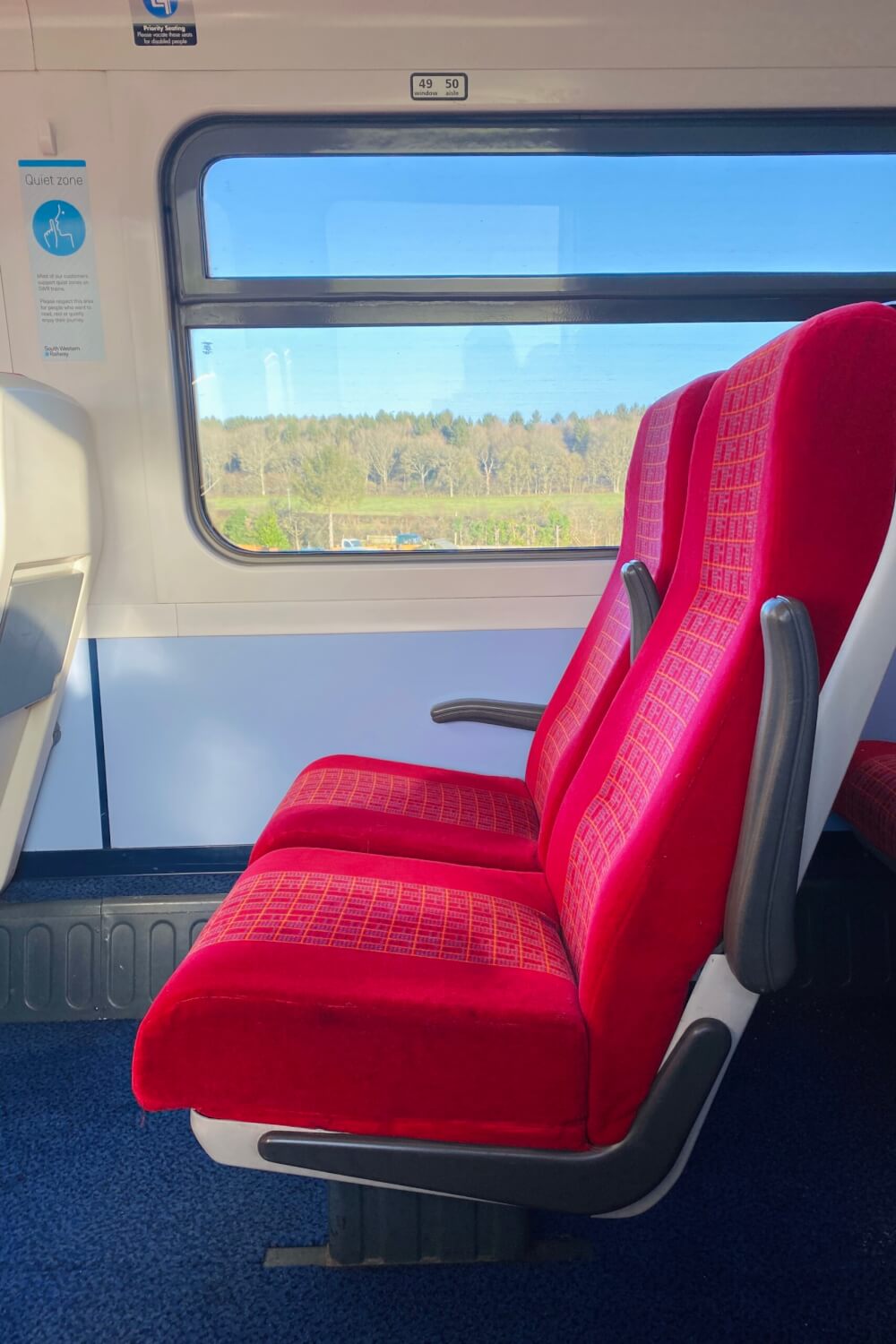
Lastly, if you are travelling with a bike or with a pet, know that often there are add-on tickets you must buy to bring bikes or pets on board.
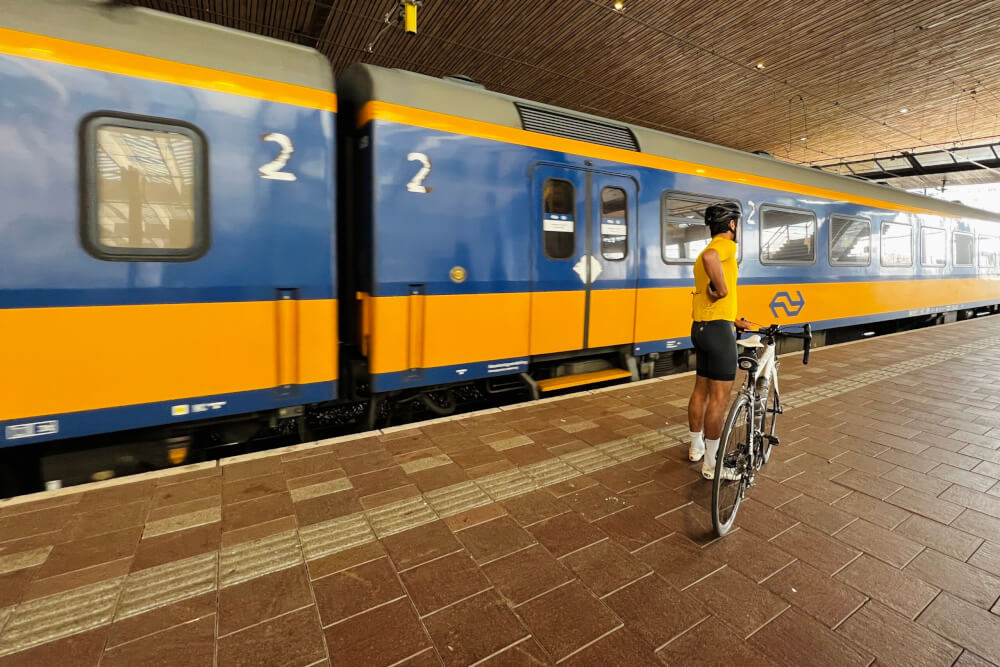
And if you’re looking to save some money, here are a few discounts to look out for…
- Age: Many companies will offer discounted tickets for children, youths up to around age 26 and also seniors
- Groups: In countries like Germany and the Netherlands, there are often tickets you can buy for a group which work out to be cheaper than buying tickets on your own
- Weekend/Holiday: Many countries will offer special deals for travel on weekends, like in Belgium
- Day tickets: Most rail systems have day tickets where you pay a set price for unlimited travel in a day, which can be very good value for day trips
- Attraction tickets: Some companies offer discounted prices for train travel when combined with an attraction ticket
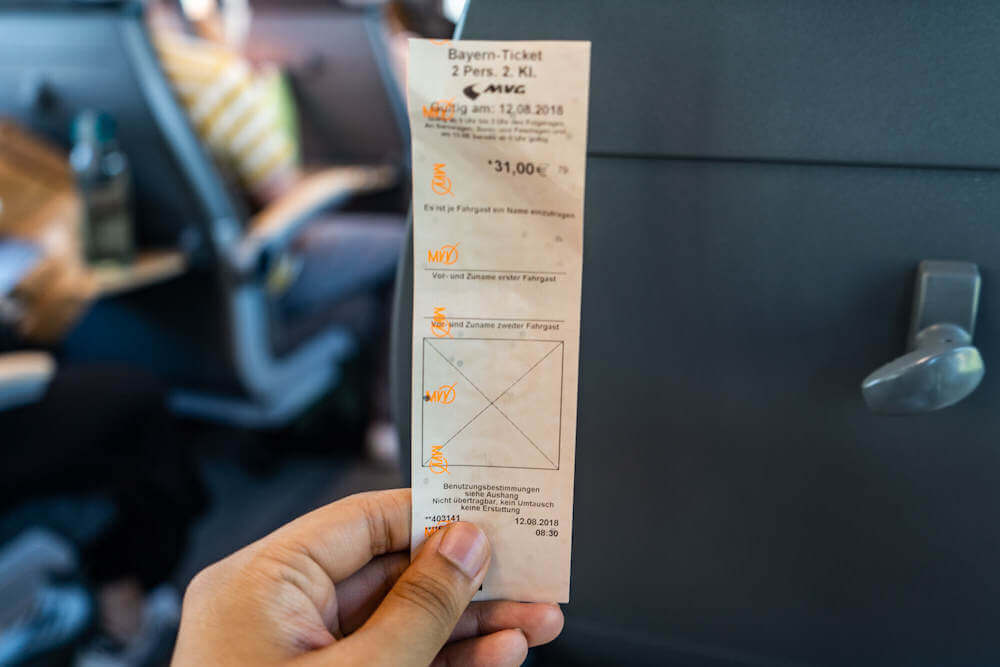
If you’re planning a longer term trip or perhaps are staying somewhere for a longer period, then another thing to look into would be a rail card or discount pass that costs a set fee but then gives you discounts for a year.
Many countries have these and they can save you quite a bit if you’re booking a lot of journeys.
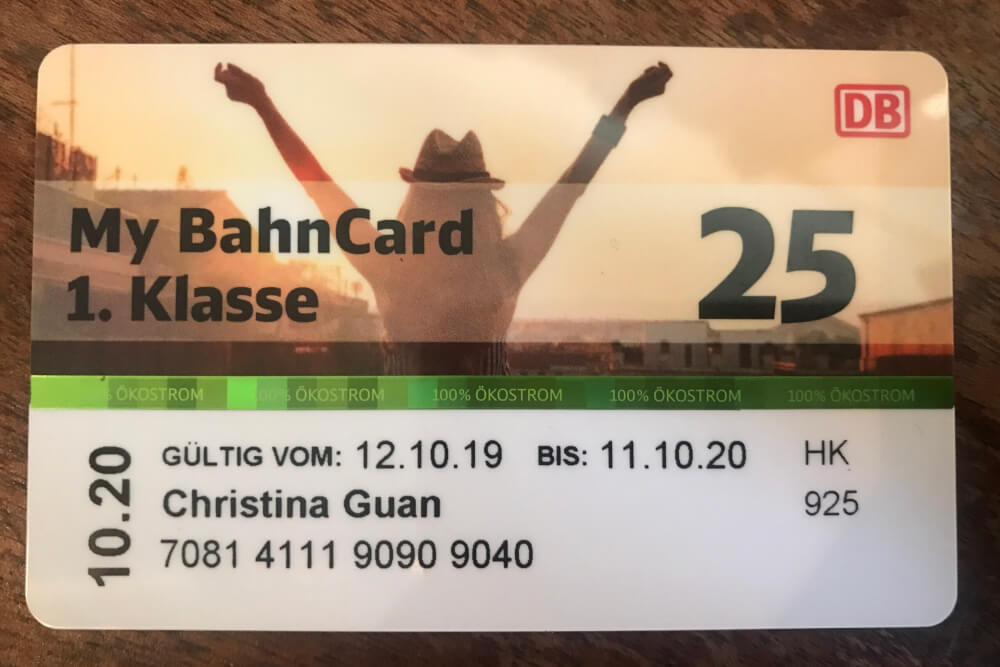
Alright with your tickets booked it’s time to move onto the day of your journey, with…
Step Three: Get Snacks
Before heading to the station I highly recommend making sure you have some snacks or drinks to bring with you on the train.
Eating and drinking is allowed in most trains, and while some longer intercity ones will have meal options on board, they’re often quite expensive and mediocre.
At the very least, make sure you have water or something to drink, in case you’re hit with a delay.
There are usually also options at the train station too but I find it less stressful to just have something in advance.

Now let’s move onto…
Step Four: Arrive at the Station
First off, before leaving, do double check that you are headed to the right station. Many major cities will have multiple stations, which can cause confusion and (if you’re not careful) result in you missing your train…. not that I know that from personal experience or anything.
Now, if it’s your first time at this station, I recommend you arrive thirty minutes or more in advance of your departure time.
Train stations in Europe can be overwhelming for first timers, especially if you end up at one of the mega-monster stations in large cities which have multiple levels, shops and upwards of 20 platforms.
Now, if you are taking public transport and arriving at the train station in a big city, you might find it tough to find where the trains actually are, because often these stations are multi level transport hubs servicing Metros, Trams and buses as well.
In any case, all you need to do is look for train symbols on signs like this which will point you in the direction of the platforms:
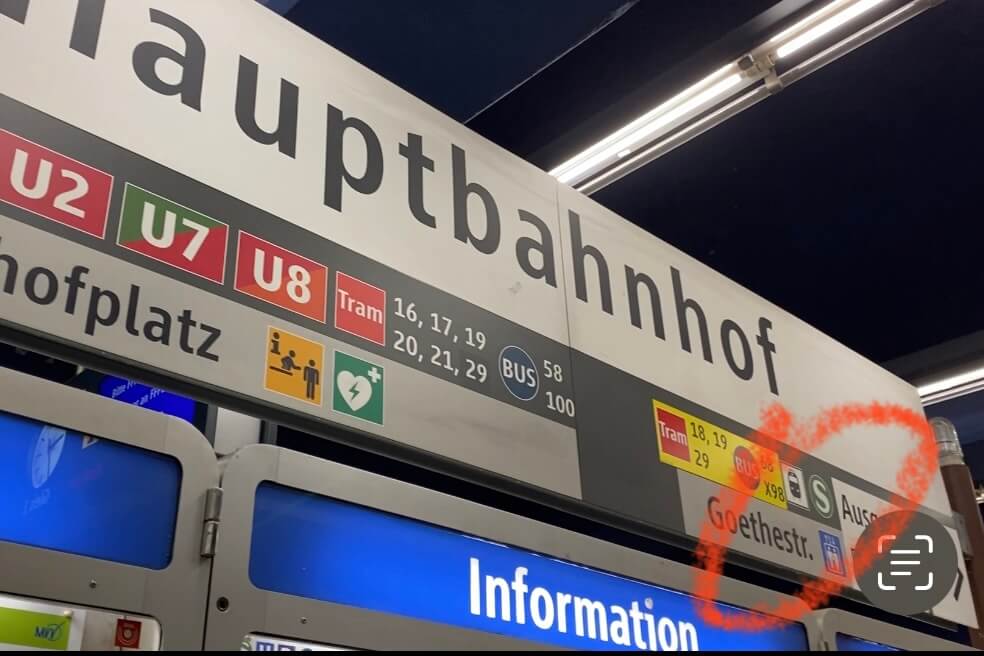
Now when you get to the main concourse of the train station, your priority is finding out which platform your train is on.
Often apps will tell you in advance but in big stations sometimes trains won’t even know which platform they’ll be on until they arrive.
In those cases, you may have to wait until the platform is announced. Simply stand at the big board (usually where the crowds are) and find your train then wait for the platform to show.
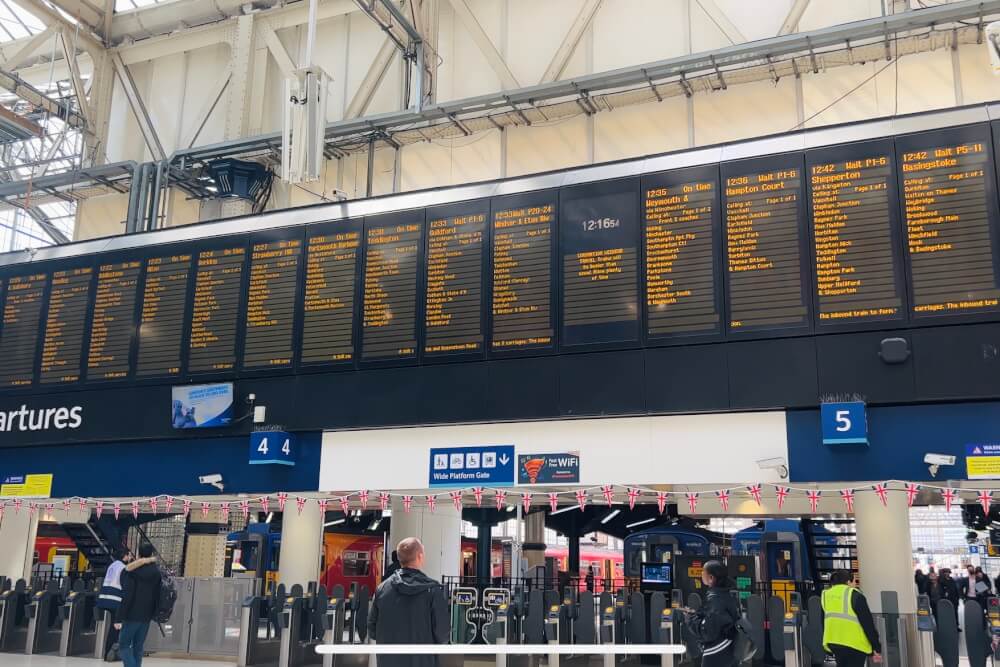
When looking at this remember that trains will not necessarily say your destination, but rather usually the final destination of the train, so if you don’t see the name of where YOU’RE travelling to, don’t panic.
Look for the time and train number, and underneath for the list of stops to see if your destination is listed, then figure it out from there.
NOTE: In addition to knowing the name of your destination in English, be sure to know its name in any local language(s) as well, because this is typically the name that will be shown on the boards/sides of the train. In multilingual countries like Belgium, be sure to learn the name of your destination in all official languages, because sometimes they will only show one or the other.
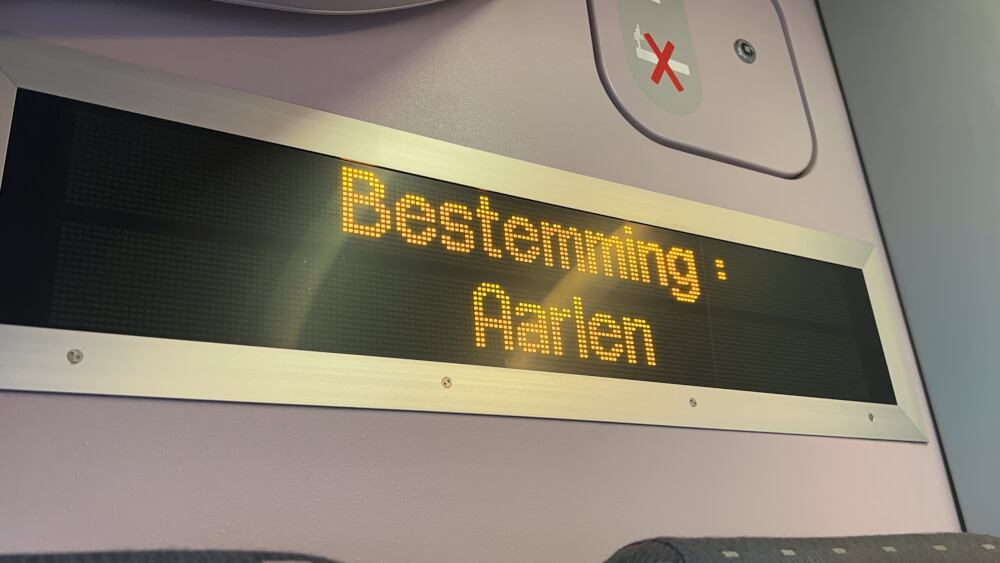
When the platform number is announced then it’s onto your next mission which is…
Step Five: Get to the Platform
Platform numbers will generally be very well marked so just look up for signs before making your way.
When you are making your way to the platform, be sure to have your ticket ready.
Some countries like the UK and Netherlands have electronic gates that require tickets to be scanned.
Others like Italy may require you to physically validate your ticket before stepping on board so double check if the ticket needs to be validated at a machine.
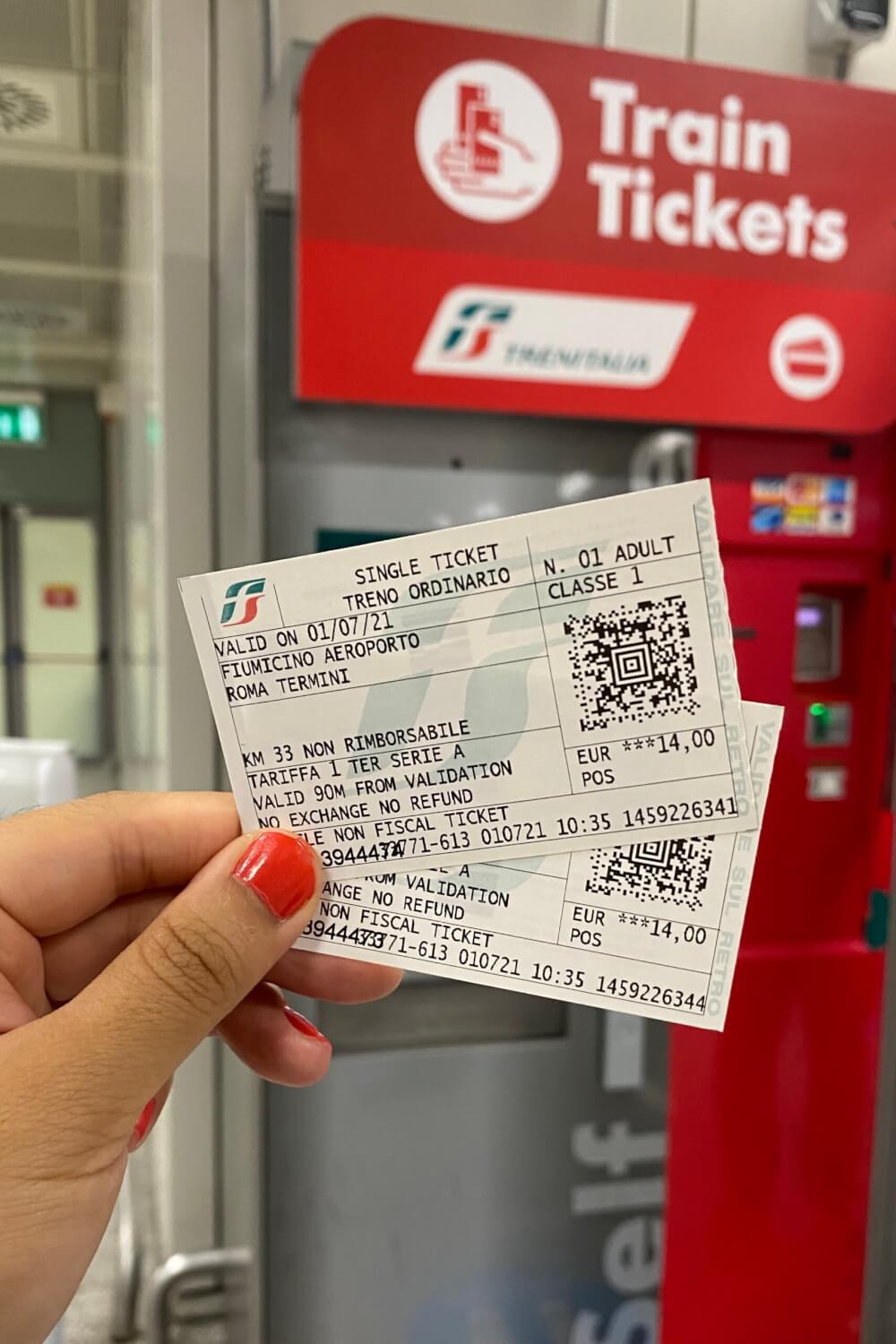
When you get onto your platform, double check it’s correct by confirming either on a screen or on the side of the train that you’re in the right place before proceeding to find your carriage.
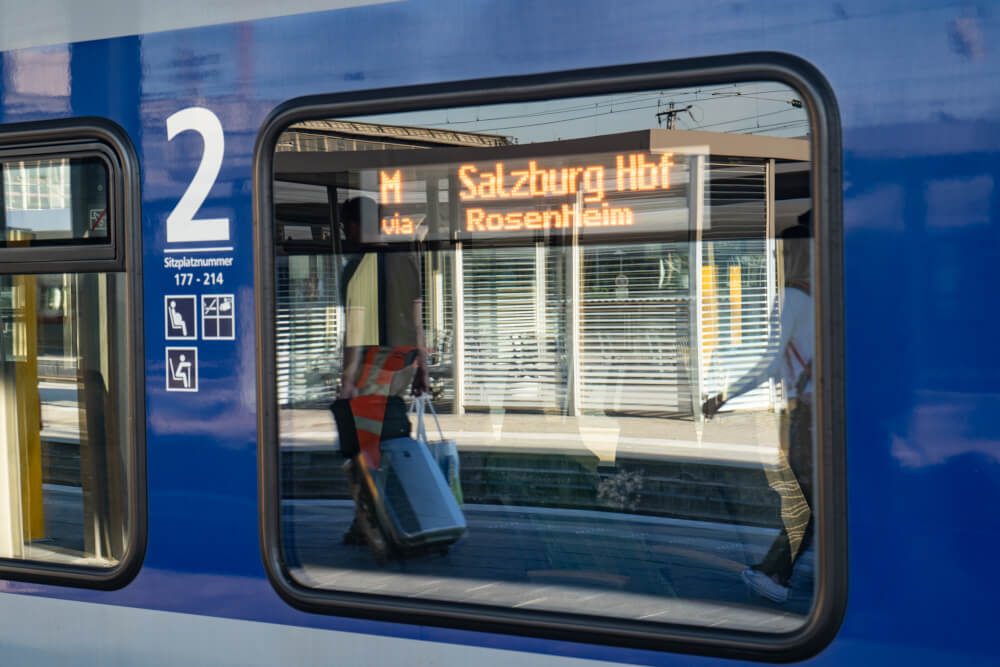
Step Six: Find Your Carriage
When walking to the train, if you have an assigned seat, take note of whether there’s a map or any kind of legend that shows you where your seat will be.
This can be helpful because some European trains are outrageously lengthy, so if you stand in the right section, your life will be much easier.
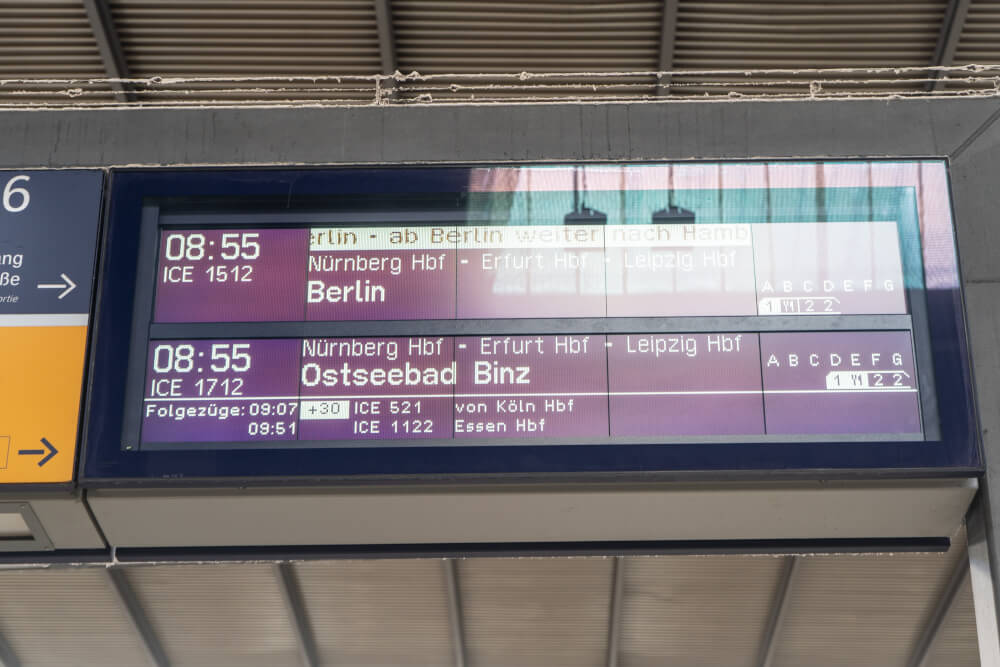
If you do not have an assigned seat, then you simply need to board a carriage in the right class, then pick a free seat at your own leisure.
When picking a carriage to board, pay special attention to…
- The class number of the carriage (you may only board the class you’ve booked for)
- Whether they are special carriages meant for a certain purpose e.g quiet zone, bicycle zone
- Whether the carriage number IS going to your intended location because some trains will split in some countries like Germany to then go off on separate directions, or some like in England get left behind at certain stops
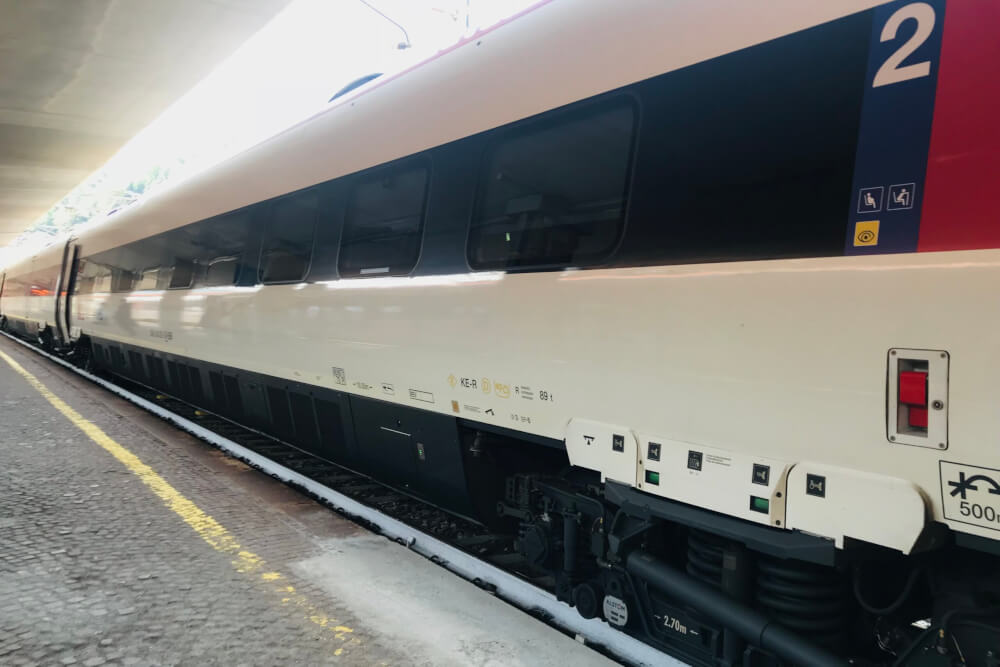
If you don’t have a reserved seat then usually I find the farther you walk, the emptier the carriages will be.
Once you find or choose your carriage, then it’s time to hop on board.
If the door isn’t opening then look for a button like this and press it. This goes for the train doors as well as carriage doors.
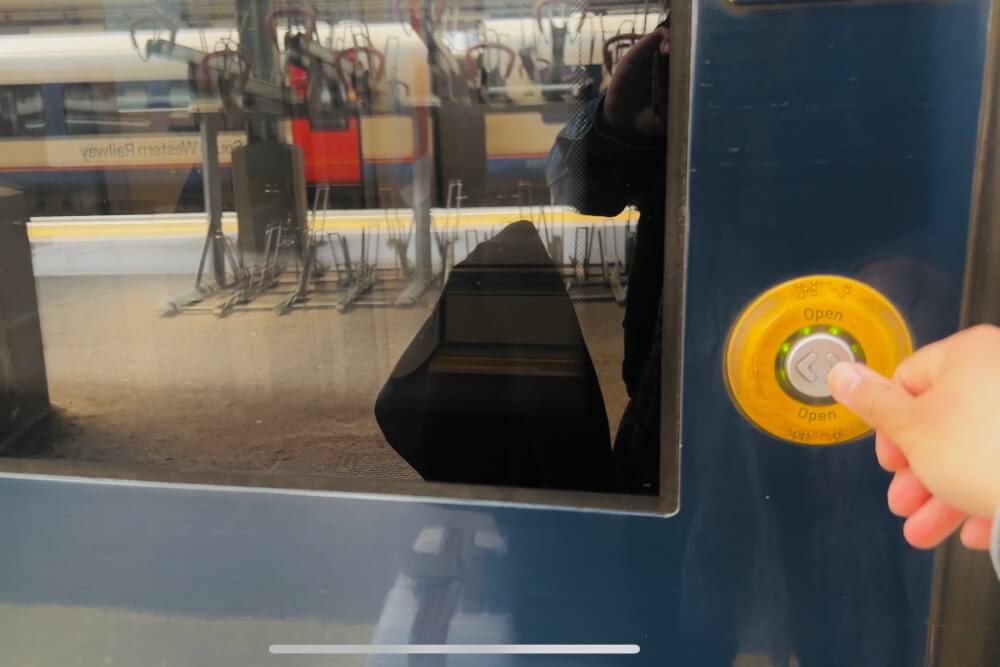
Now it’s time for…
Step Seven: Find Your Seat
First off, if your seat is assigned, try to make sure you go in through the correct door.
As you’re walking, look through the glass to see which end your seat will be so that you don’t have to squeeze past people coming from the other door.
If you have large bags, keep an eye out for large luggage racks when you enter. These will usually be found on the ends of the trains. With a carry on there is usually space above your seat for it.
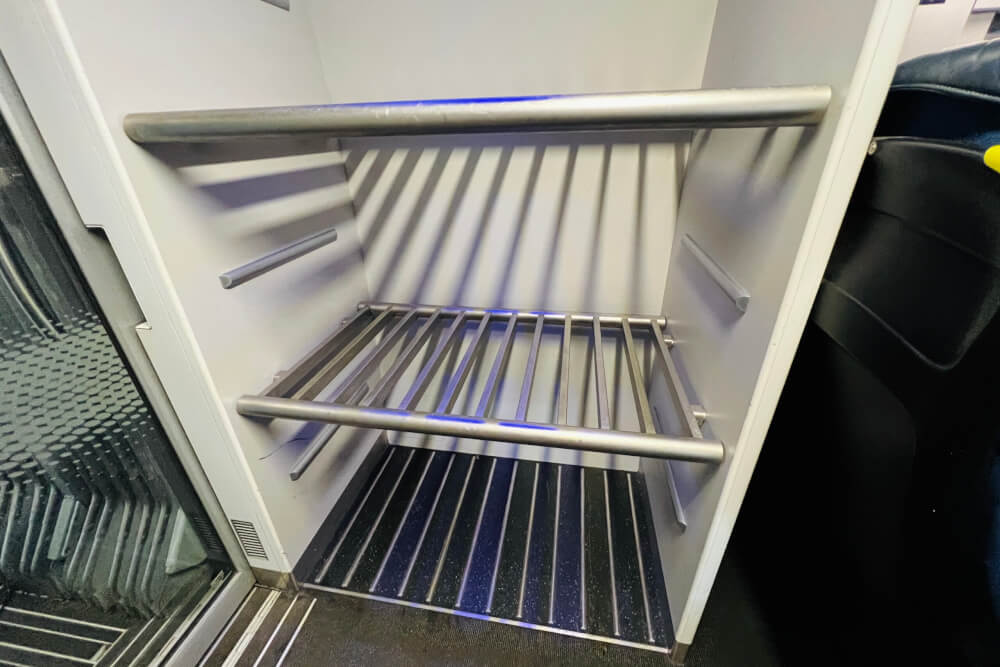
Of course, this doesn’t apply to all trains.
Sometimes regional or suburban trains meant tor short distances will NOT have special areas or compartments for luggage.
In these cases, for shorter journeys, I sometimes find it more comfortable to simply stand in between train carriages so I don’t have to worry about trying to find space for my luggage.
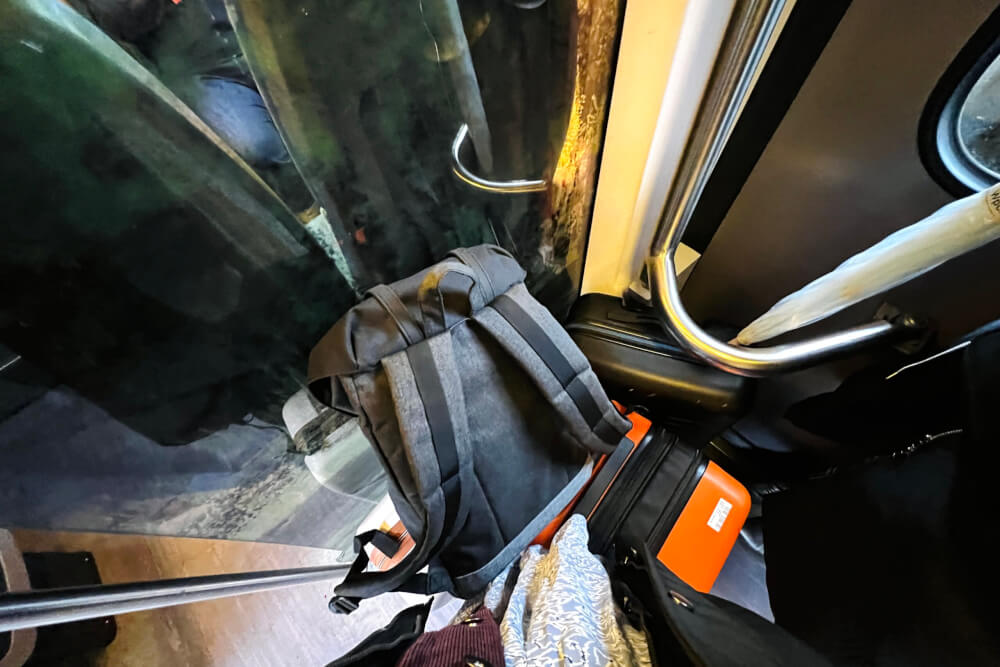
Or, in some countries like Switzerland where they have back to back seats, you can also easily roll your suitcase in between to avoid lifting.
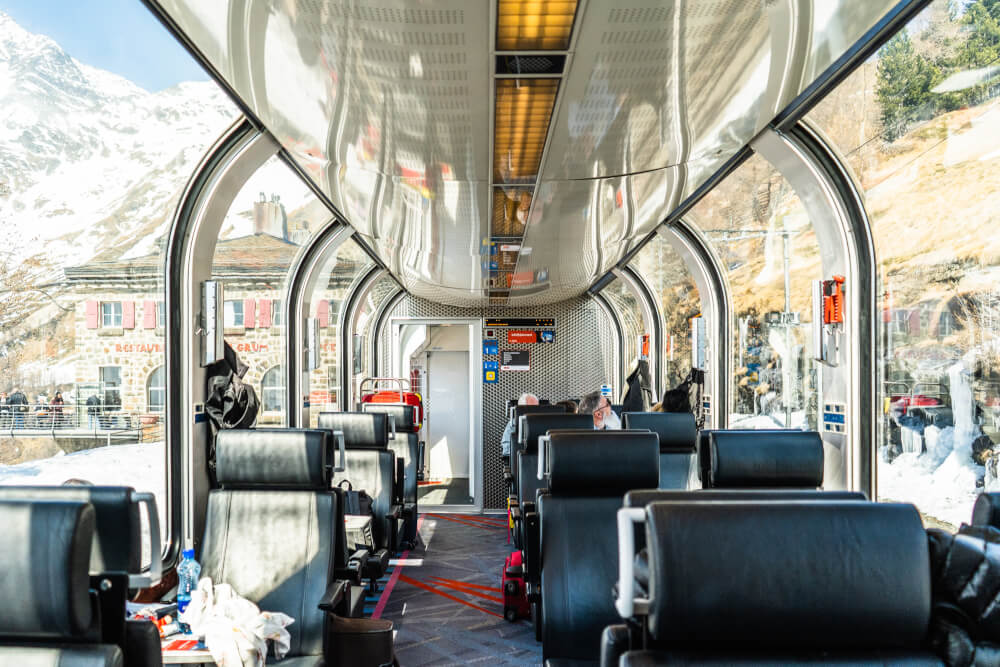
Before sitting down, make sure your seat isn’t reserved and make sure you’re not taking up a priority space if the train is looking full.
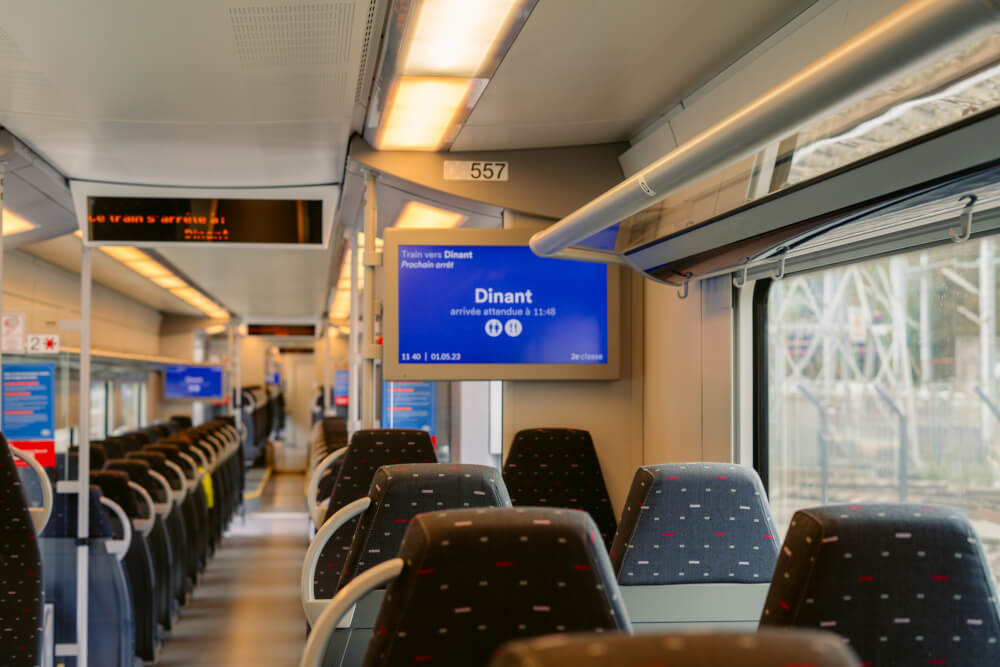
Now onto the fun stuff…
Step Eight: Get Comfortable and Enjoy the Journey!
On longer distance trains, there’s often (well hidden) outlets, a fold out table, hooks to put your coat up, etc. There may also be on-board WiFi!
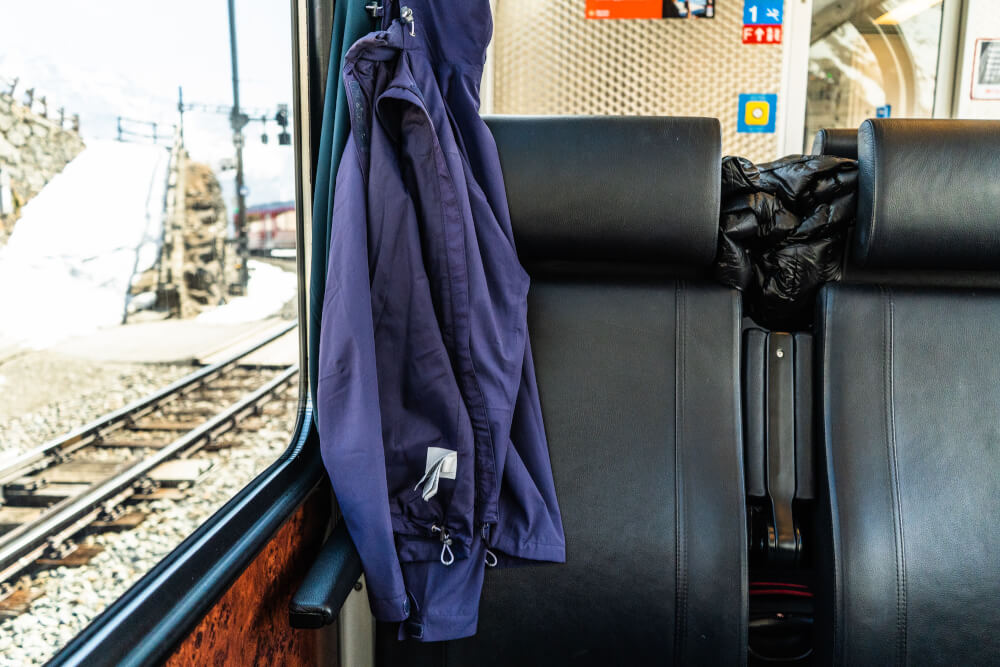
Longer distance trains may have additional amenities like a meal car or even seat service in first class so be sure to take advantage.

Of course keep an eye out for the WC symbol to find the nearest on board toilet (but make sure to bring any valuables with you just in case).
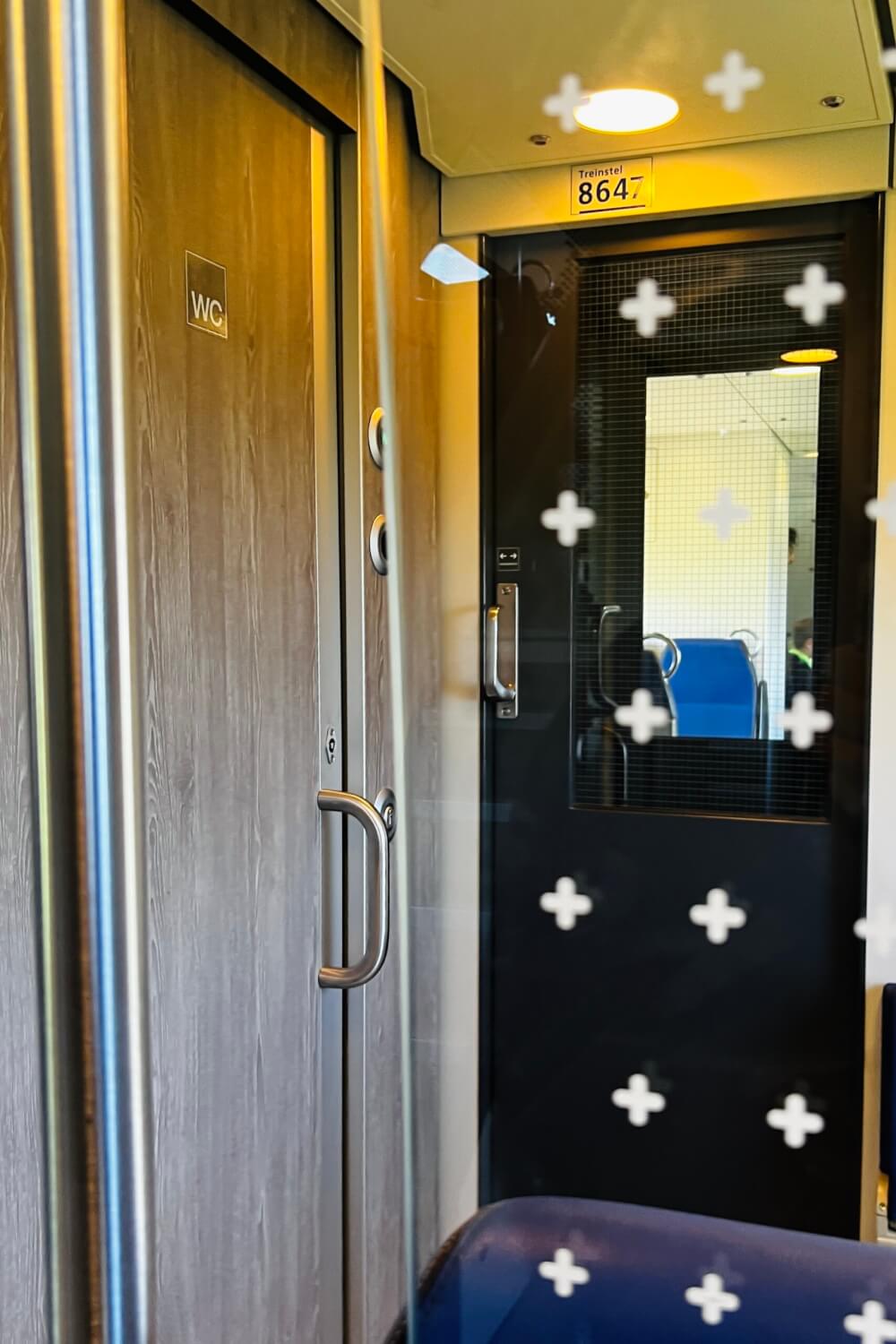
Lastly, while it’s important to get comfy, remember to keep your ticket handy in case controllers come on board.
This happens in pretty much every country although they vary in how frequently they do it.
Getting your tickets checked by a controller tends to happen more often in high speed or long distance trains than the regional ones, but regardless just make sure you have your ticket and also some ID (preferably your passport) on you.
Having ID is important because they’ll sometimes want to verify your name if it’s a reserved ticket, and your age/residency as well depending on whether or not you’ve purchased a discounted fare.
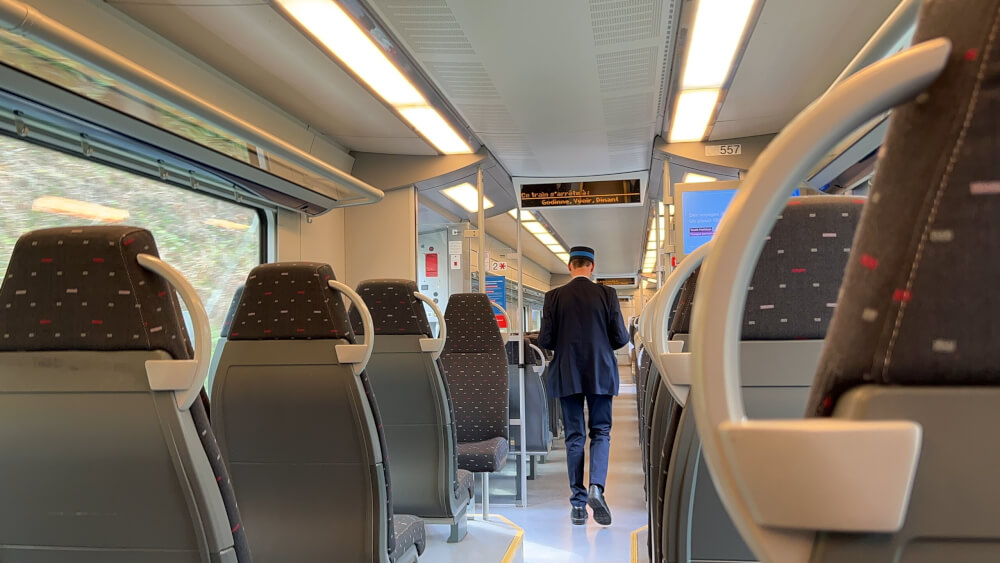
Now after your journey is complete, it’s onto…
Step Nine: Disembark
If you are not getting off at the end destination, then start prepping for disembarkation about 10 min before your arrival time. This gives you plenty of time to gather your belongings and bags in a rational, non-crazed manner.
To keep track of what time you’ll be arriving, keep an eye out for screens that show the scheduled arrival time/estimated arrival time.
Most modern trains will have these, but some older ones may not. In a pinch, you can always open up Google Maps to see where you are, so you can roughly estimate how much longer you have to go.
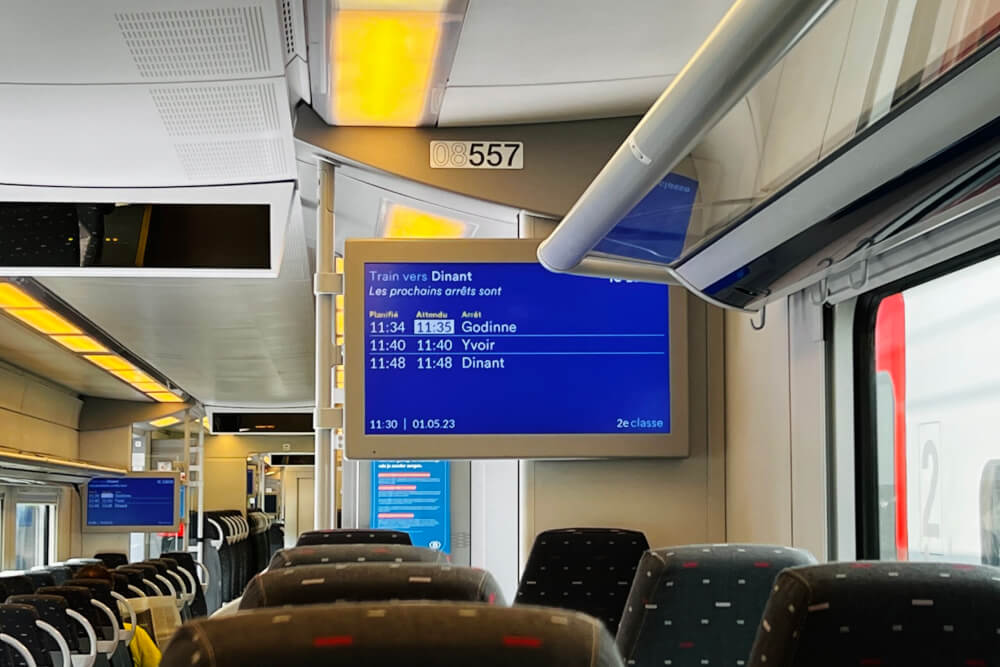
Upon arrival, if the door isn’t opening then again look for a button with the <> open symbol.
Once the doors are open, be careful getting off the train as there’s often a gap/step.
During this time, it’s important to keep hold of your ticket in case you need to scan it on the way out and be sure that you valuables are secure as train stations can often be a hot zone for pickpockets
To navigate your way off the platform and onwards to wherever you need to go, keep an eye out for signs like these that will point you in the right direction.
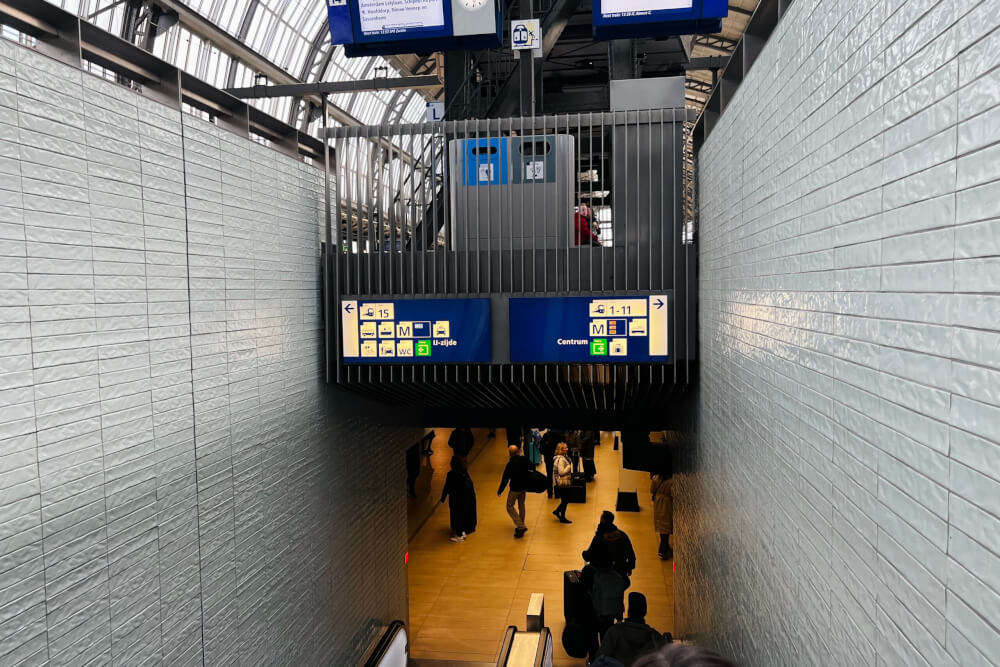
If you need a place to drop off your bags while you explore, most major train stations will have a paid left luggage area with lockers, or a drop off service.
This is a great option if you’re too early to check in to your accommodation, or just dropping in for the day.
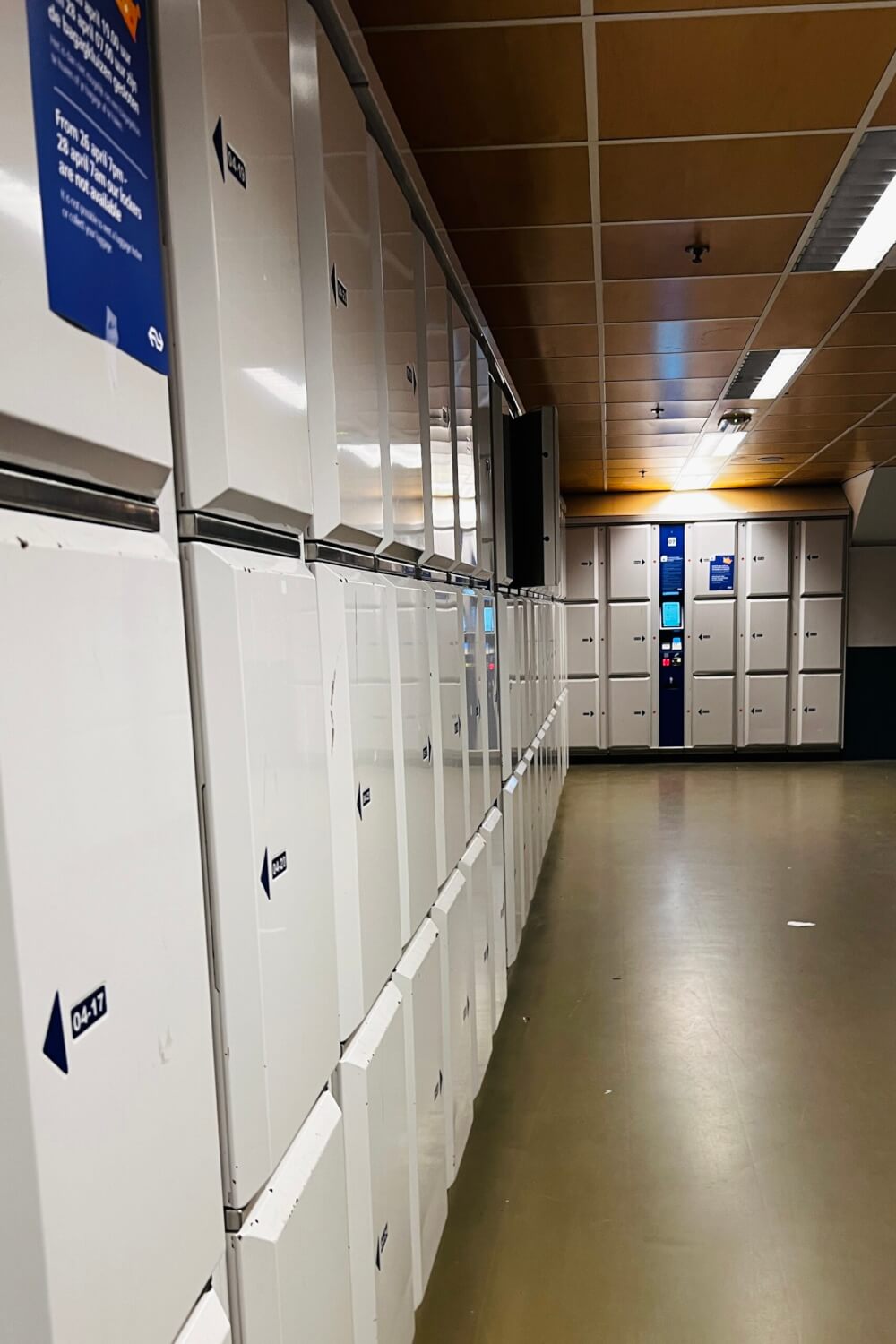
Lastly, remember that your train ticket is usually only valid for that specific train you boarded, so you unless you bought a special ticket or pass, you won’t be able to use it for onward travel on the metro or bus.
NOTE: If your train is delayed, then depending on the rail company, you may be eligible for compensation! Simply search up “your rail company + late train compensation” to see if there are any options that apply to you.
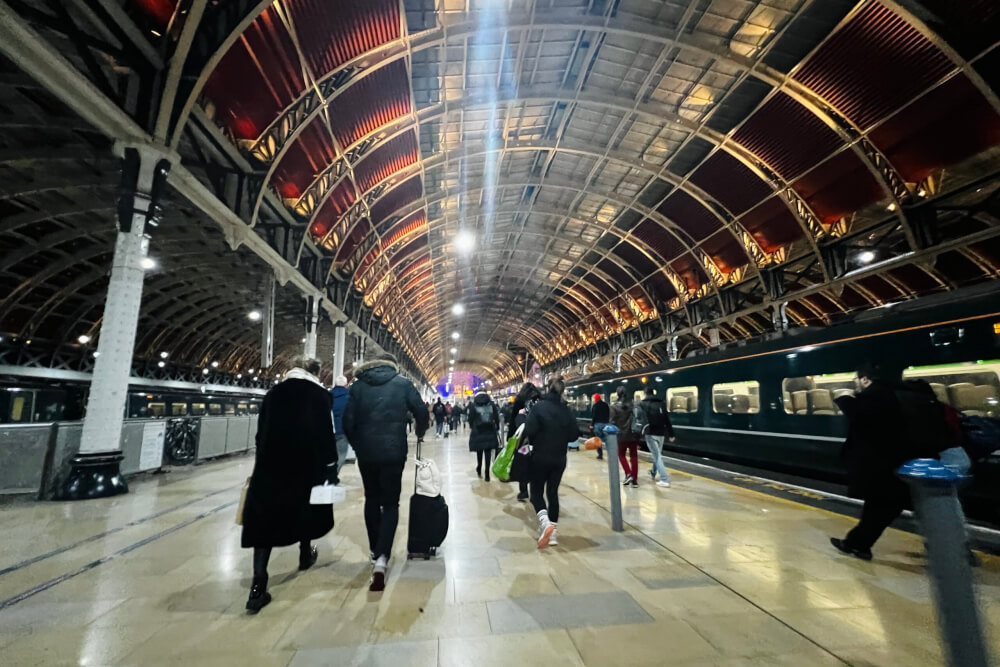
I Hope This Step by Step Guide on Taking Trains in Europe was Helpful!
Let me know in the comments if you have any more questions.
My Go-To Travel Favourites:
🧳 Eagle Creek: My favourite packing cubes
💳 Wise: For FREE travel friendly credit cards
🍯 Airalo: My go-to eSIM
🏨 Booking.com: For searching hotels
📷 Sony A7IV: My (amazing) camera
✈️ Google Flights : For finding flight deals
🌎 WorldNomads: For travel insurance
🎉 GetYourGuide: For booking activities
Leave a Comment Cancel reply
By using this form you agree with the storage and handling of your data by this website. *

A Comprehensive Guide to Train Travel in Europe
Train travel in Europe is the ultimate bucket list experience! Find out all you need to know about riding this continent’s extensive rails.
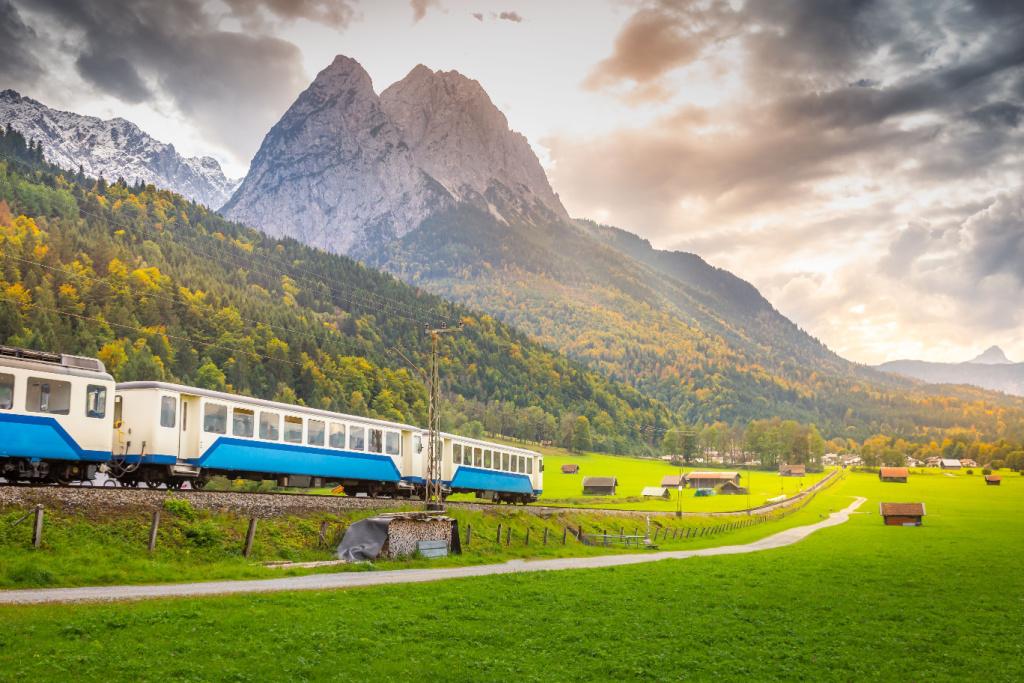
If you’re trying to explore any part of Europe without taking at least one train ride, good luck! It’s kind of part and parcel of the experience. Mastering train travel in Europe isn’t difficult. The rail system is vast, generally well-connected, and fairly easy to use, but there are a few tips you need to know before planning your itinerary. In this ultimate guide to European train travel, we’ll discuss why, when, and who should take the trains, which trains you should book, how to get tickets, the types of available train trips, and a few suggested routes. Get your pen and pad, or bookmark this blog—you’re going to want to keep these tips handy!
Exploring Europe With Let’s Roam
Train travel in Europe has never been easier than it is today. And with the vast rail system at your feet and Let’s Roam in your pocket, you can easily hop off the train, explore a city in an hour or two, and be back at the station in time for coffee before departure. Our app-guided scavenger hunts introduce you to Europe’s greatest cities at the touch of button. We’ve got bar crawls , sightseeing hunts , art walks , and ghost tours in cities all over the world. Just download the app, pick your city, purchase your tickets, and start exploring!
Train Travel in Europe
It should go without saying (but unfortunately does not) that Europe is a continent, not a country, and therefore, train travel across the region differs wildly depending on which nation we’re talking about. For instance, trains in Switzerland are pristinely clean, always on time, relatively quiet, and orderly. Trains in Southern Italy tend to be late, drastically overcrowded, loud, and… interesting.
Your train travel experience will also vary immensely depending on what type of train you’re booking. The intercity and commuter train experience is a totally different one than fastspeed, long-haul trains, for instance. Each train company also has differing standards and procedures. Bearing these facts in mind, we’ll be as specific as we can in this guide, but you’ll need to do some research on every train journey you book, making sure you look for a few specifics (which we’ll cover) so you know what you’re getting into. Here we go!
The Pros of Train Travel in Europe
1. savings on hotels.
One of the perks of train travel is that you can book your transitions overnight if they are long rides. Sleeper trains are generally less expensive than a European hotel room, and by traveling overnight, you don’t lose any of your precious sightseeing time! You can choose to go cheap and book a regular seat for your night train or pay extra for a sleeper cart with bunk beds. Bunk rooms usually have anywhere from 2 to 6 bunks and vary in price depending on the train company, length of journey, and level of privacy you choose. However, they are typically equivalent to a night in a nice hostel.
2. City Center Convenience
Unlike airports, central train stations are generally located in the middle of the city. If you’re on a tight schedule or are watching your budget, this is one of the primary perks of taking the train. While a flight may be faster and cheaper at first glance, sometimes the journey from the airport to the city center can take over an hour and can cost up to $80.
Some cities, like Athens, now have a city metro line that runs from the city center to the airport, which is cost and time-effective, but that isn’t always the case. When deciding between a flight and the train, always look at the cost and time that transferring from the airport to your hotel will add (both ways). Then, make the most efficient decision.
3. Easy Ticketing Process
Most train companies now offer online ticketing, and you can use an e-ticket from your mobile phone. Occasionally, you may need to stop in the ticket office before your departure and show them your QR code, and they will print you a paper ticket, but this is becoming less and less common. Many train routes have fixed prices (more on that later), so you can easily book your journey the day of without exorbitant rate hikes.
4. No Luggage Restrictions
Unlike buses and planes, trains generally do not have luggage restrictions or fees. If you’re willing to load and unload four suitcases and you can find space for them, you can take them. We still suggest that you travel light, as lugging a bunch of suitcases on and off trains isn’t exactly the epitome of fun.

5. Spontaneity
As noted above, most popular train routes in Europe have multiple options to choose from. Therefore, they are unlikely to sell out. Most long-distance trains do have variable prices, and they are cheaper to book ahead of time. Slower commuter trains between bigger cities have fixed rates, as they are used by locals, and you can typically book a ticket on the same day with no financial penalty.
This allows you to move freely between cities without being locked down to a particular schedule. There’s nothing worse than leaving a city you’re enjoying without seeing all you want to see. It’s even worse if the next city on your list is a disappointment. Having flexibility in your schedule allows you to spend more time in the places you love and move on from those you don’t care for as much.
6. Peaceful Journey (Mostly)
Trains offer a level of peace that the bus and plane do not. Long-distance trains through the European countryside offer a chance to enjoy the scenery, catch up on emails, write in your travel journal, listen to a podcast, etc. The ambiance of trains in Europe varies greatly by country and company, but in general, it’s a fairly peaceful journey.
7. No Security or Checks
There are no long lines to get on a train. There are no security or baggage scanners (except maybe a quick one to get in the station). You won’t be asked to take your shoes off or disrobe your jacket, jewelry, etc. The boarding process is swift and easy.
8. Increased Comfort
Train seats are usually larger and more comfortable than planes and buses. The walkways are wider. It’s easier to get up and walk around. The bathrooms are bigger, and there’s more storage for luggage. Sometimes, you even have your own table, charging station, and cup holders.
9. Seats With a View
Most European trains, especially sightseeing trains or long-haul tourist trains, have large windows for viewing the scenery. It’s a great way to experience the countryside and snap some photos as you roll along.
10. Eating How You Like
For the most part, you can bring any food or drink you want on the train. This does not apply to inner-city and metro rides—you shouldn’t eat or drink on those. But on longer trains, you’re more than welcome to bring a basket of food and a bottle of wine in most places.
11. A Plethora of Options
The European rail system is vast. If the train you wanted to take sells out, there is likely another option. If you want to add a stop in a city, you can easily do that, too. When you take the train, you can visit small towns that aren’t accessible when flying.
12. Youth Discounts
If you’re a student with a valid ID or a European citizen under the age of 26, you can qualify for reduced-priced tickets!
13. Pets Welcome
You may need to arrange it ahead of time and pay an extra fee (usually the price of a child’s ticket), but well-behaved pets are usually allowed on European trains.
14. No Extra Fees
Unlike the budget airlines that hop all over Europe, a train ticket is the price that’s stated. There’s no extra charge for choosing your seat, checking in at the station, or any other nonsense. The price is the price.
15. Reliable
Train travel in Europe comes with fewer delays than air travel. In most European countries, trains are on time and running efficiently. Some countries are far more efficient than others, but overall, the train system stays pretty consistent.
The Cons of Train Travel in Europe
The days of cheap train travel in Europe, especially Western Europe, are pretty much gone. While there are some good discounts, it’s rare for the train to cost much less than a flight. For long-distance, high-speed trains, it’s especially important to book your ticket early. This is the one case where you’ll want to book from home well in advance of your trip.
When considering the cost of a train ride versus a plane ticket, remember to figure in the cost of transit to and from the airport. Also, consider any luggage fees, booking fees, etc., that you’ll pay on the smaller European airlines.
2. Confusing Schedules
Train schedules can be quite confusing at first glance. Luckily, the major train companies all have apps now that simplify the process for visitors. Make sure you download the apps for whatever companies you’re traveling with. There are generally helpful workers in the ticket office or on the platforms who can help you find the right train. However, language barriers can be a problem, especially in smaller, more rural stations. Pay attention to signs, listen for announcements in English, and get there early so you have plenty of time to ensure you’re in the right place. There’s almost always a local or fellow traveler who can help reassure you. Don’t be afraid to ask! The train station is a great place to meet travel companions.
Switching Trains
Another confusing aspect about trains is that many of your routes will require you to change trains somewhere in the middle. That can really get hairy as you’ll need to pay attention during your journey and not miss your transition station.
Multiple Stations
The major European cities will have several train stations. Pay attention when booking your ticket, and ensure that you choose the correct station, both for your boarding and your departure. This is especially important if you’re taking a multi-train journey. Always double-check. The last thing you want to do is get off your train at your connection city and realize your next train leaves from a totally different station all the way across town.
3. Rail Strikes
Rail strikes are extremely common in Europe, especially France, Italy, and Greece. However, rail strikes are generally planned in advance and announced. If your train is going to be affected, you’ll receive a notification or email. You may have to go to the station or call a provided number to see if your specific train is affected, though. Pay attention when traveling in these countries, and have a backup plan in mind.
4. Decreased Accessibility
The nature of trains makes them more difficult for travelers with a physical disability. Many are not wheelchair accessible. Many have very large gaps and steep steps that you’ll need to maneuver. They can be crowded and have fast-paced boarding processes, which can be overwhelming or even physically impossible for disabled travelers.
5. Longer Travel Times
While the highspeed trains chug along at 140-170MPH, it’s nowhere close to the more than 500MPH you get when flying. When deciding between the two, you should consider the time it takes for security and check-in at the airport and weigh your choices. For instance, taking the regional train from Milan to Naples makes sense, as you can do it in 4.5 hours, probably less time than the whole flying process. However, the train from Paris to Budapest takes over 15 hours, while the flight is less than two. In the latter case, taking to the sky is much more time- and cost-efficient.
6. Location Limitations
While the European rail system is huge, it’s not consistent. If you’re traveling in Germany, no problem. However, if you’re taking a tour of Central Europe and the Balkans, you’re much more likely to take the bus than the train. While there are regional trains that connect big cities like Sofia, Bulgaria, and Bucharest, Romania, other popular routes have no train access.
Types of European Trains
We’ve hinted at a few of the common types of trains you may encounter on your travels through Europe, but now let’s dive into the details of what to expect with each category of choo-choo.
Overnight Train (Sleeper Trains)
Sleeper trains are not truly a separate category unto themselves. They are a type of car on a high-speed regional train. Sleeper trains are a great option for budget travelers who want to kill two birds with one stone. An overnight journey not only saves your precious sightseeing time, but it essentially gets you a free or reduced night’s accommodation.
To take advantage of this cost-saving, you’ll need to book early! Sleeper cars do sell out, and they don’t have a fixed price, so the longer you wait, the higher the price you’ll pay. Typically, you can pay per bed or book a private two-person bunk room.
Innercity Trains (Subway, Metro)
Inner city trains are one of the easiest ways to get around a big city. Most major European cities will have a variety of trains. For instance, London has the Underground (the Tube), the Overground, the DLR, both suburban and national rail services, and the London Tramlink. In most cities, you can use the same ticketing system or rail pass for all the commuter options within a certain zone of the city. Traveling further out or trips to the airport may cost extra. This varies by city, though, as some, like London, have a centralized transportation organization, and others are privatized and operated by separate companies.
Innercity trains usually have a kiosk in the subway station or at the rail hub. You can purchase a ticket up to seconds before the train arrives. There are generally no assigned seats, and they’re usually crowded. You will likely be standing often, and eating and drinking on the train is usually frowned upon. These trains move quickly, so get there on time, and be ready to load up fast. There are typically little to no luggage storage spaces. You may need to verify your ticket when boarding the train, and there will usually be a scanner in or around the entrance.
High-Speed Regional Trains
High-speed regional trains are the rails that you’ll use to get between major cities on your European vacation. You will typically book these tickets in advance, at least if you want the best price. You’ll usually have a seat reservation, as well. These usually have comfortable seating, Wi-Fi, and snack options.
Some high-speed trains do not have assigned seats, but you will be relegated to a certain class. Most of these trains have a 1st class option that gives you a bit more space and amenities. Pay attention to the number on the outside of your carriage, and make sure it corresponds to your ticket. Often, the carriages are numbered 1 or 2. If you have a regular ticket, get on a carriage labeled 2. At some point during the ride, an employee will come by to verify your ticket, so keep them handy. This could be ten minutes or ten hours into the journey.
Tourist Trains
Tourist trains are typically used for day trips to major attractions. This includes the Swiss Glacier Express and the Jacobite Steam Engine in Scotland. These trains are typically set up for viewing scenery, are round-trip, and are highly sought after. They are generally expensive compared to other public transit and tend to sell out.
Book these tickets in advance, and do some research about which side of the train you should sit on to get the best views.
Booking Your Tickets
When to book.
As discussed previously, when you book your ticket will depend highly on which type of train you’re taking. For most travelers coming from the United States, you’re going to be on a tight schedule, and you’ll likely have all your travel days set in stone before you leave home. If that is the case, as soon as you know the route you’d like to take, book your tickets. The earlier, the better.
If your schedule is more flexible, I suggest booking your longer regional tickets ahead of time. However, you can leave the smaller journeys unbooked. For instance, there are multiple trains from Florence to Pisa or Rome every day. The journey takes an hour or so, and you can play it by ear.
How to Book
Third-party booking.
For most travelers, booking online through a third party like Omio, Rail Europe, or Trainline is going to be the easiest for you. These companies work similarly to Kayak or Google Flights. They search a plethora of companies and give you the best prices and times available. They will also easily allow you to compare bus, train, and plane prices in most cases. These platforms are easier to use, as they are more organized and the schedules are presented in English.
Direct Company Booking
Once you find the train route you want, you can either book through the companies listed above, or you can redirect to the train company website and book with the train number you’ve found. Some websites are easier than others, and you may be able to save a few dollars by booking directly with the train company. Online is the best way to book regional and long-distance trains. Just follow the directions in your confirmation email. Some companies still require you to have a paper ticket printed at the train station before departure. Many companies still have stipulations in their email, but when you get to the station, they’ll tell you it’s not necessary, and you can use your e-ticket. But it’s better to ask than to get a nasty surprise at go-time!
With a Representative
Shorter trains can easily be booked at the train station via a kiosk or the ticket window. Don’t shirk this option, especially if you find a worker whom you can easily communicate with. Many of the smaller train companies don’t have websites, and they aren’t included in the searches done by Omio and others. By talking to an actual person, you can often score a much cheaper train ticket on a local train!
European Rail Passes
In this section, we’ll discuss the plethora of rail pass types and their pros and cons. In general, rail passes are meant to keep you from having to purchase multiple individual tickets. They usually come as a card that’s valid for a set number of days. They cover specific transit options in specific regions only. Depending on when and where you’re traveling, a pass may or may not be your best bet.
National and City Passes
Each nation or large city has a version of a rail pass. London has the Oyster Card. Paris has the Navigo that covers the city and surrounding region, and Deutschland has the German Rail Pass that covers transit within in country. The latter also covers the trip from Munich to Salzburg, Austria, and a few other international trips on the Deutsche Bahn to Venice, Innsbruck, and Brussels. The details of these passes are beyond the scope of this article, as each has very specific rules about which regions they cover, what forms of transit are included, etc. You will need to do some basic calculations to determine if a local pass is the right option for you (more on that in a minute).
Eurail Pass
The Eurail Pass (known as the Interrail Pass for Europeans) is a pass that covers both local and regional trains and high-speed international trains in 33 countries across Europe. Sounds great, right? Here’s the catch: The Eurail Pass is expensive, and it has strict limitations.
The most popular option is the 10-Day in 2-Month Pass, which sells for $351 PP. This option is valid for two months from the day you take your first trip. Within that two months, you have ten days of unlimited travel. If you take a ride of any kind, that counts as a day. Seat reservations on international and regional trains are not covered by the pass, so you must still go online and reserve your seat, which comes with an extra charge. Another con is that the Eurail system only sets aside a small number of train seats for pass holders, so they sell out fast. While Eurail can be useful, it is not always your best financial option.
Writer Note
I personally find that the Eurail Pass is rarely worth the price unless you’re booking all your train tickets 4-6 months in advance or more. If you’re not booking early, you’ll likely find that you paid a huge amount for a pass that has no tickets available for the routes you desire. I once paid $500 for my pass because I was taking the Eurostar from England to Paris, and it was worth it, as that particular ticket is very expensive. However, when I went to book my train five minutes later, there were no available Eurostar tickets for months. Unfortunately, there is no way to see if tickets are actually available before purchasing the pass.
Tourist City Passes
Another way to score a deal on European transit is with a tourist city pass. These passes are primarily used to get free entrance and discounts to tourist attractions. However, many of them include local public transit in the price. These passes are only worth their weight if you plan to see several attractions! For instance, the Rome City Pass comes in 1-, 2-, 3-, 4-, 5-, or 7-day options. It covers all tourist attractions in the city and public transit and offers discounts at restaurants and shopping facilities. It also allows you to skip those long ticket lines. If you plan to thoroughly explore a city, these passes are great options!
Determining if You Need a Pass
The best way to determine the value of a rail pass is to map out your major routes for the trip. Get on Omio to find the trains you want, and write down the prices. Then, compare your individual ticket prices to the price of the pass. Don’t forget that you may spend a few more dollars per day getting around the city itself on trams, buses, and metros, so add a few dollars for the days that you’re in a big city to your individual ticket total, then compare. Make sure you read the fine print on these passes. Most of them have stipulations, and sometimes, they are too restrictive to be useful.
Popular Train Lines
Here are a few train lines you may find useful!
- Most French public trains are operated by SNCF .
- In Italy, your primary options are Italo Treno, ItaliaRail, and Trenitalia.
- The Spanish train system is Renfe . It has beautiful and easy-to-use trains connecting most of Spain, including the new high-speed train from Madrid to Barcelona.
- The Deutsche Bahn is the German privatized national rail.
- There are as many train routes on the Nederlandse Spoorwegen in the Netherlands as there are bikes in Amsterdam.
Popular European Train Routes
Here are a few ten-day trips through Europe that are easy to organize and offer major bang for your buck!
1. Central Europe Capital Jaunt: Hungary to Slovenia
If you’re looking to get acquainted with the gems of Central Europe, you can’t beat this train journey from Budapest to Ljubljana, with stops in Bratislava and Vienna. You’ll cross the beautiful scenery of the Alps, visit epic castles and quaint wineries, and spend a few days in each capital city. Wander the architectural wonders of Budapest, and enjoy the luxurious Széchenyi Thermal Bath and quirky nightlife of the Ruin Bars. Tour the tiny capital of Slovakia and its historic Old Town. Explore the historic cafes and royal palaces of Vienna before ending your trip on the scenic route to Ljubljana. The pretty city lies on the Danube and is filled with charm. It’s also an easy day trip from lovely Bled, the country’s most stunning lakeside village.
2. Deep Dive Into Italy
If you want to limit your time on the train and dive into one country, we recommend a north-to-south trip through north-to-south Italy. Flying into Venice, you’ll enjoy the incredibly historic canals and grand bridges before moving on to Florence, the home of the famous Duomo and the most impressive collection of Renaissance art in the world (and the best steak and gelato on the planet). Take a day trip to Pisa to see the Field of Miracles, then head for a few days in Ancient Rome. Finish your trip with a train ride to Naples to explore the ruins of nearby Pompeii and Herculaneum, and take the ferry for a day on the Isle of Capri!
3. Czechia Republic and Germany
For this route, you’ll explore the funky Czech capital of Prague, enjoy the famous beer, explore some of the most beautiful architecture in Europe, and gorge yourself on roasted pork and dumplings. Then, move on to Nuremberg, reveling in the adorable Old Town Markets and cathedrals and visiting the iconic trail venue. Then, pop over to Munich; you’ll enjoy incredible beer gardens, stunning Old Town, fantastic markets, and easy day trips to Neuschwanstein Castle and the historic Dachau Concentration Camp.
A secondary option would be to turn north at Nuremberg and further explore Germany by visiting Frankfurt and Cologne.
Train Travel Tips for a Smooth Ride
To get the most out of your European rail adventure, you must do some proper planning. We’ve covered most of these tips already, but here’s a summation to make sure you get the best experience every time!
- Book your inter-city trains as early as possible. These have variable rates, and you’ll get the best seats and prices by booking well in advance.
- Use a third-party website like Omio or Rome2Rio to compare all your transit options. A train may be your best bet, but sometimes, a flight or a luxury bus is a better option!
- Read the fine print for any pass, and carefully calculate the cost of individual tickets before purchasing. Sometimes, they look amazing on the surface but don’t live up to the hype.
- For local transit, always stop by the station and talk to a person. They often know of better, more economical options than what you can find online.
- Always download the transit and train company apps. They offer notifications on strikes, have easy access to your tickets, and have more user-friendly train schedules. Aside from train companies, every major city has a transportation app. Google the options for your city, and get to know the apps before your trip!
- Get to the train station early so you can find your platform, print your ticket if necessary, and secure a good seat on the train.
- If you’re using mobile tickets, ensure that you have a way to keep your phone charged for the duration of the trip.
Pack Your Bags!
Hopefully, you found our ultimate guide to train travel in Europe helpful! Enjoying Europe by rail is a bucket list experience, so don’t stress too much. If you miss your train, there’s always another one close behind. Do your research, make your plan, and then sit back and enjoy the beauty of Europe from the rails!
For more epic train adventures, check out “ The Most Incredible Train Excursions in the World ” or “ How to Experience the World’s Best Luxury Train Rides .”
Frequently Asked Questions
While some stations have confusing train schedules, traveling Europe by train is easier than ever with handy third-party apps, increased English signage, and high-speed efficient trains.
The best train company depends on which nation you’re in, as each has its own national rails. Some travelers opt for the Eurail Pass , which covers 33 countries in Europe, including France and Ireland .
Traveling Europe by train is efficient and nostalgic. It’s not always the cheapest option, but there are no bag fees, it’s comfortable, and you get to enjoy stunning scenery along the way.
The cost of exploring Europe by train varies drastically depending on which cities you visit, when you book your tickets, and many other factors. However, a 10-day Eurail Pass sells for $351.
One of the best train trips in Europe is the adventure through Central Europe from Budapest to Ljubljana with stops in the Slovakian capital of Bratislava and the Austrian capital of Vienna .
Featured Products & Activities
- Search Please fill out this field.
- Manage Your Subscription
- Give a Gift Subscription
- Newsletters
- Sweepstakes
- Destinations
This Train Pass Is the Secret to City-hopping Through Europe on the Cheap (Video)
:max_bytes(150000):strip_icc():format(webp)/Skye-Sherman-author-pic-2000-d5983bed0cce41e1bafcdb645c665479.jpeg)
For many travelers, exploring Europe is a must — a rite of passage, even. And for travelers looking to plan the perfect Eurotrip, snagging a Eurail pass is vital.
Since its debut in 1959, Eurail has helped travelers squeeze the most out of their time abroad. The pass has long been a favorite among backpackers, study-abroad students, wandering nomads, and those with limited vacation days, but a strong desire to see the world. If you're out to cover a lot of ground in a short amount of time, or you just want some freedom from the hassle of travel planning, investing in a Eurail pass is a no-brainer.
Below, we've put together a complete guide to the Eurail pass, covering everything you need to know to use the pass and optimize your time in Europe.
Who Should Buy a Eurail Pass and Why
Eurail is a single rail pass that grants access to 40,000 destinations across 33 different countries in Europe. In other words, it's the most flexible and convenient way for visitors to explore the continent with ease. Unlike a traditional train ticket, a Eurail pass gives travelers the ability to utilize existing infrastructure — Europe's thousands of railways — to travel between destinations for a set amount of days.
If you're heading to Europe and planning on visiting more than one location — as in, multiple countries or even multiple cities within the same country — then you're going to want to equip your journey with a Eurail pass. The pass essentially provides all-inclusive access to Europe's well-connected train system, meaning you don't have to book tickets for each individual leg.
Eurail passes are available to anyone — college-age backpackers, couples, families, and travelers looking to make the most of their time in Europe on a budget — but special discounts are provided to certain age groups.
The catch? Eurail passes are not available to Europeans; they're solely for non-European residents. However, European citizens do have the option of purchasing an Interrail Pass, which is similar to a Eurail pass, but for Europeans only.
How to Buy and Use a Eurail Pass
Currently, Eurail offers two different pass types: the Global Pass and the One Country Pass. A Global Pass is essentially the all-inclusive option: It gives travelers the ability to take a train between any of Eurail's 33 participating countries. Meanwhile, the One Country Pass works only within a single country (there are 29 countries currently available on this pass).
Travelers select either a Flexi Pass, which includes a predetermined amount of train travel days (such as four travel days within one month), or a Continuous Pass, which includes unlimited train travel days during a predetermined trip length (such as 15 days or three months).
Eurail also groups certain regions, so that you can score multiple countries for the price of one. For example, the Benelux Pass includes Belgium, the Netherlands, and Luxembourg, while the Scandinavia Pass includes Denmark, Finland, Norway, and Sweden.
Once you've chosen the pass that best fits your needs, you can order it through Eurail's website . Eurail ships the physical pass booklet to you worldwide, including an address in Europe, if you're already there. It's best to order your pass at least four weeks before your trip to ensure it ships in time and you can secure any necessary reservations. However, you can plan as far as 11 months in advance. You can also purchase a pass at European train stations.
Before you can use the pass, you'll need to activate it. Validating the pass can be done online using Eurail's free pre-activation service at checkout, or at a European train station once you arrive. You must activate the pass within 11 months of its issue date.
Once your pass is validated, you're ready to go. Simply choose a train and then present your pass upon boarding. Make sure to fill out the required information in your pass booklet for each ride, as the conductor will come by to verify and stamp it.
Eurail's easy-to-navigate Rail Planner App lets you search train timetables, plan your route, and make reservations where needed. The My Trip section of the mobile app makes it simple to save your journey and see your route broken down as a day-by-day itinerary.
Note that some trains in Europe require a seat reservation. In these cases, railway carriers charge a reservation fee that is not included in the price of your Eurail pass. However, seat reservation prices are typically nominal (around $10 to $25, even for overnight trains).
Most reservations can be booked through Eurail's Self-Service option. Alternatively, you can book in person at the station, over the phone, online, or through the Rail Planner App.
Eurail Pass Cost and Discounts
In 2019, Eurail retired its two- to four-country Select Passes, focusing instead on the Global and One Country Passes. These changes enabled Eurail to roll out significantly discounted prices, add a second-class option on all adult Global Passes, and even introduce a Senior category, encouraging an older generation to travel as well.
The cost of a Eurail pass varies widely depending on the type of pass you purchase. For example, a Global Pass with five travel days in one month is usually between $319 and $425, while a 15-day unlimited pass falls between $501 and $667. A three-month unlimited pass usually costs between $1,019 and $1,358, and a One Country Pass for Italy is usually $144 to $271, while France is typically $87.
There are various age-group discounts available: Travelers aged 12 to 27 can purchase Youth tickets and receive a 25 percent discount (up from 23 percent in 2019), while seniors aged 60 or older receive a 10 percent discount. Children under 11 travel for free.
If you're not eligible for an age-based discount, keep an eye out for special promotions — Eurail regularly runs deals, especially for booking far in advance.
Where to Go With a Eurail Pass
Eurail's network includes 33 of the 44 countries in Europe, so your options are plentiful, and you can travel to a new country every day, if that's what strikes your fancy.
Plus, Eurail regularly adds new countries and routes to their portfolio — as of Jan. 1, 2020, Estonia and Latvia are the most recent additions. Popular destinations like France, Italy, Germany, Ireland, Switzerland, Spain, and Poland have long been included.
Eurail also recently added a Greek Islands Pass , which covers ferry trips between 53 Greek islands aboard partner carriers Superfast and Blue Star Ferries. The Greek Islands Pass is available for $102 (five trips within one month) or $199 (six trips within one month). The pass is also available at Eurail's discounted Youth rate of $77 or $175 for the five- and six-trip option, respectively.
Benefits of Having a Eurail Pass in Europe
The main perk of exploring Europe with a Eurail pass is the fact that it enables you to hit multiple stops with minimal hassle. For one affordable price, you can board trains across the continent and hop between destinations with ease, freeing you from the logistical nightmare of planning and arranging tickets for each individual leg of your journey.
A Eurail pass allows travelers to be as flexible or organized as they choose to be on a trip to Europe. During one short visit, you can check off bucket-list spots like Italy, France, Great Britain, Spain, Germany, and more. Or, you can explore just one country in-depth, without having to arrange tickets every time you want to head somewhere new.
Eurail also partners with hostels, tour operators, and restaurants across Europe, so there are some added pass benefits such as discounts at Generator Hostels, free or discounted ferry and bus trips, and cards that grant access to a city's top attractions.
To maximize your pass, figure out the optimal pass type for your needs and then fully explore the benefits that come with your purchase. You'll be posing in front of the Eiffel Tower and snacking on pizza in front of the Colosseum in no time.
Recommended Eurail Pass Routes
If you've never been to Europe, you'll likely want to use your Eurail pass to hit highlights like London, Paris, Rome, Barcelona, and Berlin, but don't pass up the opportunity to get off the beaten path a bit, too. With a Eurail pass, you're free to get creative.
If you've always wanted to visit Luxembourg and Lithuania, but have no interest in Spain or Portugal, that's not a problem: Depending on the pass type you purchase, your travel plans are entirely up to you. Just make sure to consult a map and plot a route that makes sense geographically.
Are you more into nature's wonders than mankind's? Book a Scandinavia Pass and wander through Denmark, Sweden, Norway, and Finland in pursuit of the northern lights. Or, experience the beauty of Switzerland, a favorite among families — Switzerland's Glacier Express from St. Moritz to Zermatt, included in a Eurail pass, traverses 91 tunnels, crosses the Oberalp Pass, and winds through the stunning Swiss Alps. The Golden Pass route, also included, skirts Lake Geneva and passes through some of the most picturesque mountain towns in Europe, including Gstaad and Interlaken.
Another idea is to add a theme to your itinerary: With the 2020 Tokyo Summer Olympics around the corner, why not take an Olympic tour of Europe? You can start at the site of the first-ever Winter Olympics in 1924 — Chamonix, France — and then head to Paris, home of the second-ever Summer Olympics in 1900. From there, hop to Antwerp, Belgium — home to the first Olympic games after the turmoil of World War I — and then take the high-speed Eurostar under the English Channel to London, England, the site of the 2012 Summer Olympics.
Exploring lesser-visited Eastern Europe is also made easier by Eurail. With 2020's inclusion of Estonia and Latvia, the pass now covers rail travel across all of the Baltic countries for the first time in its history. Plus, with the pass, you can take the ferry between Riga and Stockholm or Germany, or from Tallinn to Stockholm or Helsinki, all for up to 50 percent less than you'd pay for these same international ferry connections without the pass.
Related Articles
- Skip to main content
- Skip to secondary menu
- Skip to footer
ZigZagonEarth
Plan unforgettable road trips!
2 weeks in Europe Itinerary by Train – 4 detailed options (+ Tips)
Last updated on March 2, 2023 by Claire Robinson - this article contains affiliate links. If you purchase through them, I get a small commission ( more )
Planning a trip to Europe? Want to get a great snapshot in a limited time? In this article I share my top tips to plan your 2 weeks in Europe as well as 4 detailed Europe itineraries by train : Latin, Eastern, Western and Central. Discover some of the most beautiful treasures of the continent.

// In this article, no ads, no sponsored posts. Just some affiliate links. If you purchase through them, I get a commission at no extra cost to you ( Disclosure ).
Things to consider when planning 2 weeks in Europe
Want to discover as much as possible of Europe during your 2 week trip? Here are a few points to consider when planning your itinerary:
- SIZE OF EUROPE - the European continent is as big as the USA
- VARIETY OF CULTURES - In theory, if you were flying every evening or morning you could change countries everyday and still have a full day to explore. But Europe is full of different fascinating cultures. There is much to see everywhere. So I recommend selecting a portion of Europe and visit only a few countries, to better appreciate each place.
- SIMPLE TRAVEL - Traveling between large cities is relatively easy in Europe, but once you decide to reach smaller cities, it means more connections and modes of transportation. Considering you "only" have 2 weeks, I recommend sticking to major cities

Best way to travel Europe in 2 weeks - Europe by train
- BY TRAIN - easy access from cities, direct trains connect most major cities, plus you can see the landscapes changing, spot small villages and appreciate more of each country. CHOICE I RECOMMEND Book you train tickets with the SNCF Connect platform!
- BY CAR - If you want to cover several different countries, I don't recommend renting a car, because distances are significant and parking in major cities is a pain. Rent a car only if you want to do regions that are close to each other i.e. North of France, South of Belgium and Luxembourg My favorite platform for renting cars around the world is Discovercars .
- BY PLANE - between the time to get out of the city to the airport, being early and waiting for flight, the time to get luggage, time to get inside the next city... it may seems faster, but it is often not Plus train you can see landscapes changing, spot small villages
- BY COACH - For those with smaller budget, this is a good alternative to train. But you need to plan more time for transportation

2 weeks in Europe itinerary - My 4 proposals
Based on all that, I have created 4 possible 2 week Europe itineraries by Train for you to consider depending on your interests. Below is a map that shows you which parts of Europe are covered with those 4 suggestions:

OPTION 1 - LATIN EUROPE
- Barcelona (Spain) + Paris (France) + Venice (Italy) + Rome (Italy + Vatican)
- Go directly to itinerary
OPTION 2 - EASTERN EUROPE
- European Elegance
- Prague (Czech Republic) + Vienna (Austria) + Bratislava (Slovakia) + Budapest (Hungary)
OPTION 3 - WESTERN EUROPE
- London (UK) + Paris (France) + Brussels (Belgium) + Amsterdam (The Netherlands) + Berlin (Germany)
OPTION 4 - CENTRAL WEST EUROPE
- Especially good at Christmas, away from the capital cities
- Luxembourg + Strasbourg (France) + Munich (Germany) + Salzburg (Austria)
Don't make the same mistake I did!

During one of my last trips, I used an open hotel wifi and got my credit card details stolen. So, my travels started with a phone call telling me I could not use my card anymore! What a mess...
Learn from my mistake, make a small investment for worry-free surfing. Get a VPN tool to turn on once you are outside your home!
LATIN EUROPE
LATIN EUROPE trip Itinerary 2 weeks
Trip overview.

Day 1 to 3 - BARCELONA (Spain)
Highlights / Classics
- Visit the magnificent Sagrada Familia - it is massive with a unique style. Considered the absolute must-see in Barcelona
- Admire the architectural work of Gaudi with his emphasis on natural curves and patterns, creating the catalan modernism movement
- Enjoy the light and music show at the Magic Fountain
- Go to the top of the Tibidabo Mountain to admire Barcelona from above
- Visit the Joan Miro Foundation to discover some of the artist's most iconic work

Where to Stay
Below are some suggestions of places to stay in Barcelona on your 2 weeks in Europe itinerary:
- Best areas to stay in Barcelona - Old town (El Born), Barceloneta Las Ramblas and Placa Catalunya
- LUXURY - El palace Hotel in the old town, modern decor in old charm with a fantastic location - Check out photos and latest prices
- MY FAVORITE - Duquesa Suites Barcelona, great light and views, fantastic terrace - Check out photos and latest prices
- VALUE FOR MONEY - Room Mate Pau has amazing design, friendly staff and a great location - Check out photos and latest prices
- HOSTEL - Hostel one Ramblas: clean, good atmosphere, free diner and a roof top terrace - Check out photos and latest prices
- Or Find your ideal accommodation within the best customer-rated accommodations in Barcelona
Food Suggestions
- Try as many tapas as possible. I love this way of eating, to be able to enjoy so many flavors!!!
- Tortilla, the traditional Spanish Omelette
- Paella - a good fresh paella cooked in a giant dish Miam!!!
- And for desert, the Catalan Creme with its cinnamon custard

Barcelona Like a local
- Enjoy a Sunday picnic at Parc de la Ciutadella to enjoy a little bit of greenery, especially on hot summer days
- Watch sunset at Bunkers del Carmel
- Chill at the Mar Bella Beach
- Go for a run at Parc Natural de Collserola
- Explore the specialty shops in the Gracia district
Useful words in Catalan
- Good morning : Bon Dia
- Hello - Hola
- Thank you - Merci (similar to French with with emphasis on e)
- Please - Por Favor
- Currency - Euros
- Plug - 2 rounds
- Emergency - 112
Activity ideas
Check out some of the best rated activities :
Day 4 - TRAIN Barcelona to Paris
- Path - Barcelona Sants to Paris Gare de Lyon station
- Time on train - 6h30
- Type of train - Choose the "directs" with High speed trains
- Suggested time - Morning departure for arrival mid afternoon or beginning of afternoon departure for arrival in the evening
- Check availability and Book you train tickets with the SNCF Connect platform! Book your seat and Purchase Train Ticket
Day 5 to 8 - PARIS (France)
- Admire the iconic Eiffel tower and its impressive structure
- Visit the Notre Dame Cathedral and travel back in time
- Visit the underground world at the Catacombs
- Admire the stained glass windows at Sainte-Chapelle
- Get up to the Sacré-Coeur to look over Paris
- Watch a show at one of the cabarets
- Enjoy an evening cruise on the River Seine to see the lights of Paris
- Feel royal at the Versailles Castle
- You can check out my article about spending 3 days in Paris

Below are some suggestions of places to stay in Paris on your 2 weeks in Europe itinerary:
- Best areas to stay in Paris - The Marais, near the Pantheon, the 6th arrondissement, Ile Saint Louis... Check out my complete article on where to to stay in Paris
- LEGENDARY - Le Meurice is a palace in the 1st with great views of Paris (some rooms see the Eiffel Tower), a perfect location and a renowned restaurant - Check out photos and latest prices
- LUXURY - Le Narcisse Blanc & Spa in the 7th, classic Parisian chic and great facilities - Check out photos and latest prices
- MY FAVORITE - Hotel La Lanterne in the 5th - love the style and the swimming pool area! - Check out photos and latest prices
- VALUE FOR MONEY - Hotel du Vieux Saule is in the heart of the Marais, yet has quiet rooms - Clean and practical for a good price - Check out photos and latest prices
- HOSTEL - Generator Paris in the 10th, close to Metro station Colonel Fabien (Line 2) - Check out photos and latest prices
- Or Find your ideal accommodation within the best customer-rated accommodations in Paris
Since I am French, I could list pages and pages of great food to try. So delicious! But I have to limit myself here...
- For breakfast croissant and pain au chocolat or some fresh baguette from the bakery
- Cheese, cheese and cheese 🙂 we even have restaurants that only serve cheese dishes. LOL
- Find a great bakery to try delicious cakes. The good ones melt and crisp in your mouth and are very light
- And while you are there, taste the Macarons. They exist with many flavors and will make you gasp.
- Enjoy the wine too

Experience Paris like a local
- Relax along Canal Saint-Martin, especially in the evening in Summer
- Sit at a terrace, drink coffee and do people watching
- Enjoy a weekend picnic in Parc des Buttes Chaumont (with baguettes and wine!)
- Just go for a walk, take side streets and see where they lead you
Useful words in French
- Good morning : Bonjour
- Hello - Salut
- Thank you - Merci
- Please - S'il vous plait
Check out the best tours and activities in Paris
Overnight Day 8 to Day 9 - Travel to Venice
- Path - Paris Gare de Lyon to Venecia Santa Luzia
- Time on train - 14 hours 25 minutes
- Type of train - Thello Night Train to get a train without connection
- Suggested time - 7:10pm departure
- Check availability and Book you train tickets with the SNCF Connect platform! Book your seat and Purchase train ticket
Day 9 and 10 - VENICE (Italy)
- Marvel at Saint Mark's Basilica
- Enjoy a Gondola ride on the canals
- Get up the Campanile di San Marco
- For more ideas about things to do in Venice, check out this guide by Suitcase and Wanderlust

Below are some suggestions of places to stay in Venice on your 2 weeks in Europe itinerary:
- LUXURY - Hotel Londra Palace: fantastic location and some great views - Check out photos and latest prices
- MY FAVORITE - Hotel l'Orologio because it is modern, instead of going with heavy traditional decors, to avoid overload during your visit - Check out photos and latest prices
- VALUE FOR MONEY - Alla Vite Dorata: welcoming, good location but calm, small option at great price - Check out photos and latest prices
- HOSTEL - Located within a historic monastery, We_Crociferi has a great ambience, romantic and modern - Check out photos and latest prices
- Or Find your ideal accommodation within the best customer-rated accommodations in Venice
- Baicoli, historical biscuits that could last long for sailors on ships
- Sarde in saor - a sweet and sour dish with fried sardine fillets
- Fritole during the carnival period, a sweet fried pastry
- The many delicious risottos with seafood
Useful words in Italian
- Good morning - BuonGiorno
- Hello - Ciao
- Thank you - Grazie
- Please - Per favore
Check out the best tours and activities in Venice
Day 11 Venice + Travel to Rome
- Path - Venezia S Lucia to Roma Termini (the most central of the 2 stations)
- Time on train - 3h45
- Type of train - Regional Train
- Suggested time - Morning or afternoon depending on if you want to see more of Venice or Rome
- Check availability and Book you train tickets with the SNCF Connect platform! Purchase Train Ticket and Book your seat
Day 12 to 14 - ROME (Italy)
- Imagine ancient games at the Colosseum
- Imagine how life was as you explore the Roman forum
- Make a wish at the Trevi Fountain
- Admire the many historical buildings, especially the pantheon
- Visit another country: the Vatican

Below are some suggestions of places to stay in Rome on your 2 weeks in Europe itinerary:
- Best areas to stay in Rome - around the Pantheon, Around Trevi in the northern part of the historic center or in the South near the Colosseum
- LUXURY - Hassler Roma where some of the rooms have exceptional views - Check out photos and latest prices
- MY FAVORITE - The Inn at the Roman Forum: small hotel, great rooms, charm, luxury and history - Check out photos and latest prices
- VALUE FOR MONEY - Hotel Condotti with great location, nice staff and good soundproofing - Check out photos and latest prices
- HOSTEL - Generator Rome with well designed clean rooms - Check out photos and latest prices
- Or Find your ideal accommodation within the best customer-rated accommodations in Rome
- The essentials - Pizza, Pasta and ice cream
- Suppli - fried rice ball

Experience Rome like a local
- Relax in the park of Villa Borghese
- Speak with your hands
- Watch sunset from the Giancolo
- Take a cooking class
Check out the best tours and activities in Rome
Is the railpass worth it?
This itinerary enters inside a Eurail Select Pass 3 countries (5 days of travel within 2 months) - see the railpass options and click on "Pass" tab
According to my calculations, the total of separate tickets is cheaper than the pass for adults. However if you are traveling with families, it could be interesting. And if you plan on taking side trips from the cities, it could be as well.
I don't drink coffee
But I like other drinks and foods! Do you enjoy the free content you find on my blog? All my tips and practical information, without intrusive advertising...

EASTERN EUROPE
EASTERN EUROPE Itinerary in 2 weeks

Day 1 to 3 - PRAGUE (Czek Republic)
- Watch time pass at the astronomical tower
- Visit the castle
- Feel dizzy looking at the dancing house
- Wander in the old town
- Admire the lights at night

Below are some suggestions of places to stay in Prague on your Europe 2 week trip:
- ROYAL - The Grand Mark Prague inside a palace - Check out photos and latest prices
- LUXURY - Augustine With spacious rooms, interior garden and beautiful architecture - Check out photos and latest prices
- MY FAVORITE traditional - Hotel Pod Vezi close to the Charles Bridge with large elegant rooms - Check out photos and latest prices
- MY FAVORITE modern - MeetMe23 and its fun unique decor! - Check out photos and latest prices
- VALUE FOR MONEY - Josephine Old Town Hotel: fantastic location and spacious rooms for the price - Check out photos and latest prices
- HOSTEL - Post Hostel Prague with great organization and ambience - Check out photos and latest prices
- Or Find your ideal accommodation within the best customer-rated accommodations in Prague
- For those not afraid of raw meat, the Beef steak tartare
- Kulajda, the traditional soup
- Wiener sausages
- Dishes with lots of sauce
Useful words in Czech
- Good morning - Dobré ráno
- Hello - Ahoj
- Thank you - Děkuji
- Please - Prosím
- Currency - Czek Koruna
Check out the best tours and activities in Prague
Day 4 morning - TRAIN Prague to Vienna
- Path - Praha Hlavni NADR to Wien HBF
- Time on train - 4h
- Type of train - Railjet
- Suggested time - Morning ride to start visiting Vienna in the afternoon
Day 4 afternoon to 7 - VIENNA (Austria)
- Feel royal while visiting the Hofburg or the Schönbrunn Palace or the Belvedere Palace
- Visit the historical center of Vienna around St Stephen's Cathedral
- Admire the equestrian arts at the Spanish riding school
- Feel small in front of Vienna's city hall

Below are some suggestions of places to stay in Vienna on your Europe trip:
- Best areas to stay in Vienna - old town (Innere Stadt), on the island Leopoldstadt and Landstrasse
- LUXURY - Hotel Sans Souci Wien is a palace with beautiful decor mix of old and new - Check out photos and latest prices
- MY FAVORITE - Hotel Am Parkring because I love open views - Check out photos and latest prices
- VALUE FOR MONEY - Motel one Wien-Staatsoper with great location, decor and breakfast - Check out photos and latest prices
- HOSTEL - Vienna Hostel Ruthersteiner with great quality accommodation for a good price - Check out photos and latest prices
- Or Find your ideal accommodations within the best customer-rated accommodations in Vienna
- Wiener schnitzel (thin breaded pan fried veal cutlet)
- Sweet apfelstrudel
- Classic Wiener Sausage
- The shredded pancake called Kaiserschmarrn
- Sachertorte (rich chocolate sponge cake)
Useful words in German (Autrian)
- Good morning - Guten Morgen or Guten Tag
- Hello - Hallo
- Thank you - Danke
- Please - Bitte
- Currency - Euro
Check out the best tours and activities in Vienna
Day 8 - TRAIN Vienna to Bratislava
- Path - Wien HBF to Brastislava Hl. St.
- Time on train - 1h
- Suggested time - Depending if you want more time to spend in one of the cities
Day 8 afternoon to 10 - BRATISLAVA (Slovakia)
- Wander in the old town around Michael's gate - pay attention to the colors and details in the facades
- Visit the Bratislava Castle and the Grassalkovich Palace
- Hunt the Bronze statues throughout the city

Below are some suggestions of places to stay in Vienna on your 2-week trip around Europe:
- LUXURY - Arcadia hotel with great traditional decor and a fantastic spa - Check out photos and latest prices
- MY FAVORITE - LOFT Hotel Bratislava with beautiful common areas and spacious rooms - Check out photos and latest prices
- VALUE FOR MONEY - Aplend City hotel Perugia: comfortable, good location, delicious breakfast - Check out photos and latest prices
- HOSTEL - Wild Elephants Hostel is perfectly located - Check out photos and latest prices
- Or Find your ideal accommodation within the best customer-rated accommodations in Bratislava
- Halusky the traditional Slovakian meal (potato dumplings in creamy sauce)
- The Pressburg cuisine : spicy Hungarian stew
Useful words in Slovak
- Thank you - Ďakujem
- Please - prosím
Check out the best tours and activities in Bratislava
Day 11 - TRAIN Bratislava to Budapest
- Path - Bratislava HL S. to Budapest Nyuga PU
- Time on train - 2h26
- Type of train - Cross-border regional train - Eurocity
Day 12 to 14 - BUDAPEST (Hungary)
- Stroll along the Danube and admire the buildings
- Explore Castle Hill and visit the Buda Castle
- Marvel at the architectural details of the Parliament buildings
- Climb to the dome of St Stephen's Basilica
- Visit the Fisherman's Bastion and its amazing architecture
- Marvel at Matthias Church of our Lady and learn about its long history
- Learn more about the war and go underground in the Hospital bunker

Below are some suggestions of places to stay in Budapest on your 2 week trip around Europe:
- LUXURY - Boscolo Budapest: amazing common areas and pools, spacious rooms, beautiful architecture - Check out photos and latest prices
- MY FAVORITE - Hotel Moments Budapest with intriguing interior design - Check out photos and latest prices
- VALUE FOR MONEY - BP design Hotel and Apartman with a perfect location in the old town - Check out photos and latest prices
- HOSTEL - Flow hostel, with bright decor and space - Check out photos and latest prices
- Or Find your ideal accommodation within the best customer-rated accommodations in Budapest
- Goulash (Fulyas), the traditional dish in Hungaria
- Stuffed paprikas
- Many soups such as the Jokai Bean Soup (vinegar, sour cream, pork, carrots, beans...) or Lesco (red peppers, tomatoes, onions, lard, paprika)
Useful words in Hungarian
- Good morning - Jó reggelt
- Hello - Helló
- Thank you - Köszönöm
- Please - Kérem
- Currency - Hungarian Forint
Check out the best tours and activities in Budapest
This itinerary enters inside a Eurail Select Pass 4 countries (you can reduce its price by choosing the right option for how many days of travel within how many months) - see the railpass options and click on "Pass" tab
According to my calculations, the total of separate tickets is cheaper than the pass for adults. However if you are traveling with families, it could be interesting. And price may change if some of you travel on weekends.
WESTERN EUROPE
WESTERN EUROPE Trip Itinerary 2 weeks

Day 1 to 4 - LONDON (United Kingdom)
- Watch the changing of the guard at Buckingham Palace
- Admire the crown jewels at the Tower of London
- Visit the many free museums
- Marvel at Big Ben and the parliament
- Feel royal at Westminster Abbey Have a stroll in Hyde Park
- Get a bird eye view of London from the London Eye

Below are some suggestions of places to stay in London on your 2 week trip in Western Europe:
- Best areas to stay in London - The West end with Soho, Covent Garden, Leicester square, Oxford street... or Kensington on the Piccadilly line
- LUXURY - Rosewood London with elegant design and grandiose architecture - Check out photos and latest prices
- LUXURY Boutique - The Mandrake Hotel has lots of personnality - Check out photos and latest prices
- MY FAVORITE - Apex Temple Court Hotel wiht amazing views from some of the rooms - Check out photos and latest prices
- MY FAVORITE Funky - Mondrian London by the Tamise river has a unique design. Have a look! - Check out photos and latest prices
- VALUE FOR MONEY - CitizenM London Bankside with beautiful design - Check out photos and latest prices
- HOSTEL - Astor Hyde park Hostel in a beautiful Victorian building - Check out photos and latest prices
- Or Find your ideal accommodations within the best customer-rated accommodations in London
- Fish and chips late at night
- A good traditional roast
- Pie and mashed potatoes with gravy
- And, of course, the full English breakfast
- Afternoon tea
Useful words in London
I think you can manage with English LOL
- Currency - British pound
- Plug - 3 rectangles (type G)
Check out the best tours and activities in London
Day 4 - TRAIN London to Paris
- Path - London St-Pancras to Paris Nord
- Time on train - 2h25
- Type of train - Eurostar under the sea
- Suggested time - Your choice, depending if you want an extra half day in Paris or in London
Day 5 to 7 - Paris (France)
- Enjoy and evening cruise on the Seine River to see the lights of Paris
- Or Find your ideal accommodations within the best customer-rated accommodations in Paris
- Find a great bakery to try delicious cake. The good ones melt and crisp in your mouth and are very light
Visit Paris like a local on your 2 week in Europe itinerary
- Just go for a walk, take side streets and see where it leads you
Day 8 Morning - TRAIN Paris to Brussels
- Path - Paris Nord to Bruxelles Midi
- Time on train - 1h22
- Type of train - Thalys high speed train
- Suggested time - Morning to have the afternoon in Brussels
- Check availability and Book you train tickets with the SNCF Connect platform!
Day 8 afternoon and 9 - BRUSSELS (Belgium)
- Stand in the middle of the Grand Place (Grote Markt)
- Laugh at how small the Mannekin Pis is
- Feel small in front of the Cathedral
- Admire the buildings around the Place Royale (Koningsplein)

Below are some suggestions of places to stay in Brussels on your 2 week trip in Western Europe:
- LUXURY - Rocco Forte Hotel Amigo with comfortable rooms and welcoming staff - Check out photos and latest prices
- MY FAVORITE - Aloft Brussels Schuman EU hotel for its funky style - Check out photos and latest prices
- VALUE FOR MONEY - Hotel Made in Louise with clean bright decor and not far from all attractions - Check out photos and latest prices
- HOSTEL - 2GO4 Quality Hostel Brussels grand place has a fantastic location - Check out photos and latest prices
- Or Find your ideal accommodation within the best customer-rated accommodations in Brussels
- A delicious freshly cooked waffel
- Mussels and french fries
- Meatballs, often a mixture of 2 meats
- Flemish stew (Carbonnade à la flamande)
- Grey shrimps, traditionally fished along the coast
Useful words
Belgium has 3 official languages. As you don't know which one the person in front of you speaks, better to use English...
Check out the best tours and activities in Brussels
Day 10 Morning - TRAIN Brussels to Amsterdam
- Path - Bruxelles Midi to Amsterdam Zuid WT
- Time on train - 1h50
- Type of train - Take the Thalys to have a no change train
Day 10 afternoon and 11 - AMSTERDAM (The Netherlands)
- Stroll the city center and appreciate the its unique style
- Get flooded by art at the Rijksmuseum and the Van Gogh Museum
- Travel back in history at the Anne Frank Museum
- Visit the Royal palace

- LUXURY - Waldorf Astoria: a breath of fresh air - Check out photos and latest prices
- EXTRAVAGANT LUXURY - Hotel Twenty Seven: for a stay you will never forget - Check out photos and latest prices
- MY FAVORITE - Hotel IX Nine Streets: what I imagine when I think of Amsterdam - Check out photos and latest prices
- DIFFERENT - HotelBoat Fiep, sleep on a boat! - Check out photos and latest prices
- HOSTEL - Generator Amsterdam right by a huge park - Check out photos and latest prices
- Or Find your ideal accommodations within the best customer-rated accommodations in Amsterdam
- Bitterballe, deep fried meatballs
- Stroopwafel: 2 small thin waffles stuck together with syrup
- Dutch fries with crazy condiments mixture
- Oliebollen, deep fried sweet dumplings
- The traditional ginger Cake: Ontbijtkoek
Useful words in Dutch
- Good morning - Goedemorgen
- Thank you - Dank je
- Please - alsjeblieft
Check out the best tours and activities in Amsterdam
Day 12 - TRAIN Amsterdam to Berlin
- Path - Amsterdam Centraal to Berlin HBF
- Time on train - 6h22 direct or 6h07 with one connection
- Type of train - Intercity / Regional trains
Day 12 to 14 - BERLIN (Germany)
- Feel peace in front of the Brandenburg Gate
- Climb in circles to the top of the Parliament dome (book in advance)
- Remember history at the Berlin wall
- Forget the city when wandering through the Tiergarten
- Visit the many museums

Below are some suggestions of places to stay in Berlin on your 2 week trip in Western Europe:
- Best areas to stay in Berlin - Spandauer Vorstadt in the downtown area or Prenzlauer berg for a less touristy option
- LUXURY - Rocco Forte Hotel de Rome: what a pool!!! - Check out photos and latest prices
- MY FAVORITE - 25hours Hotel Bikini Berlin: fun and with a fantastic view over the trees of the zoos - Check out photos and latest prices
- VALUE FOR MONEY - Hotel Q! Berlin elegant modern decor et près des transports - Check out photos and latest prices
- HOSTEL - The Circus Hostels in the city center - Check out photos and latest prices
- Or Find your ideal accommodation within the best customer-rated accommodations in Berlin
- Pretzels - I love them!
- Kartoffelpuffer - grated potatoes, flour, eggs and onions
- Currywurst - pork sausage with curry powder
- Apfelstrudel for dessert
- Berliner Pfannkuche (similar to a doughnut)
Useful words in German
Check out the best tours and activities in Berlin
Is a pass worth it?
You would need the Eurail Global Pass to cover 5 countries (you can reduce price by choosing the right option for how many days of travel within how many months) - see the railpass options and click on "Pass" tab
According to my calculations, there is a chance that the pass can be cheaper than the individual tickets depending on the days of your travels. To be calculated.
CENTRAL WEST EUROPE
CENTRAL WEST EUROPE Itinerary 2 weeks

Day 1 to 3 - LUXEMBOURG
- Stroll through the old town and admire the views from Chemin de la Corniche
- Visit the underground tunnels (under the Bock Castle)
- Explore the Palace of the Grand Duke

- LUXURY - Le Place d'Armes: perfect location, charming decor, space - Check out photos and latest prices
- VALUE FOR MONEY - Grand Hotel Cravat, lots of space for price - Check out photos and latest prices
- HOSTEL - Youth Hostel Luxembourg city only 10 min from one of the main squares - Check out photos and latest prices
- Or Find your ideal accommodation within the best customer-rated accommodations in Luxembourg
- Bouneschlupp - thick soup with green beans, potatoes and bacon
- Friture de la Moselle - fried freshwater fish from La Moselle region
- Gromperekichelcher - mixture of grated potatoes, chopped onions, parsley, egg, flour
- Stews during game season
Useful words in Luxembourgish
- Good morning - Gudde Moien
- Thank you - Merci
- Please - Wann ech glift
Check out the best tours and activities in Luxembourg
Day 4 morning - TRAIN Luxembourg to Strasbourg
- Path - Luxembourg LUX to Strasbourg via Metz or Lorraine TGV stations
- Time on train - 4h (one connection)
- Type of train - Regional Trains
- Suggested time - morning
Day 4 afternoon to 6 - STRASBOURG (France)
- Take the time to admire the facade of the cathedral before entering
- Stroll through la Petite France, the old neighborhood and its typical houses
- Enjoy a boat ride through this area for different perspectives

- LUXURY - Hotel Régent Petite France in the heart of the old town - Check out photos and latest prices
- MY FAVORITE - Hotel Graffalgar with unique decors made by artists in each room. I visited several of them and they are fun! - Check out photos and latest prices
- VALUE FOR MONEY - Le Kleber Hotel, very central - Check out photos and latest prices
- Or Find your ideal accommodation within the best customer-rated accommodations in Strasbourg
- Pretzels - I love them! Twisted bread with salt
- Flammenkuche (tarte flambée) - thin base with cream, onions and various toppings
- Sausages and Sauerkraut (pickled cabbage)
- Riesling wine (white)
- Good morning - Bonjour
Check out the best tours and activities in Strasbourg
Day 7 - TRAIN Strasbourg to Munich
- Path - Strasbourg to Muenchen Pasing (via Stuttgart or Mannheim)
- Time on train - 3h30 to 5hours (1 connection)
- Type of train - High speed trains (TGV - ICE)
Day 8 to 10 - MUNICH (Germany)
- Explore the museums and buildings of the Residenz
- Enjoy the modern and historical vibe of Munich at Marienplatz
- Be surprised by the architecture of the Cathedral Frauenkirche
- Breathe in the English Garden (and maybe spot some people surfing on a small river)
- Feel Royal at the Nymphenberg Palace
- Take an excursion to the famous Neuschwanstein Palace

- LUXURY - Rocco Forte The Charles: stunning decor and a great pool - Check out photos and latest prices
- MY FAVORITE - Hotel Schlicker for the history - Check out photos and latest prices
- VALUE FOR MONEY - Hotel Bayer's with good location and spacious rooms for price - Check out photos and latest prices
- HOSTEL - CVJM Jugendhotel Munchen - Check out photos and latest prices
- Or Find your ideal accommodation within the best customer-rated accommodations in Munich
- Sausages, Schnitzel and Pretzels
- Sauerkraut (pickled cabbage)
- Apfelstrudel
Check out the best tours and activities in Munich
Day 11 morning - TRAIN Munich to Salzburg
- Path - Muenchen HBF to Salzburg HBF
- Time on train - 2h
- Suggested time - Morning
Day 11 afternoon to 14 - SALZBURG (Austria)
- Admire the architectural masterpieces from a river cruise
- Visit the Fortress
- Stroll the narrow streets of the old town
- Have fun at the toy museum

- LUXURY - Hotel Sacher Salzburg, royal feel and royal views - Check out photos and latest prices
- MY FAVORITE - Hotel Schloss Mönchstein, luxury as well as amazing views!!! - Check out photos and latest prices
- VALUE FOR MONEY - Star Inn Hotel Premium Gablerbrau: great location and fantastic rooms for price - Check out photos and latest prices
- HOSTEL - Yoho International Youth Hostel: clean, comfortable and not too far from the attractions - Check out photos and latest prices
- Or Find your ideal accommodations within the best customer-rated accommodations in Salzburg
- The essential - Wiener-Schnitzel
- Tafelspitz - boiled beef
- Strudel for dessert as well, or Sachertorte (rich chocolate sponge cake)
- Mozart balls - pistachio marzipan, nougat and chocolate
Check out the best tours and activities in Salzburg
Is a rail pass worth it?
This itinerary enters inside a Eurail Select Pass 4 countries (you can reduce price by choosing the right option for how many days of travel within how many months) - see the railpass options and click on "Pass" tab
According to my calculations, the total of separate tickets is cheaper than the pass for adults. However if you are traveling with families, it could be interesting. And separate ticket prices may change if some of your travels are on weekends.
2 weeks in Europe by car alternative - intro
You can also visit Europe by car. However remember that distance are quite important for example:
- Paris to Zurich = 7h
- Paris to Munich = 8h30
- Paris ot Barcelona = 10h
- Paris to Milan = 9h
- Paris to Luxembourg = 4h
- Paris to Brussels = 4h
When renting a car, always check the condition and if crossing a border is allowed! See my favorite platform Discovercars .
And check out all my tips:
- Best car rental companies: how to choose
- What to check when renting a car
- Renting a car in Spain
- Renting a car in Portugal , and especially in Faro
- Renting a car in Slovenia
- Renting a car in Scotland
- Renting a car in Mallorca
- Renting a car in Madeira
- Renting a car in Crete
- Renting a car in Iceland
- Renting a car in Santorini
- Renting a car in France
TIPS for your City Tour of Europe in 14 days
Tip 1. choose central hotels.
If hesitating between hotels with only a 5 or 10 dollars difference, choose one that is centrally located (even if more expensive) in order to save time and transportation costs.
Internet while in Europe
TIP 2. Don't book round trip flight
We often think that round trip flights are the cheaper option, but sometimes multi-city tickets are not much more expensive and you will save a day of travel between your end point and your original point as well as travel cost.
TIP 3. Travel with a universal adapter
Sadly, countries are not able to agree on one electrical standard. Most of the countries listed here use the 2 round plug, but the UK for example uses a different one. Better to travel with a universal adapter

TIP 4. Be ready for all kinds of weather
This is Europe... You can have all four seasons even in Summer. So make sure you travel with layers of clothes to be able to vary from stinking hot to rainy to windy and to cold.
TIP 5. Travel with insurance
Be reasonable and travel worry-free. Purchase a travel insurance. I personally use World Nomads. Get a quote online here .
TIP 6. Wear sensible shoes
In all these old town centers there are a lot of cobbled streets. So wear sensible shoes to avoid twisting your ankles.
TIP 7. Don't bring a huge luggage
Be reasonable when packing. There will be a lot of walking with luggage inside train stations and between train stations and hotels so pack light and reduce the size of your backpack or suitcase.
TIP 8. Use my Checklists
I will not re-list here all the things to think about - Check out my Travel preparation and packing Checklists
Typical Scams in Europe
Don't worry, there are not scammers at every corner, but it is better to be aware of what they typically do to avoid them altogether. I once fell for one when I was younger and traveling in Asia, even though it was a very common one, but I was not aware and very trusting back then 🙂
So here are the typical scams you could encounter on your 2 week trip around Europe:
SCAM 1 - The Bracelet
They make a special bracelet just for you and aggressively (and very fast) attach one to your wristt. Once it is attached on your wrist, you don't have the scissors to cut it and they want you to pay. This is very frequent at the bottom of Butte Montmartre in Paris for example (before climbing to the Sacré-Coeur. So cross your arms and keep walking
SCAM 2 - The Found ring
Someone picks up a ring in front of you and asks if you dropped it. You say no. They look at it and pretend it is pure gold and offer to sell it to you.
SCAM 3 - The petition
One of the women distracts you with explaining the cause behind the petition, while the others try opening your bag
There are a few more listed on Rick Steves 's website here , but as a general rule you can still trust people 🙂
Inspired? Share it on your favorite platform!
test link test

Reader Interactions
July 3, 2018 at 8:09 PM
please email me the total cost of this particular tour
May 30, 2019 at 8:51 PM
She’s not a travel agent. You’ll have to do the math yourself.
February 13, 2019 at 11:44 PM
What’s the total cost. For. The Latin. Europe. Trip?
February 14, 2019 at 12:05 AM
Hi Sorry I am not a travel agent so I don’t have package prices. And your total cost will depend on the period you travel around, the level of accommodations you will choose, the activities you will book… this is why I don’t mention prices. There are many ways to travel. I wish you wonderful travels!
February 18, 2019 at 3:13 AM
Hello Claire,
If we went on the 2 week Western European vacation this summer, do you have like an approximate of what you think it might cost? I’m thinking like $10k? Am I crazy😜
February 18, 2019 at 8:31 AM
Hi Erin That is totally impossible to say. Between staying in a Hostel dorm or at a luxury 5 star hotels, eating out or not, going on tours, visiting paying attractions or not. The price can vary to extremes… You have to see what you have in mind (looking at hotel and tour prices) and do the rough calculation.
March 18, 2019 at 6:13 PM
it was mentioned that : “choose the more central one (even if more expensive) in order to save time and transportation costs.” what will be the transportation from ..more central hotel to train station ? and how far is it from central one to the station ?
March 18, 2019 at 6:38 PM
What I mean is to choose a more centrally located hotel in each city, because even if you pay more you will save time and money in term of transportation to all the main points of interest.
March 18, 2019 at 6:41 PM
April 7, 2019 at 11:12 AM
Hi there, if I travel Western Europe based on your suggested itineraries, do you think how many days Europe rail pass should I take? Please advise & many thanks!
April 9, 2019 at 2:55 PM
Dear Jayson, As I have written, I believe separate tickets might be cheaper than a pass. As passes only include 4 countries, you need to do different tests based on your dates to see what is the most interesting. I wish you wonderful travels!
April 12, 2019 at 6:34 PM
Good day Thank you very much for such detailed info. With regards to the train for the Latin Europe tour, is it the Eurorail? If yes, are there short trips to tourist destinations in each country with the Eurorail as well? We are a family of 5, so I’m trying to calculate if it’s a good option to purchase the full 1 month family ticket or to purchase individual tickets for the long trips between countries and then utilize Uber to the tourist sites. What’s your suggestion please?
April 13, 2019 at 5:30 PM
Yes the passes are the Eurail passes. They have changed the system. Now it is one country or all of them. You can go to side cities. The price depends on the number of days you take trains. If you only travel 2 weeks as per the itinerary, I don’t recommend trying to get out of those cities. There is already a lot to see. I am confused by your suggestion of Train vs Uber. Uber rides to other towns would cost you a lot of money. They can only replace suburban trains not intercity trips. And I don’t think the Eurail cover suburban trains (such as the RER in Paris). The best is to define exactly were you want to go and identify the days you would take the train and test the price given online by the Eurail system. I wish you wonderful travels!
May 13, 2019 at 1:30 PM
Good day Your guide is a great help. Thank you very much for all the information supplied. If I’m planning to travel from Rome to Sorrento to Florence to Venice to Switzerland to Paris, is the Eurorail the best option or are there better fast trains, especially in Italy? I’m doing my tour privately. Thank you
May 13, 2019 at 3:30 PM
Hi I do believe that you can book high speed trains with some of the Eurail passes. But I am sorry I can’t tell you which is the best option. It depends on who travels (age, discount…), when (prices of trains change depending on the months and the days of travel…), on which trains… You have to play with the booking tools to be able to compare. Have a great trip!
August 5, 2019 at 7:36 AM
Mad respect for your travel itinerary. So well organized and correct with all that I’ve been reading so I trust your judgement. Hubby and I are first time travelers & have never been to Europe. We are going for 2 weeks and leave in a few days and still haven’t figured out the exact itinerary! Here’s what we were thinking: We land in Amsterdam first. swing over to Belgium, over to Nuremberg Germany to Prague, then over to Salzburg Austria to Venice to Florence to Rome to Strasbourgh France to Paris then back to Amsterdam. I told my husband tonight I think we may be trying to bite off more than we can chew. Could you actually hit all of these places, enjoy them for a day or two by train? Thoughts?
August 5, 2019 at 8:46 PM
Hi Lisa, That does seem like a lot, especially with Amsterdam and Rome being at 2 opposite ends. You are listing 10 towns for 2 weeks! You should plan at least 2 or 3 days per town, to really be able to get the vibe of them + traveling times. I wish you wonderful travels. Claire
September 30, 2019 at 6:03 PM
Amazing post! We are interested in Western Europe and wondering if you think Milan or other cities in Northern Italy would be manageable too? Where do you think you would sneak it in?
September 30, 2019 at 11:04 PM
Thanks Lauren, I am sorry but within the 2 week-timeframe, 5 cities is already a lot. And Italy is not close by. I would not try to fit it in. I wish you wonderful travels! Claire
November 11, 2019 at 7:43 AM
Re: Eastern and Central West
We are already staying in Prague for 10 days. We would like to visit the surrounding Countries after Prague for 9-10 days. We have been tossing around taking one day trips from Prague. or attempting it on our own via air or train. We realize air can waste a lot of time.
Thankfully we found your train suggestions.
The Eastern is the 1st choice, since we will be in Prague already. Then some of the Central West areas are the Next most appealing. Such as Strasbourg, France and Salzburg, Austria.
We would be most thankful if you can provide further direction on what would be most realistic.
Sincerely Sonia
November 11, 2019 at 7:20 PM
Hi Sonia I am sorry but I don’t have the time to create personalized itineraries. I recommend not shortening the days in each city. It will create frustration and be very tiring. Better to do less cities but well, rather than jump from one to the other every day. I wish you wonderful travels! Claire
January 13, 2020 at 2:58 PM
Came across your website whilst researching train travel to Europe. I am planning to visit Amsterdam (3 days), Belgium (3 days), Switzerland (2 days), Munich (2 days), Salzburg (2days), Vienna (2 days), Prague (3 days) and finally Berlin (3 days). Is the order of travel suitable. Is this itinerary a bit rushed? We are a couple in our 60s.
Secondly, do i need a eurail pass. How does it work? Can I use this pass on local trains.
I am open to suggestions..
Many thanks for your help. Terry Moodley
January 13, 2020 at 6:08 PM
Hi Terry Big trip! A few pieces of advice: 1. That will all depend on the days you are traveling – the more complicated part of the trip are Belgium to the east and Vienna to go back North. So check those first to make sure you find travel plans that are not too complicated (all the others trips you have listed have shorter and frequent lines so you will always be able to make it fit your itinerary). 2. I would skip Switzerland. With only 2 days and the long trip to get there, you won’t have time to explore the best of Switzerland. It will give you one day to travel between Brussels and Munich and one day between Vienna and Prague 3. You can use local trains with the pass. I am not an expert but every time I did calculation for itineraries, I have found it was cheaper to buy train tickets directly than to take the pass. It depends on who is traveling and when… you have to calculate to see what is more interesting – I recommend you read their descriptions https://www.eurail.com/en/get-inspired/everything-you-need-know-about-eurail I wish you a wonderful trip! Claire
Par Claire Robinson Region Lovers SARL 76600 Le Havre FRANCE VAT FR21845103191
Follow ZigZag on Facebook
Follow ZigZag on Pinterest
Website in French: ZigZagvoyages.fr
Website in German: ZigZagreisen.de
Website in Spanish: ZigZagviajes.com
And discover the French regions:
Normandielovers.fr LoireLovers.fr CorsicaLovers.fr Provencelovers.fr
Privacy / Terms of Use / Disclosure Policies / Refund policy
Become an affiliate for the ZigZag road trip guides
As an Amazon Associate I earn from qualifying purchases. ZigZagOnEarth.com is a participant in the Amazon Services LLC Associates Program, an affiliate advertising program designed to provide a means for sites to earn advertising fees by advertising and linking to Amazon.com, Amazon.uk and Amazon.ca
Get Daily Travel Tips & Deals!
By proceeding, you agree to our Privacy Policy and Terms of Use .
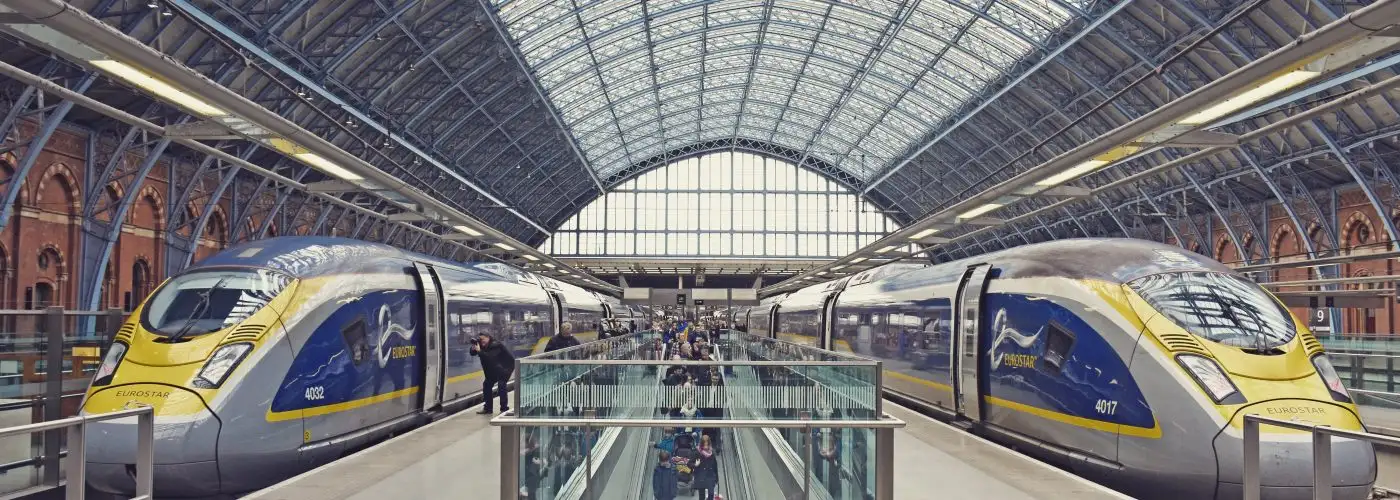
How to Book Train Travel in Europe: 12 Essential Sites
Caroline Morse Teel
Caroline Morse Teel is the Managing Editor for SmarterTravel Media. Follow her on Instagram @TravelWithCaroline .
Caroline joined Boston-based SmarterTravel in 2011 after living in Ireland, London, and Manhattan. She's traveled to all seven continents, jumped out of planes, and bungeed off bridges in the pursuit of a good story. She loves exploring off-the-beaten path destinations, anything outdoorsy, and all things adventure.
Her stories have also appeared online at USA Today, Business Insider, Huffington Post, Yahoo, Boston.com, TripAdvisor, Buzzfeed, Jetsetter, Oyster, Airfarewatchdog, and others.
The Handy Item I Always Pack : "Earplugs. A good pair has saved my sleep and sanity many times!"
Ultimate Bucket List Experience : Hiking Mount Kilimanjaro.
Travel Motto : "Don't be boring."
Aisle, Window, or Middle Seat : "Aisle (when the first class private suite isn't available)."
E-mail her at [email protected] .
Travel Smarter! Sign up for our free newsletter.
The train can be the fastest, easiest, and cheapest way to travel around Europe—but booking can be confusing. Here are all the essential sites for booking train travel in Europe.
For Multi-Country Train Travel in Europe
Rail europe.
Rail Europe is one of the best starting points for planning a trip around Europe, whether it’s a multi-country itinerary or single country trip. The modern, easy-to-use website offers English and U.S. Dollar display options and lets you make reservations, compare rail passes, and buy tickets. Use the customizable map to easily build out your trip.
Remember EuroRail? It’s now called Eurail , and its site is a great resource for planning a trip across the continent. Site features include a fun tool to help you find the best rail pass for your trip, plus European train timetables, maps with travel times, and even travel inspiration if you’re still deciding where to go. Eurail also helps with ferry travel, so you can easily figure out how to combine a train and ferry to get to your next destination. Note that if you’re a European resident, you’ll need to use the InterRail site to buy your passes, as there are different options for residents and non-residents.
Thalys runs high-speed trains on routes around France, Belgium, the Netherlands, and Germany. Buy tickets directly on its site—you’ll find good special offers and a deals section. Note that this site is only available in French, but Google Translate works well enough that you shouldn’t have trouble using it if you don’t speak the language.
B-Europe partners with rail companies across Europe (like Eurostar, TGV, and Trenitalia) to offer discounted train tickets. Compare prices here before booking your tickets—you can find deals like a one-way ticket from Brussels to Paris on a high-speed train for $20 if you’re flexible.
Ever bought a flight that patches together an itinerary from multiple airlines for the cheapest fare? Raileasy is the same concept, but for trains. It allows you to save tons of money by booking one leg of your journey through one train company and the rest through another—an option that most train sites don’t give you.
Not sure if you want to take the train, bus, or a combination of both on your European trip? Trainline helps you compare and book train and bus tickets across the continent. This is one of the easiest ways to check prices and times for multiple companies (like Eurostar, SNCF, Trenitalia, Renfe, Flixbus, and more) in one place. Book here and you can even pay with PayPal and Apple Pay.
Transpennine Express
Transpennine Express runs train services across Great Britain. Check here for live train times, information on how to get compensation if your train is delayed, ticket offers, and to buy tickets. It’s worth noting that you can get a group discount through Transpennine if you’re traveling in a group of three or more people.
For Single-Country Train Travel in Europe
Deutsche bahn.
Deutsche Bahn is the site you need if you’re planning train travel across Germany. Check here for great ticket deals, to buy tickets, and check train times. If your trip includes travel to/from Germany and another European country, you can buy German Rail, Interrail, and Eurail Passes here (and the site has a comparison tool to help you decide which type you need).
Swiss Railways
Train travel in Switzerland can get expensive, but Swiss Railways has some decent deals on its website, including a Swiss Coupon Pass that gives you discounts on attractions. If you’re planning a longer trip, the Swiss Half Fare Card is a good investment, as it will save you 50 percent off of rail, bus, and boat tickets for one month. In addition to train tickets, you can also book excursions and packages here.
Italiarail offers both tickets and buy rail passes, and it’s also a good resource for general information on train travel in Italy. The maps on this site are incredibly detailed, and show which trains are high-speed and which are regional—you can even see which services and amenities are offered at each station.
For Airport Transfers Via Train in Europe
Stansted express.
The Stansted Express is one of the cheapest and fastest ways to get to and from London’s Stansted Airport. Buying your tickets online saves you hassle at the airport.
Heathrow Express
Travel between London’s Paddington station and Heathrow airport in just 15 minutes on the Heathrow Express .
Terravision
If your European train travel mainly involves getting to and from the airport, be sure to check out Terravision , which will show you prices and times for both bus and rail transport to and from airports in Europe.
What to Wear for Train Travel in Europe
Women’s bohemian outfit to wear on a sunny vacation, shop the look.

Long Dress with Tie Belt

Braided Shoulder Bag

Pineapple-C Brightening Serum
Men’s casual jean and short sleeve button down outfit.

Regular Fit Polo

Slim Fit Jeans

Women’s Comfy Outfit to Wear on a Flight

Restore Draped Jogger

Adjustable Cap

Chuck Taylor®
Men’s comfortable airplane outfit.

Crewneck Sweatshirt

No Sweat Joggers
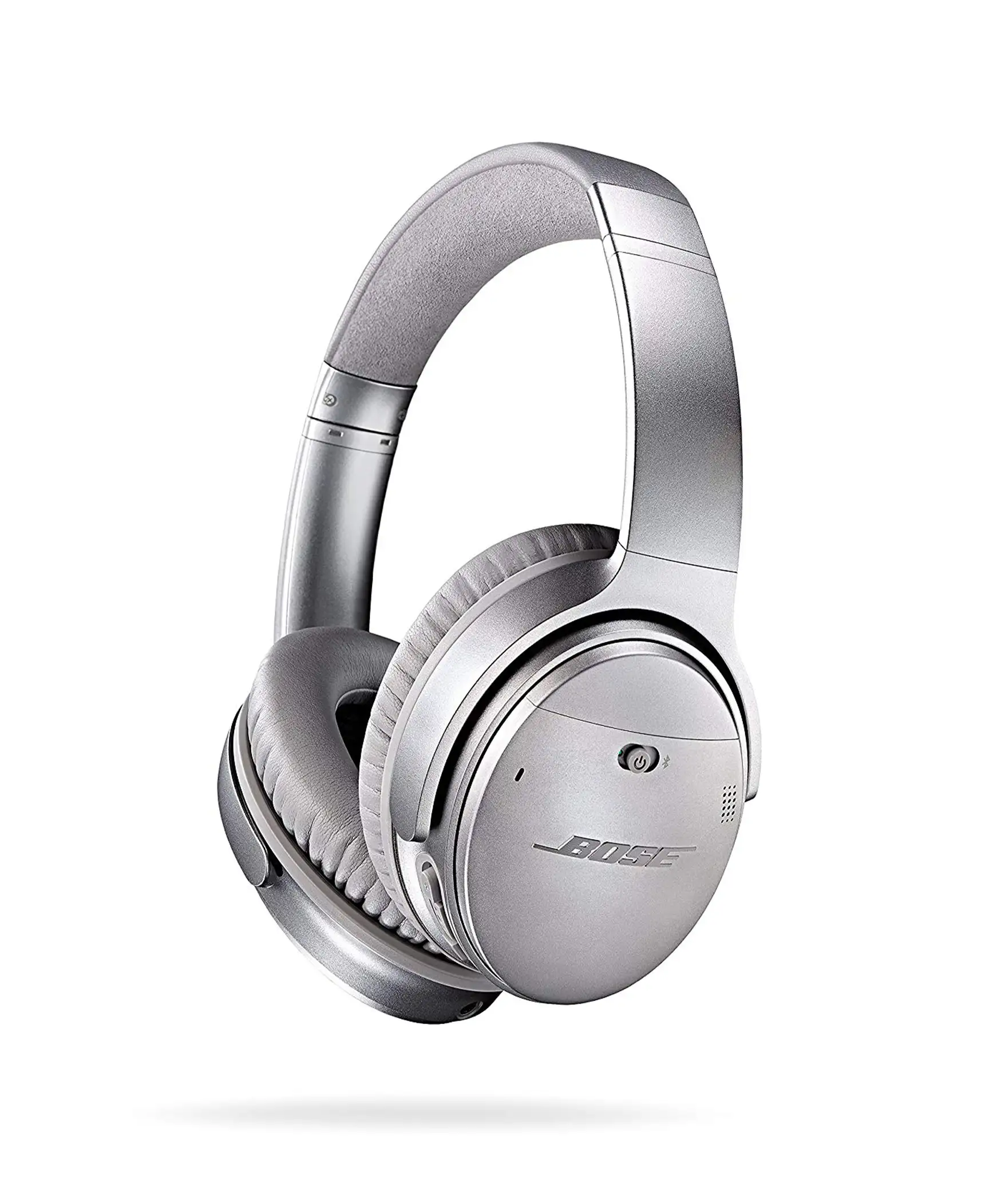
Noise Cancelling Headphones

Women’s Outfit for Spring in a Major City

High Neck Top

Raw Hem Jeans

18k Gold Bar Studs

Textured Jacket

Slip-on Sneakers
Men’s evening outfit for a cruise.

Riviera Short Sleeve Shirt

Stretch Technical Shorts

Square Sunglasses

Women’s Casual Shirt Dress Outfit

V-Neck Dress

Gulf Necklace

Market Canvas Tote

Men’s Casual Summer Outfit

Graphic Tee

Light Wash Spray On Jeans

Sprite Baseball Hat
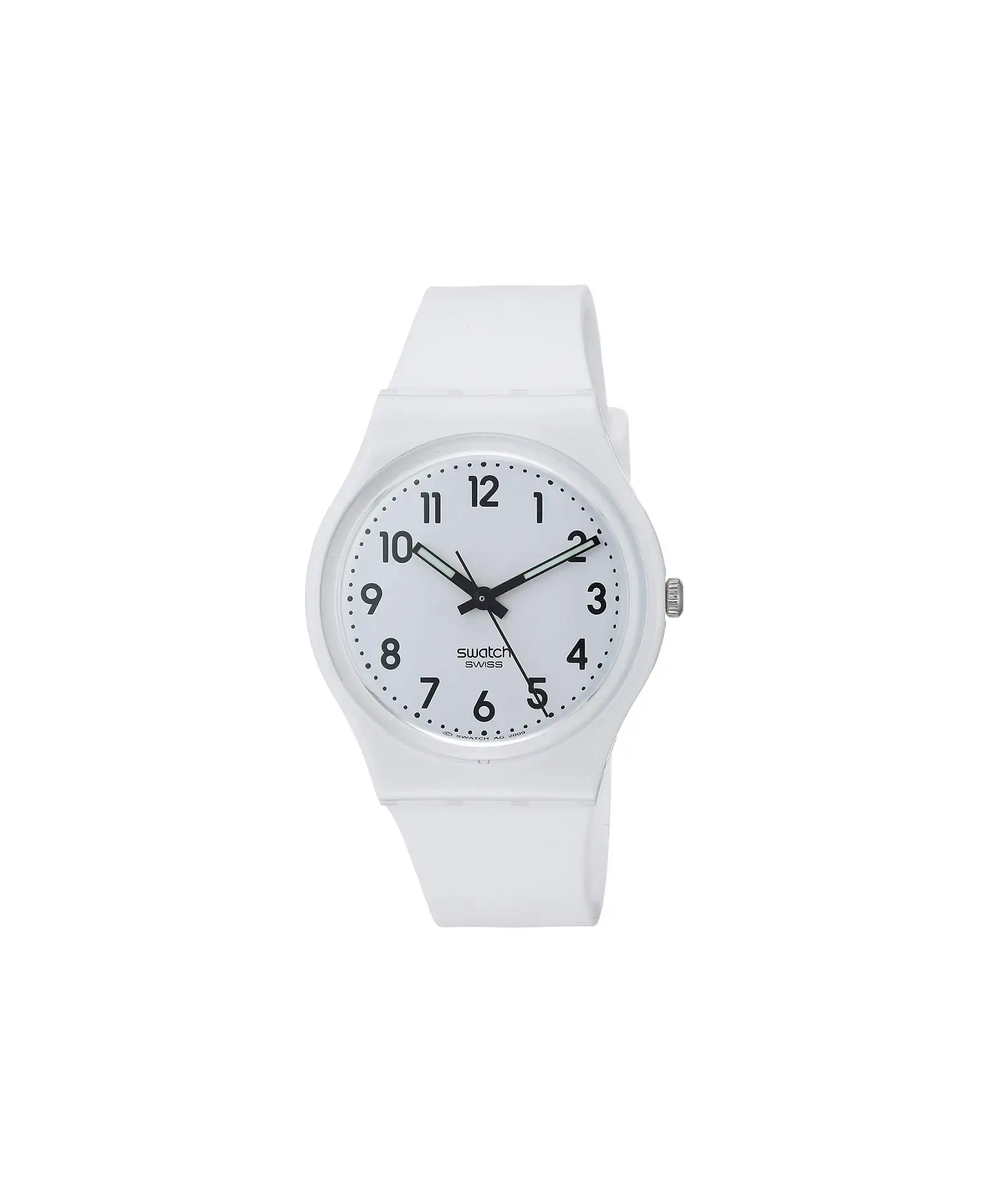
White Watch

More from SmarterTravel:
- Top 10 Reasons to Travel by Train
- 9 Ways to Make Long Train Rides More Comfortable
- 6 Incredible Train Journeys That Won’t Break Your Travel Budget
We hand-pick everything we recommend and select items through testing and reviews. Some products are sent to us free of charge with no incentive to offer a favorable review. We offer our unbiased opinions and do not accept compensation to review products. All items are in stock and prices are accurate at the time of publication. If you buy something through our links, we may earn a commission.
Top Fares From

Don't see a fare you like? View all flight deals from your city.
Today's top travel deals.
Brought to you by ShermansTravel
8-Night South Africa Tour, Incl. Kruger...

Poconos: 2-Nt, All-Incl. Stay at Upscale...
ResortsAndLodges.com

Amsterdam to Copenhagen: Luxe, 18-Night Northern...
Regent Seven Seas Cruises

Trending on SmarterTravel
28 best European routes where you should take a train instead of a plane

Editor's Note
Europe's train system, particularly for intracountry travel, is a well-developed and affordable option for travelers visiting the region. If you already live in Europe, it can be an incredibly easy way to travel without flying.
You won't have to deal with long airport security lines, airport commute hassles, luggage fees or a host of other problems. Instead, you can hop on a long-distance train from the center of virtually any major European city to reach your final destination.
Related: 4 European train loyalty schemes UK travelers should definitely check out
European trains often offer some complimentary conveniences; they give you the freedom to stretch your legs, stroll to a dining car and get something to eat or drink. Not to mention, trains rarely come with the problems that many European airports and airlines have faced over the last few summers.
Read on to discover some of the benefits of European train travel and learn about a few of the region's most notable routes.
Why you should take the train

Although traveling by train can sometimes take longer than flying, the benefits of slow travel shouldn't be overlooked. By taking a rail journey instead of hopping on a plane, you can eschew much of the stress associated with airports and security. Also, in many instances — if you plan properly and buy the correct fares — you'll get to see multiple destinations on one trip.
Sure, occasionally, flying might be the cheapest option, but it's not always the most rewarding. Plus, with rail travel in Europe growing more and more popular, we regularly see great deals on travel that dwarf the prices offered on even low-cost carriers. Here are some of the great benefits of taking a train around Europe .
No security and customs screening lines
Simply walking on and off trains with your luggage in hand is a time-saving luxury that air travelers haven't experienced for decades. The airport security screening process and sprawling lines at passport control and customs can add hours to the experience. As a result, what you had hoped would be a quick flight may feel more time-consuming (and exhausting) than traveling by train.
Free internet access
Many airlines don't provide Wi-Fi (especially budget ones), and they often charge a high price if they do. Most long-distance European trains come with Wi-Fi included in the ticket price. Additionally, you'll have much more legroom and tray table space to work on a train once you're connected.
No airport commute hassle
Taking a train from the central station of your favorite European city is typically far more convenient than schlepping outside the city to an airport. This is especially true if you're staying in or near the city center. Depending on where you stay, you may even find it possible to walk directly to or from the station or reach the main station easily via (cheap) public transport.
Fewer cancellations and delays
European trains are not subject to the same weather and air traffic control delays as airplanes and they have much more consistent schedules. Some overnight trains and those with longer, more complicated itineraries may have delays on the rails to make way for overnight freight traffic; however, in comparison to planes, delays are often less likely or impactful.
Less environmental impact
You may not regularly think about how environmentally friendly your trips are, but it doesn't mean your travels don't play a part in the larger conversation about the environment. Many experts agree there is a substantial environmental benefit to traveling by train instead of flying.
"A journey from London to Paris by air emits around 10 times as much CO2 as the same journey by rail," Tom Hall, a writer and train specialist at Lonely Planet (which, like TPG, is a Red Ventures-owned company) said. "As travelers look for more sustainable travel choices, longer-distance rail routes are gaining in popularity."
Related: How is aviation fuel changing to help fight climate change?
28 best European train routes

Trains departing from Austria
Vienna to paris.
Launched in 2021, this Nightjet sleeper train route runs three times a week and takes around 14 hours to go straight through from Vienna to Paris . It has notable stops along the way, including Munich and Strasbourg, France.
Vienna to Genoa and La Spezia
One of Nightjet's newer additions, this route was launched in summer 2023 and is an extension of the company's service from Vienna /Munich to Milan . The route runs daily and takes around 16 hours to go all the way to La Spezia in Italy, passing through Milan and Genoa en route.
You can book tickets for both routes on the Nightjet website.
Trains departing from Belgium
Brussels to berlin.
European Sleeper launched in 2021, and one of its first routes was the overnight service from Brussels to Berlin . The route stops off at Antwerp, Belgium, before heading through the Netherlands. There, you can hop off at Rotterdam, Amsterdam and Deventer if you're not looking to travel all the way to Berlin.
You can book tickets on the European Sleeper website .
Liege to Aachen and Maastricht (launching December 2023)
Launching in December 2023, this route is a collaboration between Arriva, SNCB (the National Railway Company of Belgium) and Nederlandse Spoorwegen. Connecting Belgium , Germany and the Netherlands, this will surely be a popular route with European city hoppers once it launches.

Brussels to Dresden and Prague (launching 2024)
Set to open at some point in 2024, European Sleeper will also be extending its current Belgian services by adding additional stops in Dresden, Germany, and Prague .
Trains departing from the Czech Republic
Prague to zurich.
Another relatively new sleeper service, this route launched at the back end of 2022 by the Czech Republic's national rail operator Ceske drahy. The full overnight journey takes less than 14 hours and passes through Frankfurt and Basel, Switzerland.
You can book tickets on the official website .
Trains departing from France
Paris to london.
Perhaps one of Europe's most famed train routes, Eurostar travels between London St Pancras station and Paris Gare du Nord station in just more than two hours. Services run almost hourly, seven days a week. For a closer look at this route, check out our recent Eurostar review .
You can book tickets on the Eurostar website .
Related: The best hotels in London

Paris to Berlin (launching 2024)
Following a partnership between German rail operators Deutsche Bahn and France's SNCF, this new high-speed TGV service is set to launch next year; it'll stop in Strasbourg on the night route service. The door-to-door journey is expected to take about seven hours.
Paris to Venice (launching 2025)
This new sleeper link between two of Europe's most romantic cities is set for a 2025 launch. French rail company Midnight Trains will operate the route, which will also stop off in Milan. If successful, the company aims to add additional Paris services over the coming years, with Copenhagen, Berlin and Edinburgh all already marked to receive their own Midnight Trains services.
Related: Go here, not there: Where to take the best photos in Paris
Trains departing from Germany
Berlin to stockholm with snalltaget.
This was formerly Swedish rail company Snalltaget's service from Berlin to Malmo, Sweden. Now, this route has been extended all the way to Stockholm; it passes through Hamburg, Germany, and Denmark before reaching its final destination. The full journey takes just less than 17 hours and is a direct service.
You can book tickets on the Snalltaget website .
Stuttgart to Zagreb and Rijeka
Another epic sleeper train from Nightjet (this time under its EuroNight partnerships) allows you to easily ride from Germany to Croatia on two different routes.
Both routes start in Stuttgart, Germany, and pass through Munich. One route ends in the Croatian capital Zagreb, and the other heads to the Croatian harbor of Rijeka. The trips take 14 and 15 hours, respectively. However, note that the Rijeka route is seasonal and finishes at the end of September. Trains to Zagreb, however, run daily throughout the year.
You can book tickets for both routes on the Nightjet website .

Berlin to Brussels
This route is already covered above under "Brussels to Berlin."
Munich to Genoa and La Spezia
This route extends the aforementioned route under "Vienna to Genoa and La Spezia."
Aachen to Liege and Maastricht (launching December 2023)
This route is covered above under "Liege to Aachen and Maastricht."
Trains departing from Italy
Milan to paris.
This speedy route, operated by Frecciarossa (part of the Italian national train company Trenitalia), will take you between two of Europe's most fashionable cities in just less than seven hours. If you don't want to go the full stretch, you can also hop off at Turin, Italy, or Lyon, France. The service operates almost hourly every day.
You can book tickets on the Trenitalia website .
Intercity travel around Italy with Trenitalia
Italy's national rail network is a great way to get around the country and escape airport hassles. The Trenitalia Pass is an affordable and flexible option to use as you travel from one Italian destination to the next. You can book several trips within a seven-, 15- or 30-day period for as little as $128.
If you don't want to commit to buying a pass, you can instead purchase individual tickets from Trenitalia. Fares for its popular route connecting Rome and Florence, Italy — which takes a little more than 1 1/2 hours — cost less than $60 per person round-trip.
Trains departing from the Netherlands
Amsterdam to austria.
Tui's "Ski Express" is a special winter service that operates every Friday night between Dec. 23 and March 31. It allows ski fanatics to hop between Amsterdam and the Austrian Alps' famed ski resorts, such as Gerlos, Kirchberg, Niederau, Soll, Zell am See and Westendorf.
You can book tickets on the Tui website .

Amsterdam to Zurich
Another Nightjet train, this route can whisk you between Amsterdam and Zurich in roughly 12 hours. It passes through Utrecht, Netherlands, and Cologne, Germany, along the way. The train runs daily from 8 p.m. and arrives at its destination the following day at 8 p.m.
Related: How to spend 1 day in Amsterdam
Maastricht to Aachen and Liege
This route will launch in December 2023 and is covered above under "Liege to Aachen and Maastricht."
Amsterdam to Barcelona
European Sleeper is further expanding by linking the Netherlands to Spain with this new route. It's expected to officially launch in spring 2025 and take approximately 17 hours. The route will stop at Rotterdam, Netherlands; Antwerp, Belgium; Brussels; Lille, France; Avignon, France; Montpellier, France; and Girona, Spain, among others. It'll become one of the company's most well-connected routes.
Trains departing from Spain
Madrid to marseille via barcelona.
New for 2023, the eight-hour route from Madrid to Marseille, France, by Renfe finally launched in July. This packed route connects 14 destinations across Spain and France, including Barcelona; Figueres, Spain; Montpellier, France; Nimes, France; and Aix-en-Provence, France, before its final stop at Marseille.
You can book tickets for both routes on the Renfe website .

Barcelona to Lyon
Along with the above route, Renfe also launched a new service connecting Barcelona to Lyon, with stops in Girona, Spain; Perpignan, France; Montpellier, France; Nimes, France; and Valence, France. The route takes around five hours if you stay aboard until the final stop.
Trains departing from Slovenia
Ljubljana to budapest.
One of the most affordable routes on this list, these tickets regularly cost as little as 16 euros (about $17). Operated by Hungarian Railways, the train travels from Slovenia via Graz, Austria, before its final destination of Budapest.
You can book tickets on the operator's official website .
Trains departing from Sweden
Stockholm to hamburg.
This daily service operated by SJ EuroNight will take you from Stockholm to Hamburg via Copenhagen. It departs at 5:30 p.m. and arrives at 6:30 a.m. the following day. Plush compartments are available — including some for one to three people, complete with a private shower. The train also has pet-friendly compartments should you wish to travel with your beloved pooch.
You can book tickets on the SJ website .
Trains departing from the UK
London to amsterdam, brussels, paris and the french alps.
Taking Eurostar from central London is a speedy and efficient way of traveling to Europe without the hassle of taking a plane. Starting at London St Pancras station, you'll travel through the Channel Tunnel, which connects the continent to the U.K. with various destinations and routes.
London to Amsterdam's city center takes less than four hours to complete. Round-trip tickets start around $80 per person, a reasonable price given how expensive taxi rides to Heathrow from downtown London can be on a busy day.
Traveling to Brussels from London St Pancras is just as easy and takes less than two hours with similarly low prices.
Related: What's the difference between Business Premier, Standard Premier and Standard class?
As mentioned above, under "Paris to London," you can also reach the French capital in just over two hours. Beyond Paris, between Dec. 16 and Deb. 3, you'll also be able to travel from London to the French Alps to visit various ski resorts in Chambery, Albertville, Moutiers, Aime-la-Plagne and Bourg-Saint-Maurice.
Bottom line
Despite budget airlines offering cheap fares to most European cities, an intercity train trip can still be more affordable. As a bonus, it's often far less stressful than transiting through airports, and you'd be surprised by just how far you can travel.
Rather than worry about delays and cancellations, lost luggage, long customs lines and more, you can focus on work, socialize with travel companions and admire your surroundings as they pass your window. You can also take comfort in knowing your trip is less harmful to the environment than if you were to travel by air.
How to Travel Europe By Train
- Pinterest 2

How to travel Europe by train? Read more and learn about it!
Traveling Europe by train is one of the most unique experiences. It’s not just a way to get from point A to point B, but it’s also a journey in and of itself. Train travel allows travelers to witness beautiful landscapes often missed when flying or driving and provides an opportunity to meet other travelers who share similar interests.
Booking trains in Europe can be intimidating at first, but with the proper preparation, it can be an enjoyable experience. One of Europe’s most significant benefits of train travel is convenience and affordability.
There are plenty of options for routes, departure times, and seating classes that can fit any budget or preference. With so much variety available, it’s essential to research your options to make the best decisions for your trip.
Pick your departure and arrival points to begin planning your train travel adventure across Europe. This will depend on the countries you want to visit during your trip.
Some popular destinations include Paris , Berlin, Amsterdam, Rome, and Barcelona. Once you have decided on your starting and ending points for each leg of the journey, consider choosing the right time to travel based on weather conditions or local events that may impact availability or prices.
Also, researching routes and timetables will help you get all the must-see scenery. Selecting and purchasing tickets ahead of time is strongly recommended, as prices typically increase as seats sell out closer to departure dates.
🛏️ Book your hotel ahead of time to get the best deals, click here to find the best hotels to stay !
🧳 One of the best way to explore a new destination stress-free is through guided tours! Check this out to find the best tours at affordable prices .
Follow me on Instagram and Tiktok for more Finland and Europe travel tips ! 🏕️🏕️🏕️
Do you need help planning your trips? Start here!
❗️Be insured before your trip and get a SafetyWing FREE insurance quote 📚 Read our post about why you should always have insurance ✈️ Find out how to find cheap flights using Skyscanner or find deals now 🛌🏻 Book your accommodation through Booking.com 🎭 Find awesome and hassle-free tours through GetYourGuide 🚘 Explore Europe on an epic road trip with Discover Cars
Table of Contents
Why train travel in Europe?

When planning a trip to Europe, many people need to pay attention to the option of traveling by train. However, train travel in Europe is a fantastic way to experience the continent. It is an affordable and efficient mode of transportation and offers breathtaking views of picturesque countryside and historic landscapes.
One of the biggest reasons to choose train travel in Europe is because it allows you to see more than just the major tourist attractions. Train routes often take you through smaller towns, villages, and rural areas that you would only sometimes visit otherwise.
This means that you get a chance to explore some hidden gems that many tourists miss out on. Additionally, train stations are often located in central parts of cities, giving you easy access to local public transportation and making it easy to explore even more.
Another reason why train travel in Europe is so popular among travelers is because it’s incredibly convenient. In many cases, trains run frequently between significant destinations and can be quickly booked online or at a station ticket office.
For those who want flexibility during their travels, there are also options for purchasing flexible tickets and passes that allow them to change their travel dates or destinations as needed. Ultimately, if you’re looking for a hassle-free way to see Europe’s diverse landscapes and cultures while staying within budget, train travel may be just what you need!
Benefits of train travel

One of the most significant benefits of train travel in Europe is its eco-friendly means of transportation. Trains emit fewer greenhouse gases per passenger than planes or cars.
Moreover, trains run on electricity, which can come from renewable sources like wind and solar power. If you’re environmentally conscious and want to reduce your carbon footprint while exploring Europe, traveling by train might be your best option.
Another perk of taking the train in Europe is that it’s often more comfortable than flying or driving. Trains offer more legroom than planes, making long journeys less cramped and tiring.
Additionally, many trains have power outlets for passengers to charge their devices during the trip. Unlike driving a car, you don’t have to worry about navigating unfamiliar roads or finding parking spots once you reach your destination when traveling by train.
Furthermore, many trains have dining cars where you can enjoy a meal while gazing at beautiful European scenery outside your window. Overall, traveling by train in Europe can provide a relaxing and enjoyable experience compared to other modes of transportation.
What you’ll learn from this article

This is my ultimate guide on how to travel Europe by train! This article is designed to give you a comprehensive overview of everything you need about train travel in Europe.
Whether you’re a seasoned traveler or embarking on your first European adventure, this guide will help make your journey as smooth and stress-free as possible. We’ll start by discussing the benefits of traveling by train in Europe.
It is often cheaper than flying, but it’s also much more comfortable and provides an opportunity to see Europe’s stunning scenery. Then we’ll move on to planning your trip, including how to pick departure and arrival points, when the best time is to travel, how to research routes and timetables, how to select and purchase tickets, and what you should pack for your journey.
We’ll even cover tips for getting the most out of your trip, such as opting for a Eurail pass or booking first-class seats. Once we’ve covered all the basics of planning your trip, we’ll dive into taking the trains themselves.
You’ll learn what it’s like arriving at the station, boarding the train, finding your seat (and keeping it!), and what amenities are available onboard. We’ll even go over food and beverage options so you can make sure you stay hungry on those longer journeys.
Of course, exploring European cities is one of the main reasons people travel by train in Europe. We’ll discuss arriving in new towns via their respective stations before diving into how best to navigate public transportation systems throughout different countries.
You’ll also learn about staying near train stations for optimal convenience before exploring top European attractions accessible by trains, such as Paris ‘ Eiffel Tower or Berlin’s Brandenburg Gate. : Safety and security while traveling across Europe via trains are paramount concerns that should be taken seriously when preparing for a trip across this much-loved continent.
We will provide helpful tips on ensuring your Safety during train travel, keeping your valuables safe, and what to do in emergencies. So, please sit back and read on for our complete guide on traveling Europe by train!
Are you planning your travels? Here’re my top travel resources!
I’m a serial planner both in life and in travel – I have bucket lists, things to do, see, and everything. So, I always love when my life is sorted easily using tools and resources that would make my general planning a little smoother and easier. Therefore, in my many years of traveling the world, I’ve seen myself returning to these travel resources repeatedly. And here I am, sharing my tips to make your life easy and breezy so you can stress less, travel heaps, and focus on the fun part of travel!
- Booking.com – I book all my hotels through this website and don’t honestly use anything else. They always have the best prices, in my opinion.
- Airbnb – If I’m traveling long-term to one destination, I book my flats through Airbnb.
- Skyscanner – The best place to find cheap flights on flexible dates. I use this a lot to score cheap flights within Europe!
- SafetyWing – Always travel insured! Never leave your home country without one. It is worth the extra money, I promise you!
- GetYourGuide – Hands-down, the best place to find cool and unique tours if you don’t feel like winging it, and go straight to a local expert. I use this a lot in new destinations to get acquainted with the area!
- My Pretty Wild World Travel Diary (coming soon) – A book you can write down your travel plans, create itineraries, track down your budget, and dot down memories along the way! A handy book you can keep and read later to revisit memory lane.
- Pretty Wild World Travel Planning Printables (coming soon) – Are you a nut like me when it comes to planning? Yes? Good. My travel planning resource in one zip file is an easy-to-use printable planner that comes with tips that helps you plan your travels during the planning stage, a pre-flight checklist, an itinerary planner, and so on.
Step-by-Step Guide on How to Travel Europe by Train

Picking your departure and arrival points : When planning a train trip through Europe, one of the first things to consider is where you want to go. Europe has an extensive rail network that connects almost every major city on the continent, so you have plenty of options.
However, remember that some destinations may be more challenging to reach by train than others. For example, smaller towns or remote areas may not have direct trains or require multiple transfers.
It’s essential to research ahead of time to determine which routes are feasible and how long they will take. Choosing the right time to travel:
Another critical factor in planning your train travel through Europe is choosing the right time. High season (typically June-August) can be crowded and expensive, and many popular destinations are swamped with tourists.
Consider traveling during shoulder season (April-May or September-October) when prices are lower, crowds are thinner, and the weather can still be pleasant. Additionally, traveling during off-peak hours can save you money on tickets; early-morning or late-night trains tend to have lower fares than mid-day departures.
Researching routes and timetables : Once you’ve decided where you want to go and when you want to travel for your European train adventure, it’s essential to start researching routes and timetables.
Several helpful online resources offer information on train schedules across Europe; the most popular ones are Eurail.com and Seat61.com. These websites provide detailed information on how to buy train tickets in Europe and what kind of passes might work best for your itinerary, given timescales for how long each journey will take based on available connections between stations along your route(s).
1. Picking your departure and arrival points
When planning a train trip in Europe, one of the first things you need to consider is where you want to start and end your journey. Fortunately, Europe has a well-established rail network that can take you almost anywhere.
However, remember that some places are more popular than others and may have more direct train connections. For example, if you’re interested in visiting Paris, Brussels, or Amsterdam, they are all excellent starting points for exploring other parts of Europe.
Another thing to consider when picking your departure and arrival points is how easy it will be to get there. Most major European cities have an international airport with direct flights from other parts of the world.
If you plan on flying into Europe, consider starting your train journey from a city with a large airport, as it’ll be more convenient. Additionally, if traveling long distances is fine, consider adding some less popular destinations to your itinerary.
Smaller cities often offer unique experiences and attractions that larger ones need to have. Figuring out the perfect departure and arrival points can be challenging, but researching them will pay off when planning to travel to Europe by train!
2. Choosing the right time to travel
Choosing the right time to travel is crucial for a successful European train trip. Timing can affect everything from ticket prices to crowds and even weather conditions.
To make the most of your trip, consider these factors. First, think about peak travel season.
This is generally from June to August when schools are out, and many people take their summer holidays. Prices for train tickets and accommodation can be higher during this time, and popular destinations can be crowded with tourists.
If you want to avoid the crowds and save money, consider traveling in the shoulder season (April-May or September-October) when the weather is still pleasant but fewer tourists are around. Another consideration is significant events or holidays that may affect travel plans.
For example, Oktoberfest in Munich draws huge crowds from late September to early October, making it harder to find tickets or accommodations. Similarly, Christmas markets across Europe attract visitors throughout November and December .
Consider these events when planning your itinerary so you can book train tickets and accommodations well in advance. No matter what time of year you choose to travel, planning is essential when booking train tickets in Europe.
Some routes sell out quickly during peak season or busy periods like weekends or public holidays. Researching routes and timetables ahead of time will help ensure you get the best deal on your tickets and avoid any last-minute stress while trying how to book trains in Europe on crowded platforms!
3. Researching routes and timetables
Researching routes and timetables can be daunting, but it is essential to planning your train travel in Europe. Numerous resources are available to help you find the best routes and timetables for your trip. One of the most popular is the Eurail website, which allows you to search for train schedules and purchase tickets online.
Another great resource is Rail Europe, which offers a variety of travel passes and packages to help you save money on your train travel. When researching routes and timetables, it’s important to remember that not all trains run at all times.
Some trains may only operate on certain days of the week or during specific seasons. Additionally, some routes may require multiple transfers or layovers along the way.
It’s important to factor in these variables when planning your itinerary to avoid getting stranded with a ride or paying more than necessary for additional tickets. If you need help deciding which routes or trains to take, consider consulting with a travel agent specializing in train travel in Europe.
These professionals can offer valuable advice on buying train tickets in Europe, booking trains in Europe, and other aspects of your trip that will ensure that it runs smoothly from start to finish. By taking your time and doing thorough research before embarking on your journey by rail through Europe, you’ll surely have an unforgettable experience filled with adventure and discovery!
3. Selecting and purchasing tickets
Selecting and purchasing tickets is the most crucial aspect of your train travel in Europe. There are many options, and figuring out what is best for you can be overwhelming. However, with some research and knowledge, making the right choice for your trip is easy.
Firstly, it’s important to research the different types of trains available. Depending on your preferences and budget, you can choose from high-speed, local, intercity, and overnight trains.
Once you know which type of train you want to take, the next step is selecting the class of ticket that suits you best. First-class tickets offer more space and amenities than second-class options but come at a higher price.
After deciding on the type of train and ticket class that suits your needs best, it’s time to book your tickets. There are several ways to buy train tickets in Europe – online through official websites or third-party sites like Rail Europe or in person at a train station kiosk or ticket office.
Booking online allows you to compare prices easily and help ensure availability during peak travel times. To book online, select your departure station and destination along with the date and time of travel, then follow the prompts for payment information – it’s as simple as that!
A tip when booking online: print out confirmation emails or save them on your phone just in case there are any issues retrieving your tickets at stations before boarding the trains. With these tips on buying train tickets in Europe, booking travel by rail will be smooth sailing!
4. Packing for the right climates
Packing for a train journey in Europe can be tricky, especially if traveling to different cities with different climates. However, following some simple guidelines can make the process much easier.
Firstly, make sure to pack light. It’s tempting to bring all your favorite outfits, but remember that you’ll have to carry everything on and off trains and upstairs.
A good rule of thumb is only to bring what you can comfortably carry on your own without needing help from someone else. Also, it’s important to check the baggage rules for each train company as they may vary in size and weight allowances.
Another important factor to consider when packing is security. Keep valuables such as passports, money, and electronics in a small bag you can always carry.
Don’t leave these items unattended or in checked luggage, as theft can happen even on trains with a good reputation for Safety and security. Remember comfort!
Train journeys in Europe are often long, so it’s vital to pack comfortable clothing, such as loose-fitting pants or skirts, along with layers like a light sweater or jacket since train temperatures fluctuate. By keeping these tips in mind while packing, you’ll set yourself up for an enjoyable and stress-free journey across Europe by train!
5. Head to Europe and start your train journey around Europe!
The most exciting part has finally arrived after all the planning. Now that your journey has started, it’s time to learn what to expect during your adventure.
Hold up! Have you thought about the importance of travel insurance?
Remember this: anything can happen. Travel is fun, but your health is more important; thus, I always, always, always recommend getting insured during the duration of your trip. I have benefitted from having one multiple times, and it has been covered for thousands of euros!
The latest one is not necessarily “health” related – it was during the peak of the unspeakable terrible C that consumed the world. I was living in Vietnam when I received an email from SafetyWing (my travel insurance) that if I want they’ll fly be back home to Finland as the world goes through a global emergency alert. I flew back fully covered, and dealing with SafetyWing was a breeze despite the roar of people in contact with them trying to get back home.
I can’t highly recommend them enough. Otherwise, I rarely get sick; hence I don’t always need to head to a hospital, but knowing that I have travel insurance makes me feel safe at the very least.
Read my post about why you should get travel insurance for more information. Otherwise, you can get a free quote from SafetyWing – they’re the best, in my opinion.
Taking the Train in Europe for First Timers

When you arrive at the train station, give yourself plenty of time before departure (I’d say anywhere between 30 minutes to 1 hour before departure). You want to avoid running through the station with all your luggage, trying to find the right platform.
Make a note of your departure time and platform number, and give yourself enough time to grab a snack or use the restroom if needed. Once you know where you’re going, head towards your platform.
If you have a lot of luggage, look for a luggage cart or trolley. Monitor any signs or announcements about delays or changes to your train’s schedule.
Finding Your Seat When boarding a European train, it’s important to remember that not all seats are assigned.
Depending on the type of train and ticket you’ve purchased, you may need to find an unassigned seat when boarding. If so, try to board quickly to secure a good seat.
If your seat is assigned, make sure that you double-check which car and seat number you’re supposed to be in before boarding. There’s nothing worse than sitting down in someone else’s assigned seat!
Additionally, remember that some trains have reserved seating for certain parts of the journey (e.g., first class only), so make sure you’re not accidentally sitting in one of these reserved sections if you have yet to pay for it. All this information should be available on your ticket or reservation confirmation email, and we’ll discuss how to buy train tickets in Europe later on!
Arrival at the Train Station
Arriving at the train station is an exciting and sometimes overwhelming experience. If it’s your first time traveling in Europe by train, navigating the crowds and figuring out where to go can be daunting.
However, with a few tips and tricks, you’ll feel like a seasoned traveler in no time. Firstly, ensure you arrive at the station quickly before your scheduled departure.
This allows for unexpected delays or confusion while finding your way to your platform or seat. Most stations have multiple entrances, so be sure to check ahead of time which entrance will lead you directly to your platform.
Also, remember that some stations may require walking up or down stairs to reach certain platforms, so plan accordingly if you have heavy luggage. Once inside the station, find a departure board listing all trains leaving within the next hour or two.
Look for your train number and departure time on the board, and then head toward the corresponding platform listed on the board. When in doubt, don’t hesitate to ask for help from one of the many helpful staff members stationed throughout most European train stations.
They can point you in the right direction and provide information about booking trains in Europe or buying train tickets. Overall, arriving at a train station can feel overwhelming. Still, with some preparation beforehand and flexibility during travel days, it can be an exciting part of any trip through Europe by train!
Boarding the train and Finding your Seat
When boarding a train in Europe, arriving early at the station with your ticket and valid identification is important. Train stations can be hectic, especially during peak travel times, so give yourself plenty of time to find your platform and board the train. Make sure you are waiting on the correct side of the platform for your train’s arrival, as some platforms can accommodate multiple trains at once.
Once onboard, finding your seat is typically easy, as most trains have reserved seating. When booking your ticket, you will receive a car and seat assignment.
Pay attention to the car number written on the outside of each carriage and look for your assigned seat number inside the car. The numbers are posted above or next to each seat or on a digital display above each luggage rack.
If you’re traveling with others, try booking seats together in advance using online booking systems or visiting a local railway station before departure day. One thing to remember is that some trains have different classes with varying levels of comfort and amenities.
When booking tickets online or purchasing them at a station, take note of what class you are buying so that you know what amenities (like WiFi or food service) will be available onboard your train journey. It’s also important to note that some trains require reservations for specific routes or classes – make sure you check ahead if this applies when learning how to buy train tickets in Europe for specific journeys, as it may not always be possible to purchase tickets onboard without prior reservation.
Train amenities
When traveling by train in Europe, you’ll have access to a range of amenities on board that will make your journey more comfortable and enjoyable. Firstly, most trains have air conditioning or heating to ensure the right temperature. This is especially important if you’re traveling in the summer when temperatures can be scorching hot.
Some trains even have individual climate control for each seat so that you can adjust it to your liking. Additionally, many trains offer free WiFi so you can stay connected while on the go.
This feature is handy if you need to do work, check your emails, or browse social media during your journey. Some trains even offer entertainment systems with TV shows and movies for passengers to enjoy during their trip.
You will be satisfied during your train ride from Paris to Berlin ! Another great amenity that some long-distance European trains provide is sleeper cabins or seats that recline almost flat for overnight journeys.
These compartments usually have a bed, pillows, blankets, and a power outlet to charge all your devices overnight and wake up refreshed at your destination. Whatever type of train journey you’re planning, knowing about these amenities ahead of time will help make sure that how to travel Europe by train is as comfortable as possible!
Onboard food and beverage options
You should keep a few things in mind regarding onboard food and beverage options while you travel Europe by train. First, it’s important to note that the type of food available can vary depending on the type of train you’re on. For example, high-speed trains like the Eurostar might offer a more extensive menu than regional trains.
One way to ensure you can access food and drinks is by bringing snacks or packing a small meal. Most trains in Europe have plenty of space for luggage, so feel free to pack a little cooler or lunchbox with some sandwiches, fruits, and drinks.
This is particularly useful if you’re on a budget or traveling with kids who might get hungry throughout the journey. Snacking can be a fun way to experience local flavors – stop by a market or grocery store before your train departs and grab some local treats!
Exploring European Cities by Train

Arriving in a new city can be overwhelming, but with some planning and research, you can make the most of your visit. First, when you arrive at the train station, you must note where you are and how to get to your accommodation. If you’re traveling with heavy luggage, consider using a luggage storage service at the train station.
This way, you won’t have to drag your bags around as you explore the city. Navigating public transportation in a new city can be tricky, but it’s essential for exploring all that European cities have to offer.
Before arriving, research which modes of transportation are available and how they work, many European cities have efficient subway systems that will take you anywhere you need to go quickly and cheaply.
If subways aren’t your thing, rent bikes or take buses or trams instead. Remember that many cities offer tourist passes for public transportation; these can be great deals if you plan on doing a lot of sightseeing via train or bus while visiting the city, so make sure to check them out when researching how to travel Europe by train!
Arriving in a new city
Arriving in a new city is always thrilling yet intimidating at the same time. You step off the train and suddenly feel like you’re in a foreign land (which you technically are). But fear not, because with a little preparation and some helpful tips, navigating your way around the city will be a breeze.
First things first, take a deep breath and grab your map. Figure out where you need to go and how to get there before setting off on foot.
Luckily, most train stations have information booths where you can pick up maps and ask for directions if needed. Additionally, many stations have lockers or luggage storage areas where you can stash your bags to avoid carrying them around while exploring.
If you’re staying in the city for multiple days, it’s worth looking into purchasing a multi-day public transportation pass. This will save you money in the long run compared to buying individual tickets every time you ride the subway or bus.
Be sure to research how to buy train tickets in Europe beforehand so that you know exactly what to do when it comes time to purchase your pass or individual tickets. Be bold and ask locals for recommendations on places to eat or things to see.
Most people are happy to help out tourists, and sharing experiences makes travel so enjoyable. So start a conversation with that friendly-looking person sitting next to you at the café – who knows what kind of insider knowledge they might have!
Navigating public transportation
Navigating public transportation can be daunting, but it’s essential to traveling Europe by train. Before you arrive at your destination, research the local public transportation system – such as buses, trams, and metro lines – to make your journey easier.
Many train stations have maps and information booths that can point you in the right direction. When using public transportation in a new city, always pay attention to the signage and follow any instructions given by station personnel or posted on signs.
It’s also important to keep an eye on your belongings and secure them while traveling on crowded buses or trains. If you need help deciding which stop to take or how to transfer from one line to another, feel free to ask for help from local commuters or station staff – they are usually happy to assist travelers.
One of the benefits of staying near train stations is easy access to local public transportation options. For example, if you’re staying near Gare du Nord in Paris, you’ll have access to several metro lines that will take you around the city quickly and easily.
When planning your trip, consider booking accommodations within walking distance of a major train station for added convenience when navigating public transportation. Overall, navigating public transportation is essential to traveling to Europe by train.
Doing some research ahead of time and paying attention while on board can be a smooth and stress-free experience. Remember that purchasing tickets for buses or trams may require different methods than how to buy train tickets in Europe – be sure to do your research beforehand!
Advantages of staying near train stations
When traveling to different European cities, staying near the train station is always a good idea. There are several advantages to this approach.
Traveling around the city and other parts of Europe is much easier since you can access trains from the train station. Moreover, most of the time, hotels located near train stations tend to be more affordable than those in other parts of the city.
Another advantage of staying near train stations is that you can save time and money by avoiding transportation costs. If you plan to spend a lot of time sightseeing or exploring different European cities, staying at a hotel close to public transportation hubs like train stations is best.
This way, you won’t have to spend too much time or money getting from one attraction to another. Additionally, suppose you need help figuring out how to book trains in Europe or how to buy train tickets in Europe. In that case, most hotels near train stations have concierge services that can assist you with these tasks and provide useful information on how to travel Europe by train.
Overall, staying near a train station when traveling through Europe is a smart move that can help simplify your trip and make it more enjoyable. By saving time on transportation and accessing trains more easily, you’ll be able to see many more sights and enjoy everything this amazing continent offers.
Top European attractions accessible by train
If you’re planning a trip to Europe , plenty of must-visit attractions are easily accessible by train. Whether you’re interested in world-famous museums, iconic landmarks, or charming small towns, here are some top destinations to add to your itinerary: First stop: Paris.
This vibrant city is home to the Eiffel Tower, the Louvre Museum, and Notre Dame Cathedral – all easily accessible by train. To visit these and other top attractions in Paris, start by booking your train tickets.
You can buy tickets online or at train stations throughout Europe. Once you arrive in Paris, use the city’s efficient public transportation system to navigate the town.
Next up: Rome. As one of Europe’s oldest and most culturally rich cities, Rome is a must-visit destination for anyone traveling through Italy .
From historic landmarks like the Colosseum and the Roman Forum to world-famous museums like the Vatican Museums and Borghese Gallery, there’s no shortage of things to see and do in Rome. To get there from other European destinations such as Paris or Barcelona , book your train tickets ahead of time using popular websites like RailEurope or Omio.
Other destinations worth considering on your European adventure include Amsterdam (famous for its canals and museums), Barcelona (known for its stunning architecture), and Berlin (a city rich with history). With so many incredible European cities accessible by train, there’s no better way to see it all than planning a trip that takes advantage of this efficient transportation mode!
What are my favorite travel must-haves?
As a frequent traveler, I’ve learned a lot throughout my years of travel, and there are five items that I always carry with me regardless of where I go and how long the trip is. Here are my five travel must-haves!
- Warm packable jacket – I always carry a light jacket, even when heading to warm countries. There hasn’t been a time I never used it, especially in airports and planes.
- Transparent toiletry bag – I often bring a carry-on if I’m only traveling within Europe for a few days. Life is so much easier to go through security checks with a transparent toiletry bag.
- Kindle Paperwhite – I love a good read and always take my Kindle everywhere. It keeps me entertained during long flights and waiting times.
- Powerbank – I don’t know how I could travel without one! Having a power bank saved me a ton since I carry a lot of electronic devices with me.
- Travel Adapter – I never leave my luggage without a travel adapter! I carry one with me all the time. It is just one of that travel-must haves that doesn’t hurt to have in your bag at all times.
Safety and Security while traveling Europe by train

As with any mode of transportation, Safety and security are important factors to consider when traveling Europe by train. While it is generally safe, you can take a few precautions to ensure your journey is as secure as possible. Firstly, it’s important to keep an eye on your belongings at all times.
Keep your valuables close, and consider using a money belt or small purse that can be easily worn under your clothes. Consider locking your bags in the luggage racks when sleeping on overnight trains for added security.
Secondly, knowing emergency contacts and resources before you travel is always a good idea. Make sure you have the numbers for local police and ambulance services in each country you will be visiting.
Additionally, many trains have emergency buttons or phones onboard – ensure you know how to use them in an emergency. Familiarize yourself with the evacuation procedures for each train you will be taking – this information is usually posted on board or available from the train staff.
Following these simple safety guidelines ensures your train travel experience in Europe is enjoyable and stress-free! Remember to research how to buy train tickets in Europe or book trains there to be well-prepared before departing.
Safety on trains
When traveling by train in Europe, Safety is always a top priority. Fortunately, train travel is one of the safest forms of transportation available. Trains have modern safety features such as automatic warning systems and emergency brakes.
However, taking some precautions to ensure your safety while on board is still essential. Firstly, when boarding the train, ensure you get on the right carriage and sit in the correct seat number, as mentioned on your ticket.
Always keep an eye on your luggage and belongings during transit. You can store larger bags at the end of each carriage for convenience.
It’s also a good idea to keep small valuables like passports and wallets with you at all times or in a secure place like a money belt or neck pouch. Secondly, familiarize yourself with emergency procedures before starting your journey.
Look for emergency exits or maps displayed inside the train carriages that show how to evacuate safely during an emergency. If suspicious behavior occurs onboard, contact local authorities immediately; many trains also have security teams who can help.
Remember that traveling by train is generally very safe, but being alert and prepared can make all the difference if something unexpected happens. With these tips, you can enjoy How To Travel Europe By Train safely and confidently!
Keeping Your valuables safe
You must be aware of your surroundings and monitor your belongings when traveling.
This is especially true when traveling by train in Europe, where pickpocketing is common. You can do a few things to keep your valuables safe while on the train.
Firstly, store your bags and luggage in the designated compartments above or below your seat, and securely keep any smaller items like wallets or phones on your person. If you’re traveling with a backpack or larger bag, consider investing in a lockable compartment or securing it with a cable lock.
This way, you’ll know your belongings are safe and secure while relaxing on the train. Another useful tip is to leave your bags as they are when disembarking at stations for breaks or sightseeing.
Always keep your belongings with you – this includes backpacks, purses, camera bags, and anything else that could attract unwanted attention from thieves. It’s also wise to choose accommodation close to major transport hubs so that you don’t need to carry heavy bags too far from the station once you arrive at each city.
By following these simple steps and being aware of potential dangers when traveling by train in Europe, you can enjoy the journey knowing that your valuables are safe and secure. Remember: How to travel Europe by train is not just about buying train tickets in Europe but also includes taking care of yourself while on board.
Emergency contacts and resources
In addition to packing your bags and booking train tickets, it’s also important to consider emergency contacts and resources when planning your trip. While traveling in Europe is generally safe, unexpected situations can arise when you least expect them.
The right information and tools can make all the difference in an emergency. One essential piece of information you should have is the emergency phone number for each country you’ll be visiting.
In most European countries, this number is 112. It’s a good idea to program this number into your phone before departing on your trip so that it’s easily accessible if you need it.
Additionally, research local hospitals or medical clinics in each city you’ll be visiting to know where to go if you experience a health issue while traveling. You should also check with your travel insurance provider beforehand to understand what coverage is available for medical emergencies abroad and how to access those services during your trip.
Another helpful resource for travelers is the U.S. Department of State’s Smart Traveler Enrollment Program (STEP). This free service allows U.S. citizens traveling abroad to enroll their itinerary with the nearest U.S. embassy or consulate, which can help them stay informed about safety conditions in their destination country and better facilitate assistance in an emergency like a natural disaster or civil unrest.
You can sign up for STEP online before leaving for Europe for extra protection throughout your trip. While we don’t want to think about worst-case scenarios while enjoying our travels through Europe by train, being prepared with essential emergency contact information and resources can give us peace of mind and potentially life-saving support should something go wrong.
So, should you travel around Europe by train?

Train travel is an exceptional way to explore Europe. It’s economical, efficient, and comfortable. Following the tips in this article, you can make your train travel experience in Europe hassle-free and memorable.
When traveling by train in Europe, remember that planning is crucial. You can research routes and timetables using apps or websites like Rail Europe or Eurail.
Make sure to purchase your tickets ahead of time for the best deals and availability. Different types of tickets are available depending on your needs, such as one-way or round-trip tickets, first-class or second-class tickets, and point-to-point tickets or rail passes.
Be sure to read up on how to buy train tickets in Europe before making any purchases. And remember to pack lightly and efficiently!
Overall, traveling by train through Europe allows you to see some of the most magnificent cities on the continent without breaking the bank. You’ll also have more flexibility with transportation than if you were driving yourself around all day long.
If you’re looking for a unique way to see beautiful landscapes while experiencing new cultures, traveling through Europe by rail is worth considering! So why not book trains in Europe today?
Recap of the article
Whew, we’ve covered a lot of ground! Let’s quickly recap everything we’ve learned about how to travel to Europe by train. First, we talked about the benefits of train travel in Europe.
Not only is it affordable and eco-friendly, but it’s also a great way to see the countryside and experience local culture. Then, we jumped into planning your trip, including how to pick your departure and arrival points, choosing the right time to travel, researching routes and timetables, selecting and purchasing tickets (remember those seat reservations!), and packing.
We covered everything from what type of luggage to bring (hint: leave the giant roller bag at home) to what essentials you’ll need on board (like chargers for your devices). Next up was taking the train itself – what to expect when you arrive at the station, how to find your seat on board (including navigating first class vs.
Second class), all the amenities you can enjoy on board (like food service or WiFi), and even some tips for sleeping on overnight trains. From there, we moved on to exploring European cities – how to get around using public transportation once you arrive in a new city (including options like city pass or hop-on-hop-off buses), why staying near train stations can be convenient for getting around quickly, and even some suggestions for top attractions easily accessible via train.
Of course, Safety is always a top priority when traveling – which is why we also discussed things like keeping your valuables safe while on board or in transit between cities. And finally, we wrapped up with some additional resources you might want to keep handy while on your trip – including emergency contacts for each country you’ll be visiting as well as online tools like Rail Europe or Eurail.com that can help with everything from planning your trip ahead of time to buying tickets while already in Europe.
Hopefully, this guide has been helpful as you plan out your adventure traveling Europe by train. Remember, the key is to stay flexible and open to new experiences – whether exploring a new city or enjoying the ride!
Final thoughts on train travel in Europe
Overall, traveling by train in Europe is incredibly convenient, efficient, and enjoyable for exploring the continent.
From the ease of booking tickets online to the comfort and amenities onboard, trains offer a stress-free travel experience. Plus, with a vast network of routes connecting cities across Europe, you’ll have no shortage of destinations to explore.
One of the best things about train travel in Europe is that it allows you to see different countries and cultures up close without worrying about driving or navigating unfamiliar roads. You can relax while watching the scenery change outside your window.
And with high-speed trains that can reach up to 200 mph, you can cover long distances quickly. Whether you’re traveling for business or pleasure, trains provide a smooth and hassle-free way to get around.
Regarding affordability, train travel is often cheaper than flying within Europe . Plus, there are plenty of ways to save money on train tickets if you plan and book early.
With so much online information about booking trains in Europe and buying train tickets, it’s easy to find deals and discounts that fit your budget. Overall, if you’re looking for an authentic European experience that’s both comfortable and cost-effective, taking the train is worth considering as your mode of transportation.
Plan your trip to Europe: Monthly breakdown
- Europe in January
- Europe in February
- Europe in March
- Europe in April
- Europe in May
- Europe in June
- Europe in July
- Europe in August
- Europe in September
- Europe in October
- Europe in November
- Europe in December
Plan your trip to Europe by season
- Winter in Europe: Top 21 Winter Destinations in Europe
- Spring in Europe: Top 15 Spring Destinations in Europe
- Summer in Europe: Top 14 Best Summer Destinations in Europe
- Autumn in Europe: Top 15 Fall Destinations in Europe
Europe by Experience
- Northern Lights Holiday: Top 10 Destinations to Spot Aurora Borealis
- Where to See the Midnight Sun: Top 8 Places Where the Sun Never Sets
- 25 Beautiful Castles in Europe That Would Inspire Your Wanderlust
- 30 BEST Fairytale like Towns in Europe (That Will Tickle Your Wanderlust)
- Top 20 Cheapest Countries in Europe to Visit for Budget Travelers
- Top 10 BEST Destinations for New Year’s Eve in Europe
- Christmas in Europe: Top 15 MAGICAL Ideas for Christmas
- 26+ Best National Parks in Europe You Must Check Out!
- Top 25 Best European Foods You Must Try!
- Top 15 Best Road Trips in Europe
- 30 BEST Places to Visit in Europe
- 26 Most Romantic Destinations in Europe
- Top 10 Party Destinations in Europe to Experience
Are you on Pinterest? Pin this for later reading!

Sharing is Caring
Help spread the word. You're awesome for doing it!

How to travel sustainably around Europe by train
We're celebrating our favourite way to see Europe , by rail , in this episode of Travel Smart .
We look at how to see the best of France , Spain and Italy in the most sustainable way possible and Simon Calder answers your questions with Annabel Grossman on how to get the best ticket prices when travelling in Europe by train . So whether it's a short city break or an overnight sleeper, let Travel Smart get you to your destination.
Get all your travel updates with The Independent Travel section and Travel Smart , available on desktop, mobile and connected TV.
The Independent is the world’s most free-thinking news brand, providing global news, commentary and analysis for the independently-minded. We have grown a huge, global readership of independently minded individuals, who value our trusted voice and commitment to positive change. Our mission, making change happen, has never been as important as it is today.

The most spectacular winter train journeys in Europe
Celebrate the most magical season on these epic winter railway trips, from Switzerland to Norway

If you ask us, it's never too early to get excited about winter . The crisp woodland walks, festivities with family and friends, getting snuggly by a warm fire after a long day - we can't wait to wrap up warm and experience the cosiest time of year.
One of the best ways to travel in winter is by heading to Europe ’s stunning mountains and fjords, when they're at their most icily beautiful, and you can glide past on a long, winding winter train journey as you sit back, relax and soak up the wonderful scenery.
For a classic Christmas experience, head to Switzerland in December, when its pretty mountain villages are coated in bright white snow, and winter trains like the Bernina Railway or Glacier Express will take you high up into the iconic Alps.
Here are six of the most spectacular winter train journeys to take in 2024 and 2025, which we’ve included in our exclusive selection of holidays for Country Living readers.
Bernina Railway

The Swiss Alps have always been one of Europe’s top winter destinations, with sweeping views of sparkling white snow, cute wooden chalets serving homemade stews and soups, and beautiful lakes nestled in the foothills.
A lovely way to take in the alps is on-board the Bernina Railway. This world-famous alpine train takes passengers from Tirana in Italy to chic St Moritz in Switzerland, on one of Europe’s most scenic routes. Plus, the spacious, panoramic carriages mean you’ll be able to admire the views from every angle – without a long hike!
Stay by Lake Como and ride the Bernina Railway with Country Living in December 2024. You'll ride through the mountains to elegant St Moritz, enjoying views of Switzerland's pristine lakes and stunning mountain tops through the train's windows.
Glacier Express

Another fabulous way to soak up the romance of the Alps is on the slow-moving Glacier Express . Gliding along at a relaxed pace, you’ll have all the time in the world to drink in fantastical views on either side, as you inch your way through snow-coated woodland and up into the mighty Oberalp Pass, standing 2,033 metres above sea level.
Known as the world's slowest express train, it's an eight-hour experience that takes you over 291 bridges and through 91 tunnels, surrounded by picture-postcard pine forests and majestic white peaks. Plus, you’ll see the jaw-dropping arches of the Landwasser Viaduct and the jagged Rhine Gorge.
Explore the Swiss Alps and ride the Glacier Express with Country Living in January 2025. At this time of year the Alps will be carpeted in thick snow. You'll stay in Chur, the oldest city in Switzerland , which looks like something out of a fairytale in the winter months.
FIND OUT MORE
Flam Railway
If you’ve got a stomach for heights and want to experience some of Scandinavia’s most inspiring views from the comfort of a train carriage, then hop onboard Flamsbana 'Corkscrew Railway' - one of the world’s steepest standard gauge railways.
Clinging to sheer mountains, the Flam Railway descends through stunning scenery as it takes you on a breathtaking hour-long journey from the mountain resort of Myrdal down to Flam. You’ll chug past tumbling waterfalls as it twists and turns the 865 metre descent through the forest covered valley – usually coated with thick snow in winter – to the shores of Aurlandsfjord.
Bergen Line

Linking Oslo and Bergen, this is Northern Europe’s highest railway, climbing to 1,237m above sea level as it crosses the idyllic Hardangervidda mountain plateau. The pretty Alpine scenery up here is truly special, and very popular for hiking and fishing during summer, but during the freezing winter months the best way to experience its meadows, streams and lakes is definitely on a scenic railway journey.
You’ll also pass through Finse, which is known as ‘mini-Antarctica’, because its extreme conditions led polar explorers Nansen, Amundsen and Shackleton to use it as a training ground. And keep an eye out for wildlife too, you might spot arctic foxes, snow owls and wild reindeer as your train winds its way across the dramatic rocky route.
Arctic Circle Train

Experience the timeless winter landscape of Lapland on board the Arctic Circle train. Travelling from the Norwegian coast, the route takes you over the mountains into Sweden, through the beautiful birch forests that drape the fells of Abisko National Park.
Lasting around three hours and stopping at 12 points along the way, the Arctic Cicle train is popular with adrenaline-junkies, including skiers keen to experience the thrills of Björkliden ski resort and adventurers exploring the dramatic Riksgränsen mountain range on snowmobiles and helicopters. For a more leisurely experience, simply ride the length of the railway from Narvik to Kiruna and then travel by road to Jukkasjärvi, home to Sweden’s unique Icehotel.
Nordland Line
Rail journeys don’t come much more spectacular than Norway’s Nordland Line. At 729 kilometres, it’s the country’s longest, and the epic 10-hour ride takes you across 293 bridges and through 154 tunnels as you wind your way north to the Arctic Circle, passing mountains, fjords and frozen wildernesses.
From the endless forests of Trondelag to the icy Saltfjellet peaks, you’ll witness a winter wonderland where the sun only rises for a few hours - and the Northern Light s dancing across the night sky. Travelling from Bodo to Trondheim, along rivers filled with fish and via the ancient settlement of Mo i Rana, the Nordland Line shows you Norway and its purest and most ruggedly beautiful.

Transforming rail: More convenient and sustainable train travel in the EU
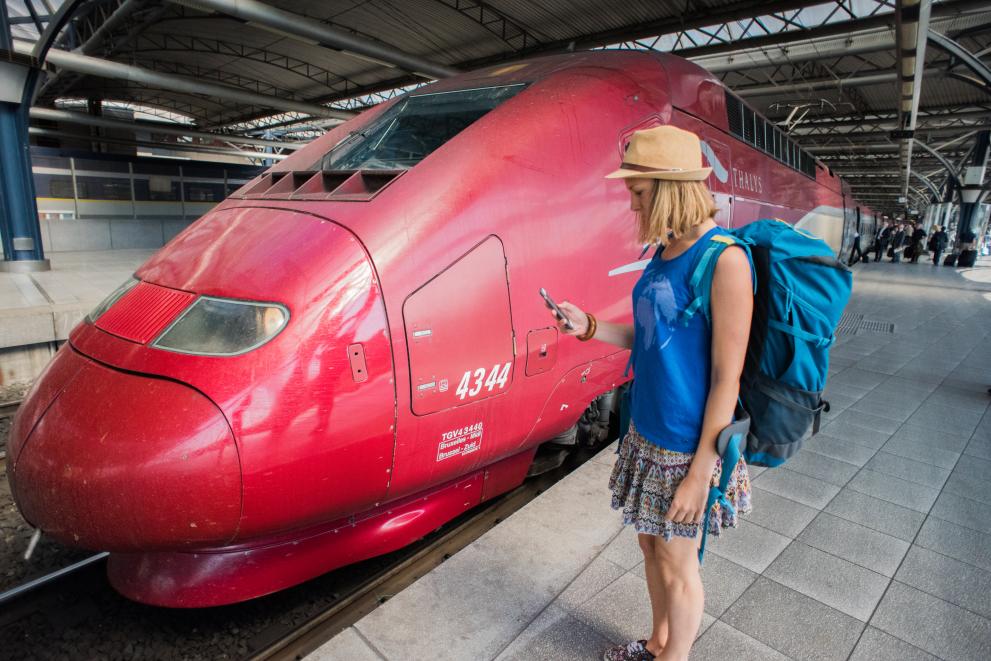
Travelling by train in Europe is becoming more convenient and sustainable thanks to recent EU initiatives. New regulations for the trans-European transport network (TEN-T) to improve rail connectivity and make travel greener have recently entered into force. This means better and more efficient rail services across Europe .
The EU's Action Plan to boost long-distance and cross-border passenger rail services is a key part of these efforts. It aims to double high-speed rail traffic by 2030 and triple it by 2050 . Launched in 2021, this plan focuses on removing obstacles, improving interoperability, modernising passenger rail infrastructure, and enhancing the quality of services across EU countries.
To further support cross-border travel, the European Commission has announced its support for 10 pilot projects to boost cross-border rail services . This will improve cross-border rail connections across the EU and make travel faster, easier and more affordable.
Young travellers can particularly benefit from the DiscoverEU programme, which regularly offers free travel passes to 18-year-olds to explore Europe by train . This programme encourages cultural exchange and highlights the environmental advantages of rail travel. The next call for applications should be published in autumn 2024.
Passenger rights are also a significant focus of the EU’s transport policy. Travellers in Europe are well-protected in case something goes wrong during their trip. EU passenger rights cover delays, cancellations, and accessibility issues.
The EU is committed to making train travel a top choice by improving regulations, creating ambitious plans, and supporting special programmes. These efforts aim to make rail travel more sustainable, efficient, and well-connected across Europe.
For more information
An Action Plan to boost long-distance and cross-border passenger rail services
Connecting Europe by train: 10 EU pilot services to boost cross-border rail
Mobility strategy
Know your EU passenger rights before you travel
Rail passenger rights
Travelling in Europe 2024
Share this page
Ukraine war latest: Zelenskyy reveals aim of Kursk invasion; Starmer maintains 'unwavering' support; Ukraine blows hole in another Russian bridge
Ukrainian President Volodymyr Zelenskyy says the military incursion into Russia's Kursk region aims to create a buffer zone - the first time he has clearly stated the aim of the operation.
Monday 19 August 2024 03:37, UK
- Starmer pledges 'unwavering' support after Zelenskyy accuses UK of 'slowing down'
- Ukraine blows hole in second Russian bridge
- Kursk offensive puts new pressures on entire Russian frontline, analysts say
- Safety 'deteriorating' at Ukrainian nuclear power plant
- Ukrainian drone sparks fire at Russian oil depot
- Russia launches third ballistic missile attack on Ukrainian capital this month
- 'We could lose': Russian state TV commentators gloomy over Kursk
- Sean Bell: Humiliated Putin will respond ruthlessly to Ukrainian masterstroke
- Michael Clarke : Pokrovsk in real trouble as Russian troops advance
- Listen to the Daily above and tap here to follow wherever you get your podcasts
Prime Minister Sir Keir Starmer maintains "unwavering" support for Ukraine, and that position has not changed since incursion into Russia, a government spokesperson has said.
Volodymyr Zelenskyy accused the UK's support for their war effort as having "slowed down" as he called for a removal of restrictions on donated weapons being used inside Russian territory.
Ukrainan forces have been engaged in a military incursion into Russia's Kursk region since 6 August, the aim of which Mr Zelenskyy revealed is to create a buffer zone to prevent further attacks by Moscow across the border.
Writing on X on Sunday, Mr Zelenskyy said: "We are doing everything possible to provide our warriors with the necessary weapons and reinforcements.
"It is crucial that our partners remove barriers that hinder us from weakening Russian positions in the way this war demands."
He added: "Throughout this war, we've seen the UK demonstrate true leadership - in arms, politics, and support for Ukrainian society. This has saved thousands of lives, reflecting the strength of the UK.
"Unfortunately, the situation has slowed down recently. We will discuss how to fix this because long-range capabilities are vital for us. The whole world sees how effective Ukrainians are - how our entire nation defends its independence."
A UK government spokesperson said Mr Starmer "has been clear that UK's support for Ukraine is unwavering".
They said: "That is why he committed to £3bn a year of support to Ukraine, for as long as it takes, within his first week in office.
"Further lethal aid was also accelerated to Kyiv within hours of this government being elected, bolstering the £12bn of UK support already pledged, and ensuring the vital military equipment reaches Ukrainian soldiers on the frontline."
The new package of lethal aid for Ukraine includes a quarter of a million of 50-calibre ammunition, 90 anti-armour Brimstone missiles, 50 small military boats, 40 de-mining vehicles, and 10 AS-90 artillery guns.
Ukrainian forces have also received 61 bulldozers and support for previously gifted AS-90s, from the UK.
Volodymyr Zelenskyy has said the operation in Kursk aims to create a buffer zone.
It's the first time the Ukrainian president has clearly stated the aim of the incursion into Russian territory, which was launched on 6 August.
He has previously said the operation is to protect communities in the bordering Sumy region from constant shelling.
"It is now our primary task in defensive operations overall - to destroy as much Russian war potential as possible and conduct maximum counteroffensive actions," he has just said in his nightly address.
"This includes creating a buffer zone on the aggressor's territory - our operation in the Kursk region."
During the address he also repeated calls to Kyiv's allies to speed up deliveries of military aid - singling out the UK, as well as the US and France.
Ukraine is "still inflicting losses" on Russia, President Volodymyr Zelenskyy has said in his nightly address.
He claimed Ukraine's operation in Russia's Kursk region is damaging "the Russian army, state, their defence industy and their economy".
Mr Zelenskyy posted a video showing a growing cloud from a bridge explosion, with one of its sections destroyed.
He also thanked his soldiers stationed over the Russian border and asked his Ukraine's allies to speed up the delivery of promised military aid.
"Regarding deliveries from our partners - need acceleration, we ask very much. War has no holidays," he warned.
Yesterday, the German government was forced to deny rumours it is planning to halve its military aid to Ukraine in 2025.
A crater was left in the Kyiv region in the aftermath of a Russian missile attack.
Images show locals looking on at the destruction left by the strike, in a seemingly rural area.
Parts of the missile remained scattered across the ground.
This comes after Russia launched its third ballistic missile attack on Kyiv this morning (see 07:35 post).
Preliminary data showed all missiles were destroyed on their approach to the city, the military administration of the Ukrainian capital said.
Two people have been killed in a Ukrainian shelling of Donetsk, according to the Russian-installed mayor.
A man and a woman were said to have been killed on Sunday, local mayor Alexei Kulemzin said.
Sky News has not been able to independently verify his claim.
It would continue Kyiv's push into Russian territory and their newfound aggression in the face of Russia's invasion.
This comes after, earlier in the day, Russian forces were said to have taken control of the village of Svyrydonivka, in the same region, according to TASS state news agency.
Chechnya President Ramzan Kadyrov has invited Elon Musk to Russia after being filmed behind the wheel of one of Tesla's Cybertrucks mounted with a machine gun.
Kadyrov, sanctioned by the US after being linked to numerous human rights violations, said he "literally fell in love" with the car and would donate it to Russian forces fighting in the invasion of Ukraine.
The president, who rules over Chechnya, a republic within the Russian Federation, claimed he received the truck from Musk, although this was not independently confirmed.
Messages left with Tesla by AP seeking comment were not immediately returned.
"It's not for nothing that they call this a cyberbeast. I'm sure that this beast will bring plenty of benefits to our troops."
Inviting Musk to Chechnya, Kadyrov said: "I don't think the Russian foreign ministry would mind such a trip.
"And, of course, we're waiting for your new developments that will help us finish our special military operation."
Russian officials often refer to its invasion as a "special military operation".
More than 3,000 people were evacuated in 24 hours between Friday and Saturday from areas in Russia's Kursk region, according to local authorities.
Russia says the Ukrainian incursion has led to the evacuation of more than 120,000 civilians in total.
More than 10,000 Kursk residents were staying at temporary accommodation centres across the country, the Russian Emergency Ministry said.
Kyiv's offensive came as a shock to Yan Furtsev, an activist and member of the local opposition party Yabloko.
"No one expected that this kind of conflict was even possible in the Kursk region.
"That is why there is such confusion and panic, because citizens are arriving [from frontline areas] and they're scared, very scared."
Russia has denied any talks were taking place with Kyiv about halting strikes on energy targets before Ukraine's Kursk offensive.
The Washington Post reported yesterday the incursion derailed indirect talks on civilian infrastructure facilities, with delegations set to be sent to Qatar.
The agreement would have amounted to a partial ceasefire, the Post said.
But Russian foreign ministry spokesperson Maria Zakharova refuted the report: "No one broke anything off because there was nothing to break off.
"There have been no direct or indirect negotiations between Russia and the Kyiv regime on the safety of civilian critical infrastructure facilities."
Ukraine's government did not immediately respond to a Reuters request for comment.
Ukraine has dismissed Belarusian border tension claims as false.
President Aleksandr Lukashenko was just trying to "appease" Russia when he said he was sending a third of the Belarusian army to the Ukrainian border, said Andrii Demchenko, spokesperson for the State Border Guard Service of Ukraine.
"We have not seen an increase in the equipment or manpower of Belarusian units near our border," he said.
"The situation on the border with the Republic of Belarus remains unchanged.
"As you can see, Lukashenko's rhetoric is consistent, exacerbating the situation at regular intervals to appease the terrorist country."
We can now bring you video of the Ukrainian strike on the second bridge in Kursk this week.
A plume of smoke can be seen erupting from the construction in footage published by the Ukrainian air force.
The attacks on bridges crossing the river Seym, one in Zvannoe and the other in Glushkovo, are thought to be attempts to hamper Russian attempts to resupply its troops in the region.
Be the first to get Breaking News
Install the Sky News app for free


IMAGES
COMMENTS
The Ultimate Packing List for Europe: Summer Edition. Train travel in Europe is generally far more comfortable than flying. At the end of the day, traveling Europe by train is immensely more comfortable than flying. There's less hassle, more comfortable seats, more ease of moving around, often better views, and more control over your environment.
You Arrive/Depart From The City Center. Unlike airports, European train stations are located in the center of town—which saves you time and money. In contrast, traveling from the airport to the city can take anywhere from 20-60 minutes and costs between $10-$80. No Long Check-In and Security Lines.
Route: Zagreb - Belgrade - Bar. Editor's pick. Bus is by far the preferred way to travel around the Balkans region - but there is one rail route that should be on every traveller's radar. The train from Belgrade (Serbia) to Bar ( Montenegro) is easily one of the most scenic and yet underrated in all of Europe.
Eurostar is the high-speed passenger train from London's St Pancras to Paris & Brussels through the Channel Tunnel. Most journeys from the UK to Europe start with Eurostar. All 1st class fares include complimentary drinks and a meal, and all passengers have access to a bar car serving drinks and snacks.
All the routes go via Madrid, which means you'll probably need to change there to get from north to south, although there are some continuous routes that cross the entire country. High-speed trains in Spain are known as the AVE. Madrid to Barcelona 2h30m. Madrid to Seville 2h30. Barcelona to Seville 5h15m.
Interrail and Eurail passes are two types of European rail pass, used for travelling Europe by train. Both types of pass are very similar in usage - your nationality or residence decides which sort of pass you need. Each pass allows you to travel within and between European countries by train. The passes are valid for a set number of travel ...
For more on riding the train in Germany, click here. Otherwise, below are travel times from popular German cities. Berlin to Munich: 3h 58m. Berlin to Hamburg: 1h 42m. Berlin to Frankfurt: 4h 7m. Berlin to Düsseldorf: 4h 15m. Berlin to Prague: 4h 16m. Berlin to Warsaw: 6h 22m. Munich to Hamburg: 5h 33m.
One of the best places for train travel in Europe is the country of Portugal. With its unique scenery and rich culture, Portugal is an excellent destination for a week-long train journey. This itinerary will help you explore the best of Portugal in 7 to 10 days via train. Days 1-4: Lisbon (+ Cascais, Sintra, Belem)
1st timer confused about how to take trains in Europe? This Europe train travel guide was created with beginners in mind, with a step by step breakdown on ho...
Christy Woodrow February 8, 2023. This guide to train travel in Europe covers everything you need to know before booking your next trip to Europe! Boarding a train to take you from city to city is without a doubt the best way to travel through Europe. It's romantic, magical and inspiring — not to mention the fact that it can save you a ...
Type of train: Most rail systems in Europe have a mix of high speed trains intended for Intercity use/longer journeys, as well as slower regional or suburban trains meant for shorter journeys. Generally, the higher the speed, the higher the price, but do pay attention to the type of the train when booking so you can make an informed decision.
The Cons of Train Travel in Europe. 1. Costly. The days of cheap train travel in Europe, especially Western Europe, are pretty much gone. While there are some good discounts, it's rare for the train to cost much less than a flight. For long-distance, high-speed trains, it's especially important to book your ticket early.
It's doable in a day - we're talking 7-10 hours depending on train changes. You'll travel from Barcelona to Lyon, France, back to Montpellier and through Nimes. If you didn't get the direct train from Barcelona to Lyon, you could change at Nimes. Either way, you're Lyon-bound.
How to Travel Europe By Train | Traveling Europe by train is an incredible experience! If you're interested in traveling through Europe by train, I cover eve...
The train, which connects the United Kingdom to the rest of mainland Europe, reaches speeds of up to 186 mph and takes just over 2 hours for the journey. Eurostar passengers can then connect ...
These are average train times using the Eurail! Lisbon to Madrid - 11 hours. Madrid to Paris - 10.5 hours. Paris to Brussels - 1.5 hours. Brussels to Amsterdam - 2 hours, 45 minutes. Amsterdam to Berlin - 11 hours.
Courtesy of Eurail Group. The cost of a Eurail pass varies widely depending on the type of pass you purchase. For example, a Global Pass with five travel days in one month is usually between $319 ...
Yes, and you'll do so in submerged style via "The Chunnel": an underwater rail tunnel beneath the English Channel connecting England to France. From there, you can easily take other trains to Germany, Spain, the Netherlands, and more. This is an especially great option for travelers flying into Heathrow Airport in London, as there's an ...
In this article I share my top tips to plan your 2 weeks in Europe as well as 4 detailed Europe itineraries by train : Latin, Eastern, Western and Central. Discover some of the most beautiful treasures of the continent. Table Of Contents. Things to consider when planning 2 weeks in Europe. Best way to travel Europe in 2 weeks - Europe by train.
To obtain a short-stay Schengen Visa allowing you to travel across Europe by train for 90 days, you will need to apply to the consulate, embassy, or visa application center of your host country, or if traveling to more than one nation, then to the one you plan to spend the most time in. You'll need to provide two identical photographs, a ...
Trainline helps you compare and book train and bus tickets across the continent. This is one of the easiest ways to check prices and times for multiple companies (like Eurostar, SNCF, Trenitalia ...
Ljubljana to Budapest. One of the most affordable routes on this list, these tickets regularly cost as little as 16 euros (about $17). Operated by Hungarian Railways, the train travels from Slovenia via Graz, Austria, before its final destination of Budapest. You can book tickets on the operator's official website.
Discover the ultimate guide on how to travel Europe by train. Learn how to plan your trip, take the train, explore cities, stay safe, and more! ... Safety and security while traveling across Europe via trains are paramount concerns that should be taken seriously when preparing for a trip across this much-loved continent.
We're celebrating our favourite way to see Europe, by rail, in this episode of Travel Smart.. We look at how to see the best of France, Spain and Italy in the most sustainable way possible and ...
A lovely way to take in the alps is on-board the Bernina Railway. This world-famous alpine train takes passengers from Tirana in Italy to chic St Moritz in Switzerland, on one of Europe's most scenic routes. Plus, the spacious, panoramic carriages mean you'll be able to admire the views from every angle - without a long hike!
Slow travel and sustainability are a match made in the big train station in the sky. Studies have shown that train travel can help reduce your total carbon footprint throughout your journey compared to alternative modes of transportation. Plus, there are dazzling European landscapes that you can only view via rail lines.
Travelling by train in Europe is becoming more convenient and sustainable thanks to recent EU initiatives. New regulations for the trans-European transport network (TEN-T) to improve rail connectivity and make travel greener have recently entered into force.This means better and more efficient rail services across Europe.. The EU's Action Plan to boost long-distance and cross-border passenger ...
Ukraine has attacked a second Russian bridge in the Kursk region in a week as it continues its offensive across the border. Analysts say the incursion has put pressure on Russian forces across the ...